Telit Communications S p A UE910GL UE910-GL WWAN module User Manual HE910 Hardware User Guide
Telit Communications S.p.A. UE910-GL WWAN module HE910 Hardware User Guide
Users guide
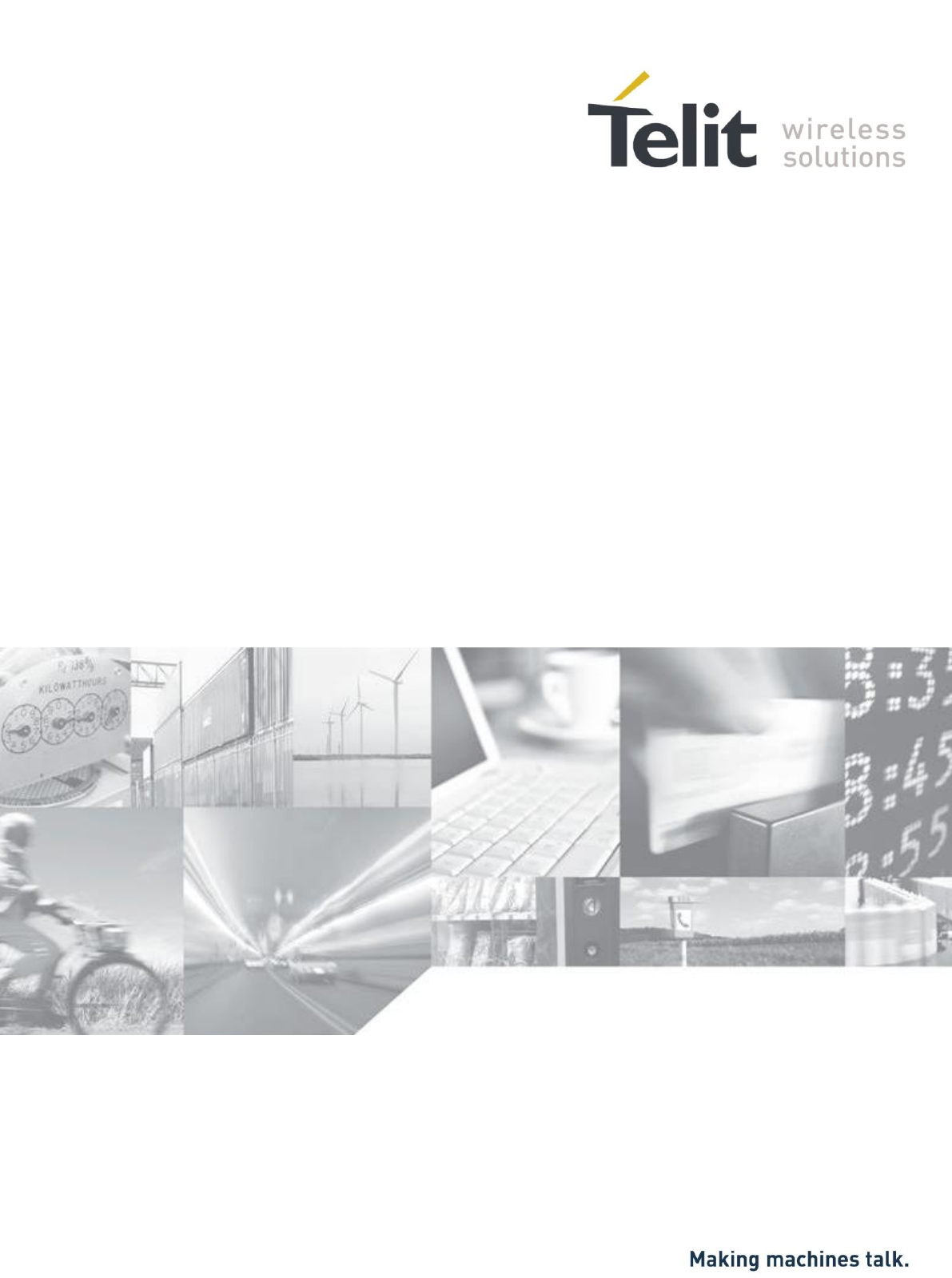
UE910 Hardware User Guide
1VV0301012 Rev.10.9 –
2016-12-16
DRAFT
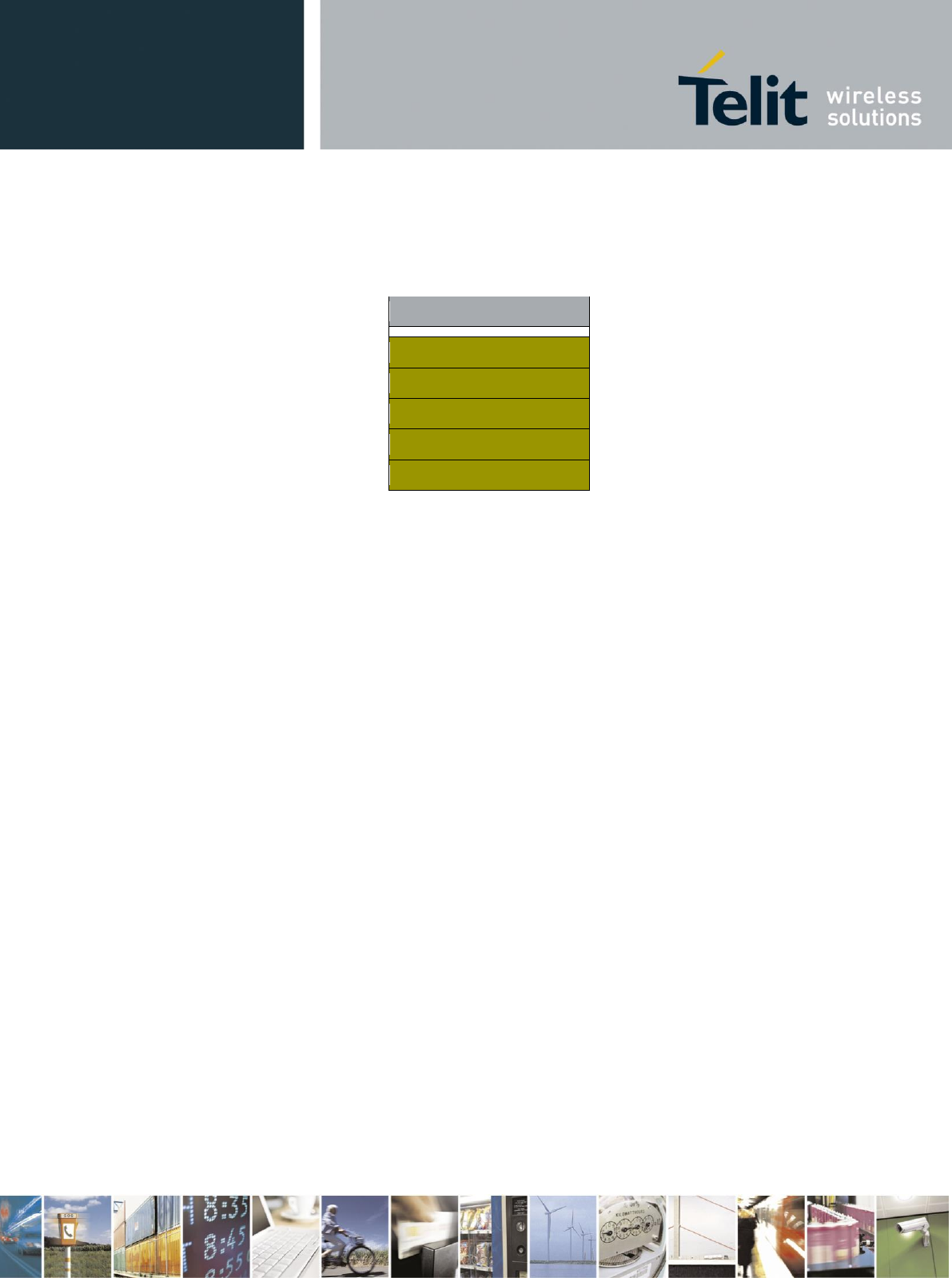
UE910 Hardware User Guide
1VV0301012 Rev.10.9 – 2016-12-16
Reproduction forbidden without Telit Communications S.p.A. written authorization - All Rights Reserved page 2 of 93
Applicability Table
PRODUCT
UE910-EUR
UE910-EUD
UE910-NAR
UE910-NAD
UE910-GL
DRAFT
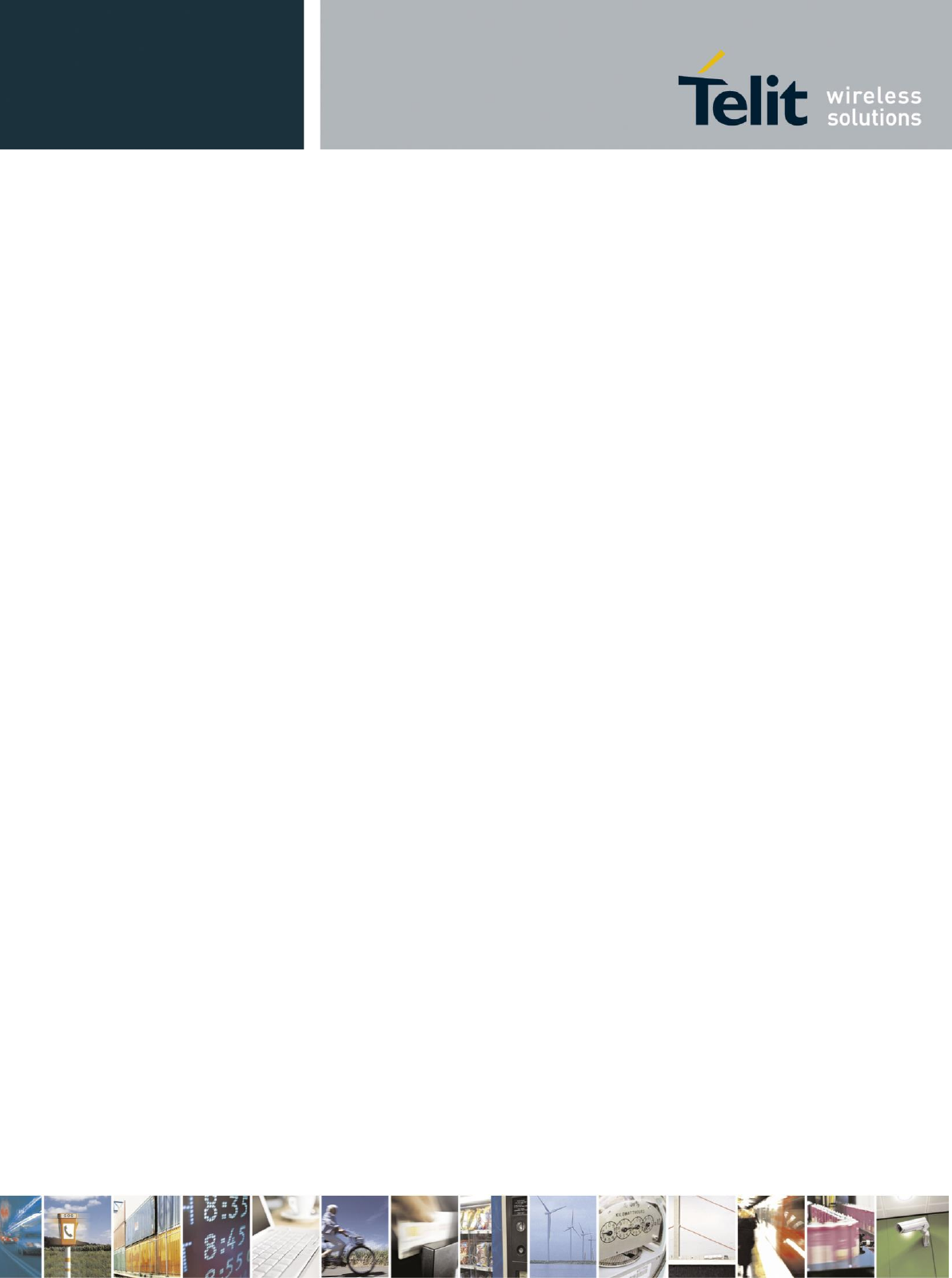
Reproduction forbidden without Telit Communications S.p.A. written authorization - All Rights Reserved page 3 of 93
DISCLAIMER
The information contained in this document is the proprietary information of Telit
Communications S.p.A. and its affiliates (“TELIT”). The contents are confidential and any
disclosure to persons other than the officers, employees, agents or subcontractors of the owner
or licensee of this document, without the prior written consent of Telit, is strictly prohibited.
Telit makes every effort to ensure the quality of the information it makes available.
Notwithstanding the foregoing, Telit does not make any warranty as to the information
contained herein, and does not accept any liability for any injury, loss or damage of any kind
incurred by use of or reliance upon the information.
Telit disclaims any and all responsibility for the application of the devices characterized in this
document, and notes that the application of the device must comply with the safety standards of
the applicable country, and where applicable, with the relevant wiring rules.
Telit reserves the right to make modifications, additions and deletions to this document due to
typographical errors, inaccurate information, or improvements to programs and/or equipment at
any time and without notice. Such changes will, nevertheless be incorporated into new editions
of this application note.
All rights reserved.
© 2013 Telit Communications S.p.A.
DRAFT
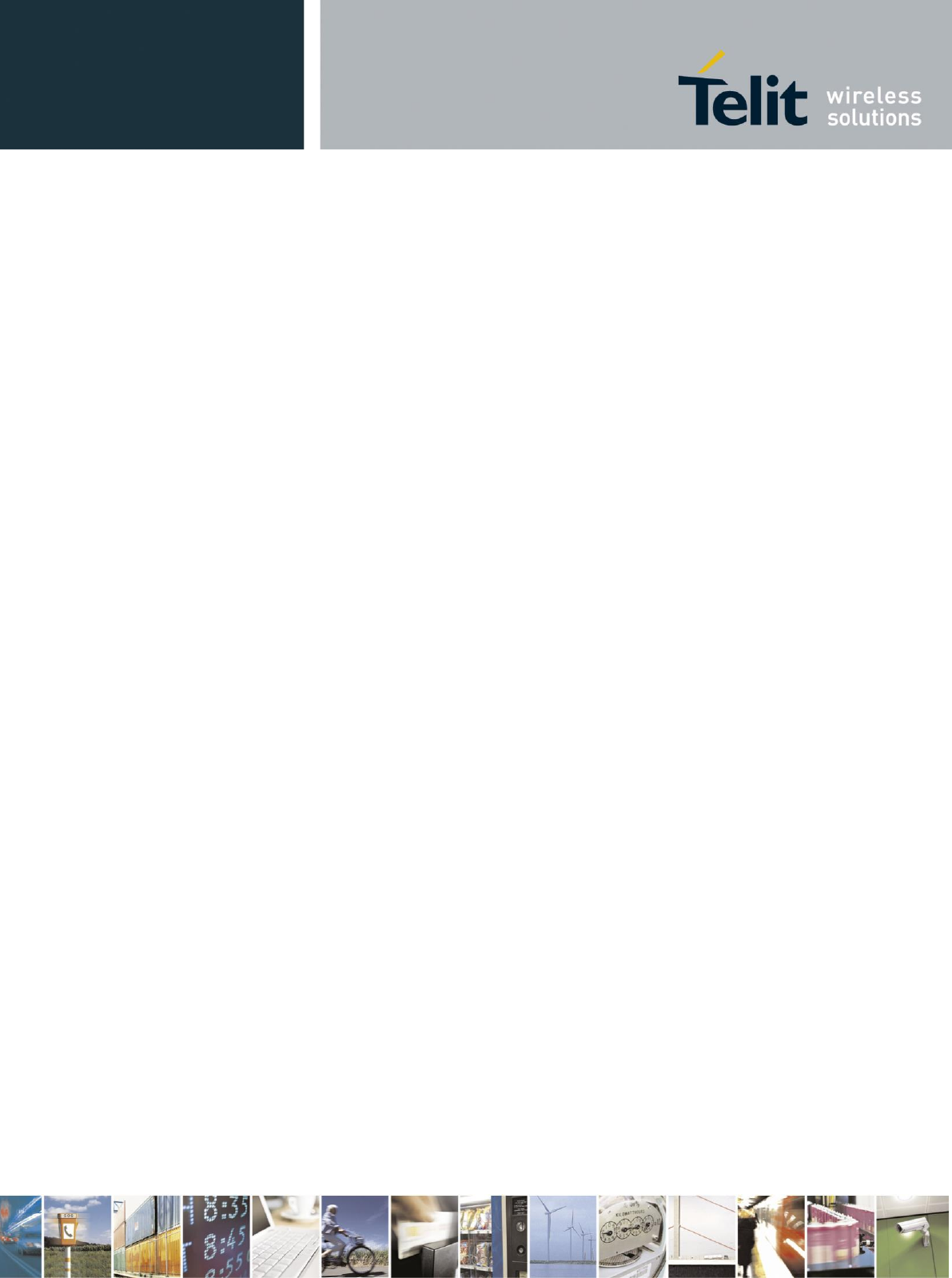
Reproduction forbidden without Telit Communications S.p.A. written authorization - All Rights Reserved page 4 of 93
Contents
1 INTRODUCTION ......................................................................................................................................................... 6
1.1 SCOPE ................................................................................................................................................................................ 6
1.2 AUDIENCE ........................................................................................................................................................................... 6
1.3 CONTACT INFORMATION, SUPPORT .......................................................................................................................................... 6
1.4 DOCUMENT ORGANIZATION ................................................................................................................................................... 7
1.5 TEXT CONVENTIONS .............................................................................................................................................................. 8
1.6 RELATED DOCUMENTS ........................................................................................................................................................... 8
1.7 DOCUMENT HISTORY ............................................................................................................................................................ 9
2 OVERVIEW .............................................................................................................................................................. 10
3 UE910 MODULE CONNECTIONS ............................................................................................................................... 11
3.1 PIN-OUT ......................................................................................................................................................................... 11
3.1.1 LGA Pads Layout ..................................................................................................................................................... 17
4 HARDWARE COMMANDS ........................................................................................................................................ 18
4.1 TURNING ON THE UE910 ................................................................................................................................................... 18
4.2 TURNING OFF THE UE910 .................................................................................................................................................. 25
4.3 UE910 UNCONDITIONAL SHUTDOWN .................................................................................................................................... 28
5 POWER SUPPLY ....................................................................................................................................................... 31
5.1 POWER SUPPLY REQUIREMENTS ............................................................................................................................................ 31
5.2 POWER CONSUMPTION ....................................................................................................................................................... 32
5.3 GENERAL DESIGN RULES ...................................................................................................................................................... 33
5.3.1 Electrical Design Guidelines ................................................................................................................................... 33
5.3.2 Thermal Design Guidelines ..................................................................................................................................... 37
5.3.3 Power Supply PCB layout Guidelines ...................................................................................................................... 38
6 GSM/WCDMA RADIO SECTION ............................................................................................................................... 40
6.1 UE910 PRODUCT VARIANTS ................................................................................................................................................ 40
6.2 TX OUTPUT POWER ............................................................................................................................................................ 40
SENSITIVITY ............................................................................................................................................................................. 43
6.3 GSM/WCDMA ANTENNA REQUIREMENTS ............................................................................................................................ 43
6.4 GSM/WCDMA - PCB LINE GUIDELINES ................................................................................................................................ 45
6.5 PCB GUIDELINES IN CASE OF FCC CERTIFICATION ...................................................................................................................... 47
6.5.1 Transmission line design ........................................................................................................................................ 47
6.5.2 Transmission line measurements ........................................................................................................................... 48
6.6 ANTENNA - INSTALLATION GUIDELINES ................................................................................................................................... 50
7 LOGIC LEVEL SPECIFICATIONS .................................................................................................................................. 51
7.1 UNCONDITIONAL SHUTDOWN ............................................................................................................................................... 52
8 USB PORT ................................................................................................................................................................ 53
8.1 USB 2.0 HS ...................................................................................................................................................................... 53
9 SPI PORT ................................................................................................................................................................. 54
9.1 SPI CONNECTIONS .............................................................................................................................................................. 54
DRAFT
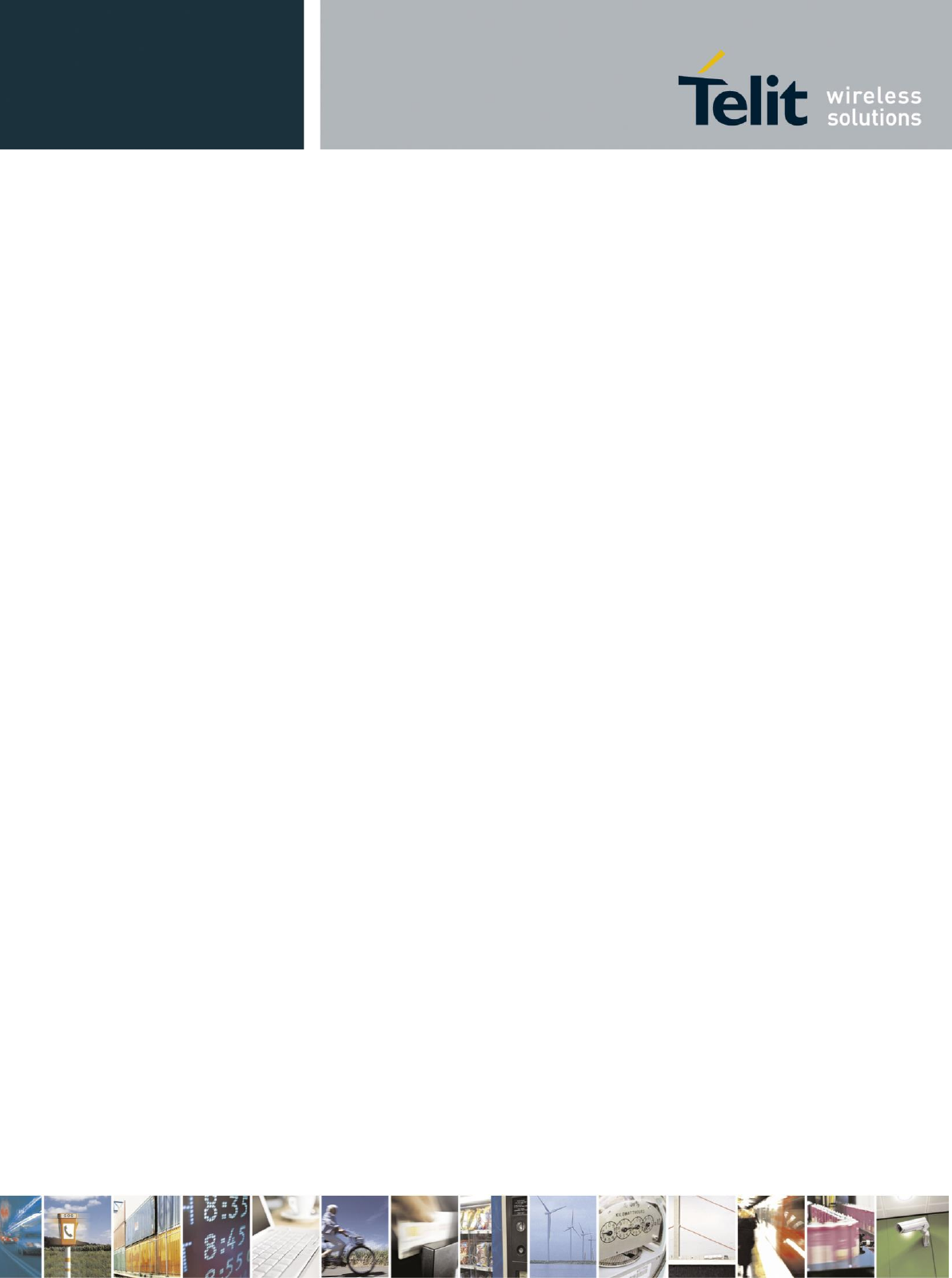
Reproduction forbidden without Telit Communications S.p.A. written authorization - All Rights Reserved page 5 of 93
10 USB HSIC ................................................................................................................................................................. 55
11 SERIAL PORTS .......................................................................................................................................................... 56
11.1 MODEM SERIAL PORT 1 (USIF0) ................................................................................................................................... 57
11.2 MODEM SERIAL PORT 2 (USIF1) ................................................................................................................................... 59
11.3 RS232 LEVEL TRANSLATION ................................................................................................................................................ 60
12 AUDIO SECTION OVERVIEW .................................................................................................................................... 62
12.1 ANALOG VOICE INTERFACE ................................................................................................................................................. 62
12.1.1 MIC connection .................................................................................................................................................... 63
12.1.2 LINE IN Connection ............................................................................................................................................... 65
12.1.3 EAR Connection .................................................................................................................................................... 66
12.2 DIGITAL VOICE INTERFACE .................................................................................................................................................. 67
12.2.1 Electrical Characteristics ...................................................................................................................................... 67
12.2.2 CODEC Examples .................................................................................................................................................. 67
13 GENERAL PURPOSE I/O ........................................................................................................................................... 68
13.1 GPIO LOGIC LEVELS .......................................................................................................................................................... 69
13.2 USING A GPIO PAD AS INPUT ........................................................................................................................................... 70
13.3 USING A GPIO PAD AS OUTPUT ........................................................................................................................................ 70
13.4 INDICATION OF NETWORK SERVICE AVAILABILITY ..................................................................................................................... 71
13.5 RTC BYPASS OUT ............................................................................................................................................................. 72
13.6 EXTERNAL SIM HOLDER IMPLEMENTATION ........................................................................................................................... 72
13.7 VAUX POWER OUTPUT ..................................................................................................................................................... 72
13.8 ADC CONVERTER ............................................................................................................................................................. 73
13.8.1 Description ........................................................................................................................................................... 73
13.8.2 Using ADC Converter ............................................................................................................................................ 73
14 MOUNTING THE UE910 ON THE APPLICATION ........................................................................................................ 74
14.1 GENERAL ........................................................................................................................................................................ 74
14.2 MODULE FINISHING & DIMENSIONS ..................................................................................................................................... 74
14.3 RECOMMENDED FOOT PRINT FOR THE APPLICATION ................................................................................................................. 76
14.4 STENCIL .......................................................................................................................................................................... 77
14.5 PCB PAD DESIGN .............................................................................................................................................................. 77
14.6 PCB PAD DIMENSIONS ....................................................................................................................................................... 78
14.7 SOLDER PASTE .................................................................................................................................................................. 80
14.7.1 UE910 Solder reflow ............................................................................................................................................. 80
14.8 PACKING SYSTEM (TRAY) .................................................................................................................................................... 82
14.9 PACKING SYSTEM (REEL) .................................................................................................................................................... 84
14.9.1 Carrier Tape Detail ............................................................................................................................................... 84
14.9.2 Reel Detail ............................................................................................................................................................ 85
14.9.3 Packaging Detail .................................................................................................................................................. 86
14.10 MOISTURE SENSITIVITY .................................................................................................................................................... 86
15 SAFETY RECOMMANDATIONS ................................................................................................................................. 87
16 CONFORMITY ASSESSMENT ISSUES ......................................................................................................................... 88
16.1 1999/5/EC DIRECTIVE ..................................................................................................................................................... 88
16.2 FCC/IC REGULATORY NOTICES ............................................................................................................................................ 91
DRAFT
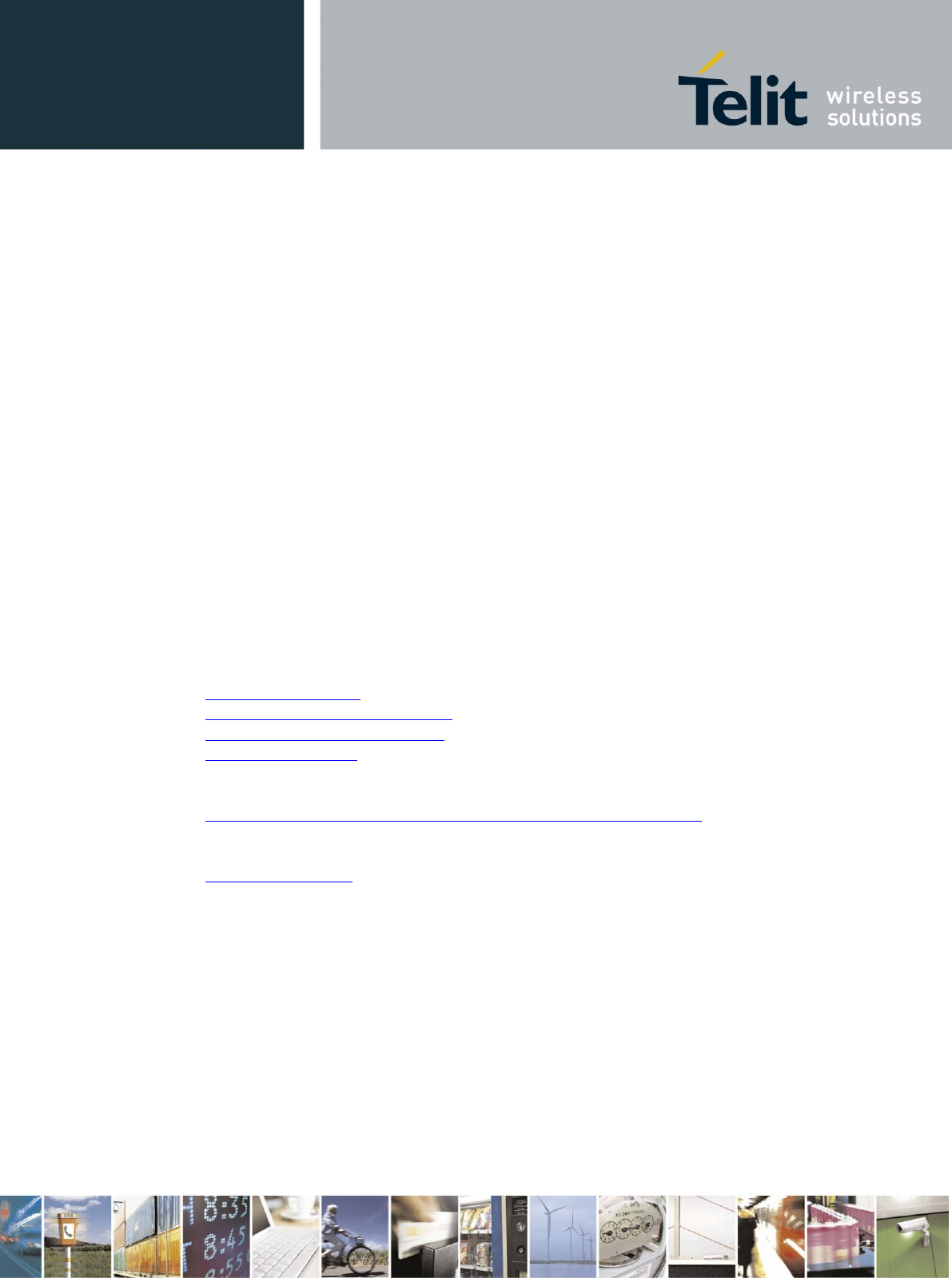
Reproduction forbidden without Telit Communications S.p.A. written authorization - All Rights Reserved page 6 of 93
1 Introduction
1.1 Scope
The aim of this document is the description of some hardware solutions useful for developing a
product with the Telit UE910 module.
1.2 Audience
This document is intended for Telit customers, who are integrators, about to implement their
applications using our UE910 modules.
1.3 Contact Information, Support
For general contact, technical support, to report documentation errors and to order manuals,
contact Telit’s Technical Support Center (TTSC) at:
TS-EMEA@telit.com
TS-NORTHAMERICA@telit.com
TS-LATINAMERICA@telit.com
TS-APAC@telit.com
Alternatively, use:
http://www.telit.com/en/products/technical-support-center/contact.php
For detailed information about where you can buy the Telit modules or for recommendations on
accessories and components visit:
http://www.telit.com
To register for product news and announcements or for product questions contact Telit’s
Technical Support Center (TTSC).
Our aim is to make this guide as helpful as possible. Keep us informed of your comments and
suggestions for improvements.
Telit appreciates feedback from the users of our information.
DRAFT
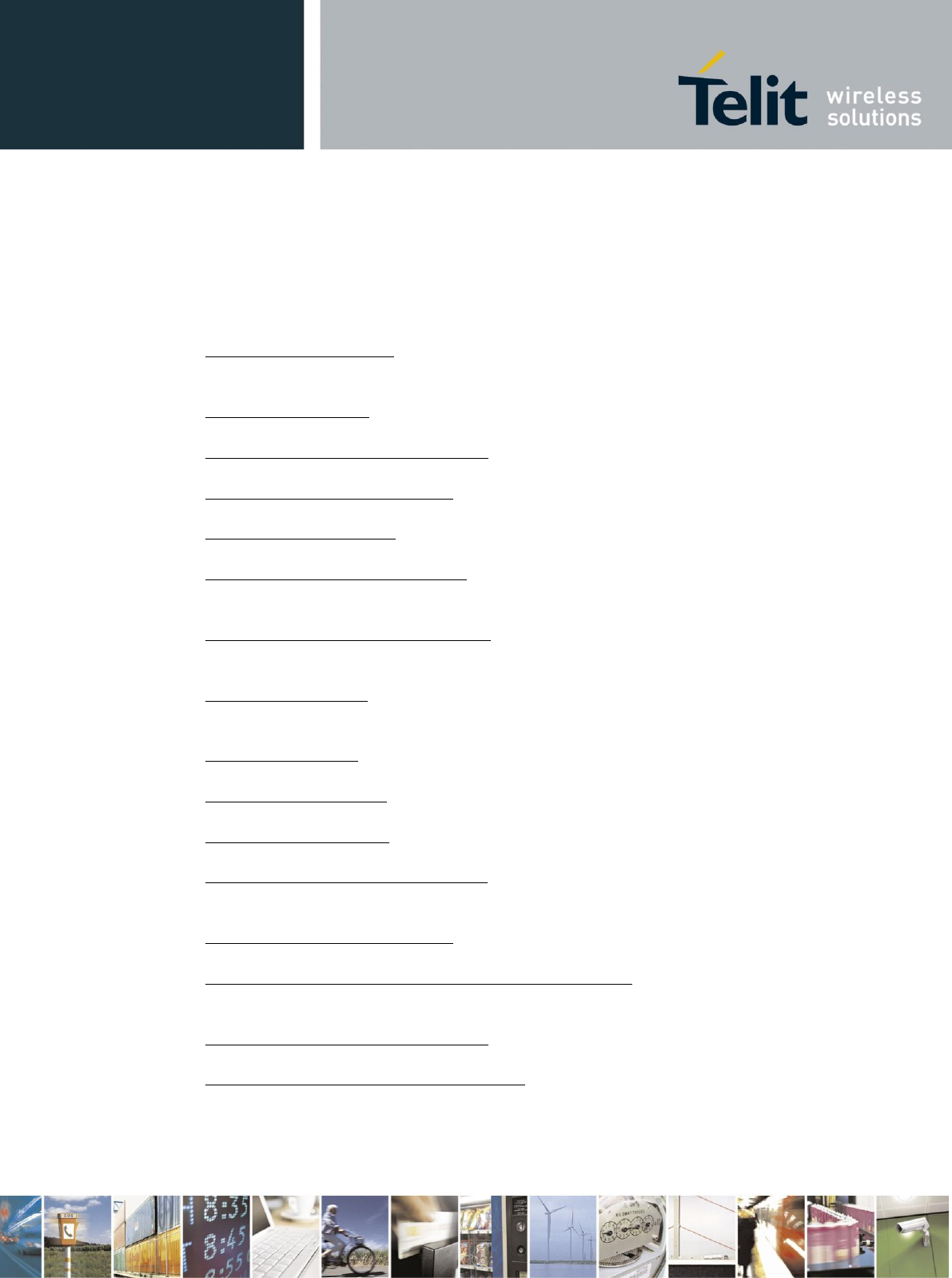
Reproduction forbidden without Telit Communications S.p.A. written authorization - All Rights Reserved page 7 of 93
1.4 Document Organization
This document contains the following chapters:
Chapter 1: “Introduction” provides a scope for this document, target audience, contact and
support information, and text conventions.
Chapter 2: “Overview” provides an overview of the document.
Chapter3: “UE910 Module Connections” deals with the pin out configuration and layout.
Chapter 4: “Hardware Commands” How to operate on the module via hardware.
Chapter 5: “Power supply” Power supply requirements and general design rules.
Chapter 6: “GSM/WCDMA Radio” The antenna connection and board layout design are the
most important parts in the full product design.
Chapter 7: “Logic Level specifications” Specific values adopted in the implementation of logic
levels for this module.
Chapter 8: “USB Port” The USB port on the Telit UE910 is the core of the interface between the
module and OEM hardware
Chapter 9: “SPI port” Refers to the SPI port of the Telit UE910
Chapter 10: “USB HSIC” Refers to the USB HSIC port of the Telit UE910
Chapter 11: “Serial ports” Refers to the serial ports of the Telit UE910
Chapter 12: “Audio Section overview” Refers to the audio blocks of the Base Band Chip of the
UE910 Telit Modules.
Chapter 13: “General Purpose I/O” How the general purpose I/O pads can be configured.
Chapter 14: “Mounting the UE910 on the application board” Mechanical dimensions and
recommendations on how to mount the module on the user’s board.
Chapter 15: “Safety Recommendations” Information related to the Safety topics.
Chapter 16: “Conformity Assessment Issues” Information related to the Conformity
Assessments.
DRAFT
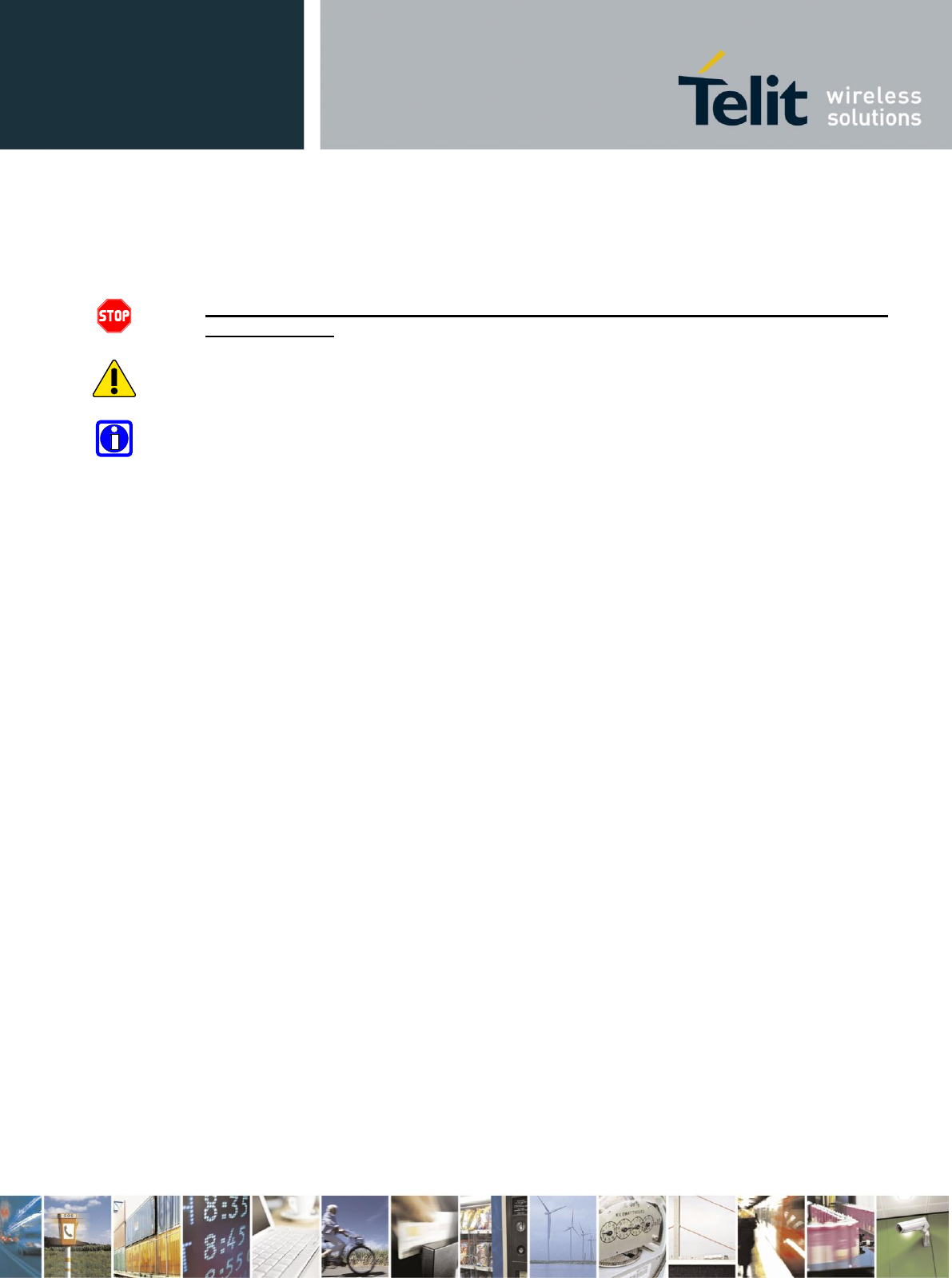
Reproduction forbidden without Telit Communications S.p.A. written authorization - All Rights Reserved page 8 of 93
1.5 Text Conventions
Danger – This information MUST be followed or catastrophic equipment failure or bodily
injury may occur.
Caution or Warning – Alerts the user to important points about integrating the module, if
these points are not followed, the module and end user equipment may fail or malfunction.
Tip or Information – Provides advice and suggestions that may be useful when integrating
the module.
All dates are in ISO 8601 format, i.e. YYYY-MM-DD.
1.6 Related Documents
Digital Voice Interface Application Note 80000NT10050A
SPI Port Application Note 80000NT10053A
SIM Holder Design Guides 80000NT10001a
USB HSIC Port Application Note 80000NT10071A
AT Commands Reference Guide 80378ST10091A
Telit EVK2 User Guide 1vv0300704
DRAFT
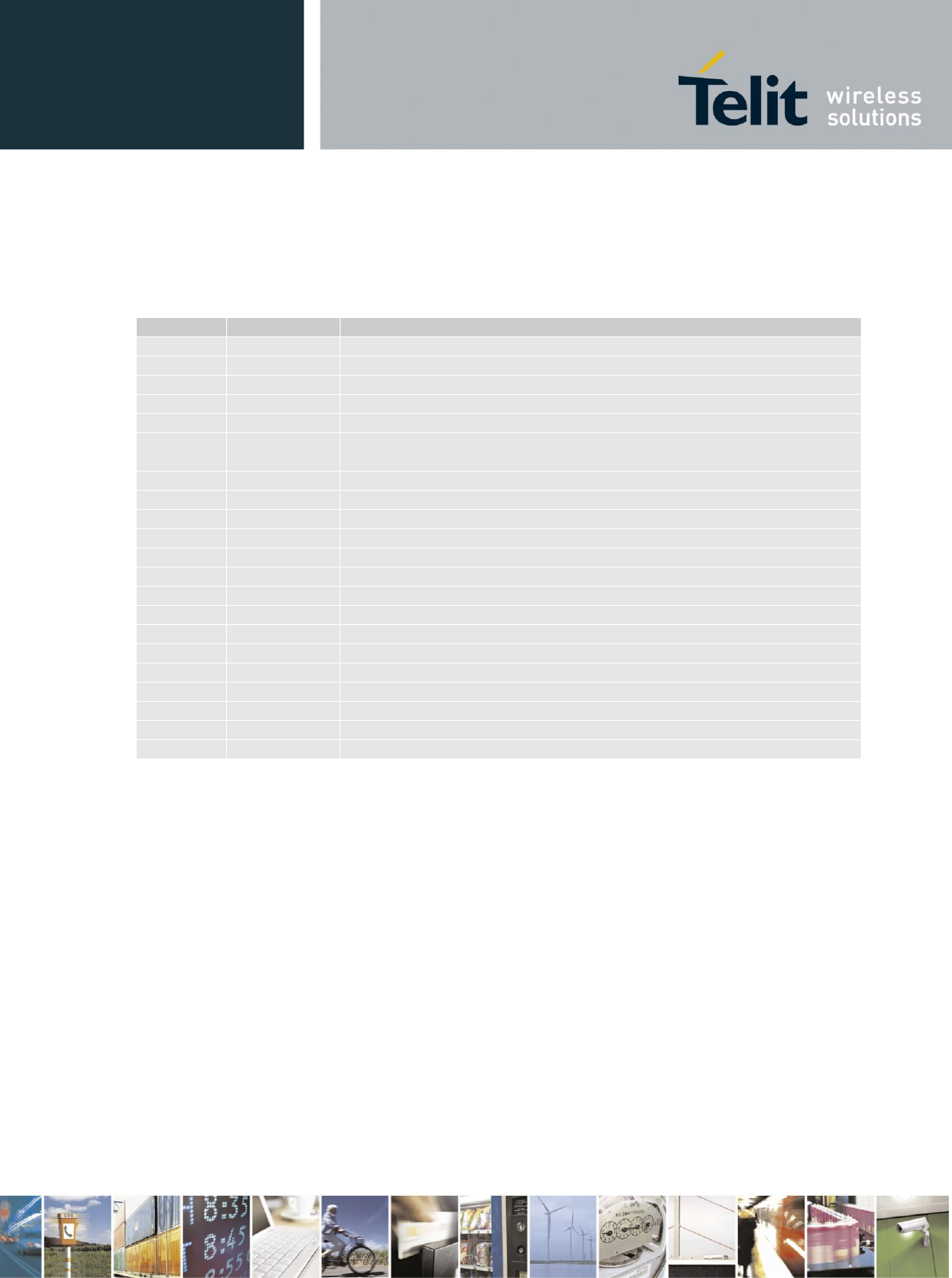
Reproduction forbidden without Telit Communications S.p.A. written authorization - All Rights Reserved page 9 of 93
1.7 Document History
R
Re
ev
vi
is
si
io
on
n
D
Da
at
te
e
C
Ch
ha
an
ng
ge
es
s
ISSUE#0
2012-09-07
Preliminary Version
ISSUE#1
2013-04-10
Updated Chapters 5.2, 6.3, 6.4, 9, 11, 13.4, 15
ISSUE#2
2013-04-24
Updated Chapters 13.4, 15.2
ISSUE#3
2013-08-02
Updated Chapters 4, 5.1, 6.3, 12.4, 13.4, added Reel packaging chapter
ISSUE#4
2013-08-30
Updated Chapters 3.1, 4.1, 4.2, 5.2, 7, 8.1, 10, 12.1
ISSUE#5
2013-12-20
Updated Chapters 1.4, 1.6, 3.1, updated schematics and flow charts; added
USB HSIC; updated packaging drawing; added PCB Guidelines for FCC.
ISSUE#6
2014-08-28
-Updated Chapter 11.2 deleted note under table
ISSUE#7
2015-05-25
Updated Chapter 14.8 Packing system (Tray)
ISSUE#8
2016-09-01
Updated Chapter 3.1.1 LGA Pads Layout – updated pin B1
ISSUE#9
2016-11-30
Updated Chapter 3.1 Pin Out – updated pin B1 (deleted from Reserved pin)
ISSUE#10
2016-12-13
Updated with UE910-GL product
ISSUE#11
2016-12-16
Updated Chapter 3.1 Pin Out
DRAFT
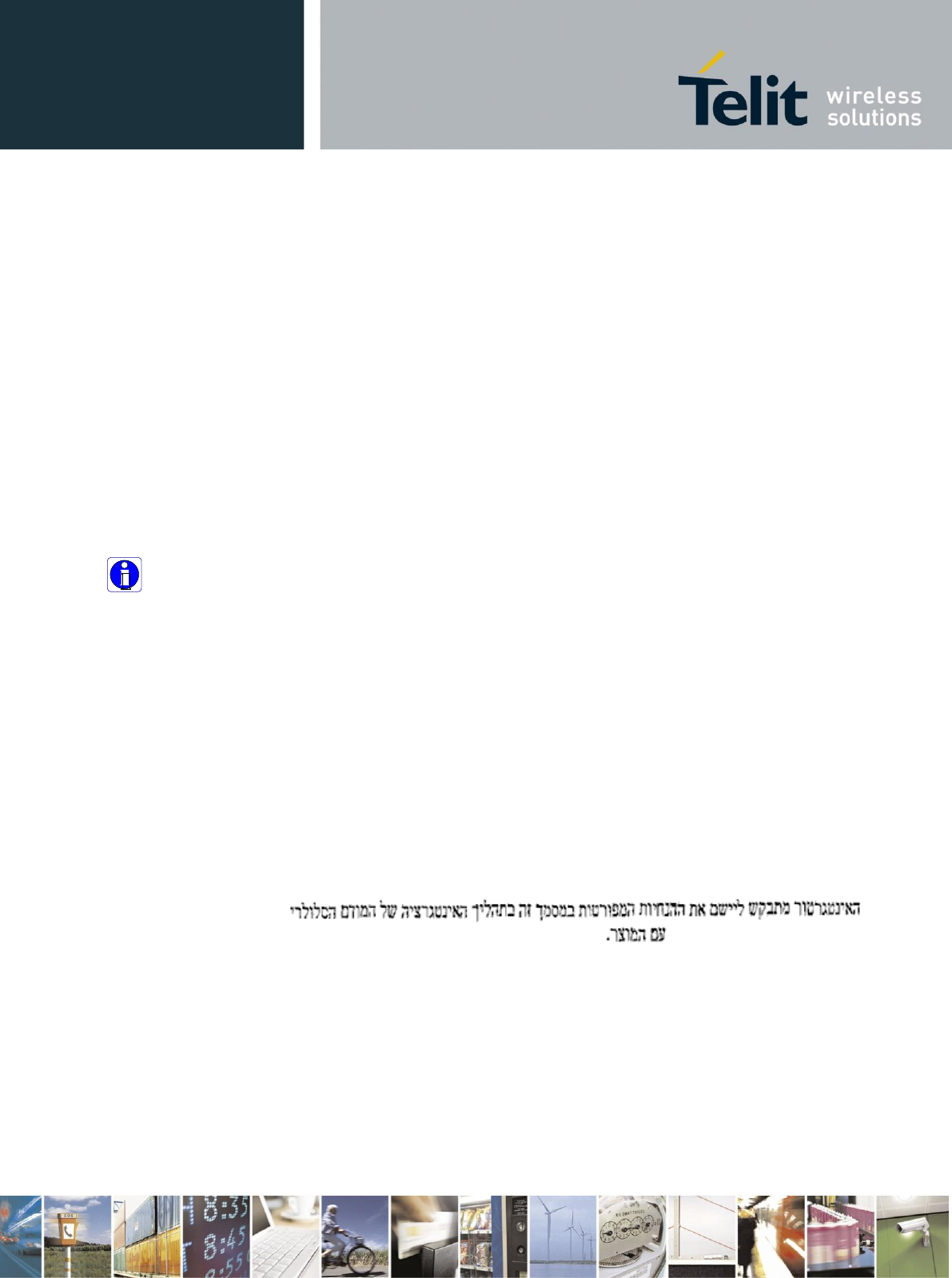
Reproduction forbidden without Telit Communications S.p.A. written authorization - All Rights Reserved page 10 of 93
2 Overview
The aim of this document is the description of some hardware solutions useful for developing a
product with the Telit UE910 module.
In this document all the basic functions of a mobile phone will be taken into account; for each
one of them a proper hardware solution will be suggested and eventually the wrong solutions
and common errors to be avoided will be evidenced. Obviously this document cannot embrace
the whole hardware solutions and products that may be designed. The wrong solutions to be
avoided shall be considered as mandatory, while the suggested hardware configurations shall not
be considered mandatory, instead the information given shall be used as a guide and a starting
point for properly developing your product with the Telit UE910 module. For further hardware
details that may not be explained in this document refer to the Telit UE910 Product Description
document where all the hardware information is reported.
NOTICE:
(EN) The integration of the GSM/GPRS/WCDMA UE910 cellular module within user application shall
be done according to the design rules described in this manual.
(IT) L’integrazione del modulo cellulare GSM/GPRS/WCDMA UE910 all’interno dell’applicazione
dell’utente dovrà rispettare le indicazioni progettuali descritte in questo manuale.
(DE) Die Integration des UE910 GSM/GPRS/WCDMA Mobilfunk-Moduls in ein Gerät muß gemäß der
in diesem Dokument beschriebenen Kunstruktionsregeln erfolgen.
(SL) Integracija GSM/GPRS/WCDMA UE910 modula v uporabniški aplikaciji bo morala upoštevati
projektna navodila, opisana v tem priročniku.
(SP) La utilización del modulo GSM/GPRS/WCDMA UE910 debe ser conforme a los usos para los
cuales ha sido deseñado descritos en este manual del usuario.
(FR) L’intégration du module cellulaire GSM/GPRS/WCDMA UE910 dans l’application de l’utilisateur
sera faite selon les règles de conception décrites dans ce manuel.
(HE)
The information presented in this document is believed to be accurate and reliable. However, no
responsibility is assumed by Telit Communications S.p.A. for its use, nor any infringement of patents or
other rights of third parties which may result from its use. No license is granted by implication or
otherwise under any patent rights of Telit Communications S.p.A. other than for circuitry embodied in
Telit products. This document is subject to change without notice.
UE910
DRAFT
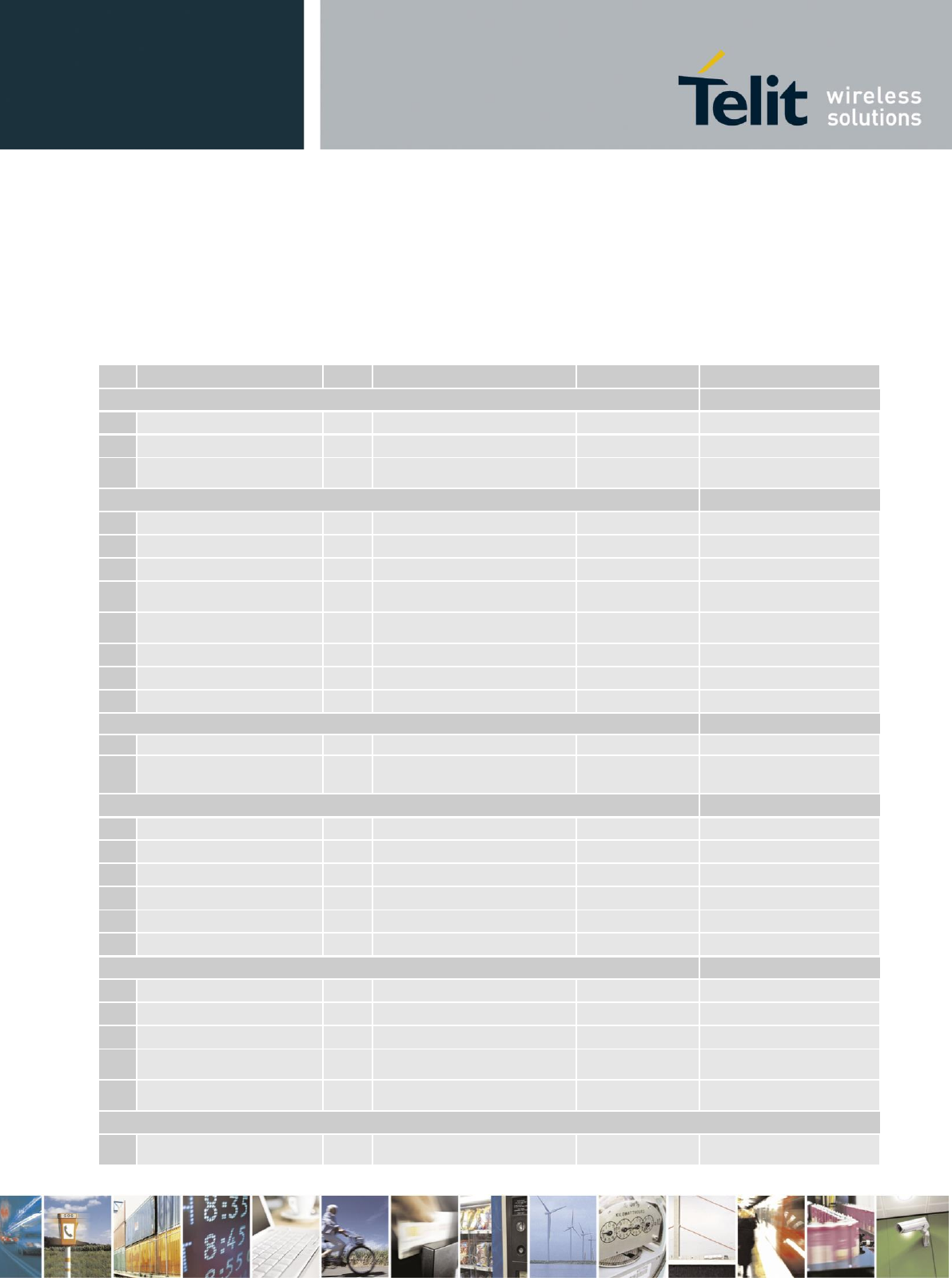
Reproduction forbidden without Telit Communications S.p.A. written authorization - All Rights Reserved page 11 of 93
3 UE910 module connections
3.1 PIN-OUT
PAD
Signal
I/O
Function
Type
COMMENT
USB HS 2.0 COMMUNICATION PORT
B15
USB_D+
I/O
USB differential Data (+)
C15
USB_D-
I/O
USB differential Data (-)
A13
VUSB
I
Power sense for the internal USB
transceiver.
Asynchronous Serial Port (USIF0) - Prog. / Data + HW Flow Control
N15
C103/TXD
I
Serial data input from DTE
CMOS 1.8V
M15
C104/RXD
O
Serial data output to DTE
CMOS 1.8V
M14
C108/DTR
I
Input for (DTR) from DTE
CMOS 1.8V
L14
C105/RTS
I
Input for Request to send signal
(RTS) from DTE
CMOS 1.8V
P15
C106/CTS
O
Output for Clear to Send signal
(CTS) to DTE
CMOS 1.8V
N14
C109/DCD
O
Output for (DCD) to DTE
CMOS 1.8V
P14
C107/DSR
O
Output for (DSR) to DTE
CMOS 1.8V
R14
C125/RING
O
Output for Ring (RI) to DTE
CMOS 1.8V
Asynchronous Auxiliary Serial Port (USIF1)
D15
TX_AUX
O
Auxiliary UART (TX Data to DTE)
CMOS 1.8V
E15
RX_AUX
I
Auxiliary UART (RX Data from
DTE)
CMOS 1.8V
USB HSIC
A12
HSIC_USB_DATA
I/O
USB HSIC data signal
CMOS 1.2V
A11
HSIC_USB_STRB
I/O
USB HSIC strobe signal
CMOS 1.2V
H15
HSIC_SLAVE_WAKEUP
I
Slave Wake Up
CMOS 1.8V
Shared with SPI_MRDY
F15
HSIC_HOST_WAKEUP
O
Host Wake Up
CMOS 1.8V
Shared with SPI CLK
K15
HSIC_SUSPEND_REQUEST
O
Slave Suspend Request
CMOS 1.8V
Shared with GPIO08
J15
HSIC_HOST_ACTIVE
I
Active Host Indication
CMOS 1.8V
Shared with SPI_SRDY
SIM card interface
A6
SIMCLK
O
External SIM signal – Clock
1.8 / 3V
A7
SIMRST
O
External SIM signal – Reset
1.8 / 3V
A5
SIMIO
I/O
External SIM signal – Data I/O
1.8 / 3V
A4
SIMIN
I
External SIM signal – Presence
(active low)
CMOS 1.8
A3
SIMVCC
-
External SIM signal – Power supply
for the SIM
1.8 / 3V
Analog Audio
B2
EAR+
O
Analog Audio Interface (EAR+)
Not available on UE910-
xxD/UE910-GL
DRAFT
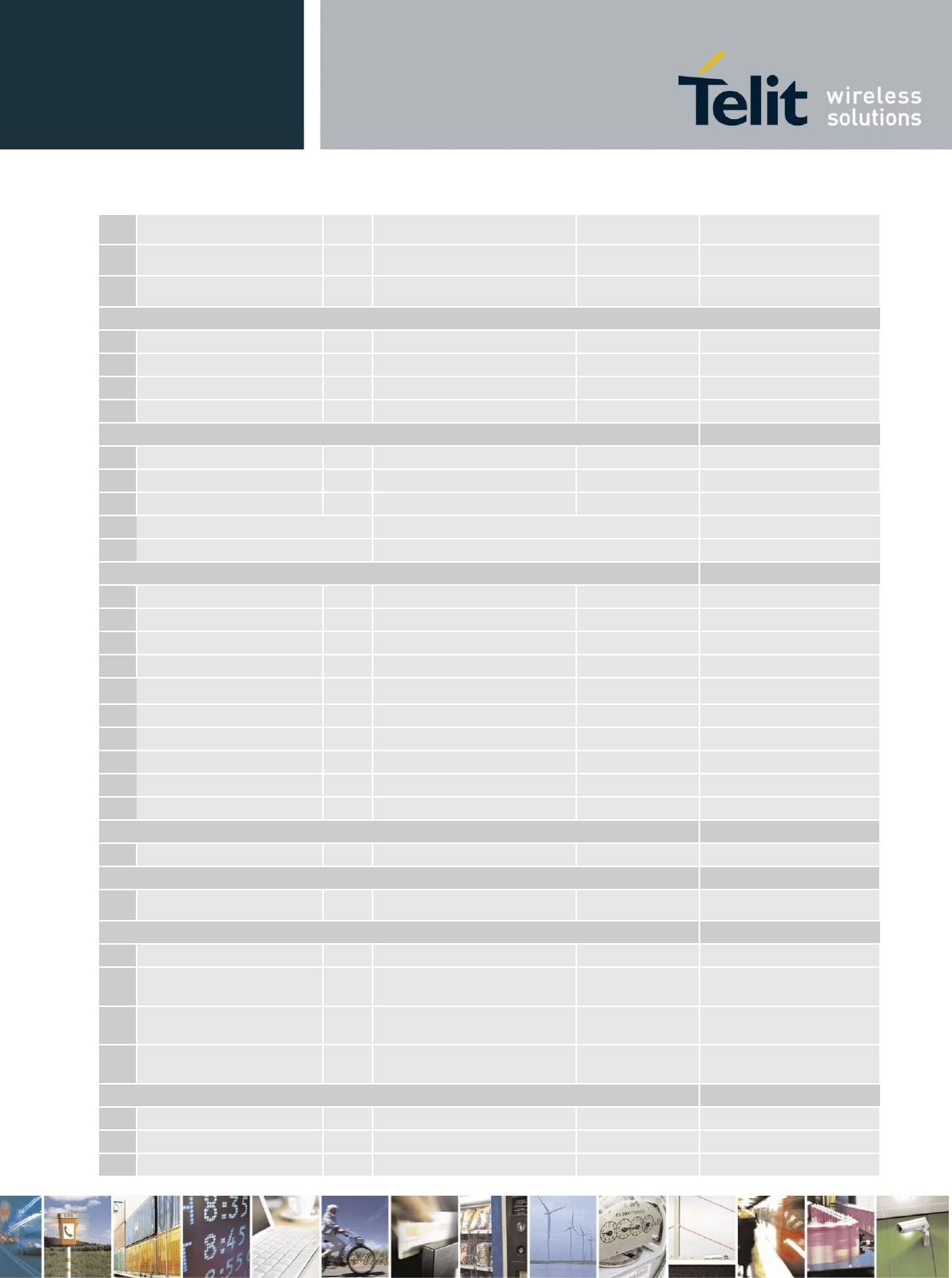
Reproduction forbidden without Telit Communications S.p.A. written authorization - All Rights Reserved page 12 of 93
B3
EAR-
O
Analog Audio Interface (EAR-)
Not available on UE910-
xxD/UE910-GL
B4
MIC+
I
Analog Audio Interface (MIC+)
Not available on UE910-
xxD/UE910-GL
B5
MIC-
I
Analog Audio Interface (MIC-)
Not available on UE910-
xxD/UE910-GL
Digital Voice Interface (DVI)
B9
DVI_WA0
I/O
Digital Audio Interface (WA0)
CMOS 1.8V
B6
DVI_RX
I/O
Digital Audio Interface (RX)
CMOS 1.8V
B7
DVI_TX
I/O
Digital Audio Interface (TX)
CMOS 1.8V
B8
DVI_CLK
I/O
Digital Audio Interface (CLK)
CMOS 1.8V
SPI
D15
SPI_MOSI
I
SPI MOSI
CMOS 1.8V
Shared with TX_AUX
E15
SPI_MISO
O
SPI_MISO
CMOS 1.8V
Shared with RX_AUX
F15
SPI_CLK
I
SPI Clock
CMOS 1.8V
H15
SPI_MRDY
I
SPI_MRDY
CMOS 1.8V
J15
SPI_SRDY
O
SPI_SRDY
CMOS 1.8V
DIGITAL IO
C8
GPIO_01
I/O
GPIO_01 /STAT LED
CMOS 1.8V
Alternate Function STAT LED
C9
GPIO_02
I/O
GPIO_02
CMOS 1.8V
C10
GPIO_03
I/O
GPIO_03
CMOS 1.8V
C11
GPIO_04
I/O
GPIO_04
CMOS 1.8V
B14
GPIO_05
I/O
GPIO_05
CMOS 1.8V
C12
GPIO_06
I/O
GPIO_06
CMOS 1.8V
C13
GPIO_07
I/O
GPIO_07
CMOS 1.8V
K15
GPIO_08
I/O
GPIO_08
CMOS 1.8V
L15
GPIO_09
I/O
GPIO_09
CMOS 1.8V
G15
GPIO_10
I/O
GPIO_10
CMOS 1.8V
ADC
B1
ADC_IN1
AI
Analog / Digital converter input
A/D
Accepted values 0 to 1.2V DC
RF SECTION
K1
ANTENNA
I/O
GSM/EDGE/UMTS Antenna
(50 ohm)
RF
Miscellaneous Functions
R13
HW_SHUTDOWN*
I
HW Unconditional Shutdown
CMOS 1.8V
Active low
R12
ON_OFF*
I
Input command for power ON
CMOS 1.8V
Active low
C14
VRTC
I
VRTC Backup capacitor
Power
backup for the embedded RTC
supply
R11
VAUX/PWRMON
O
Supply Output for external
accessories / Power ON Monitor
1.8V
Power Supply
M1
VBATT
-
Main power supply (Baseband)
Power
M2
VBATT
-
Main power supply (Baseband)
Power
N1
VBATT_PA
-
Main power supply (Radio PA)
Power
DRAFT
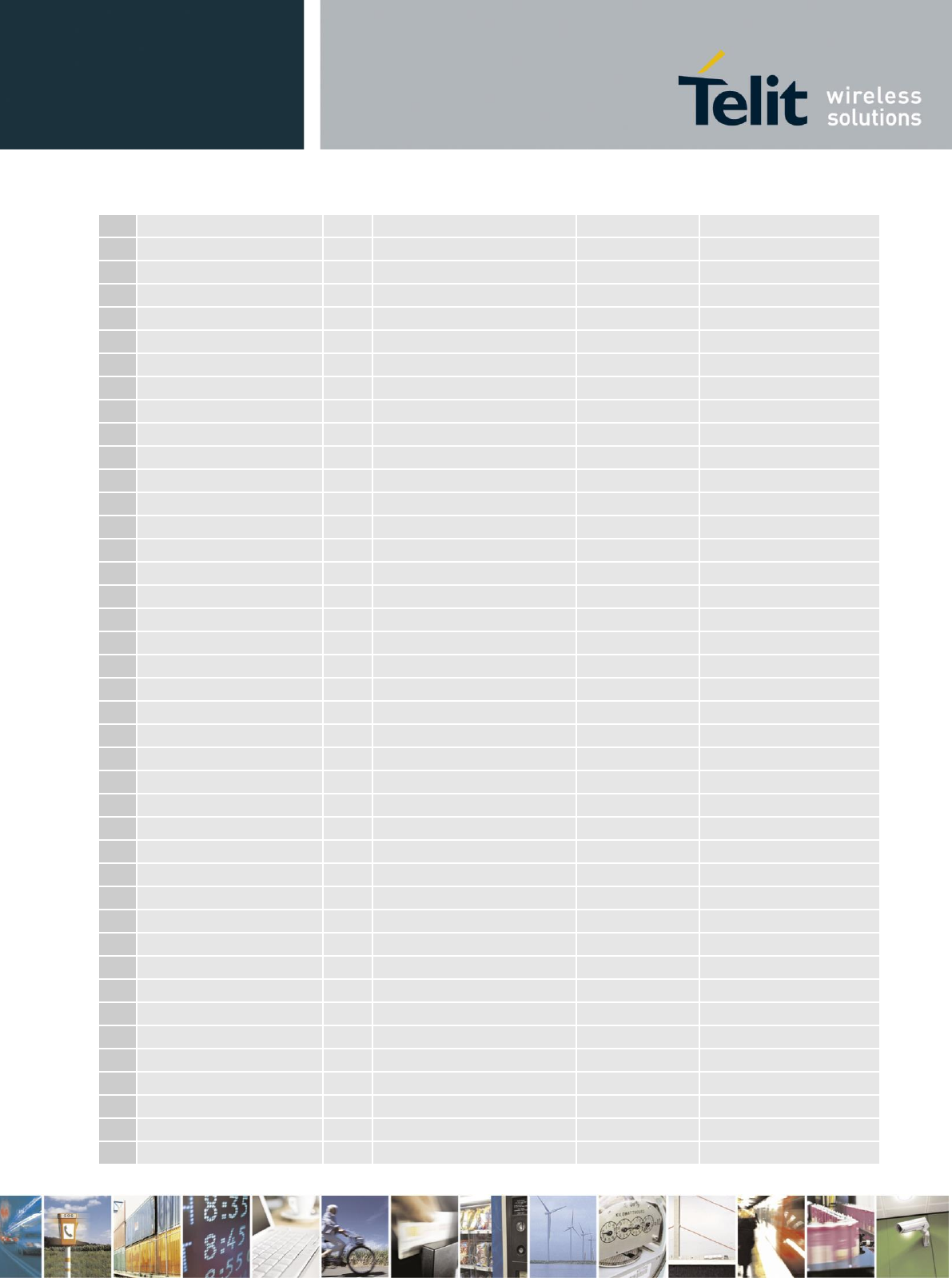
Reproduction forbidden without Telit Communications S.p.A. written authorization - All Rights Reserved page 13 of 93
N2
VBATT_PA
-
Main power supply (Radio PA)
Power
P1
VBATT_PA
-
Main power supply (Radio PA)
Power
P2
VBATT_PA
-
Main power supply (Radio PA)
Power
E1
GND
-
Ground
Power
G1
GND
-
Ground
Power
H1
GND
-
Ground
Power
J1
GND
-
Ground
Power
L1
GND
-
Ground
Power
A2
GND
-
Ground
Power
E2
GND
-
Ground
Power
F2
GND
-
Ground
Power
G2
GND
-
Ground
Power
H2
GND
-
Ground
Power
J2
GND
-
Ground
Power
K2
GND
-
Ground
Power
L2
GND
-
Ground
Power
R2
GND
-
Ground
Power
M3
GND
-
Ground
Power
N3
GND
-
Ground
Power
P3
GND
-
Ground
Power
R3
GND
-
Ground
Power
D4
GND
-
Ground
Power
M4
GND
-
Ground
Power
N4
GND
-
Ground
Power
P4
GND
-
Ground
Power
R4
GND
-
Ground
Power
N5
GND
-
Ground
Power
P5
GND
-
Ground
Power
R5
GND
-
Ground
Power
N6
GND
-
Ground
Power
P6
GND
-
Ground
Power
R6
GND
-
Ground
Power
P8
GND
-
Ground
Power
R8
GND
-
Ground
Power
P9
GND
-
Ground
Power
P10
GND
-
Ground
Power
R10
GND
-
Ground
Power
M12
GND
-
Ground
Power
B13
GND
-
Ground
Power
P13
GND
-
Ground
Power
E14
GND
-
Ground
Power
DRAFT
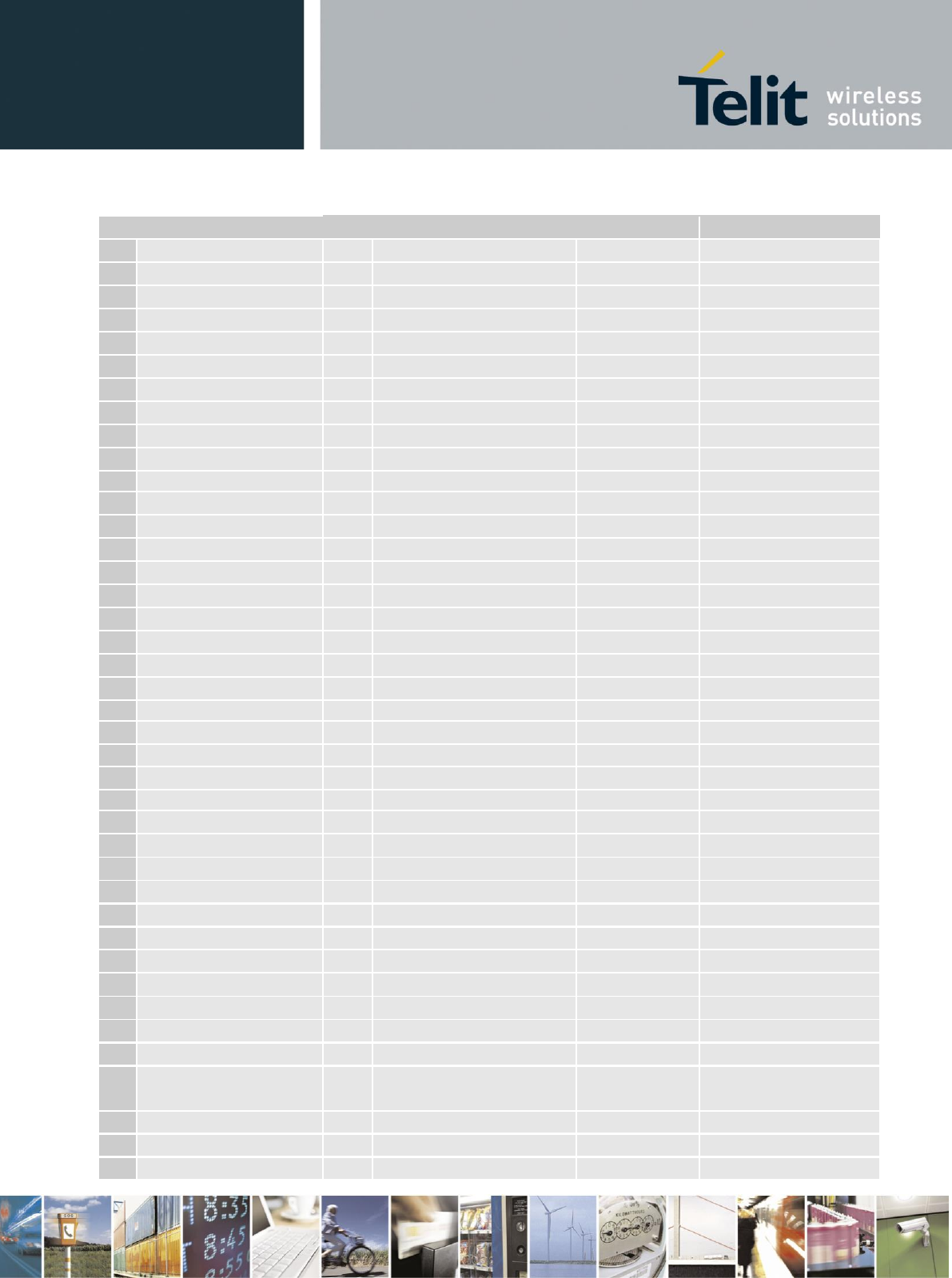
Reproduction forbidden without Telit Communications S.p.A. written authorization - All Rights Reserved page 14 of 93
RESERVED
C1
RESERVED
-
RESERVED
D1
RESERVED
-
RESERVED
B2
RESERVED
-
RESERVED
C2
RESERVED
-
RESERVED
D2
RESERVED
-
RESERVED
B3
RESERVED
-
RESERVED
C3
RESERVED
-
RESERVED
D3
RESERVED
-
RESERVED
E3
RESERVED
-
RESERVED
F3
RESERVED
-
RESERVED
G3
RESERVED
-
RESERVED
H3
RESERVED
-
RESERVED
J3
RESERVED
-
RESERVED
K3
RESERVED
-
RESERVED
L3
RESERVED
-
RESERVED
B4
RESERVED
-
RESERVED
C4
RESERVED
-
RESERVED
B5
RESERVED
-
RESERVED
C5
RESERVED
-
RESERVED
C6
RESERVED
-
RESERVED
C7
RESERVED
-
RESERVED
N7
RESERVED
-
RESERVED
P7
RESERVED
-
RESERVED
N8
RESERVED
-
RESERVED
N9
RESERVED
-
RESERVED
A10
RESERVED
-
RESERVED
N10
RESERVED
-
RESERVED
N11
RESERVED
-
RESERVED
B12
RESERVED
-
RESERVED
D12
RESERVED
-
RESERVED
N12
RESERVED
-
RESERVED
P12
RESERVED
-
RESERVED
F14
RESERVED
-
RESERVED
G14
RESERVED
-
RESERVED
H14
RESERVED
-
RESERVED
J14
RESERVED
-
RESERVED
K14
RESERVED
-
RESERVED
N13
RESERVED
-
RESERVED
L13
RESERVED
-
RESERVED
J13
RESERVED
-
RESERVED
M13
RESERVED
-
RESERVED
DRAFT
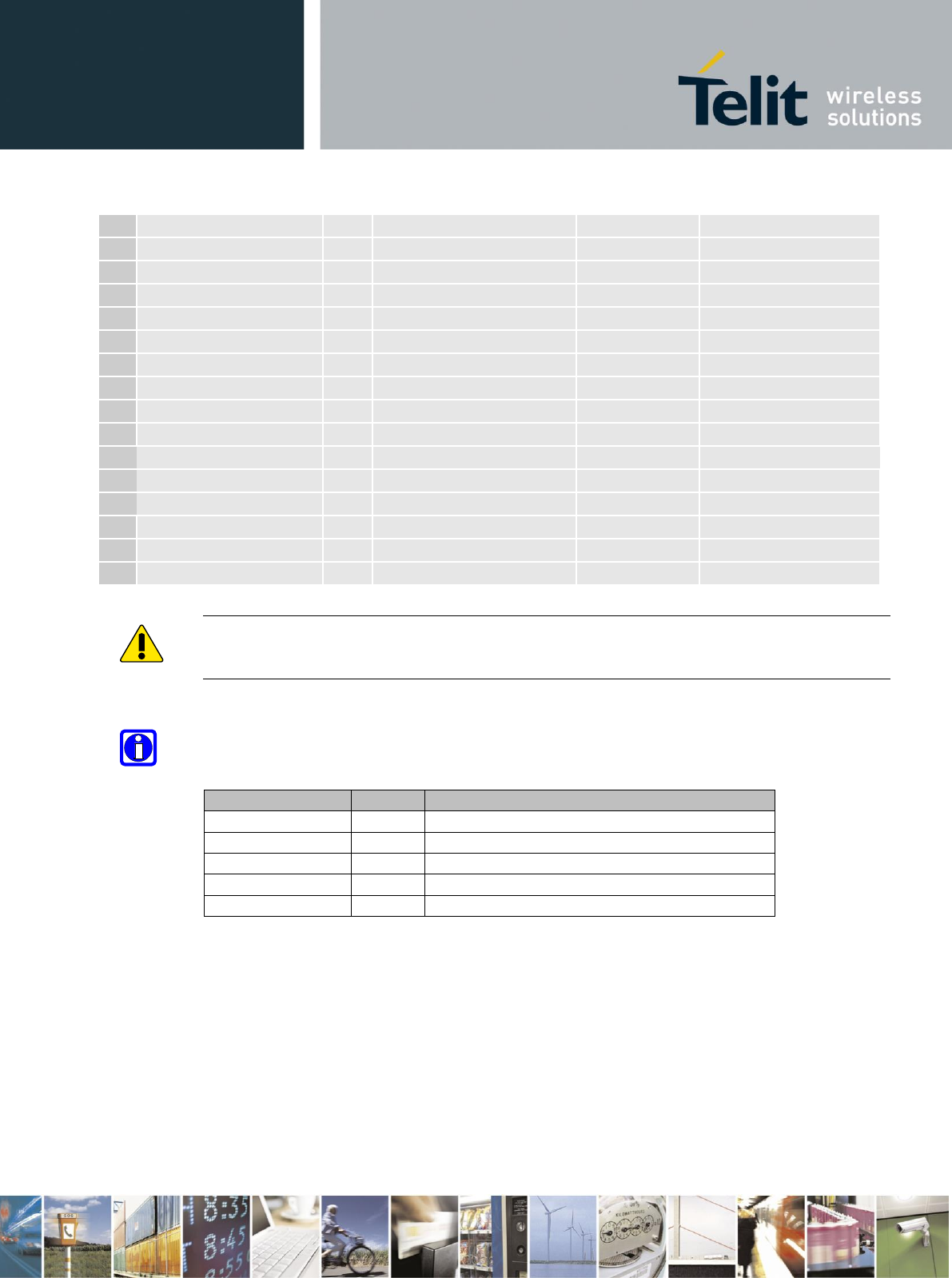
Reproduction forbidden without Telit Communications S.p.A. written authorization - All Rights Reserved page 15 of 93
K13
RESERVED
-
RESERVED
H13
RESERVED
-
RESERVED
G13
RESERVED
-
RESERVED
F13
RESERVED
-
RESERVED
B11
RESERVED
-
RESERVED
B10
RESERVED
-
RESERVED
A9
RESERVED
-
RESERVED
A8
RESERVED
-
RESERVED
D14
RESERVED
-
RESERVED
A14
RESERVED
-
RESERVED
D13
RESERVED
-
RESERVED
E13
RESERVED
-
RESERVED
F1
RESERVED
-
RESERVED
R9
RESERVED
-
RESERVED
R7
RESERVED
-
RESERVED
P11
RESERVED
-
RESERVED
WARNING:
Reserved pins must not be connected.
NOTE 1:
The following table is listing the main Pinout differences between the UE910 variants
Product
Audio
Notes
UE910-EUR
YES
Analog and digital audio
UE910-EUD
NO
Reserved Pads:,B2, B3, B4, B5
UE910-NAR
YES
Analog and digital audio
UE910-NAD
NO
Reserved Pads:,B2, B3, B4, B5
UE910-GL
YES
Digital Audio; Reserved Pads:B2, B3, B4, B5
DRAFT
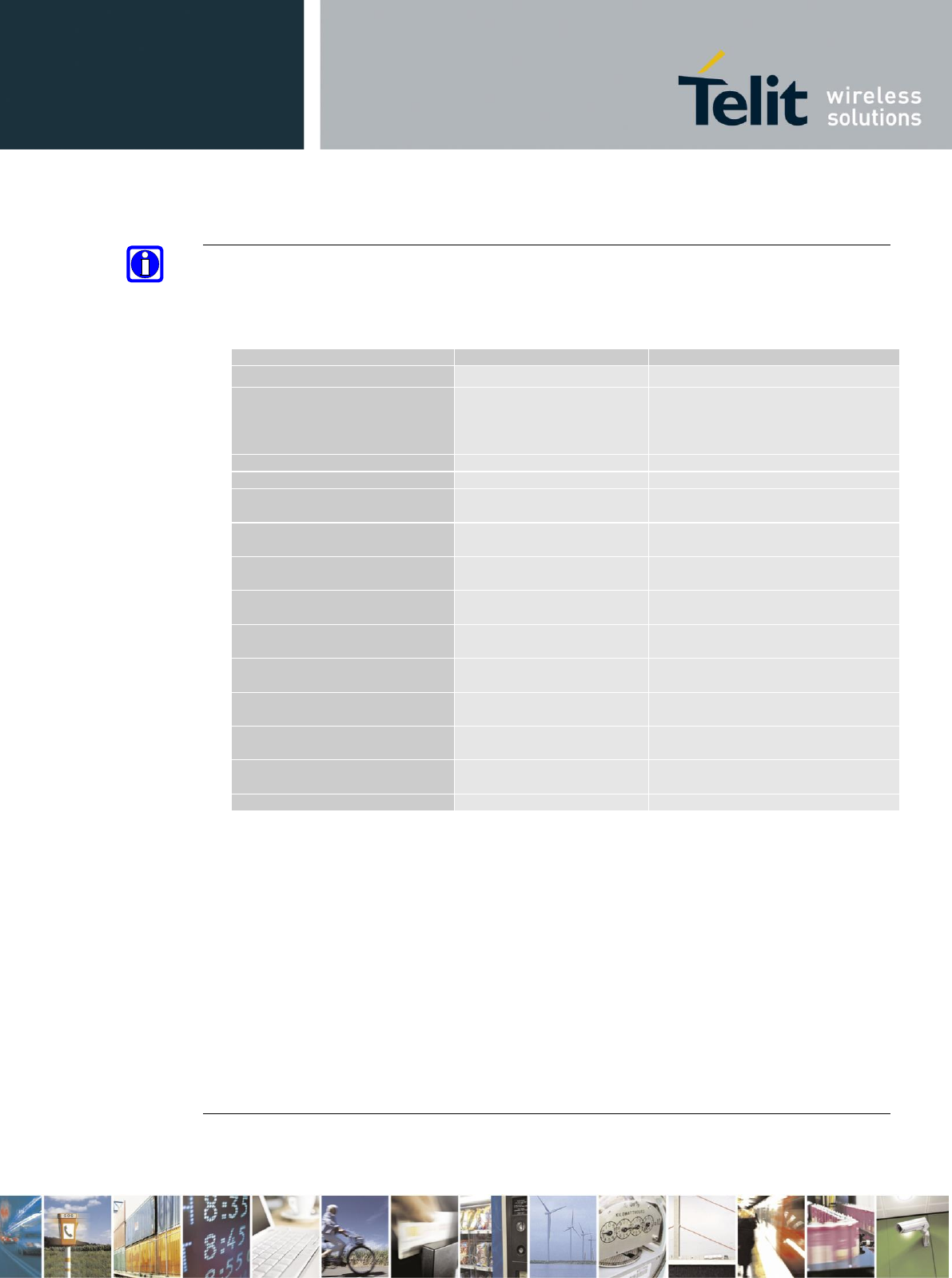
Reproduction forbidden without Telit Communications S.p.A. written authorization - All Rights Reserved page 16 of 93
NOTE:
If not used, almost all pins should be left disconnected. The only exceptions are the following
pins:
RTS pin should be connected to the GND (on the module side) if flow control is not used.
The above pins are also necessary to debug the application when the module is assembled on it so we
recommend connecting them also to dedicated test point.
PAD
Signal
Notes
M1,M2,N1,N2,P1,P2
VBATT & VBATT_PA
E1,G1,H1,J1,L1,A2,E2,F2,G2,H2,
J2,K2,L2,R2,M3,N3,P3,R3,D4,M4,
N4,P4,R4,N5,P5,R5,N6,P6,R6,P8,
R8,P9,P10,R10,M12,B13,P13,E14
GND
R12
ON/OFF*
R13
HW_SHUTDOWN*
B15
USB_D+
If not used should be connected to a
Test Point or an USB connector
C15
USB_D-
If not used should be connected to a
Test Point or an USB connector
A13
VUSB
If not used should be connected to a
Test Point or an USB connector
N15
C103/TXD
If not used should be connected to a
Test Point
M15
C104/RXD
If not used should be connected to a
Test Point
L14
C105/RTS
If the flow control is not used it should
be connected to GND
P15
C106/CTS
If not used should be connected to a
Test Point
D15
TXD_AUX
If not used should be connected to a
Test Point
E15
RXD_AUX
If not used should be connected to a
Test Point
K1
MAIN ANTENNA
DRAFT
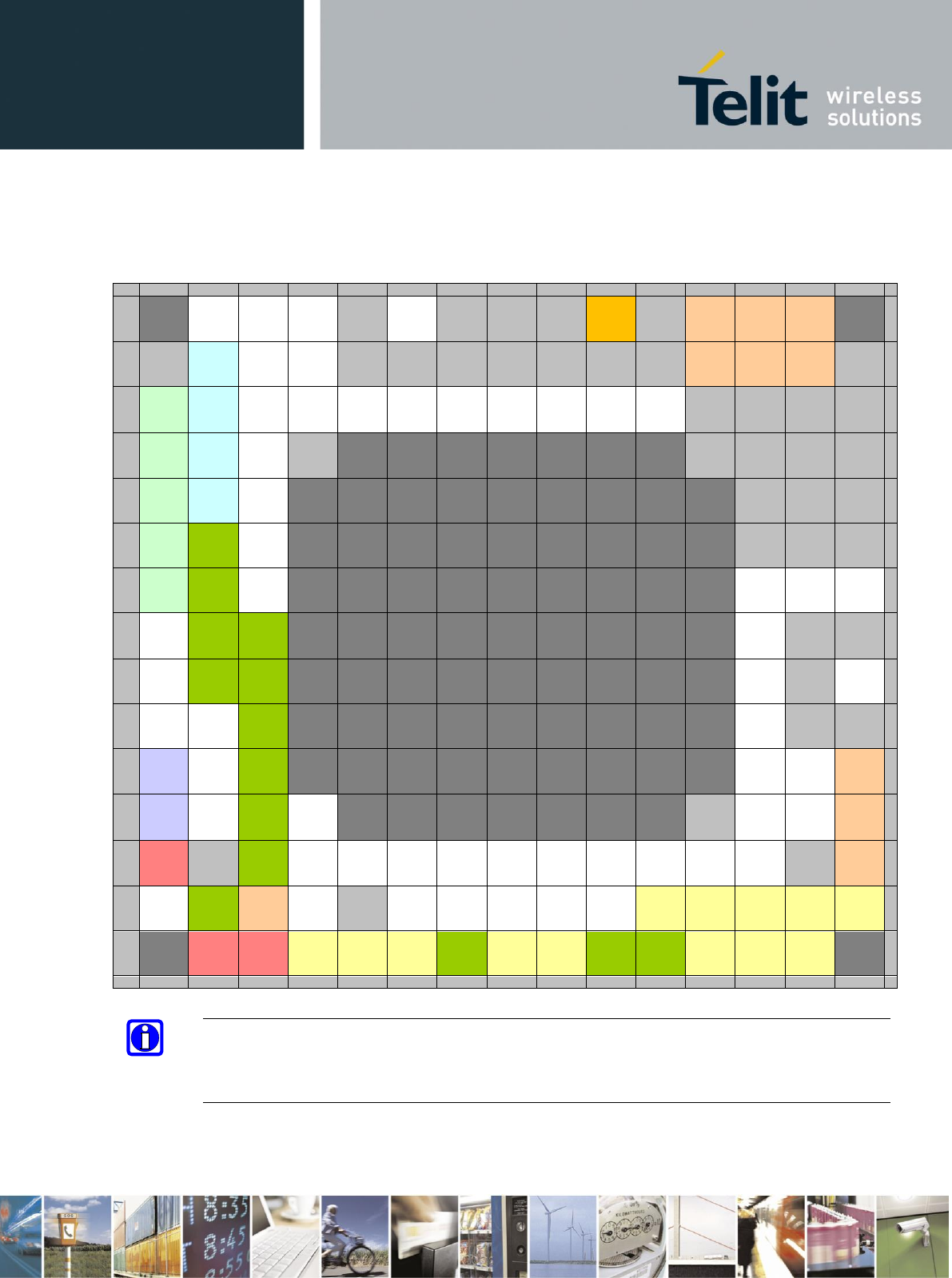
Reproduction forbidden without Telit Communications S.p.A. written authorization - All Rights Reserved page 17 of 93
3.1.1 LGA Pads Layout
TOP VIEW
A
B
C
D
E
F
G
H
J
K
L
M
N
P
R
1
ADC_IN1
RES
RES
GND
RES
GND
GND
GND
ANT
GND
VBATT
VBATT_P
A
VBATT_P
A
2
GND
SPK+
RES
RES
GND
GND
GND
GND
GND
GND
GND
VBATT
VBATT_P
A
VBATT_P
A
GND
3
SIMVCC
SPK -
RES
RES
RES
RES
RES
RES
RES
RES
RES
GND
GND
GND
GND
4
SIMIN
MIC+
RES
GND
GND
GND
GND
GND
5
SIMIO
MIC -
RES
GND
GND
GND
6
SIMCLK
DVI_RX
RES
GND
GND
GND
7
SIMRST
DVI_TX
RES
RES
RES
RES
8
RES
DVI_CLK
GPIO_01
RES
GND
GND
9
RES
DVI_WA0
GPIO_02
RES
GND
RES
10
RES
RES
GPIO_03
RES
GND
GND
11
HSIC_US
B_STRB
RES
GPIO_04
RES
RES
VAUX/PW
RMON
12
HSIC_US
B_DATA
RES
GPIO_06
RES
GND
RES
RES
ON_OFF*
13
VUSB
GND
GPIO_07
RES
RES
RES
RES
RES
RES
RES
RES
RES
RES
GND
HW_SHU
TDOWN*
14
RES
GPIO_05
VRTC
RES
GND
RES
RES
RES
RES
RES
C105/RTS
C108/DTR
C109/DC
D
C107/DSR
C125/RIN
G
15
USB_D+
USB_D-
TX AUX
RX AUX
SPI_CLK
GPIO_10
SPI_MRD
Y
SPI_SRD
Y
GPIO_08
GPIO_09
C104/RXD
C103/TXD
C106/CTS
NOTE:
The pin defined as RES has to be considered RESERVED and not connected on any pin in the
application.
DRAFT
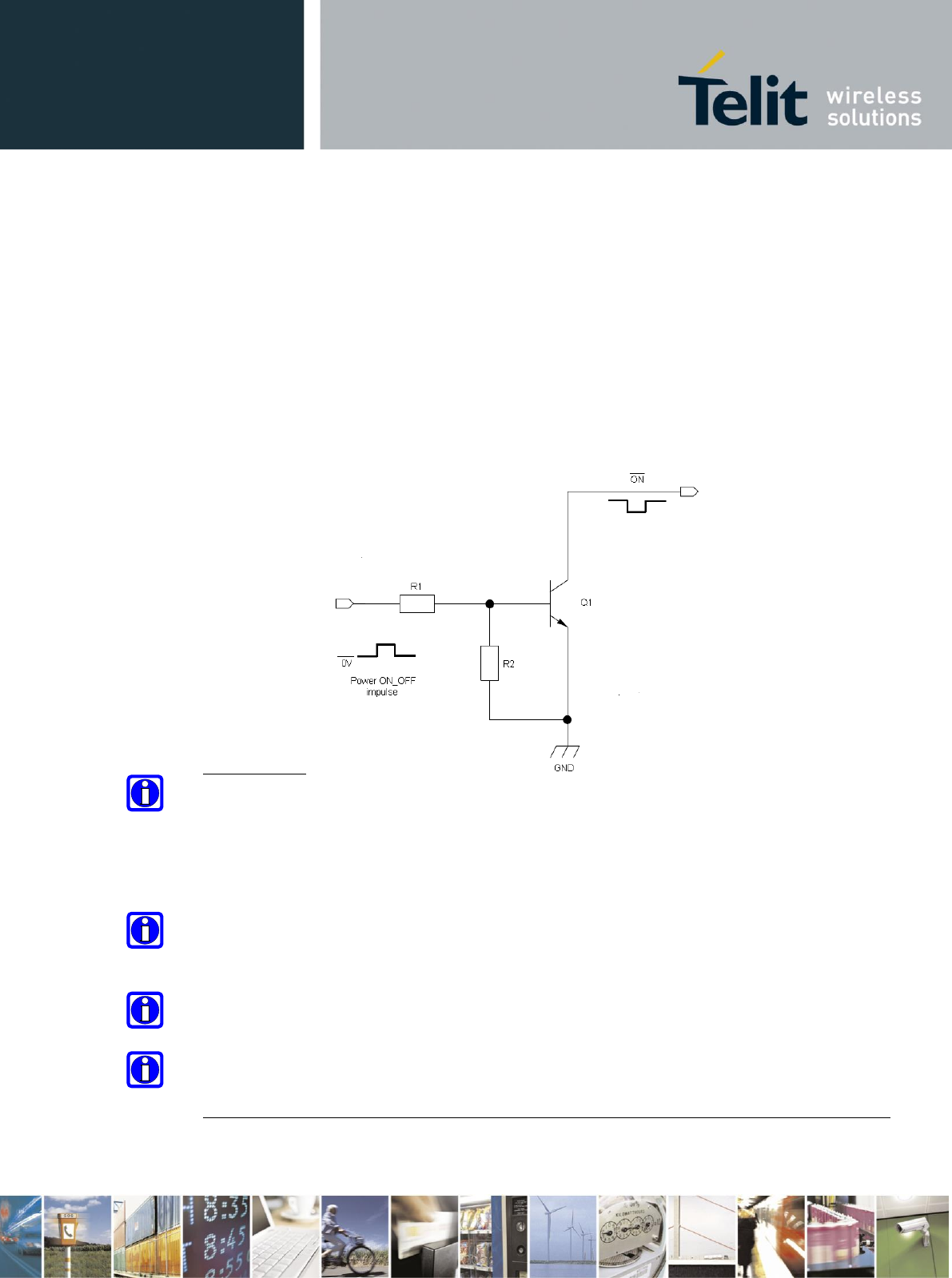
Reproduction forbidden without Telit Communications S.p.A. written authorization - All Rights Reserved page 18 of 93
4 Hardware Commands
4.1 Turning ON the UE910
To turn on the UE910 the pad ON_OFF* must be tied low for at least 5 seconds and then
released.
The maximum current that can be drained from the ON_OFF* pad is 0,1 mA.
A simple circuit to do it is:
NOTE:
Don't use any pull up resistor on the ON_OFF* line, it is internally pulled up. Using pull up
resistor may bring to latch up problems on the UE910 power regulator and improper power
on/off of the module. The line ON_OFF* must be connected only in open collector or open
drain configuration.
NOTE:
In this document all the lines that are inverted, hence have active low signals are labelled with a
name that ends with”#",”*” or with a bar over the name.
TIP:
To check if the device has powered on, the hardware line PWRMON should be monitored.
NOTE:
It is mandatory to avoid sending data to the serial ports during the first 200ms of the module
start-up.
DRAFT
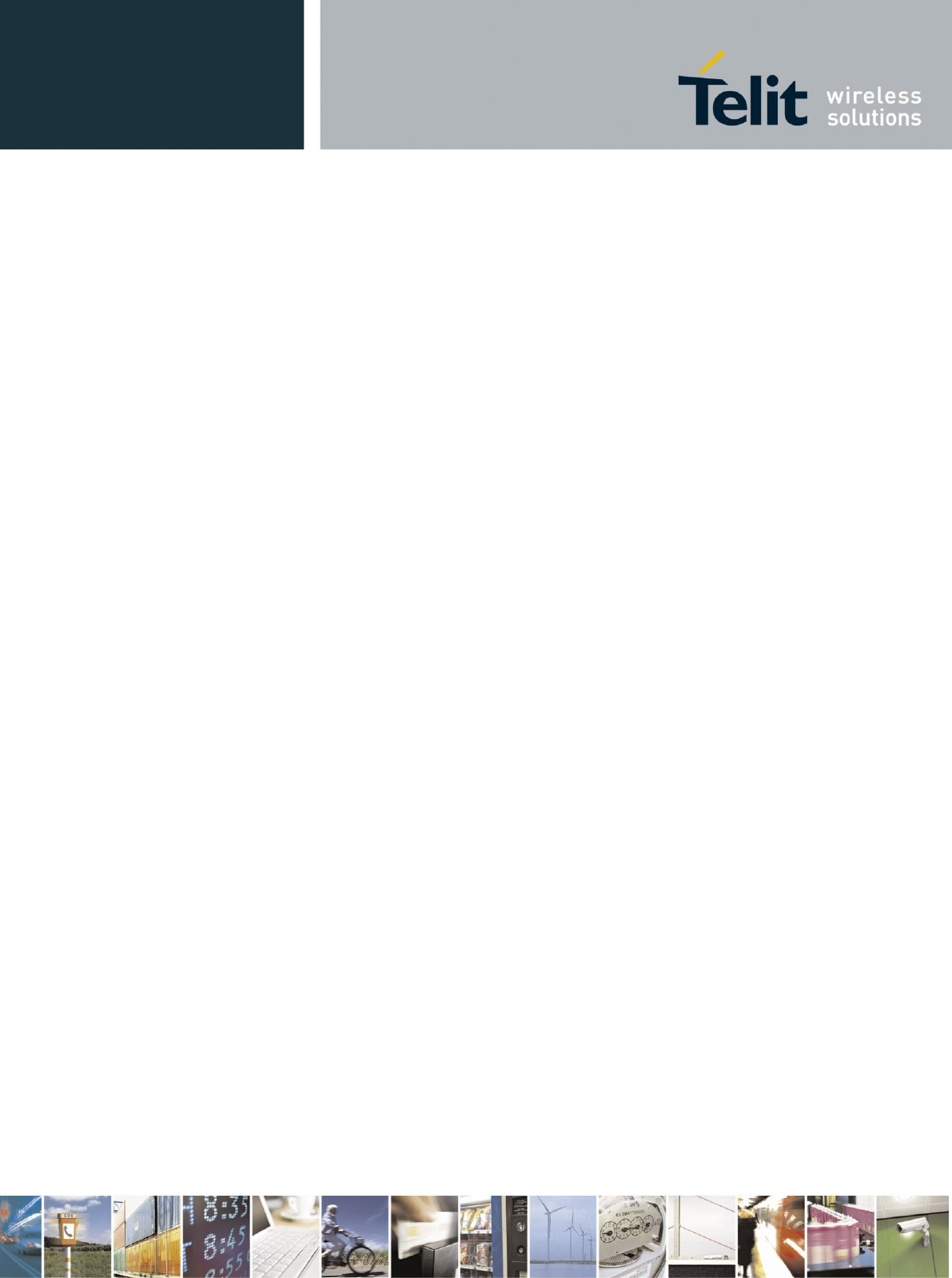
Reproduction forbidden without Telit Communications S.p.A. written authorization - All Rights Reserved page 19 of 93
A flow chart showing the proper turn on procedure is displayed below:
DRAFT
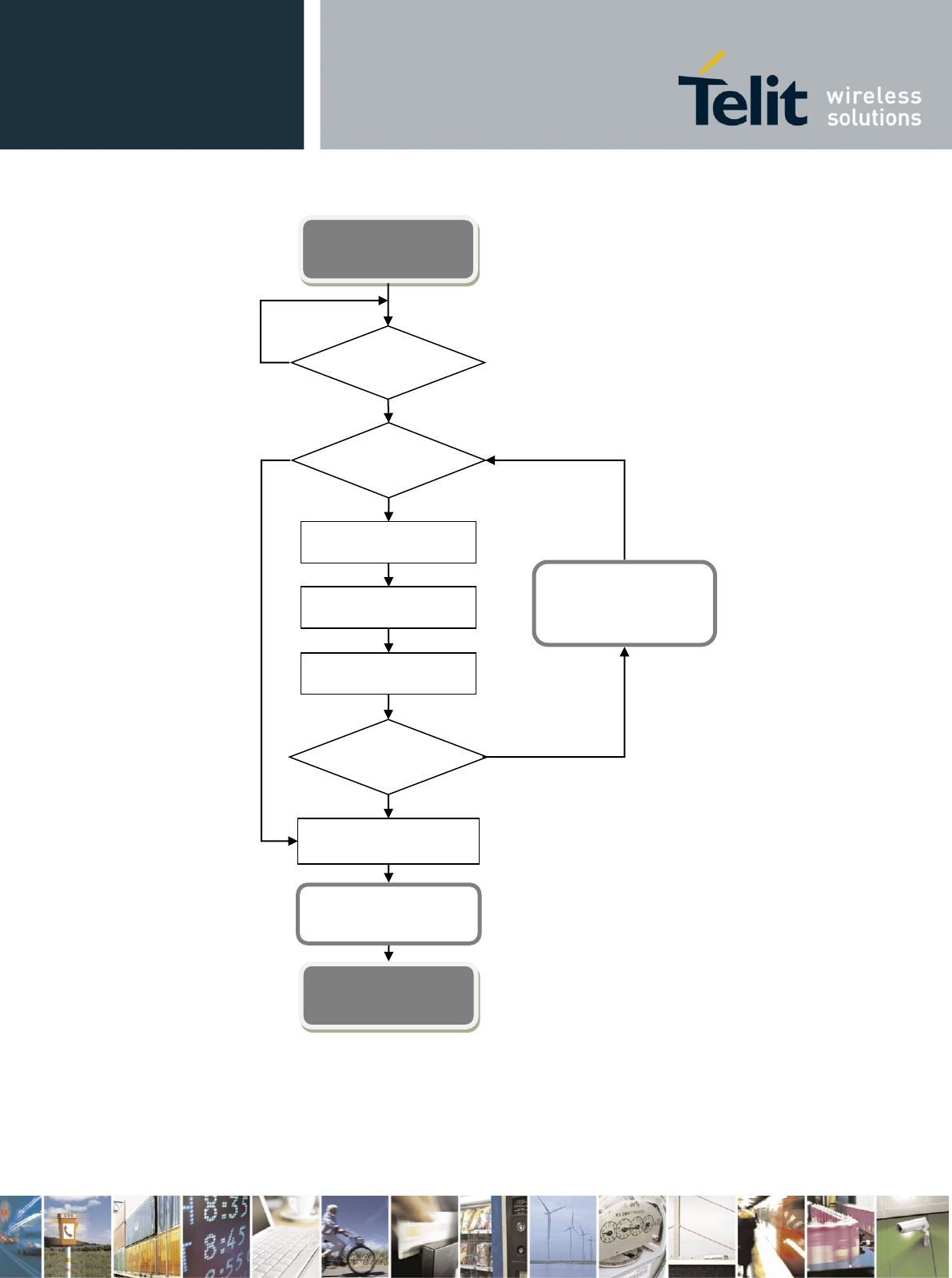
Reproduction forbidden without Telit Communications S.p.A. written authorization - All Rights Reserved page 20 of 93
“Modem ON Proc”
START
Y
Y
GOTO
“HW SHUTDOWN
unconditional”
GOTO
“Start AT CMD.”
N
PWMON = ON ?
PWMON = ON ?
N
Delay 1s
ON_OFF* = LOW
Delay = 5 Sec
ON_OFF* = HIGH
“Modem ON Proc”
END
VBATT > 3.22V ?
Y
N
DRAFT
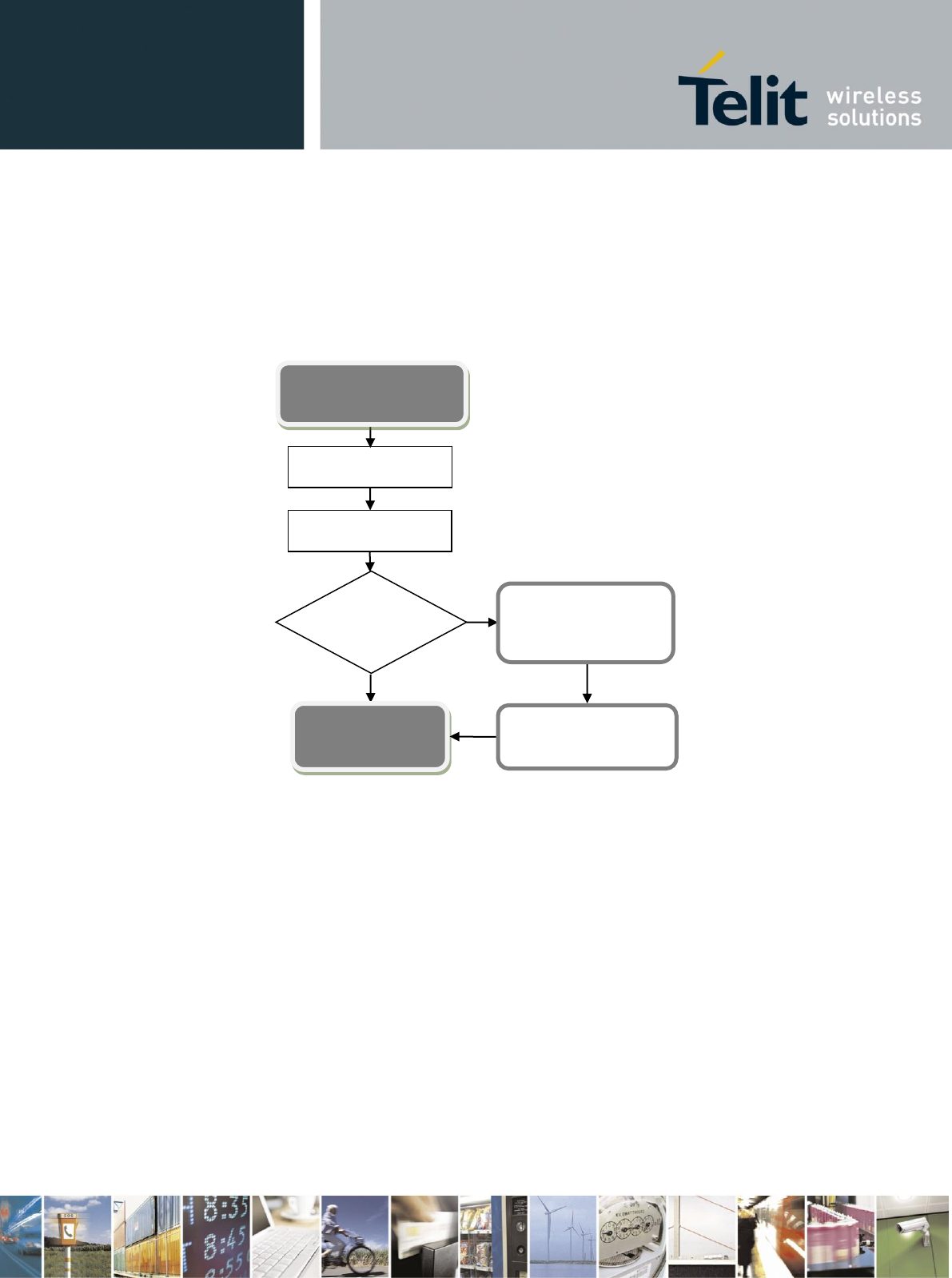
Reproduction forbidden without Telit Communications S.p.A. written authorization - All Rights Reserved page 21 of 93
A flow chart showing the AT commands managing procedure is displayed below:
AT answer in
1 sec ?
N
Y
“Start AT CMD.”
START
DELAY 300msec
Enter AT<CR>
“Start AT CMD.”
END
GOTO
“HW SHUTDOWN
unconditional”
GOTO
“Modem ON Proc.”
DRAFT
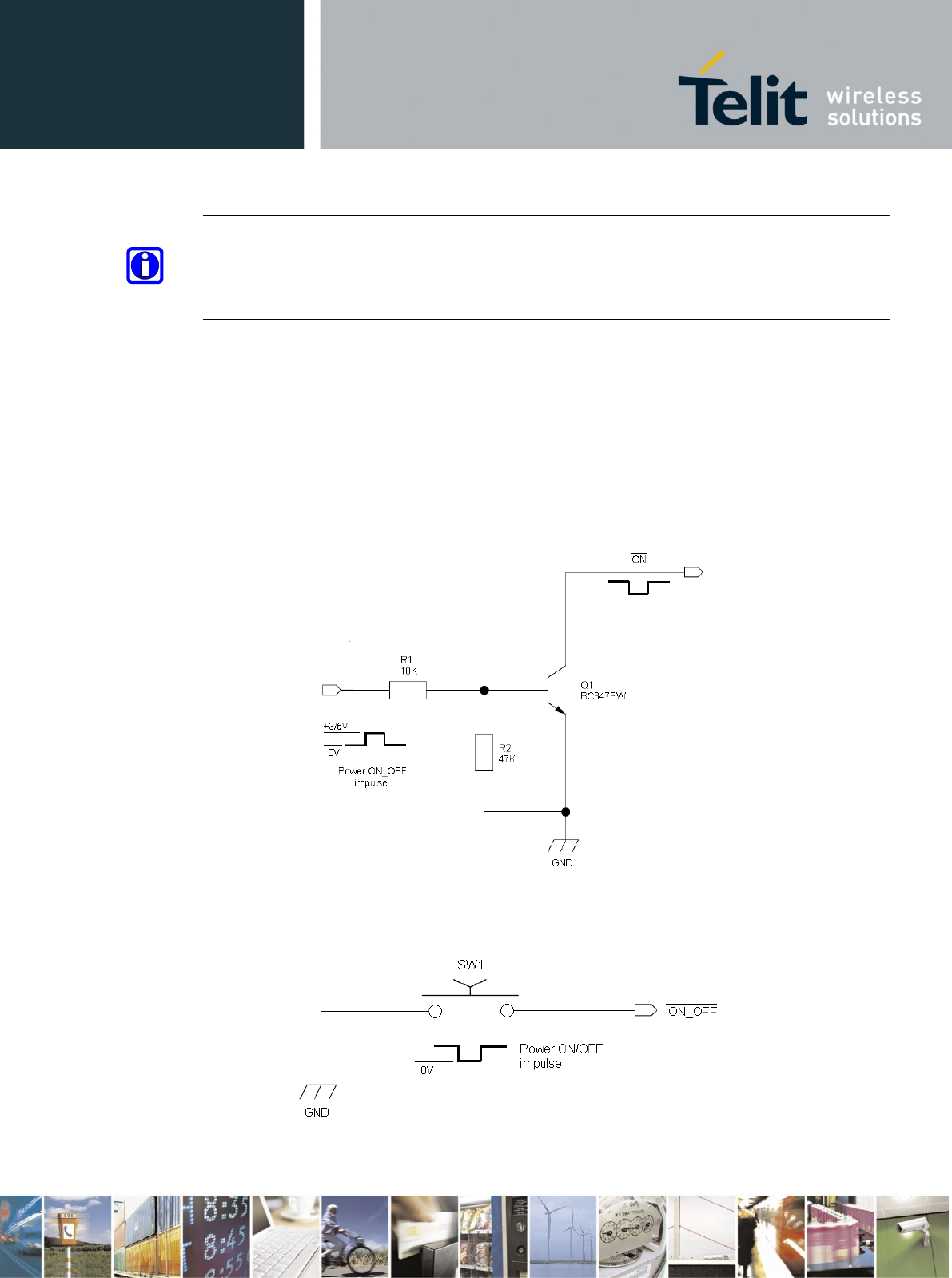
Reproduction forbidden without Telit Communications S.p.A. written authorization - All Rights Reserved page 22 of 93
NOTE:
In order to avoid a back powering effect it is recommended to avoid having any HIGH logic
level signal applied to the digital pins of the UE910 when the module is powered off or during
an ON/OFF transition.
For example:
1- Let's assume you need to drive the ON_OFF* pad with a totem pole output of a +3/5 V
microcontroller (uP_OUT1):
2- Let's assume you need to drive the ON_OFF* pad directly with an ON/OFF button:
DRAFT
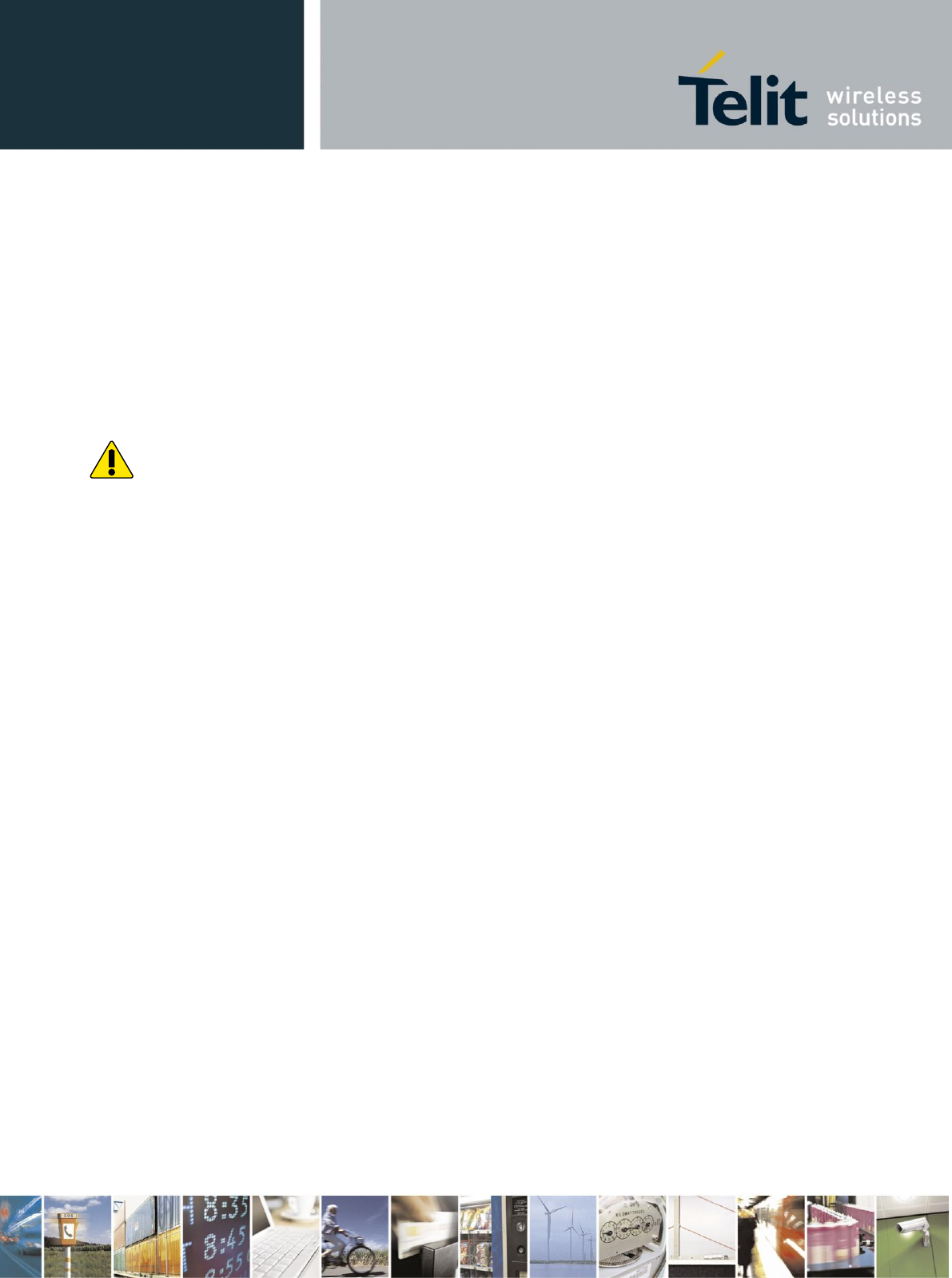
Reproduction forbidden without Telit Communications S.p.A. written authorization - All Rights Reserved page 23 of 93
WARNING
It is recommended to set the ON_OFF* line LOW to power on the module only after VBATT is higher
than 3.22V.
In case this condition it is not satisfied you could use the HW_SHUTDOWN* line to recover it and
then restart the power on activity using the ON_OFF * line.
An example of this is described in the following diagram:
DRAFT
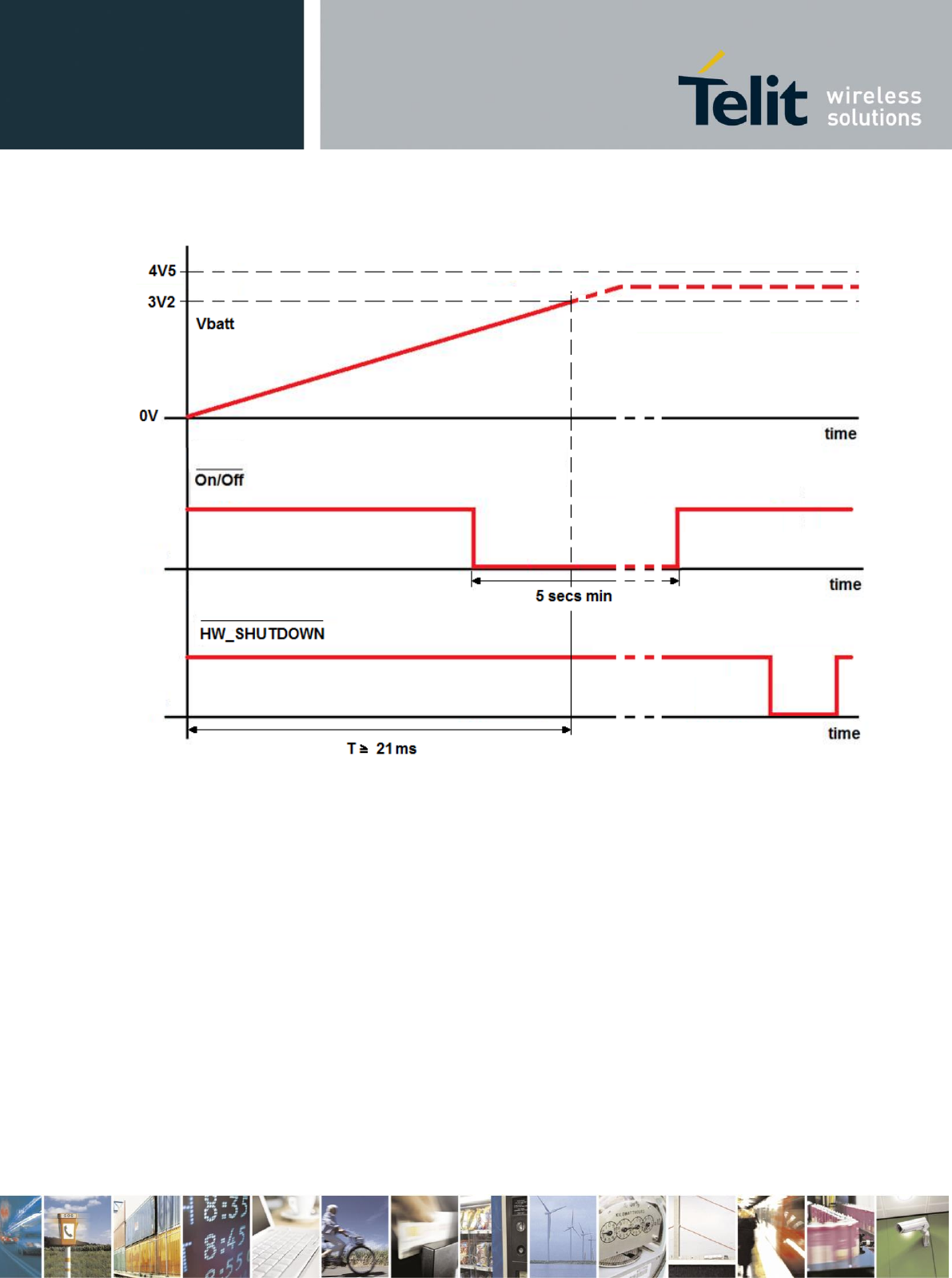
Reproduction forbidden without Telit Communications S.p.A. written authorization - All Rights Reserved page 24 of 93
After HW_SHUTSDOWN* is released you could again use the ON_OFF* line to power on the
module.
DRAFT
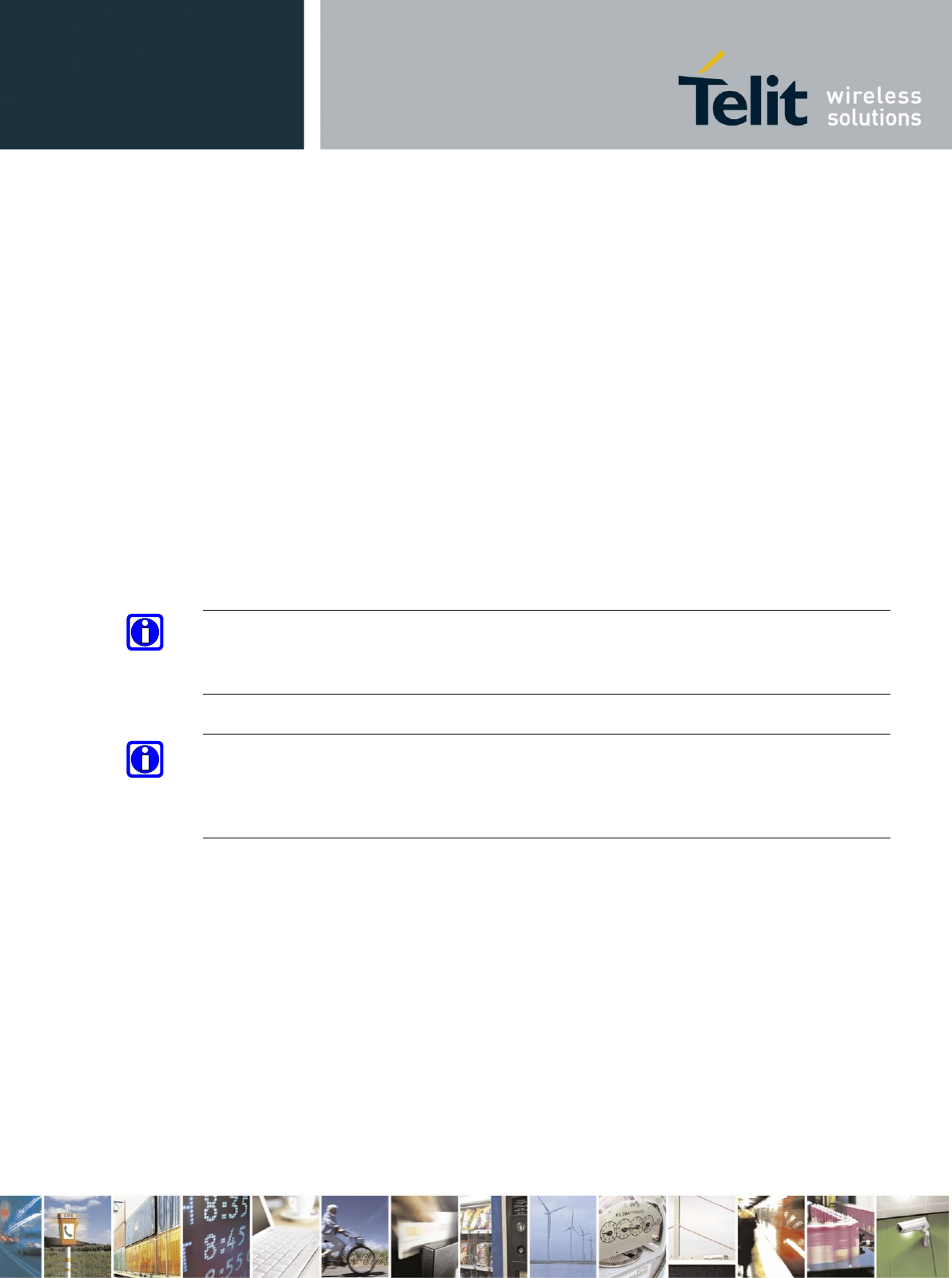
Reproduction forbidden without Telit Communications S.p.A. written authorization - All Rights Reserved page 25 of 93
4.2 Turning OFF the UE910
Turning off of the device can be done in two ways:
via AT command (see UE910 Software User Guide, AT#SHDN)
by tying low pin ON_OFF*
Either ways, the device issues a detach request to network informing that the device will not be
reachable any more.
To turn OFF the UE910 the pad ON_OFF* must be tied low for at least 3 seconds and then
released.
TIP:
To check if the device has been powered off, the hardware line PWRMON must be monitored.
The device is powered off when PWRMON goes low.
NOTE:
In order to avoid a back powering effect it is recommended to avoid having any HIGH logic
level signal applied to the digital pins of the UE910 when the module is powered off or during
an ON/OFF transition.
DRAFT
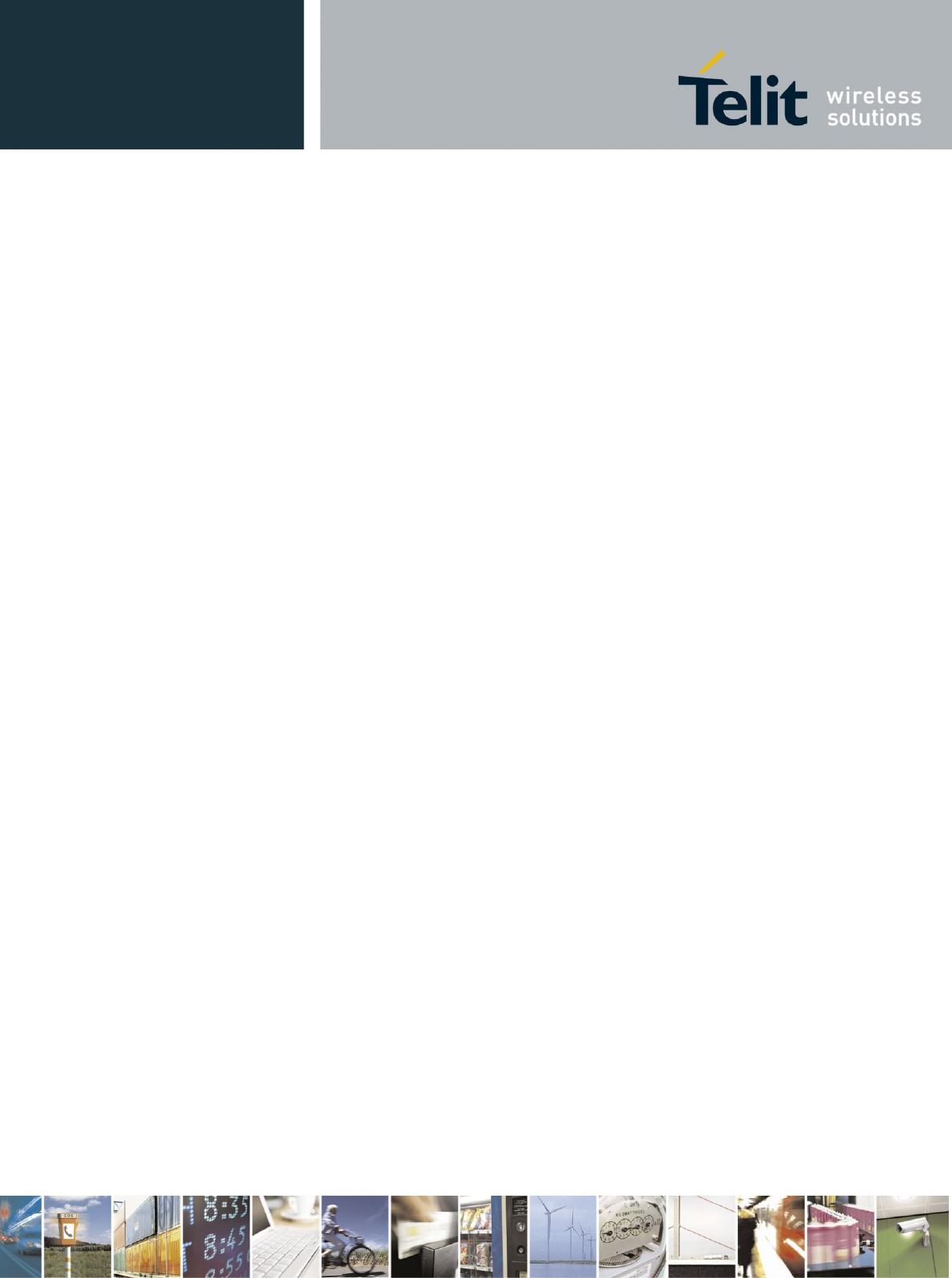
Reproduction forbidden without Telit Communications S.p.A. written authorization - All Rights Reserved page 26 of 93
The following flow chart shows the proper turn off procedure:
DRAFT
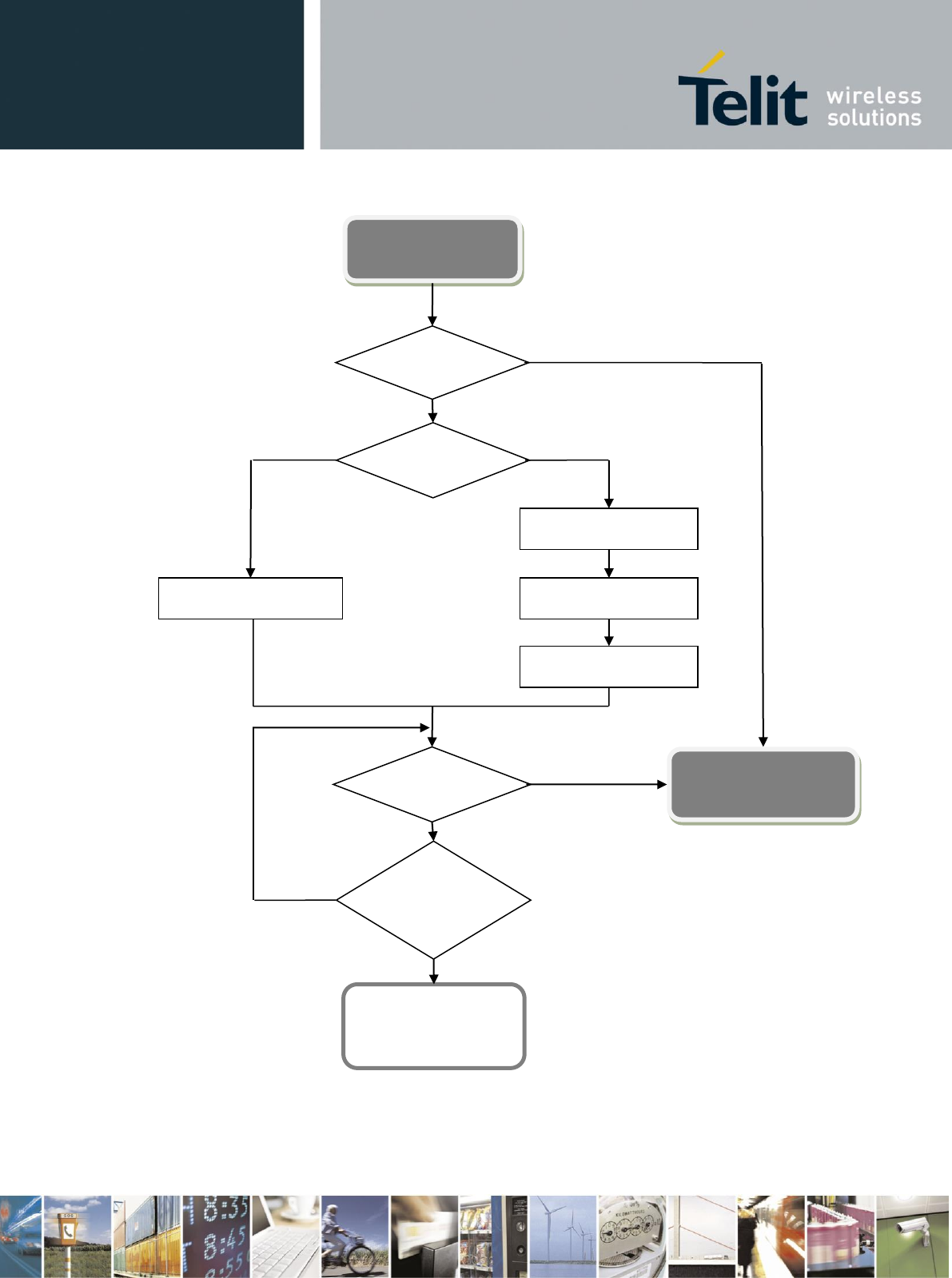
Reproduction forbidden without Telit Communications S.p.A. written authorization - All Rights Reserved page 27 of 93
Modem OFF Proc.
START
AT
Y
N
PWMON = ON ?
OFF Mode
ON_OFF* = LOW
Delay >= 3 Sec
ON_OFF* = HIGH
“Modem OFF Proc”
END
PWRMON=ON?
Y
N
Key
AT#SHDN
GOTO
“HW SHUTDOWN
Unconditional”
Looping for more
than 15s ?
Y
N
DRAFT
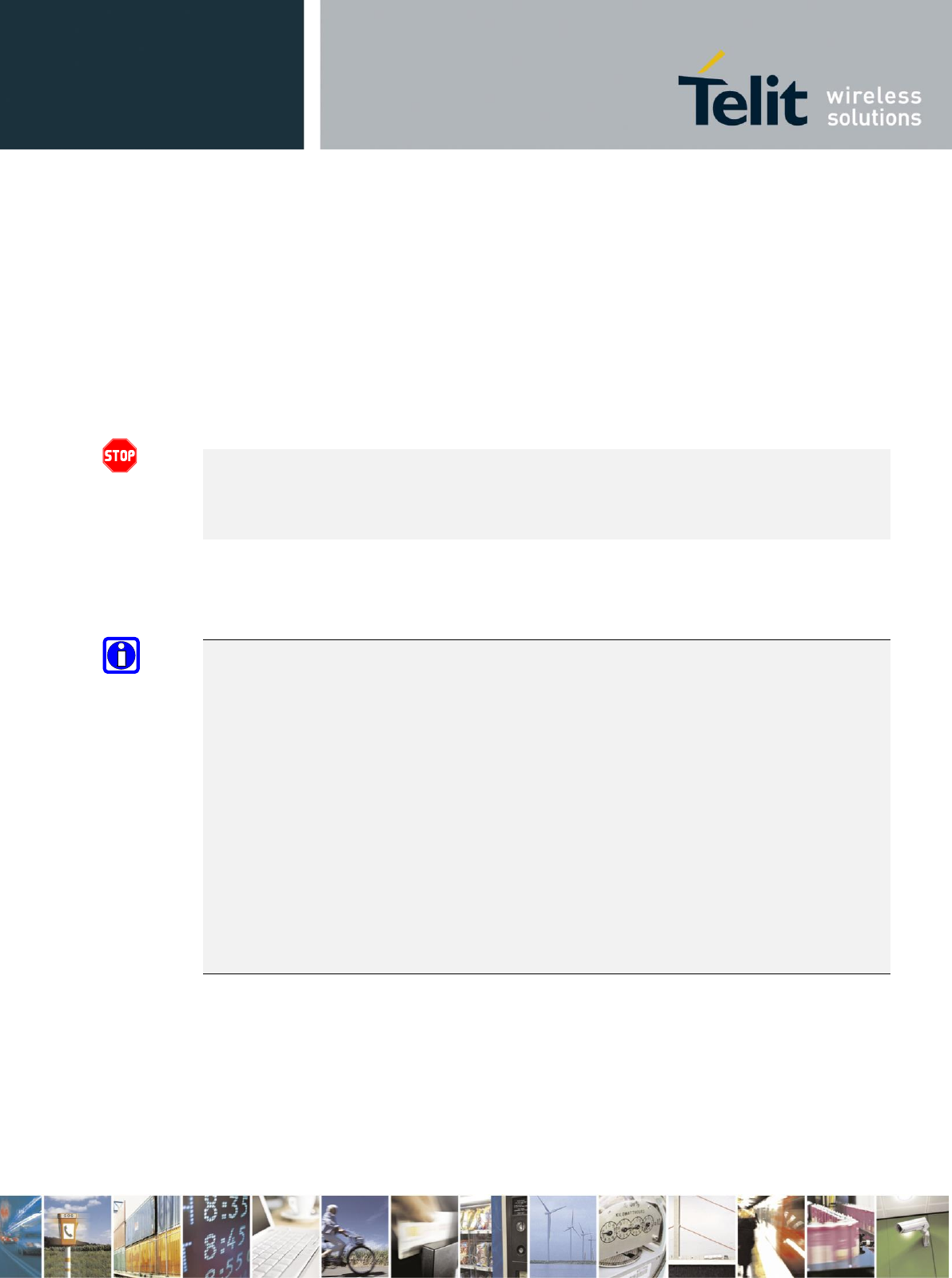
Reproduction forbidden without Telit Communications S.p.A. written authorization - All Rights Reserved page 28 of 93
4.3 UE910 Unconditional Shutdown
The Unconditional Shutdown of the module could be activated using the
HW_SHUTDOWN* line (pad R13).
WARNING:
The hardware unconditional Shutdown must not be used during normal operation of the device
since it does not detach the device from the network. It shall be kept as an emergency exit
procedure.
To unconditionally shutdown the UE910, the pad HW_SHUTDOWN* must be tied low for at
least 200 milliseconds and then released.
NOTE:
Do not use any pull up resistor on the HW_SHUTDOWN* line nor any totem pole digital
output. Using pull up resistor may bring to latch up problems on the UE910 power regulator and
improper functioning of the module. The line HW_SHUTDOWN* must be connected only in
open collector configuration.
The HW_SHUTDOWN* is generating an unconditional shutdown of the module without an
automatic restart.
The module will shutdown, but will NOT perform the detach from the cellular network.
To proper power on again the module please refer to the related paragraph (“Powering ON the
UE910”)
TIP:
The unconditional hardware shutdown must always be implemented on the boards and should be
used only as an emergency exit procedure.
DRAFT
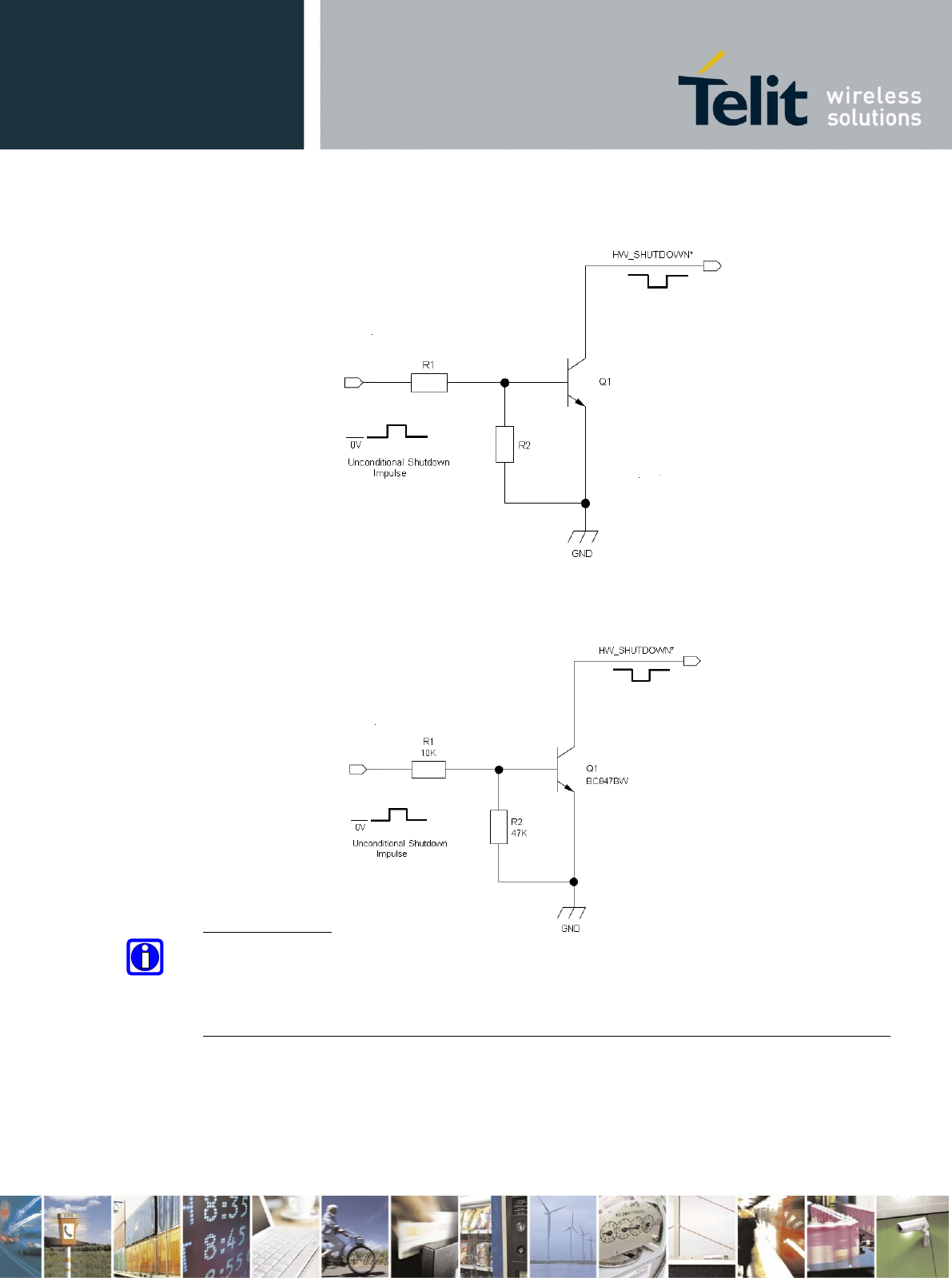
Reproduction forbidden without Telit Communications S.p.A. written authorization - All Rights Reserved page 29 of 93
A typical circuit is the following:
For example:
1- Let us assume you need to drive the HW_SHUTDOWN* pad with a totem pole output of
a +3/5 V microcontroller (uP_OUT2):
NOTE:
In order to avoid a back powering effect it is recommended to avoid having any HIGH logic
level signal applied to the digital pins of the UE910 when the module is powered off or during
an ON/OFF transition.
In the following flow chart is detailed the proper restart procedure:
DRAFT
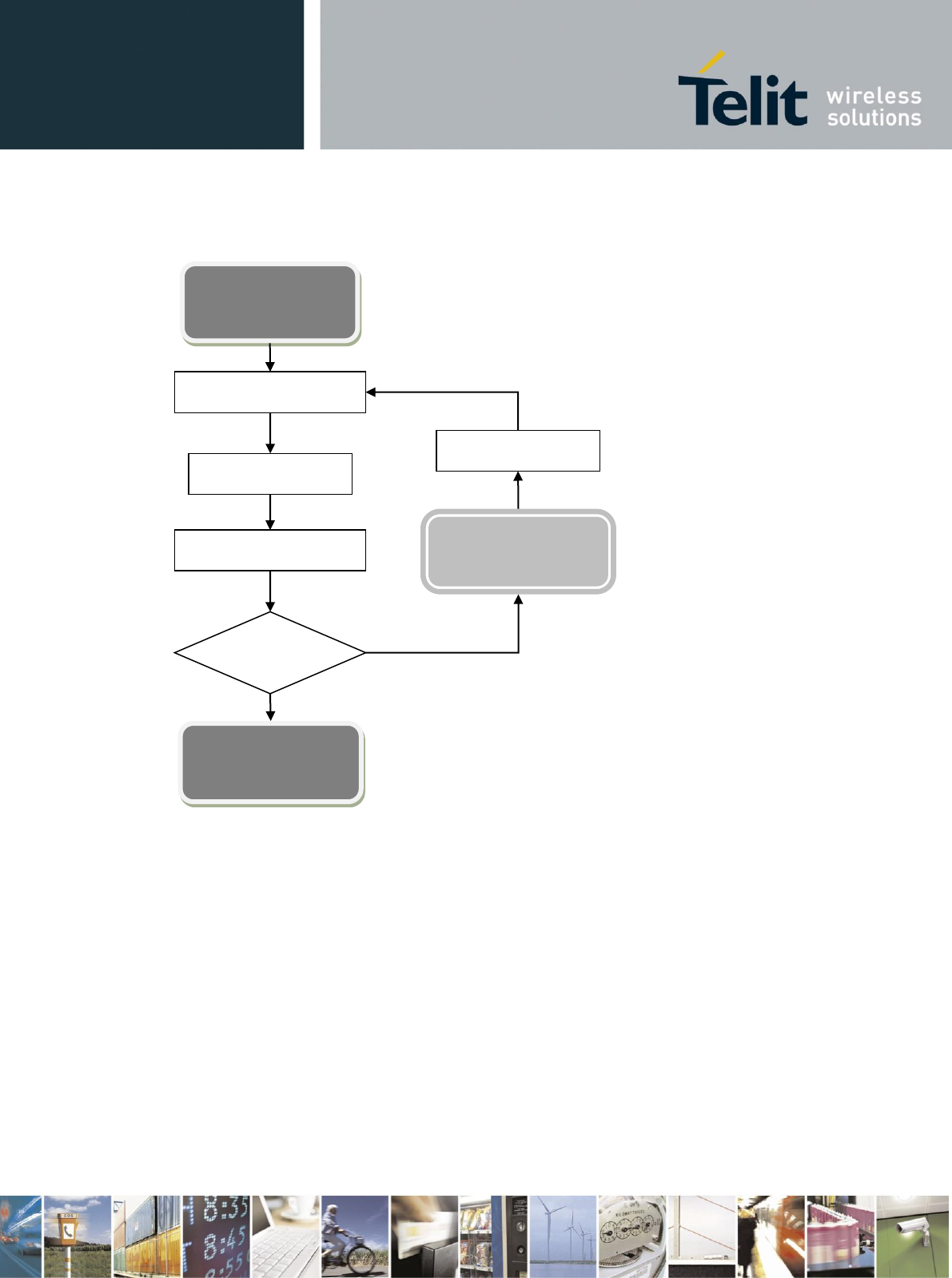
Reproduction forbidden without Telit Communications S.p.A. written authorization - All Rights Reserved page 30 of 93
“HW SHUTDOWN
Unconditional”
START
HW_SHDN = LOW
Delay 200ms
HW_SHDN = HIGH
PWRMON = ON
Delay 1s
Y
N
Disconnect
VBATT
“HW SHUTDOWN
Unconditional”
END
DRAFT
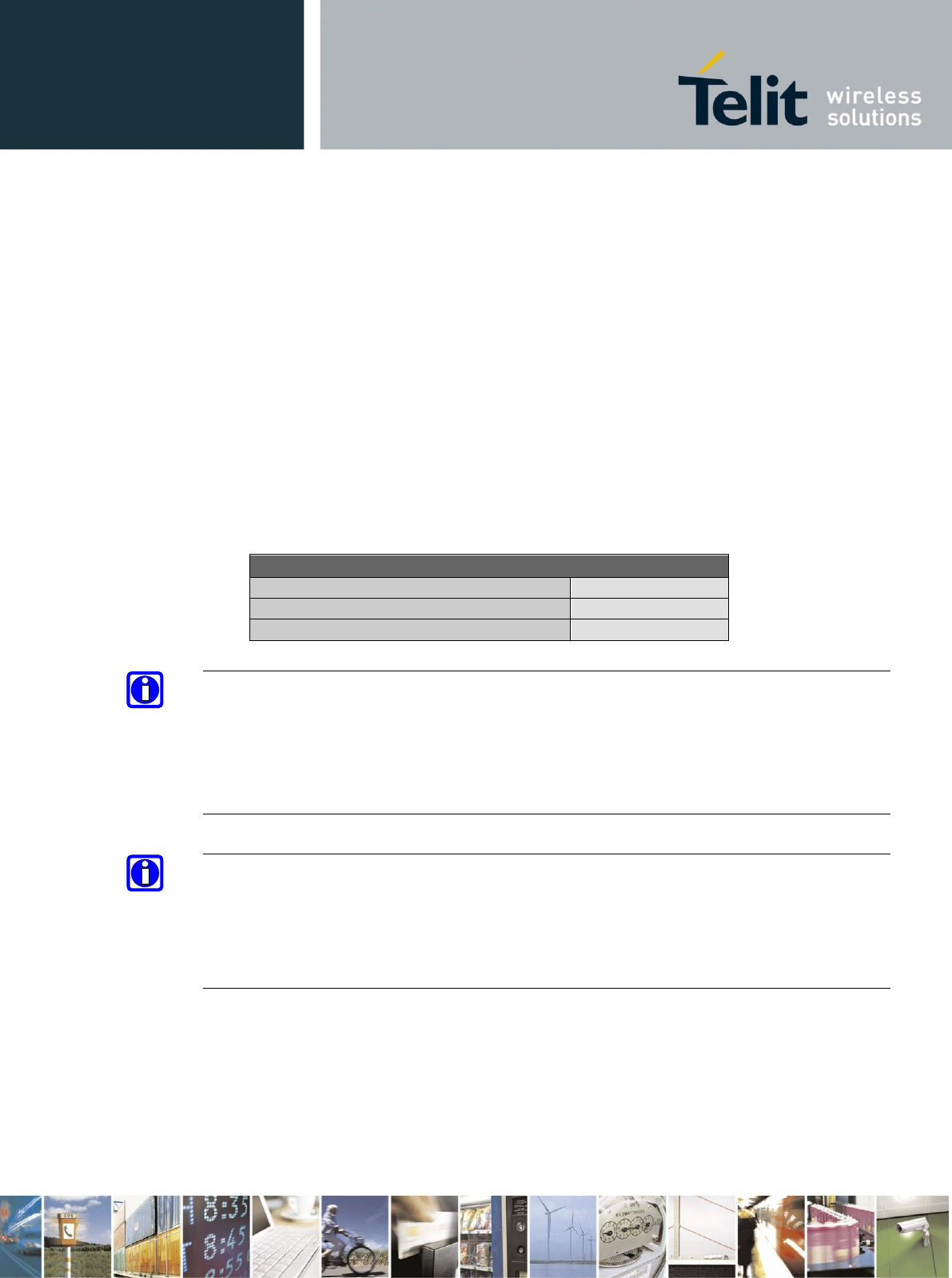
Reproduction forbidden without Telit Communications S.p.A. written authorization - All Rights Reserved page 31 of 93
5 Power Supply
The power supply circuitry and board layout are a very important part in the full product design
and they strongly reflect on the product overall performances, hence read carefully the
requirements and the guidelines that will follow for a proper design.
5.1 Power Supply Requirements
The external power supply must be connected to VBATT & VBATT_PA signals and must fulfil
the following requirements:
POWER SUPPLY
Nominal Supply Voltage
3.8 V
Normal Operating Voltage Range
3.40 V÷ 4.20 V
Extended Operating Voltage Range
3.10 V÷ 4.50 V
NOTE:
The Operating Voltage Range MUST never be exceeded; care must be taken when designing the
application’s power supply section to avoid having an excessive voltage drop.
If the voltage drop is exceeding the limits it could cause a Power Off of the module.
The Power supply must be higher than 3.22 V to power on the module
NOTE:
Overshoot voltage (regarding MAX Extended Operating Voltage) and drop in voltage
(regarding MIN Extended Operating Voltage) MUST never be exceeded;
The “Extended Operating Voltage Range” can be used only with completely assumption and
application of the HW User guide suggestions.
DRAFT
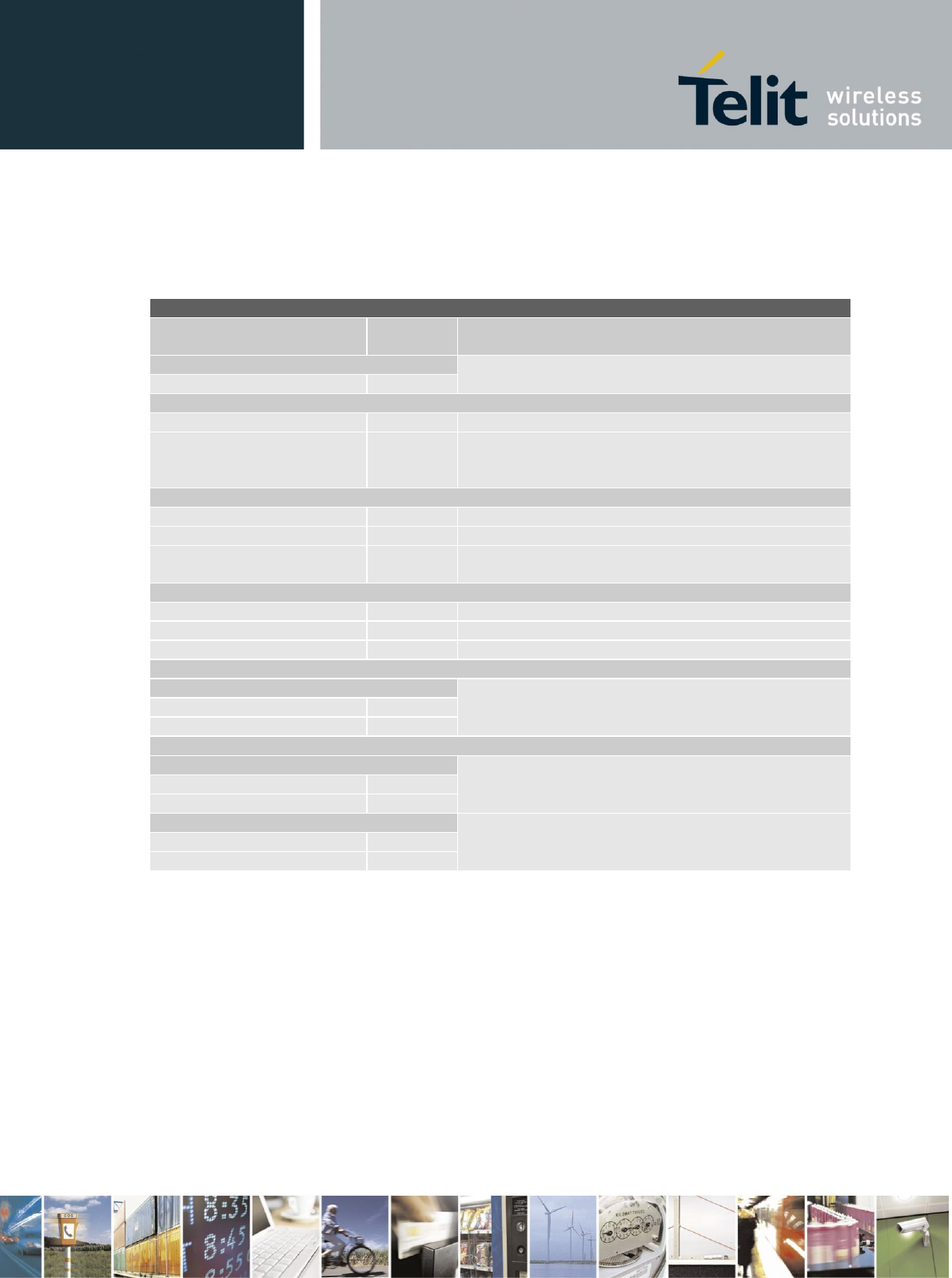
Reproduction forbidden without Telit Communications S.p.A. written authorization - All Rights Reserved page 32 of 93
5.2 Power Consumption
UE910
Mode
Average
(mA)
Mode description
SWITCHED OFF
Module supplied but Switched Off
Switched Off
180 uA
IDLE mode (WCDMA)
AT+CFUN=1
12.2
Normal mode: full functionality of the module
AT+CFUN=5
1.8
Full functionality with power saving; DRX7;
Module registered on the network can receive incoming
calls and SMS
IDLE mode (GSM/EDGE)
AT+CFUN=1
19
Normal mode: full functionality of the module
AT+CFUN=4
16.5
Module is not registered on the network
AT+CFUN=5
1.2
Full functionality with power saving;
DRX9 (1.3mA in case of DRX5).
Operative mode (WCDMA)
WCDMA Voice
152
WCDMA voice call (TX = 10dBm)
WCDMA HSDPA (0dBm)
187
WCDMA data call (Cat 8, TX = 0dBm)
WCDMA HSDPA (22dBm)
494
WCDMA data call (Cat 8, TX = 22dBm)
Operative mode (EDGE)
EDGE 4TX+1RX
EDGE Sending data mode
GSM 850/900 - G8
495
DCS1800/ PCS1900 – G7
484
Operative mode (GSM)
CSD TX and RX mode
GSM VOICE CALL
GSM 850/900 CSD PL5
220
DCS1800/ PCS1900 CSD PL0
167
GPRS 4TX+1RX
GPRS Sending data mode
GSM 850/900 PL5
580
DCS1800/ PCS1900 PL0
438
The GSM system is made in a way that the RF transmission is not continuous, else it is packed
into bursts at a base frequency of about 216 Hz, and the relative current peaks can be as high as
about 2A. Therefore the power supply has to be designed in order to withstand with these
current peaks without big voltage drops; this means that both the electrical design and the board
layout must be designed for this current flow. If the layout of the PCB is not well designed a
strong noise floor is generated on the ground and the supply; this will reflect on all the audio
paths producing an audible annoying noise at 216 Hz; if the voltage drop during the peak current
absorption is too much, then the device may even shutdown as a consequence of the supply
voltage drop.
DRAFT
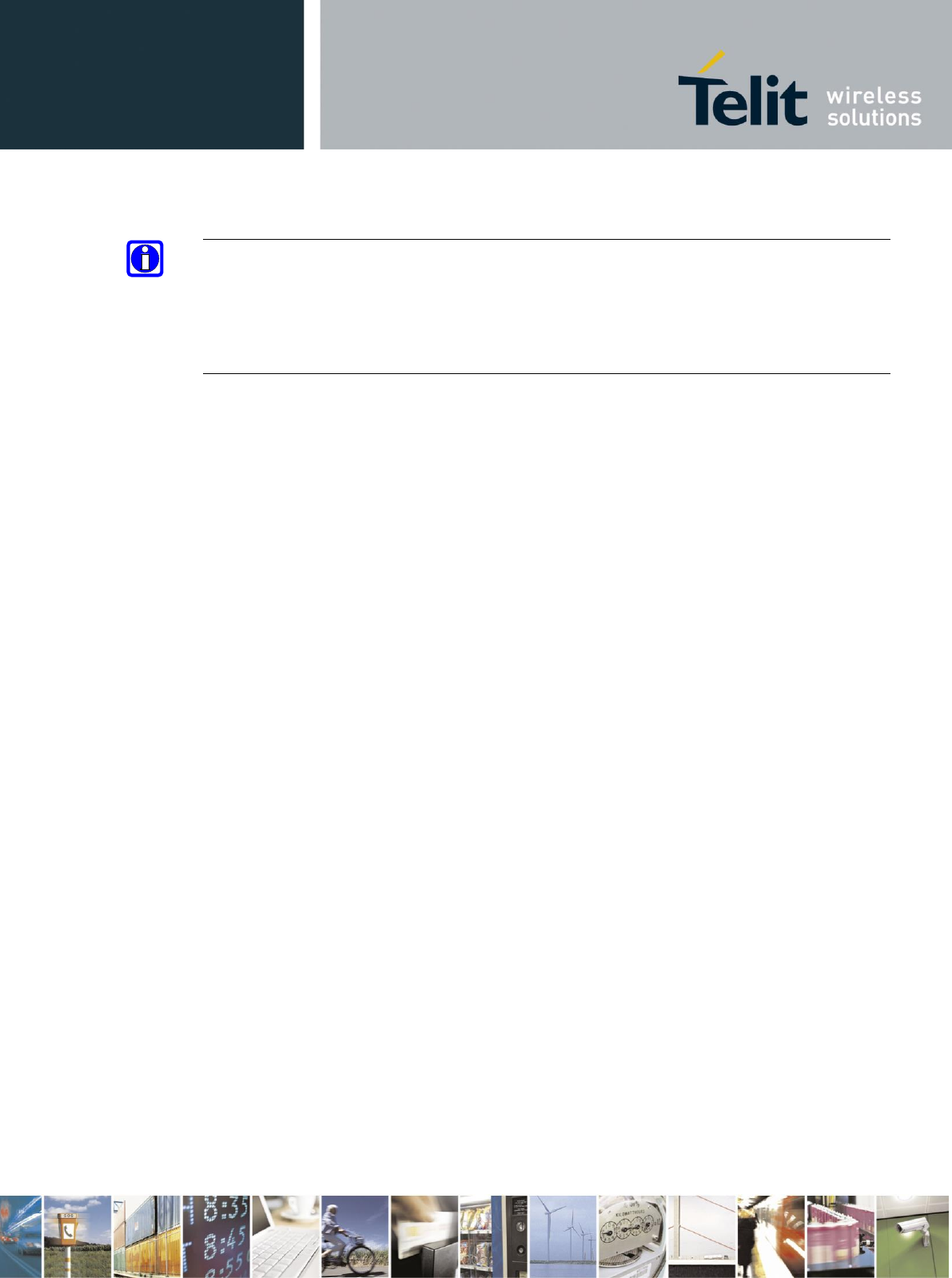
Reproduction forbidden without Telit Communications S.p.A. written authorization - All Rights Reserved page 33 of 93
NOTE:
The electrical design for the Power supply should be made ensuring it will be capable of a peak
current output of at least 2 A.
The UE910-EUx variants are supporting EDGE class 33; the NAx variants support EDGE class
10.
5.3 General Design Rules
The principal guidelines for the Power Supply Design embrace three different design steps:
the electrical design
the thermal design
the PCB layout.
5.3.1 Electrical Design Guidelines
The electrical design of the power supply depends strongly from the power source where this
power is drained. We will distinguish them into three categories:
+5V input (typically PC internal regulator output)
+12V input (typically automotive)
Battery
5.3.1.1 + 5V input Source Power Supply Design Guidelines
The desired output for the power supply is 3.8V, hence there's not a big difference between
the input source and the desired output and a linear regulator can be used. A switching
power supply will not be suited because of the low drop out requirements.
When using a linear regulator, a proper heat sink shall be provided in order to dissipate the
power generated.
A Bypass low ESR capacitor of adequate capacity must be provided in order to cut the
current absorption peaks close to the UE910, a 100μF tantalum capacitor is usually suited.
Make sure the low ESR capacitor on the power supply output (usually a tantalum one) is
rated at least 10V.
A protection diode should be inserted close to the power input, in order to save the UE910
from power polarity inversion.
DRAFT
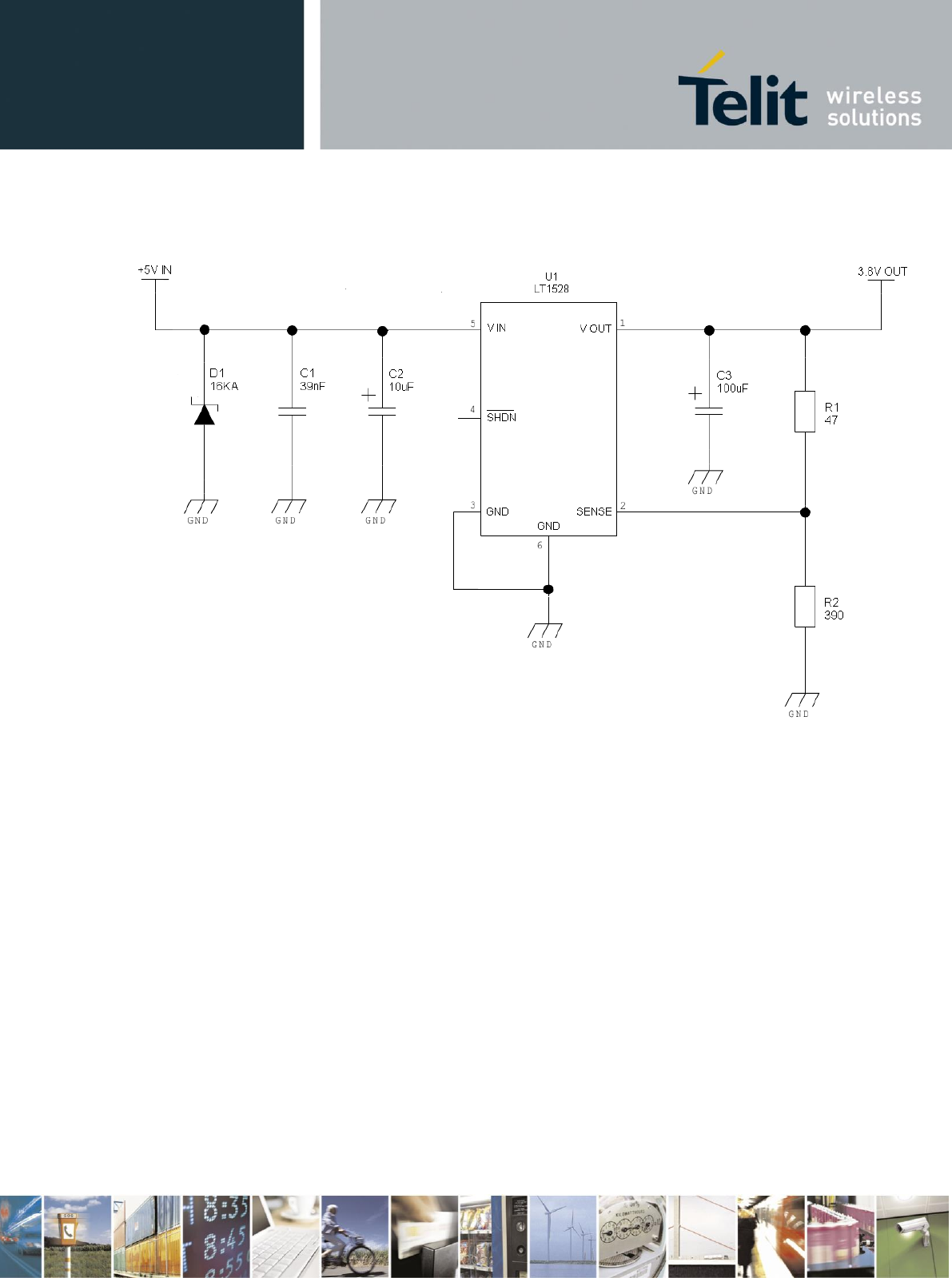
Reproduction forbidden without Telit Communications S.p.A. written authorization - All Rights Reserved page 34 of 93
An example of linear regulator with 5V input is:
5.3.1.2 + 12V input Source Power Supply Design
Guidelines
The desired output for the power supply is 3.8V, hence due to the big difference between the
input source and the desired output, a linear regulator is not suited and shall not be used. A
switching power supply will be preferable because of its better efficiency especially with the
2A peak current load represented by the UE910.
When using a switching regulator, a 500kHz or more switching frequency regulator is
preferable because of its smaller inductor size and its faster transient response. This allows
the regulator to respond quickly to the current peaks absorption.
In any case the frequency and Switching design selection is related to the application to be
developed due to the fact the switching frequency could also generate EMC interferences.
For car PB battery the input voltage can rise up to 15,8V and this should be kept in mind
when choosing components: all components in the power supply must withstand this
voltage.
A Bypass low ESR capacitor of adequate capacity must be provided in order to cut the
current absorption peaks, a 100μF tantalum capacitor is usually suited.
DRAFT
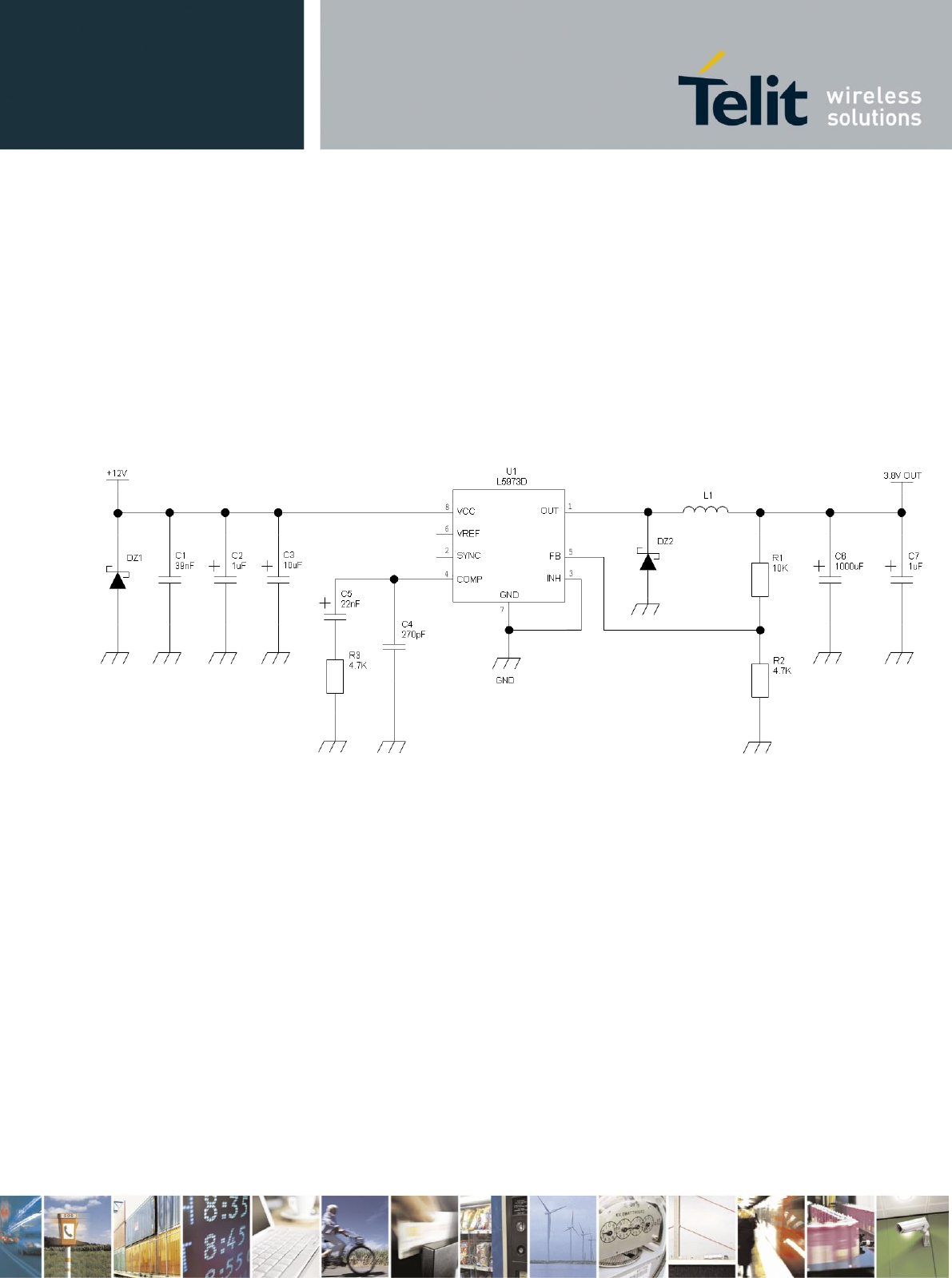
Reproduction forbidden without Telit Communications S.p.A. written authorization - All Rights Reserved page 35 of 93
Make sure the low ESR capacitor on the power supply output (usually a tantalum one) is
rated at least 10V.
For Car applications a spike protection diode should be inserted close to the power input, in
order to clean the supply from spikes.
A protection diode should be inserted close to the power input, in order to save the UE910
from power polarity inversion. This can be the same diode as for spike protection.
An example of switching regulator with 12V input is in the below schematic:
DRAFT
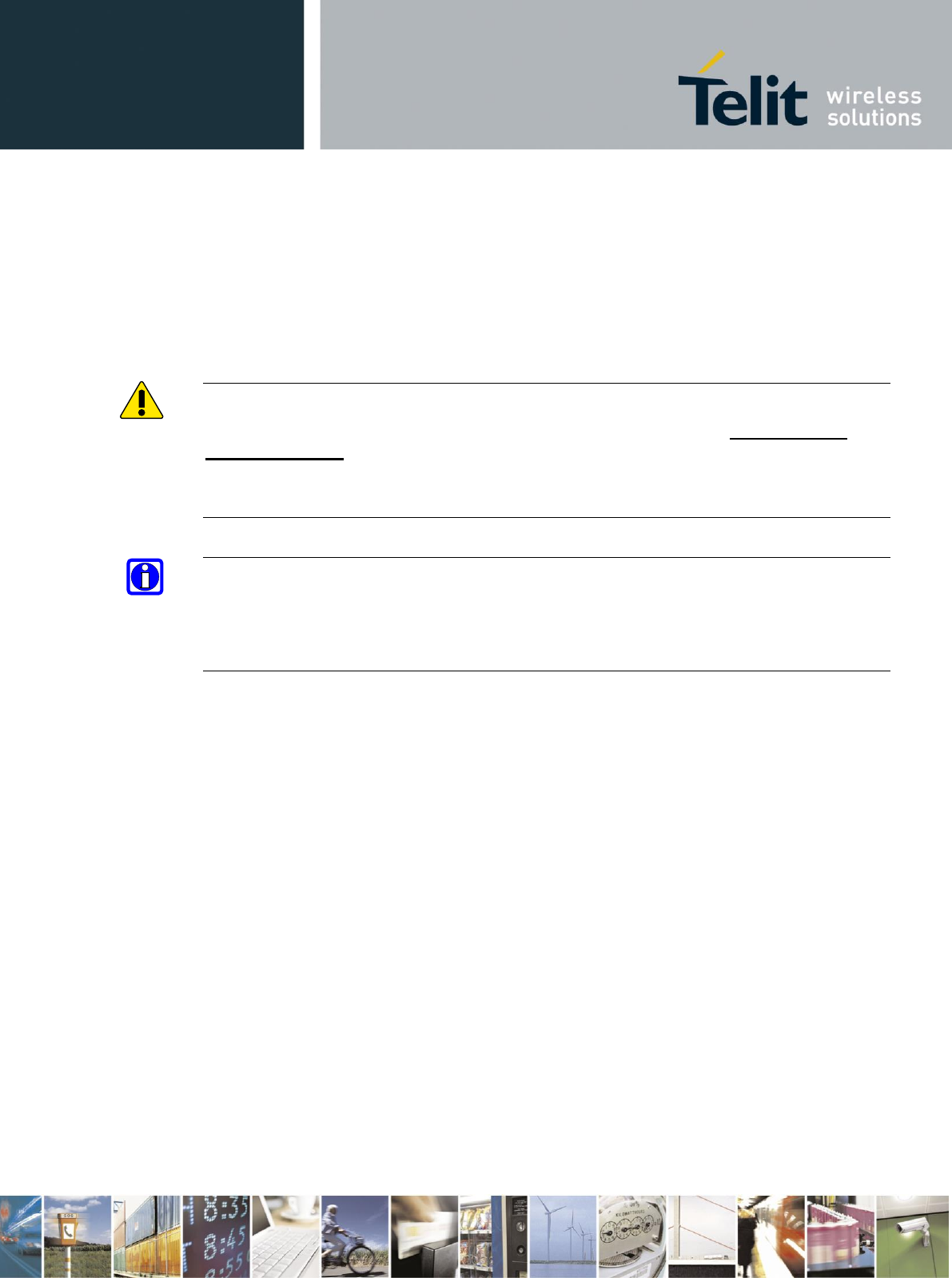
Reproduction forbidden without Telit Communications S.p.A. written authorization - All Rights Reserved page 36 of 93
5.3.1.3 Battery Source Power Supply Design Guidelines
The desired nominal output for the power supply is 3.8V and the maximum voltage
allowed is 4.2V, hence a single 3.7V Li-Ion cell battery type is suited for supplying the
power to the Telit UE910 module.
WARNING:
The three cells Ni/Cd or Ni/MH 3,6 V Nom. battery types or 4V PB types MUST NOT BE
USED DIRECTLY since their maximum voltage can rise over the absolute maximum voltage
for the UE910 and damage it.
NOTE:
DON'T USE any Ni-Cd, Ni-MH, and Pb battery types directly connected with UE910. Their use
can lead to overvoltage on the UE910 and damage it. USE ONLY Li-Ion battery types.
A Bypass low ESR capacitor of adequate capacity must be provided in order to cut the current
absorption peaks, a 100μF tantalum capacitor is usually suited.
Make sure the low ESR capacitor (usually a tantalum one) is rated at least 10V.
A protection diode should be inserted close to the power input, in order to save the UE910 from
power polarity inversion. Otherwise the battery connector should be done in a way to avoid
polarity inversions when connecting the battery.
The battery capacity must be at least 500mAh in order to withstand the current peaks of 2A; the
suggested capacity is from 500mAh to 1000mAh.
DRAFT
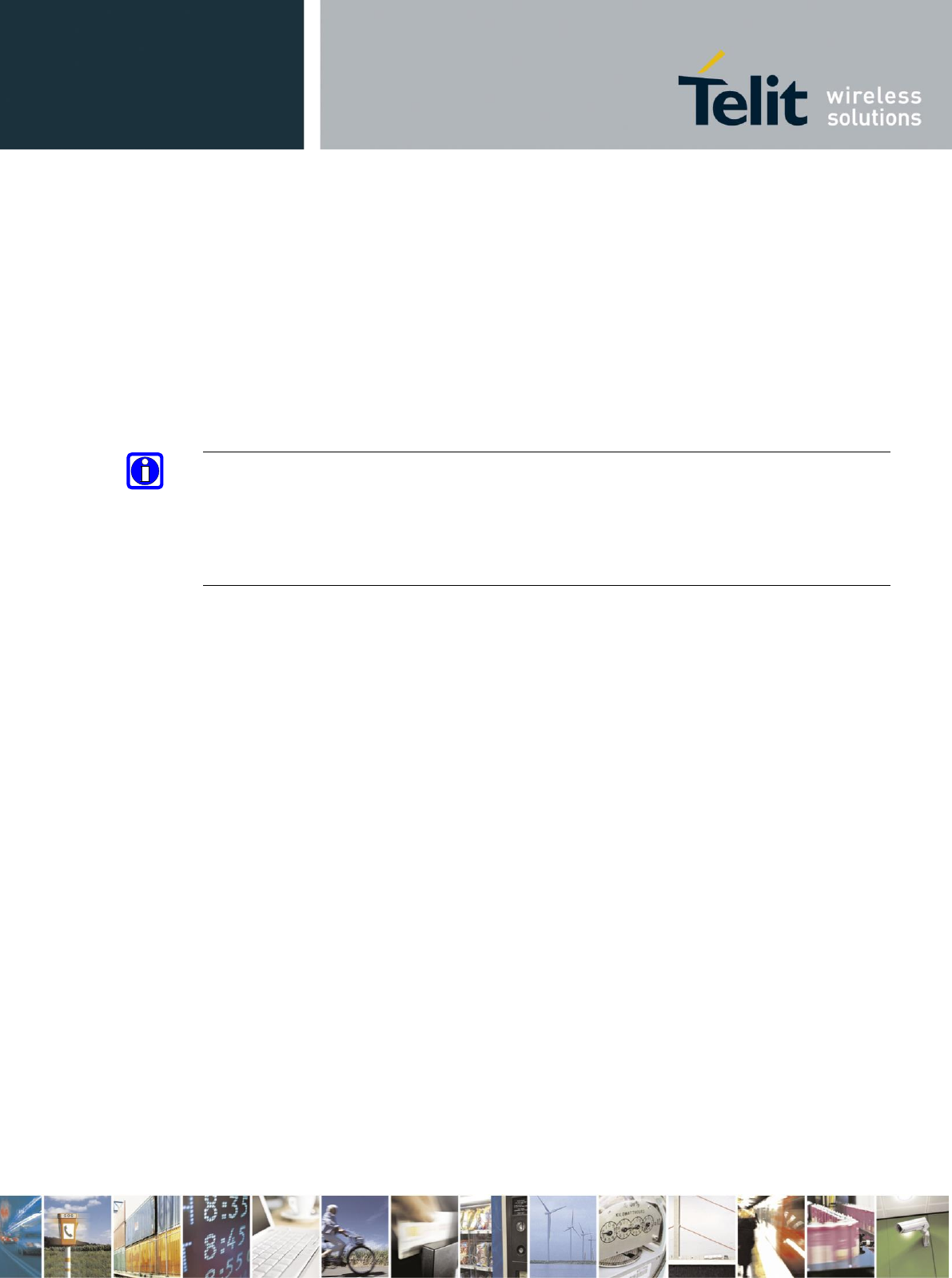
Reproduction forbidden without Telit Communications S.p.A. written authorization - All Rights Reserved page 37 of 93
5.3.2 Thermal Design Guidelines
The thermal design for the power supply heat sink should be done with the following
specifications:
Average current consumption during HSDPA transmission @PWR level max :
600 mA
Average current during idle:
1.5 mA
NOTE:
The average consumption during transmissions depends on the power level at which the device
is requested to transmit by the network. The average current consumption hence varies
significantly.
Considering the very low current during idle, especially if Power Saving function is enabled, it
is possible to consider from the thermal point of view that the device absorbs current
significantly only during calls.
If we assume that the device stays into transmission for short periods of time (let's say few
minutes) and then remains for a quite long time in idle (let's say one hour), then the power
supply has always the time to cool down between the calls and the heat sink could be smaller
than the calculated one for 600mA maximum RMS current, or even could be the simple chip
package (no heat sink).
Moreover in the average network conditions the device is requested to transmit at a lower power
level than the maximum and hence the current consumption will be less than the 600mA, being
usually around 150mA.
For these reasons the thermal design is rarely a concern and the simple ground plane where the
power supply chip is placed can be enough to ensure a good thermal condition and avoid
overheating.
For the heat generated by the UE910, you can consider it to be during transmission 1W max
during CSD/VOICE calls and 2W max during class12 GPRS upload.
This generated heat will be mostly conducted to the ground plane under the UE910; you must
ensure that your application can dissipate it.
DRAFT
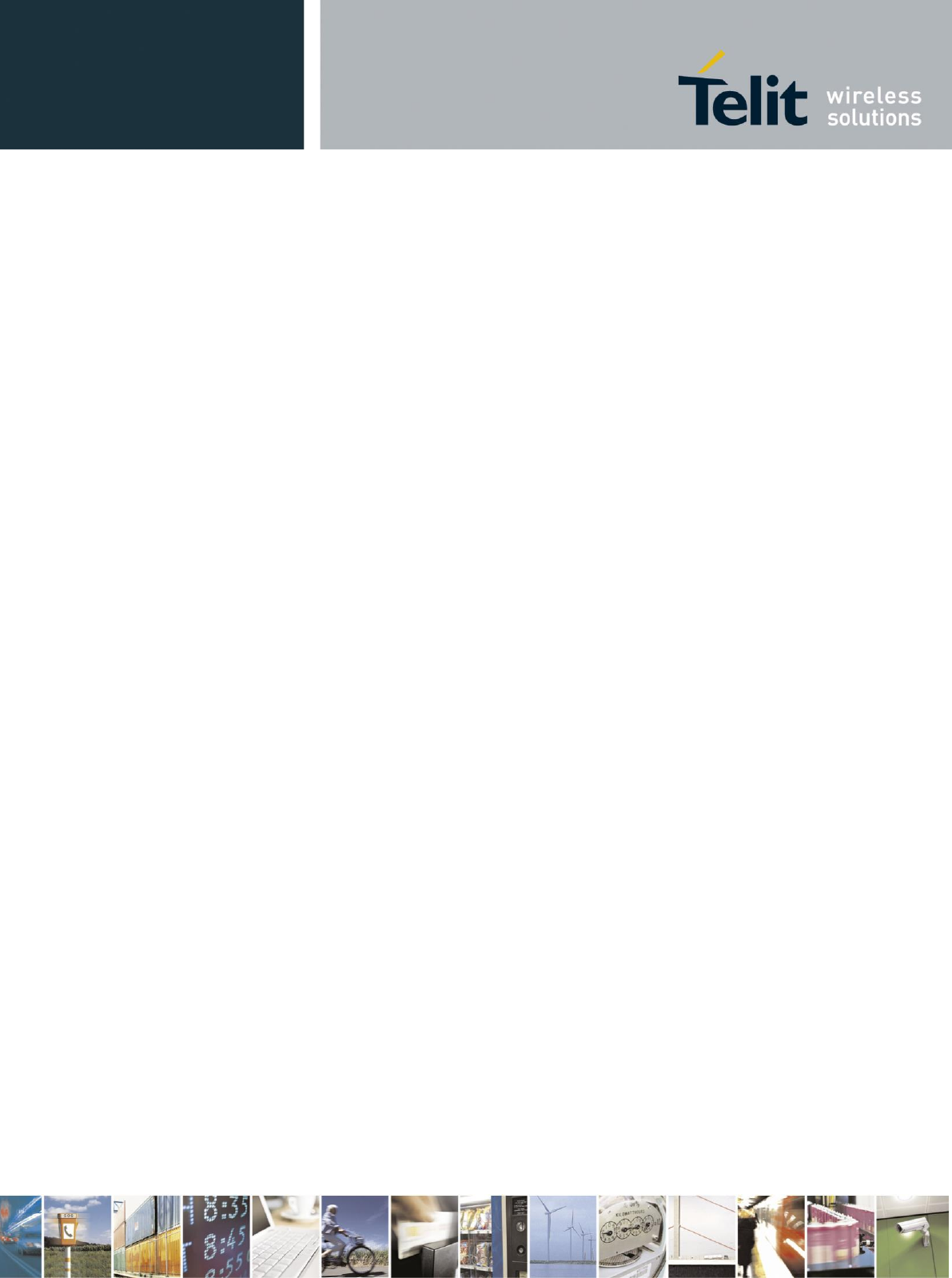
Reproduction forbidden without Telit Communications S.p.A. written authorization - All Rights Reserved page 38 of 93
5.3.3 Power Supply PCB layout Guidelines
As seen on the electrical design guidelines the power supply shall have a low ESR capacitor on
the output to cut the current peaks and a protection diode on the input to protect the supply from
spikes and polarity inversion. The placement of these components is crucial for the correct
working of the circuitry. A misplaced component can be useless or can even decrease the power
supply performances.
The Bypass low ESR capacitor must be placed close to the Telit UE910 power
input pads or in the case the power supply is a switching type it can be placed close
to the inductor to cut the ripple provided the PCB trace from the capacitor to the
UE910 is wide enough to ensure a dropless connection even during the 2A current
peaks.
The protection diode must be placed close to the input connector where the power
source is drained.
The PCB traces from the input connector to the power regulator IC must be wide
enough to ensure no voltage drops occur when the 2A current peaks are absorbed.
Note that this is not made in order to save power loss but especially to avoid the
voltage drops on the power line at the current peaks frequency of 216 Hz that will
reflect on all the components connected to that supply, introducing the noise floor at
the burst base frequency. For this reason while a voltage drop of 300-400 mV may
be acceptable from the power loss point of view, the same voltage drop may not be
acceptable from the noise point of view. If your application doesn't have audio
interface but only uses the data feature of the Telit UE910, then this noise is not so
disturbing and power supply layout design can be more forgiving.
The PCB traces to the UE910 and the Bypass capacitor must be wide enough to
ensure no significant voltage drops occur when the 2A current peaks are absorbed.
This is for the same reason as previous point. Try to keep this trace as short as
possible.
The PCB traces connecting the Switching output to the inductor and the switching
diode must be kept as short as possible by placing the inductor and the diode very
close to the power switching IC (only for switching power supply). This is done in
order to reduce the radiated field (noise) at the switching frequency (100-500 kHz
usually).
The use of a good common ground plane is suggested.
The placement of the power supply on the board should be done in such a way to
guarantee that the high current return paths in the ground plane are not overlapped
to any noise sensitive circuitry as the microphone amplifier/buffer or earphone
amplifier.
DRAFT
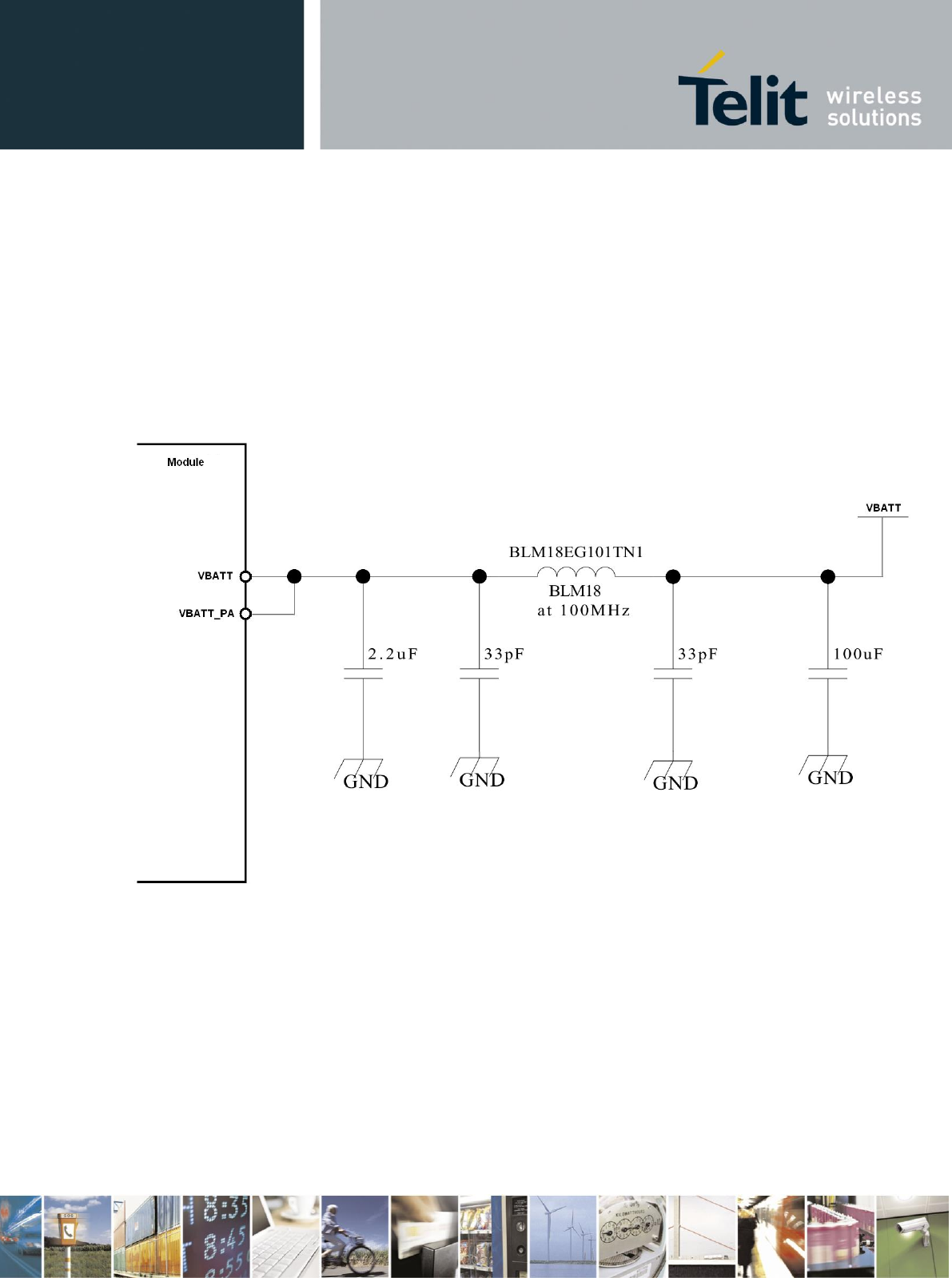
Reproduction forbidden without Telit Communications S.p.A. written authorization - All Rights Reserved page 39 of 93
The power supply input cables should be kept separate from noise sensitive lines
such as microphone/earphone cables.
The insertion of EMI filter on VBATT pins is suggested in those designs where
antenna is placed close to battery or supply lines.
A ferrite bead like Murata BLM18EG101TN1 or Taiyo Yuden P/N
FBMH1608HM101 can be used for this purpose.
The below figure shows the recommended circuit:
DRAFT
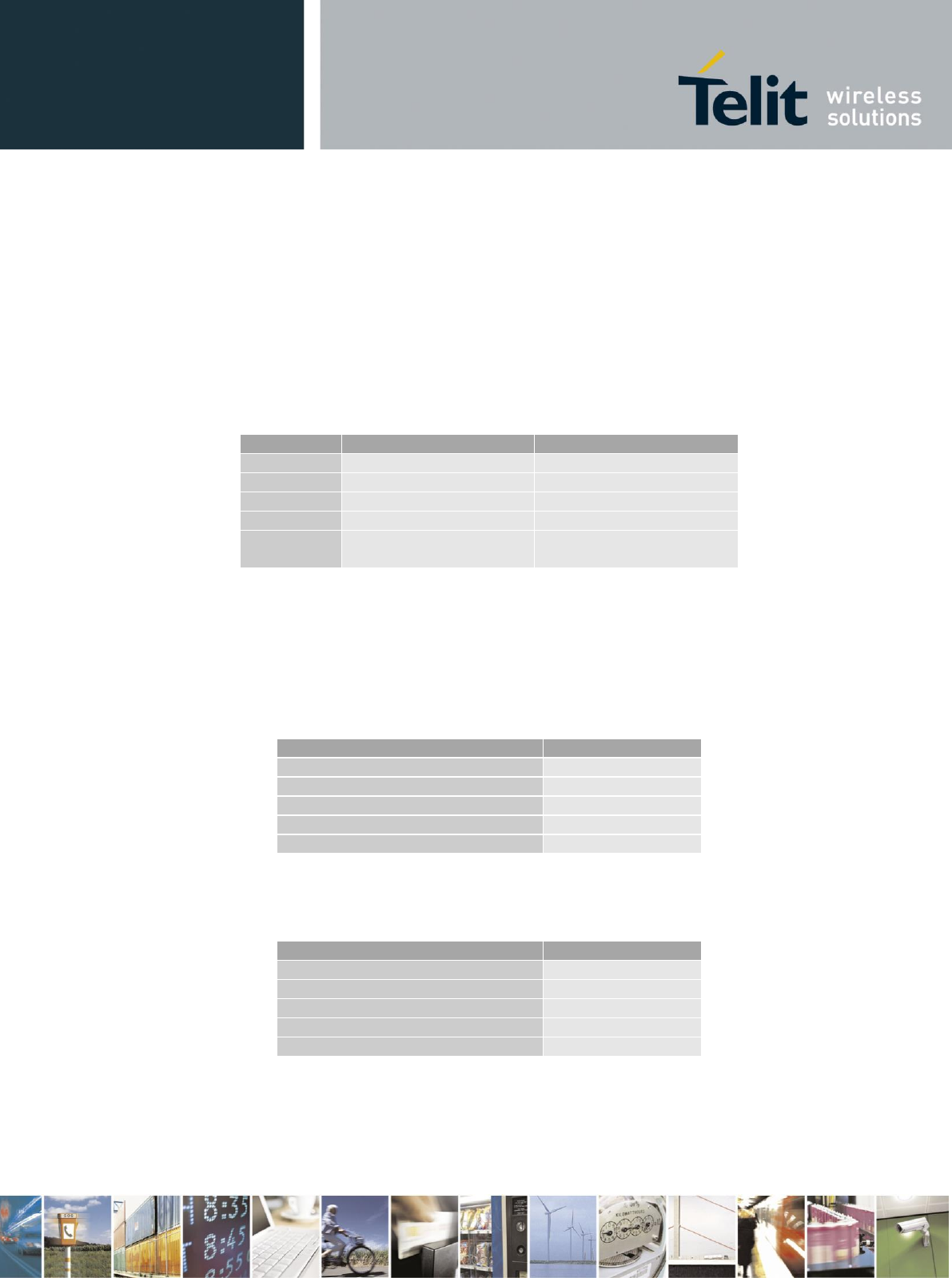
Reproduction forbidden without Telit Communications S.p.A. written authorization - All Rights Reserved page 40 of 93
6 GSM/WCDMA Radio Section
6.1 UE910 Product Variants
The following table is listing the main differences between the UE910 variants:
Product
Supported 2G Bands
Supported 3G bands
UE910-EUR
GSM 900, DCS1800
FDD B1, B8
UE910-EUD
GSM 900, DCS1800
FDD B1, B8
UE910-NAR
GSM 850, PCS 1900
FDD B2, B5
UE910-NAD
GSM 850, PCS 1900
FDD B2, B5
UE910-GL
GSM 850, GSM 900,
DCS 1800, PCS 1900
FDD B1, B2, B4, B5, B8
6.2 TX Output Power
UE910-EUR & UE910-EUD
UE910-NAR & UE910-NAD
Band
Power Class
GSM 900
4 (2W)
DCS 1800
1 (1W)
EDGE, 900 MHz
E2 (0.5W)
EDGE, 1800 MHz
Class E2 (0.4W)
WCDMA FDD B1, B8
Class 3 (0.25W)
Band
Power Class
GSM 850
4 (2W)
PCS 1900
1 (1W)
EDGE, 850 MHz
E2 (0.5W)
EDGE, 1900 MHz
Class E2 (0.4W)
WCDMA FDD B2, B5
Class 3 (0.25W)
DRAFT
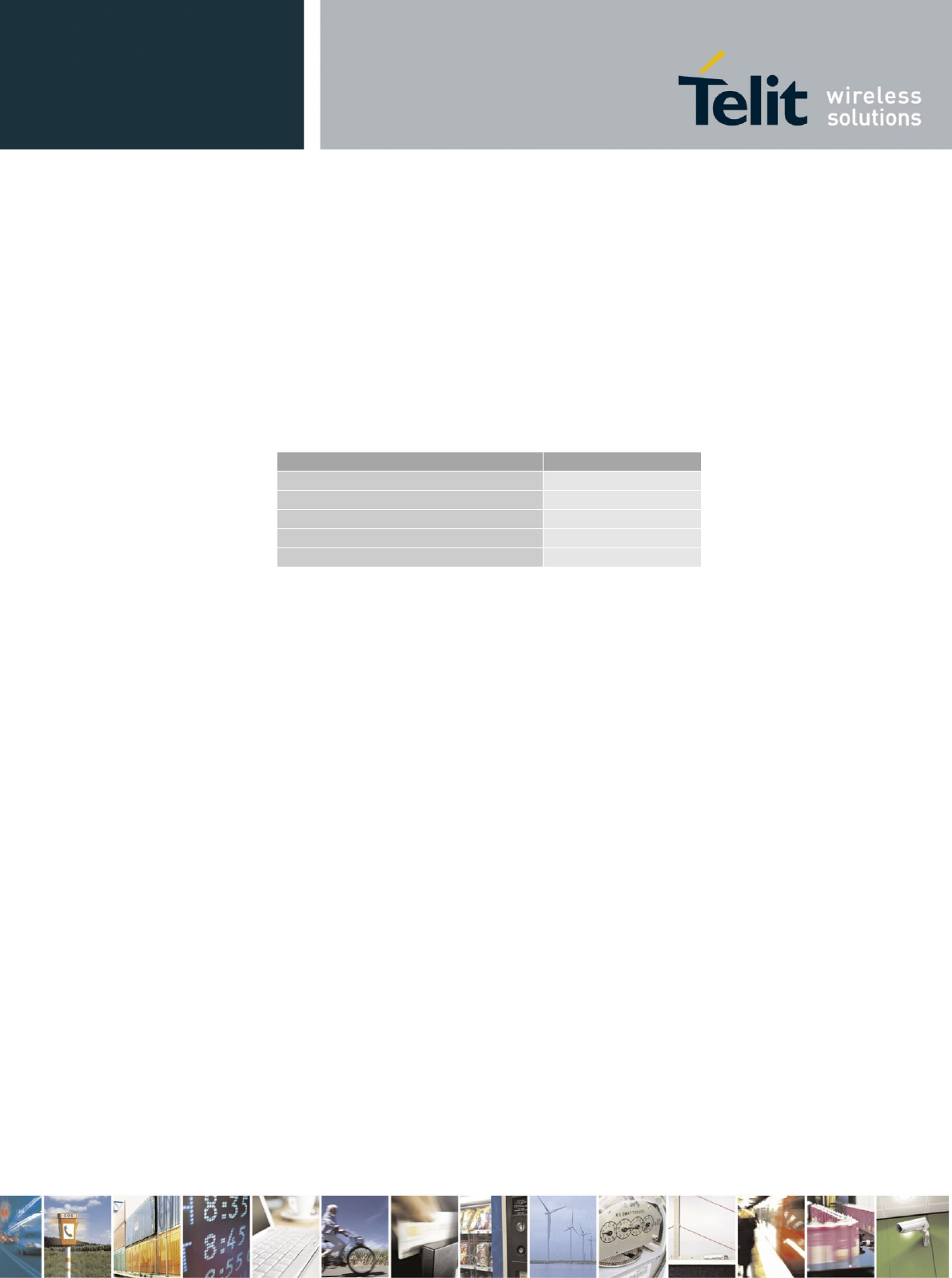
Reproduction forbidden without Telit Communications S.p.A. written authorization - All Rights Reserved page 41 of 93
UE910-GL
Band
Power Class
GSM 850, GSM 900
4 (2W)
DCS 1800, PCS 1900
1 (1W)
EDGE, 850/900 MHz
E2 (0.5W)
EDGE, 1800/1900 MHz
Class E2 (0.4W)
WCDMA FDD B1, B2, B4, B5, B8
Class 3 (0.25W)
DRAFT
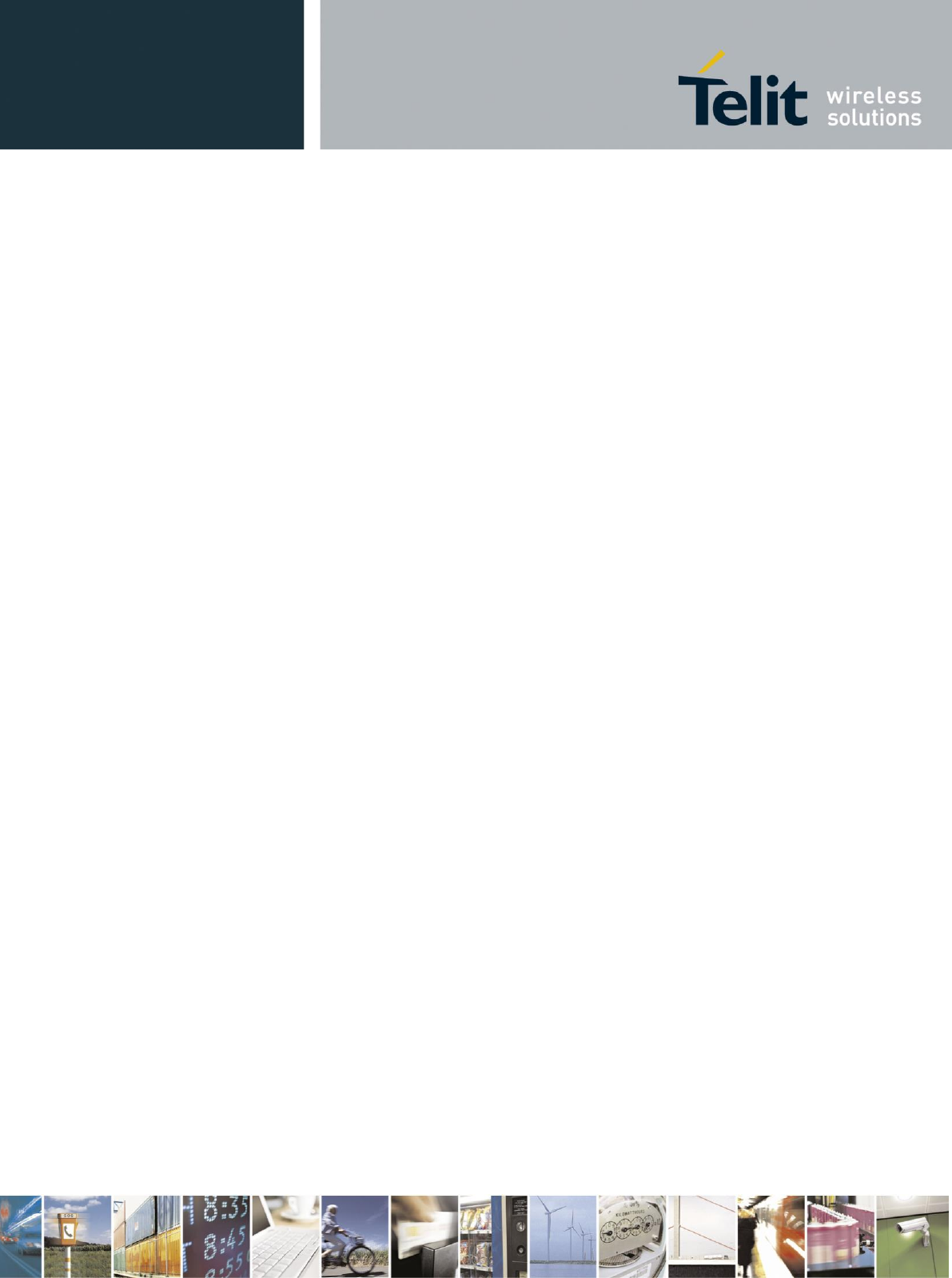
Reproduction forbidden without Telit Communications S.p.A. written authorization - All Rights Reserved page 42 of 93
DRAFT
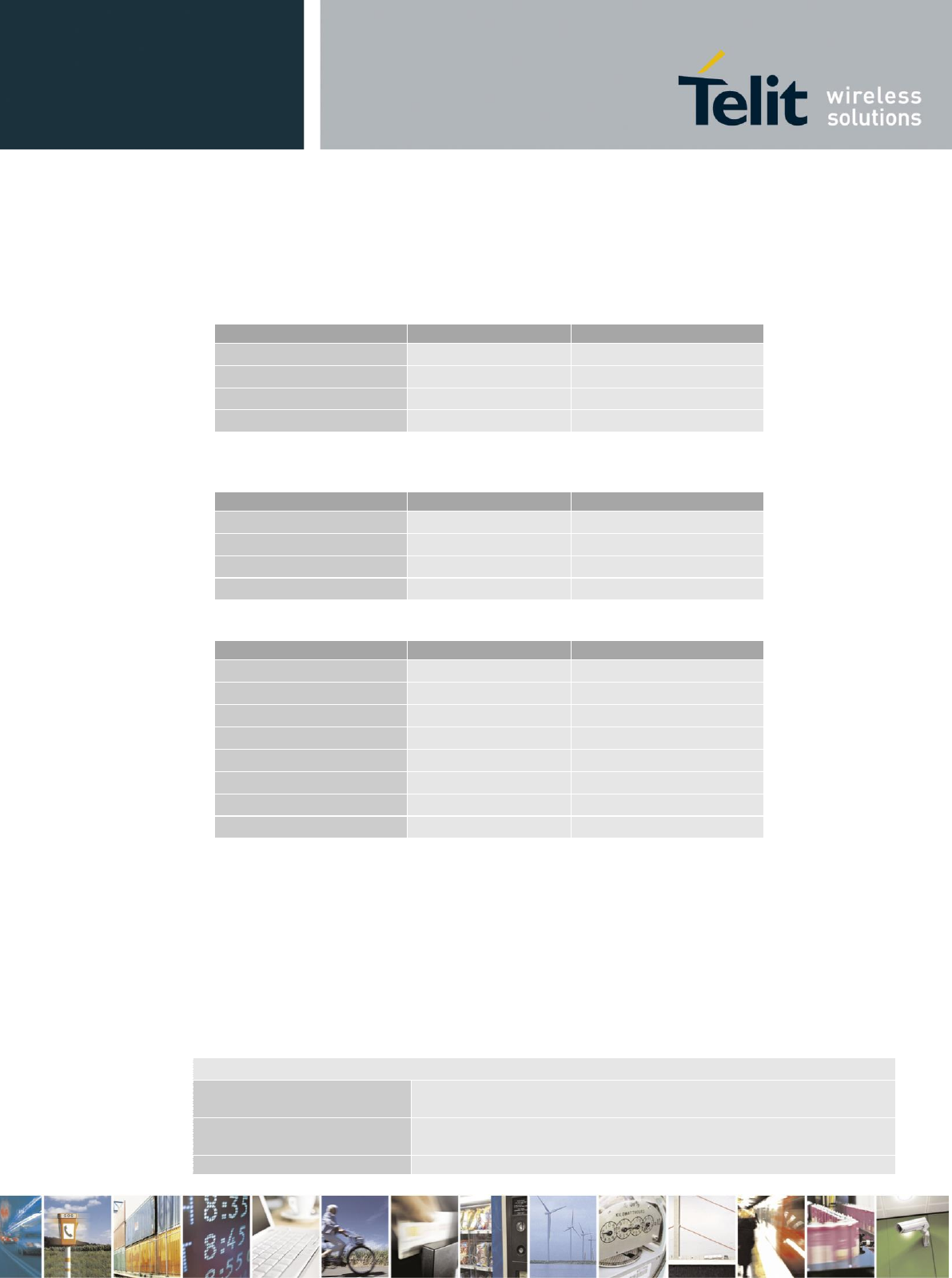
Reproduction forbidden without Telit Communications S.p.A. written authorization - All Rights Reserved page 43 of 93
Sensitivity
UE910-EUR and UE910-EUD
UE910-NAR and UE910-NAD
UE910-GL
6.3 GSM/WCDMA Antenna Requirements
The antenna connection and board layout design are the most important aspect in the full
product design as they strongly affect the product overall performances, hence read carefully
and follow the requirements and the guidelines for a proper design.
The antenna and antenna transmission line on PCB for a Telit UE910 device shall fulfil the
following requirements:
ANTENNA REQUIREMENTS (UE910-EUR and UE910-EUD)
Frequency range
Depending by frequency band(s) provided by the network operator, the
customer shall use the most suitable antenna for that/those band(s)
Bandwidth (GSM/EDGE)
80 MHz in GSM900
170 MHz in DCS
Bandwidth
250 MHz in WCDMA Band I
Band
Typical
Note
GSM 900
-109 dBm
BER Class II <2.44%
DCS1800
-110 dBm
BER Class II <2.44%
WCDMA FDD B1
-111 dBm
BER <0.1%
WCDMA FDD B8
-110 dBm
BER <0.1%
Band
Typical
Note
GSM 850
-109.5 dBm
BER Class II <2.44%
PCS 1900
-109.5 dBm
BER Class II <2.44%
WCDMA FDD B2
-110 dBm
BER <0.1%
WCDMA FDD B5
-111 dBm
BER <0.1%
Band
Typical
Note
GSM 900
-109 dBm
BER Class II <2.44%
GSM 850
-109.5 dBm
BER Class II <2.44%
DCS1800
-110 dBm
BER Class II <2.44%
PCS 1900
-109.5 dBm
BER Class II <2.44%
WCDMA FDD B1
-111 dBm
BER <0.1%
WCDMA FDD B2
-110 dBm
BER <0.1%
WCDMA FDD B4, B5
-111 dBm
BER <0.1%
WCDMA FDD B8
-110 dBm
BER <0.1%
DRAFT
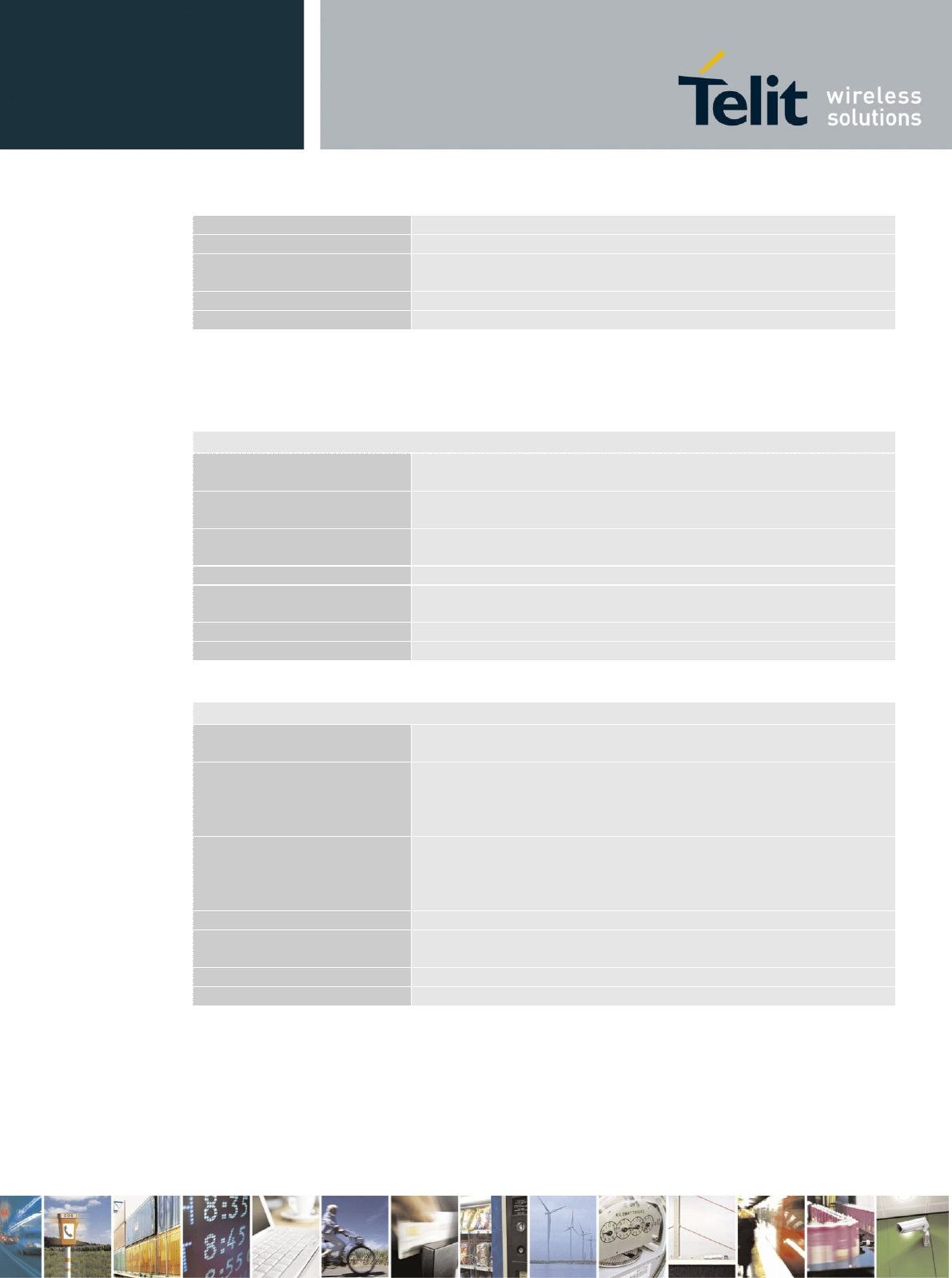
Reproduction forbidden without Telit Communications S.p.A. written authorization - All Rights Reserved page 44 of 93
(WCDMA)
80 MHz in WCDMA Band VIII
Impedance
50 ohm
Input power
> 33dBm(2 W) peak power in GSM
> 24dBm Average power in WCDMA
VSWR absolute max
≤ 10:1 (limit to avoid permanent damage)
VSWR recommended
≤ 2:1 (limit to fulfil all regulatory requirements)
ANTENNA REQUIREMENTS (UE910-NAR and UE910-NAD)
Frequency range
Depending by frequency band(s) provided by the network operator, the
customer shall use the most suitable antenna for that/those band(s)
Bandwidth (GSM/EDGE)
70 MHz in GSM850
140 MHz PCS 1900 band
Bandwidth
(WCDMA)
140 MHz in WCDMA Band II
70 MHz in WCDMA Band V
Impedance
50 ohm
Input power
> 33dBm(2 W) peak power in GSM
> 24dBm Average power in WCDMA
VSWR absolute max
≤ 10:1 (limit to avoid permanent damage)
VSWR recommended
≤ 2:1 (limit to fulfil all regulatory requirements)
ANTENNA REQUIREMENTS (UE910-GL)
Frequency range
Depending by frequency band(s) provided by the network operator, the
customer shall use the most suitable antenna for that/those band(s)
Bandwidth (GSM/EDGE)
80 MHz in GSM900
70 MHz in GSM850
170 MHz in DCS 1800
140 MHz PCS 1900 band
Bandwidth
(WCDMA)
250 MHz in WCDMA Band I; 140 MHz in WCDMA Band II
460 MHz in WCDMA Band IV; 70 MHz in WCDMA Band V
80 MHz in WCDMA Band VIII
Impedance
50 ohm
Input power
> 33dBm(2 W) peak power in GSM
> 24dBm Average power in WCDMA
VSWR absolute max
≤ 10:1 (limit to avoid permanent damage)
VSWR recommended
≤ 2:1 (limit to fulfil all regulatory requirements)
When using the UE910, since there's no antenna connector on the module, the antenna must
be connected to the UE910 antenna pad (K1) by means of a transmission line implemented
on the PCB.
In the case the antenna is not directly connected at the antenna pad of the UE910, then a PCB
line is needed in order to connect with it or with its connector.
DRAFT
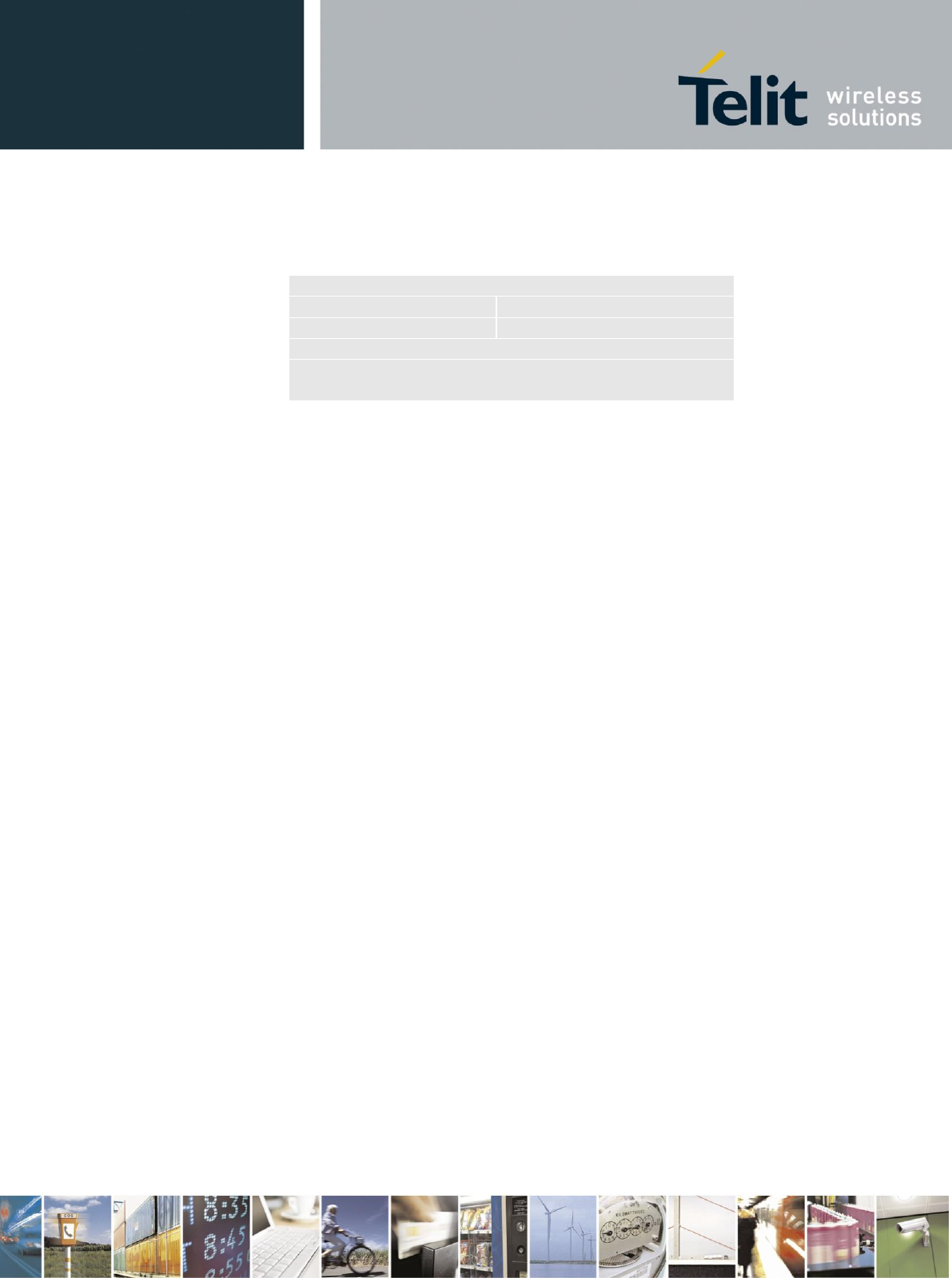
Reproduction forbidden without Telit Communications S.p.A. written authorization - All Rights Reserved page 45 of 93
This transmission line shall fulfil the following requirements:
ANTENNA LINE ON PCB REQUIREMENTS
Characteristic Impedance
50 ohm
Max Attenuation
0,3 dB
Coupling with other signals shall be avoided
Cold End (Ground Plane) of antenna shall be equipotential to
the UE910 ground pins
Furthermore if the device is developed for the US market and/or Canada market, it shall
comply with the FCC and/or IC approval requirements:
This device is to be used only for mobile and fixed application. In order to re-use the Telit
FCC/IC approvals the antenna(s) used for this transmitter must be installed to provide a
separation distance of at least 20 cm from all persons and must not be co-located or operating
in conjunction with any other antenna or transmitter. If antenna is installed with a separation
distance of less than 20 cm from all persons or is co-located or operating in conjunction with
any other antenna or transmitter then additional FCC/IC testing may be required. End-Users
must be provided with transmitter operation conditions for satisfying RF exposure
compliance.
Antennas used for this OEM module must not exceed the gains for mobile and fixed
operating configurations as described in “FCC/IC Regulatory notices” chapter.
6.4 GSM/WCDMA - PCB line Guidelines
Make sure that the transmission line’s characteristic impedance is 50ohm ;
Keep line on the PCB as short as possible, since the antenna line loss shall be less than
around 0,3 dB;
Line geometry should have uniform characteristics, constant cross section, avoid meanders
and abrupt curves;
Any kind of suitable geometry / structure (Microstrip, Stripline, Coplanar, Grounded
Coplanar Waveguide...) can be used for implementing the printed transmission line afferent
the antenna;
If a Ground plane is required in line geometry, that plane has to be continuous and
sufficiently extended, so the geometry can be as similar as possible to the related canonical
model;
Keep, if possible, at least one layer of the PCB used only for the Ground plane; If possible,
use this layer as reference Ground plane for the transmission line;
It is wise to surround (on both sides) the PCB transmission line with Ground, avoid having
other signal tracks facing directly the antenna line track.
Avoid crossing any un-shielded transmission line footprint with other signal tracks on
different layers;
DRAFT
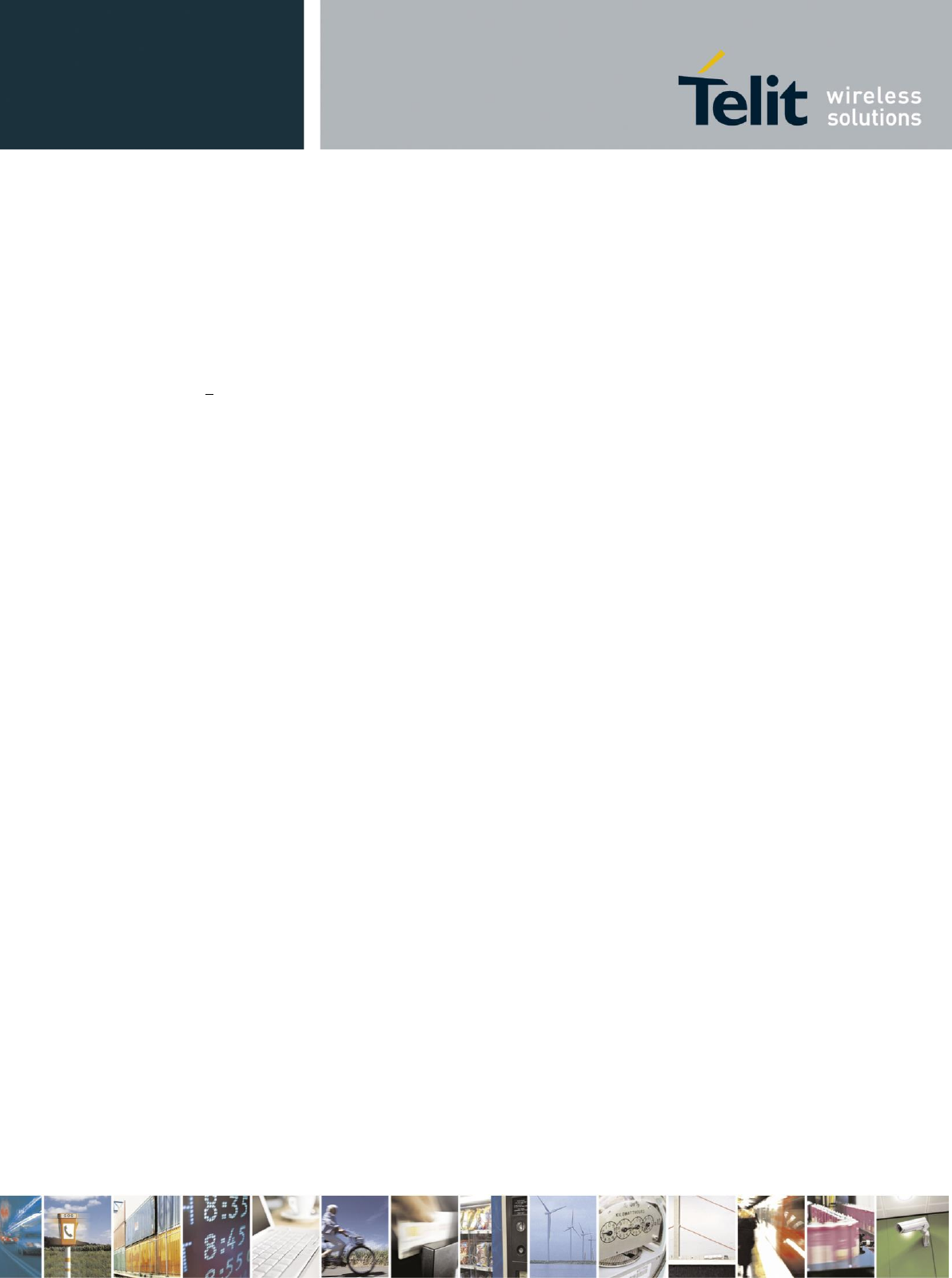
Reproduction forbidden without Telit Communications S.p.A. written authorization - All Rights Reserved page 46 of 93
The ground surrounding the antenna line on PCB has to be strictly connected to the main
Ground Plane by means of via holes (once per 2mm at least), placed close to the ground
edges facing line track;
Place EM noisy devices as far as possible from UE910 antenna line;
Keep the antenna line far away from the UE910 power supply lines;
If EM noisy devices are present on the PCB hosting the UE910, such as fast switching ICs,
take care of the shielding of the antenna line by burying it inside the layers of PCB and
surround it with Ground planes, or shield it with a metal frame cover.
If EM noisy devices are not present around the line, the use of geometries like Microstrip or
Grounded Coplanar Waveguide has to be preferred, since they typically ensure less
attenuation if compared to a Stripline having same length;
DRAFT
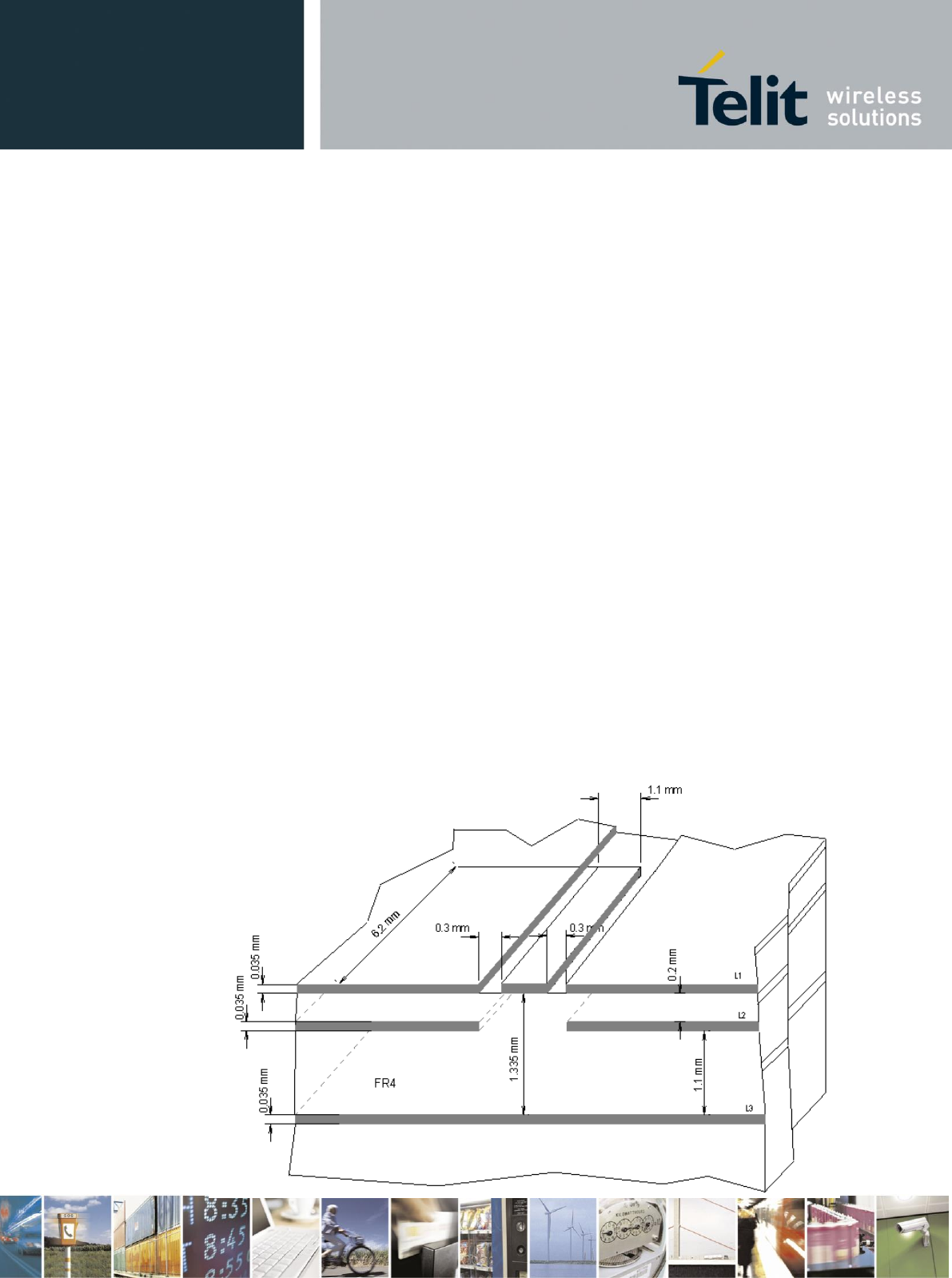
Reproduction forbidden without Telit Communications S.p.A. written authorization - All Rights Reserved page 47 of 93
6.5 PCB Guidelines in case of FCC
certification
In the case FCC certification is required for an application using UE910-NAx, according
to FCC KDB 996369 for modular approval requirements, the transmission line has to be
similar to that implemented on UE910 interface board and described in the following
chapter.
6.5.1 Transmission line design
During the design of the UE910 interface board, the placement of components has
been chosen properly, in order to keep the line length as short as possible, thus leading
to lowest power losses possible. A Grounded Coplanar Waveguide (G-CPW) line has
been chosen, since this kind of transmission line ensures good impedance control and
can be implemented in an outer PCB layer as needed in this case. A SMA female
connector has been used to feed the line.
The interface board is realized on a FR4, 4-layers PCB. Substrate material is
characterized by relative permittivity εr = 4.6 ± 0.4 @ 1 GHz, TanD= 0.019 ÷ 0.026 @ 1
GHz.
A characteristic impedance of nearly 50 Ω is achieved using trace width = 1.1 mm,
clearance from coplanar ground plane = 0.3 mm each side. The line uses reference
ground plane on layer 3, while copper is removed from layer 2 underneath the line.
Height of trace above ground plane is 1.335 mm. Calculated characteristic impedance
is 51.6 Ω, estimated line loss is less than 0.1 dB. The line geometry is shown below:
DRAFT
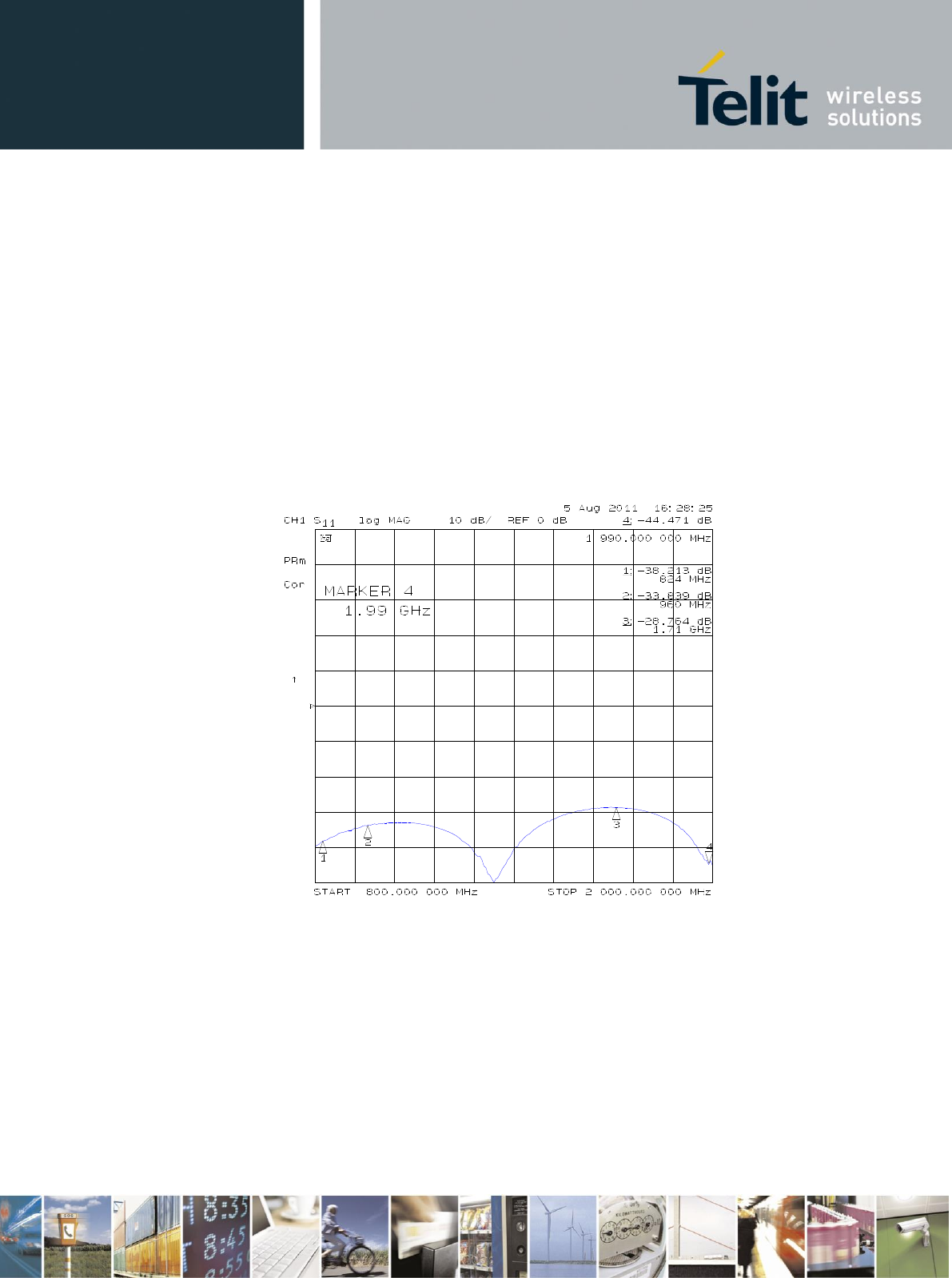
Reproduction forbidden without Telit Communications S.p.A. written authorization - All Rights Reserved page 48 of 93
6.5.2 Transmission line measurements
HP8753E VNA (Full-2-port calibration) has been used in this measurement session. A
calibrated coaxial cable has been soldered at the pad corresponding to RF output; a
SMA connector has been soldered to the board in order to characterize the losses of
the transmission line including the connector itself. During Return Loss / impedance
measurements, the transmission line has been terminated to 50 Ω load.
Return Loss plot of line under test is shown below:
DRAFT
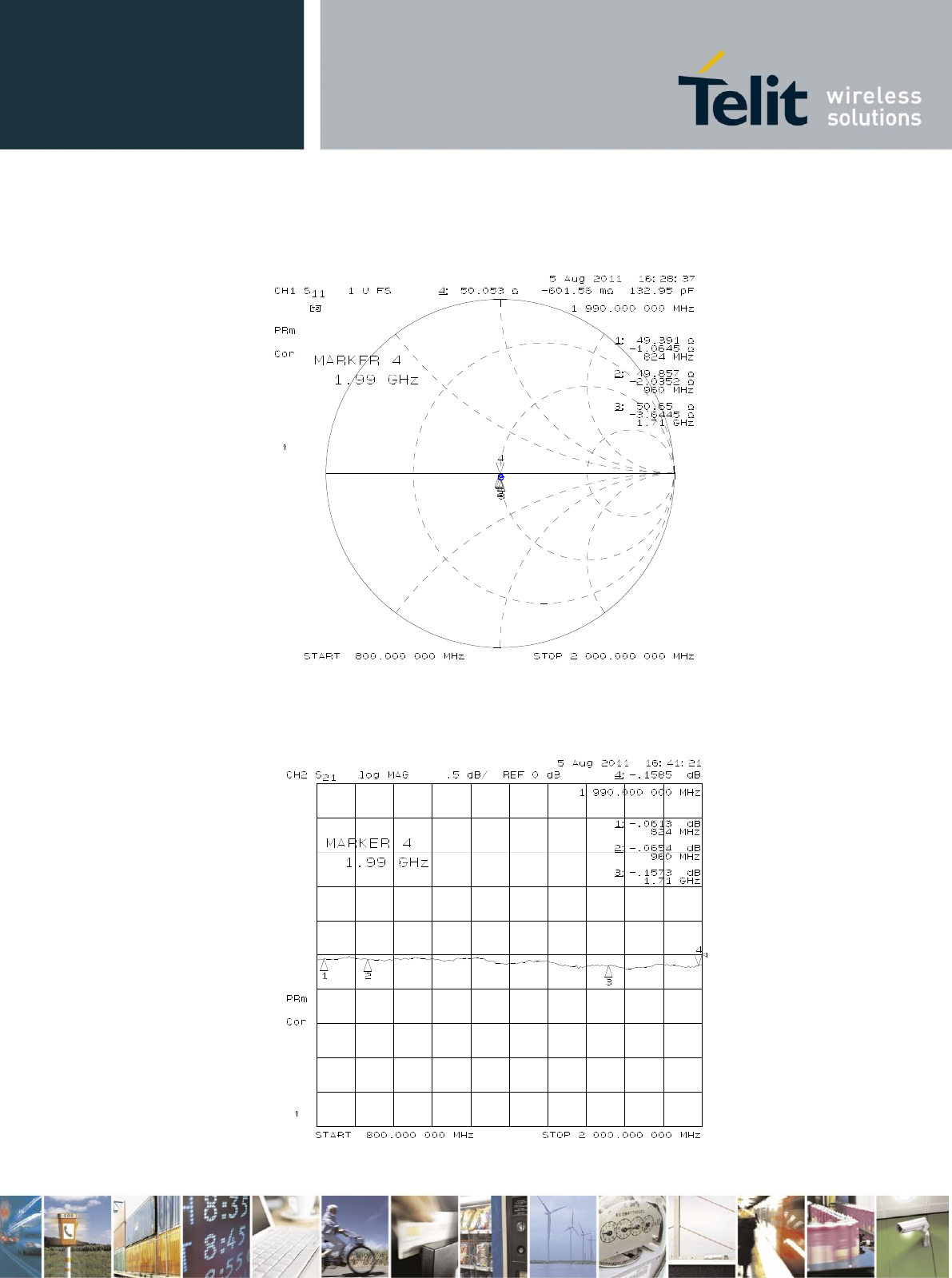
Reproduction forbidden without Telit Communications S.p.A. written authorization - All Rights Reserved page 49 of 93
Line input impedance (in Smith Chart format, once the line has been terminated to 50 Ω
load) is shown in the following figure:
Insertion Loss of G-CPW line plus SMA connector is shown below:
DRAFT
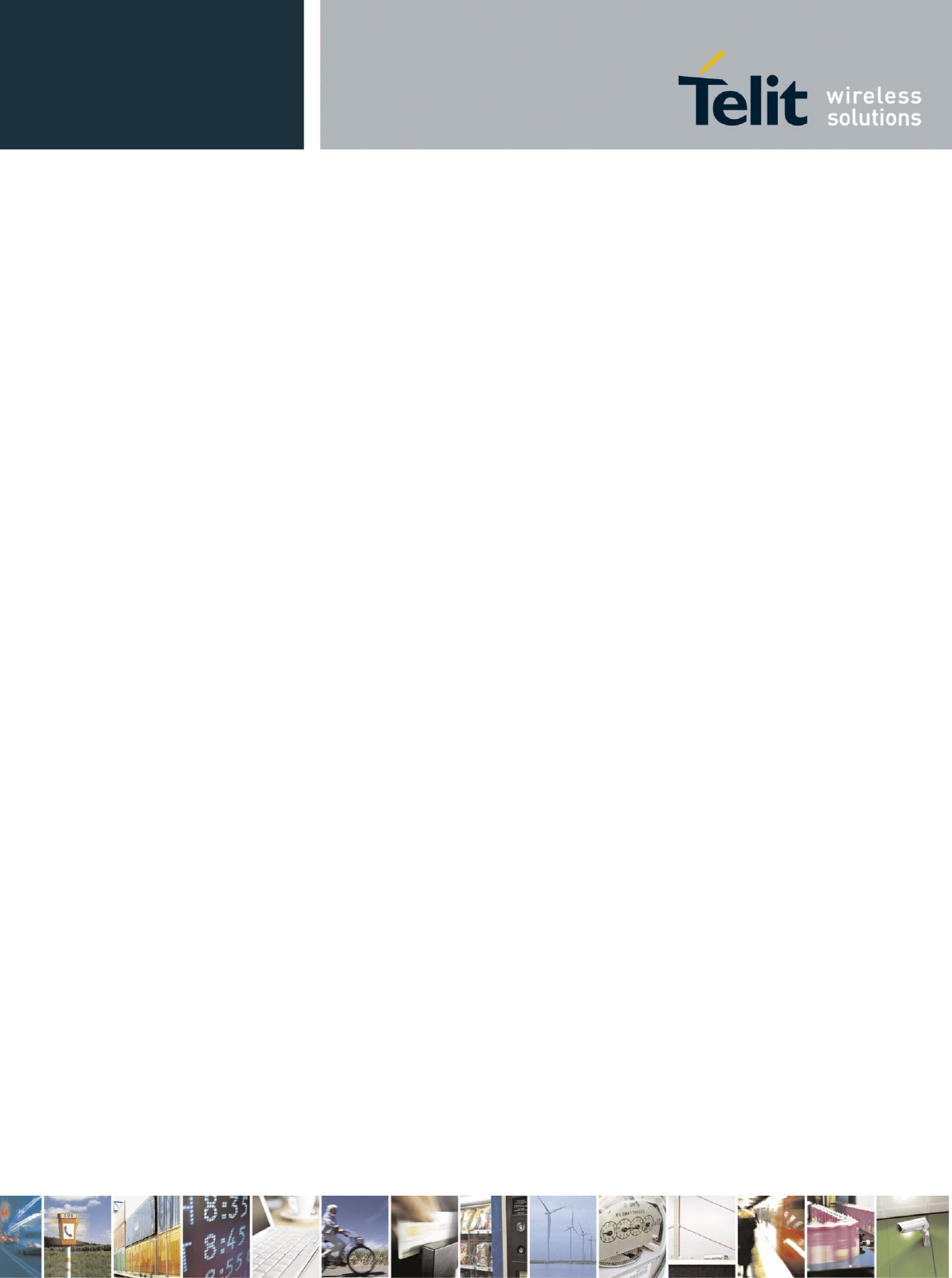
Reproduction forbidden without Telit Communications S.p.A. written authorization - All Rights Reserved page 50 of 93
6.6 Antenna - Installation Guidelines
Install the antenna in a place covered by the GSM / WCDMA signal.
If the device antenna is located farther than 20cm from the human body and there are
no co-located transmitter then the Telit FCC/IC approvals can be re-used by the end
product.
If the device antenna is located closer than 20cm from the human body or there are co-
located transmitter then the additional FCC/IC testing may be required for the end
product (Telit FCC/IC approvals cannot be reused).
Antenna shall not be installed inside metal cases.
Antenna shall be installed also according to antenna manufacturer instructions.
DRAFT
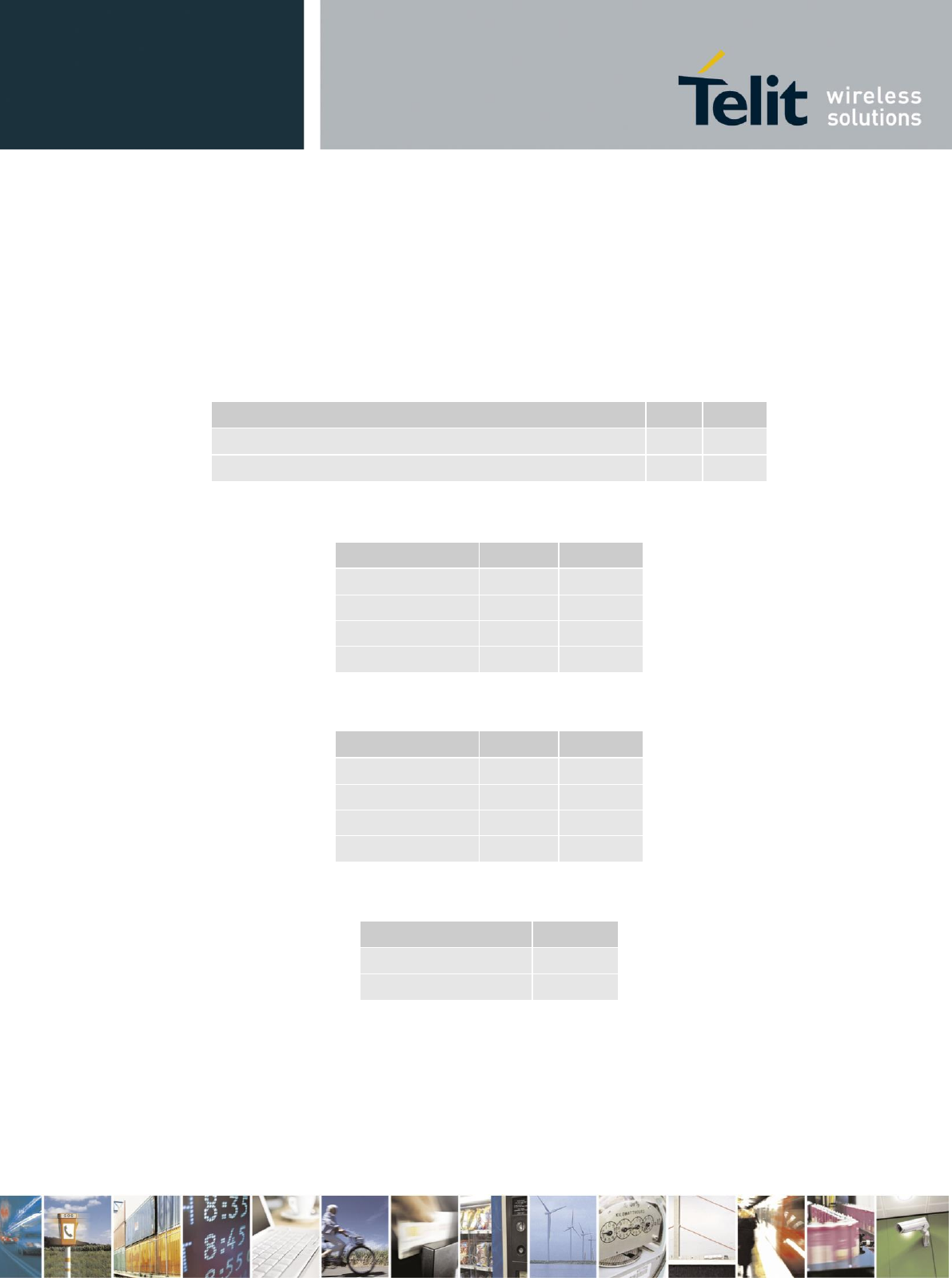
Reproduction forbidden without Telit Communications S.p.A. written authorization - All Rights Reserved page 51 of 93
7 Logic level specifications
The following table shows the logic level specifications used in the UE910 interface circuits:
Absolute Maximum Ratings -Not Functional
Parameter
Min
Max
Input level on any digital pin (CMOS 1.8) with respect to ground
-0.3V
2.1V
Input level on any digital pin (CMOS 1.2) with respect to ground
-0.3V
1.4V
Operating Range - Interface levels (1.8V CMOS)
Level
Min
Max
Input high level
1.5V
1.9V
Input low level
0V
0.35V
Output high level
1.6V
1.9V
Output low level
0V
0.2V
Operating Range - Interface levels (1.2V CMOS)
Level
Min
Max
Input high level
0.9V
1.3V
Input low level
0V
0.3V
Output high level
1V
1.3V
Output low level
0V
0.1V
Current characteristics
Level
Typical
Output Current
1mA
Input Current
1uA
DRAFT
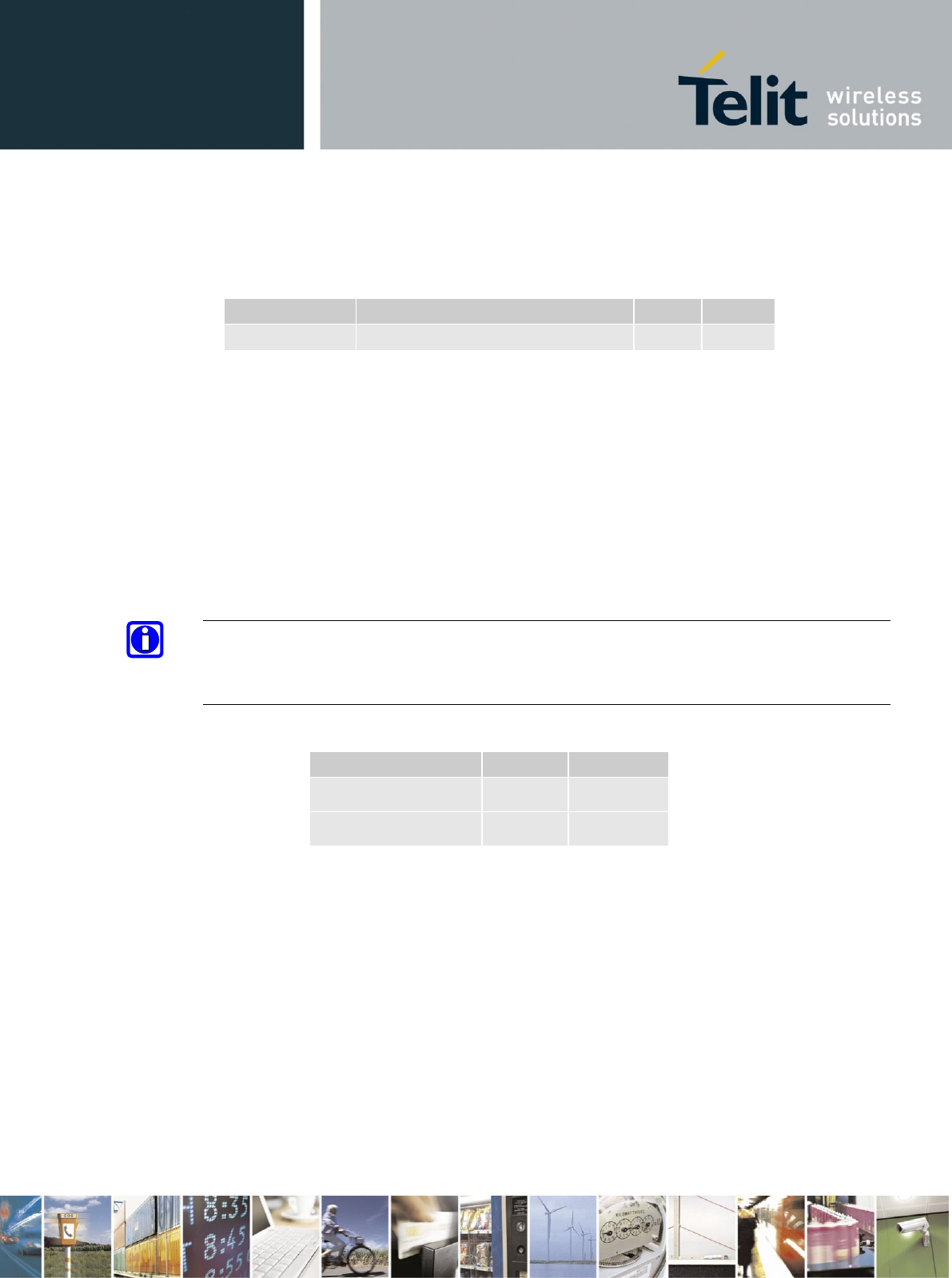
Reproduction forbidden without Telit Communications S.p.A. written authorization - All Rights Reserved page 52 of 93
7.1 Unconditional Shutdown
Signal
Function
I/O
PAD
HW_SHUTDOWN*
Unconditional Shutdown of the Module
I
R13
HW_SHUTDOWN* is used to unconditionally shutdown the UE910. Whenever this signal is
pulled low, the UE910 is reset. When the device is reset it stops any operation. After the release
of the line, the UE910 is unconditionally shut down, without doing any detach operation from
the network where it is registered. This behaviour is not a proper shut down because any GSM
device is requested to issue a detach request on turn off. For this reason the HW_SHUTDOWN*
signal must not be used to normally shutting down the device, but only as an emergency exit in
the rare case the device remains stuck waiting for some network response.
The HW_SHUTDOWN* is internally controlled on start-up to achieve always a proper power-
on reset sequence, so there's no need to control this pin on start-up.
It may only be used to reset a device already on that is not responding to any command.
NOTE:
Do not use this signal to power off the UE910. Use the ON/OFF signal to perform this function
or the AT#SHDN command.
Unconditional Shutdown Signal Operating levels:
Signal
Min
Max
HW_SHUTDOWN*
Input high
1.5V
1.9V
HW_SHUTDOWN*
Input low
0V
0.35V
* this signal is internally pulled up so the pin can be left floating if not used.
If unused, this signal may be left unconnected. If used, then it must always be connected with
an open collector transistor, to permit to the internal circuitry the power on reset and under
voltage lockout functions.
DRAFT
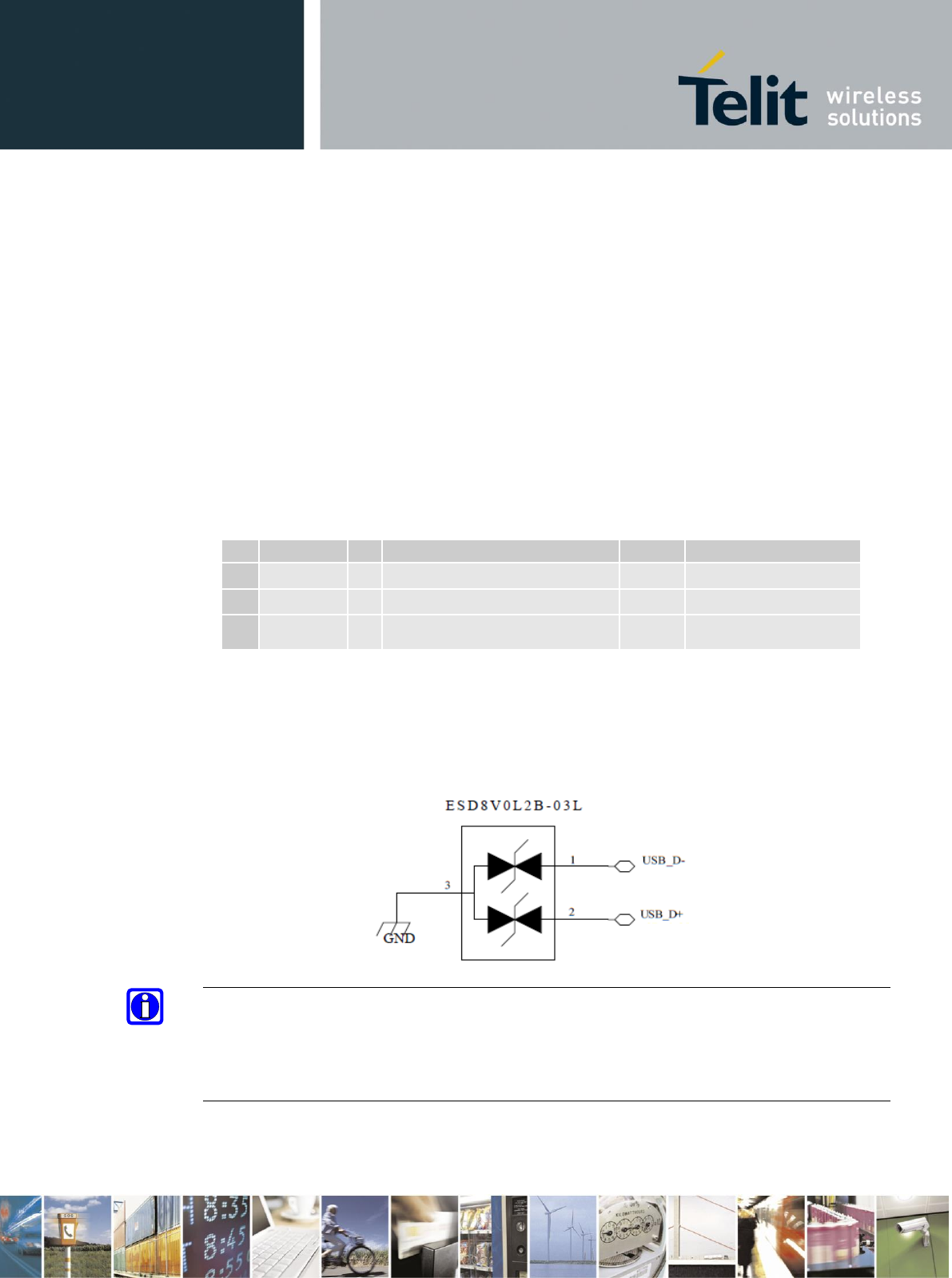
Reproduction forbidden without Telit Communications S.p.A. written authorization - All Rights Reserved page 53 of 93
8 USB Port
The UE910 includes one integrated universal serial bus (USB 2.0 HS) transceiver.
8.1 USB 2.0 HS
This port is compliant with the USB 2.0 HS only.
The USB FS is supported for AT interface and data communication.
The following table is listing the available signals:
PAD
Signal
I/O
Function
Type
NOTE
B15
USB_D+
I/O
USB differential Data (+)
3.3V
C15
USB_D-
I/O
USB differential Data (-)
3.3V
A13
VUSB
AI
Power sense for the internal USB
transceiver.
5V
Accepted range:
4.4V to 5.25V
The USB_DPLUS and USB_DMINUS signals have a clock rate of 480 MHz.
The signal traces should be routed carefully. Trace lengths, number of vias and capacitive
loading should be minimized. The characteristic impedance value should be as close as
possible to 90 Ohms differential.
In case there is a need to add an ESD protection the suggested connection is the following:
NOTE:
VUSB pin should be disconnected before activating the Power Saving Mode.
In case of a Firmware upgrade using the USB port, it could be done only using an USB 2.0 HS
device.
DRAFT
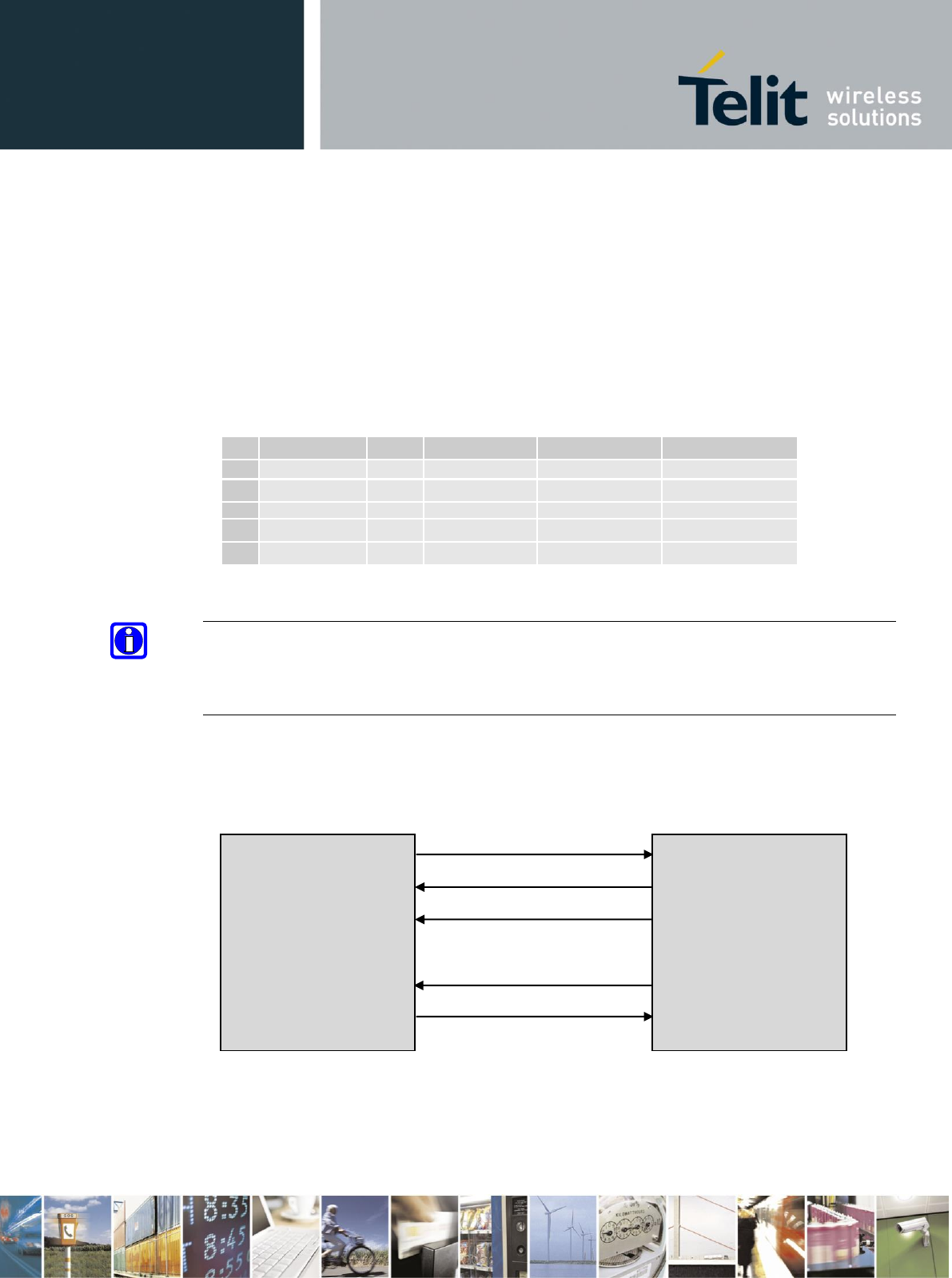
Reproduction forbidden without Telit Communications S.p.A. written authorization - All Rights Reserved page 54 of 93
9 SPI port
The UE910 Module is provided by one SPI interface.
The SPI interface defines two handshake lines for flow control and mutual wake-up of the
modem and the Application Processor: SRDY (slave ready) and MRDY (master ready).
The AP has the master role, that is, it supplies the clock.
The following table is listing the available signals:
PAD
Signal
I/O
Function
Type
COMMENT
D15
SPI_MOSI
I
SPI MOSI
CMOS 1.8V
Shared with TX_AUX
E15
SPI_MISO
O
SPI MISO
CMOS 1.8V
Shared with RX_AUX
F15
SPI_CLK
I
SPI Clock
CMOS 1.8V
H15
SPI_MRDY
I
SPI_MRDY
CMOS 1.8V
J15
SPI_SRDY
O
SPI_SRDY
CMOS 1.8V
9.1 SPI Connections
NOTE:
Due to the shared functions, when the SPI port is used, it is not possible to use the AUX_UART
port.
SPI_MISO
SPI_MOSI
SPI_CLK
SPI_MRDY
SPI_SRDY
E15
D15
F15
H15
J15
UE910
AP
DRAFT
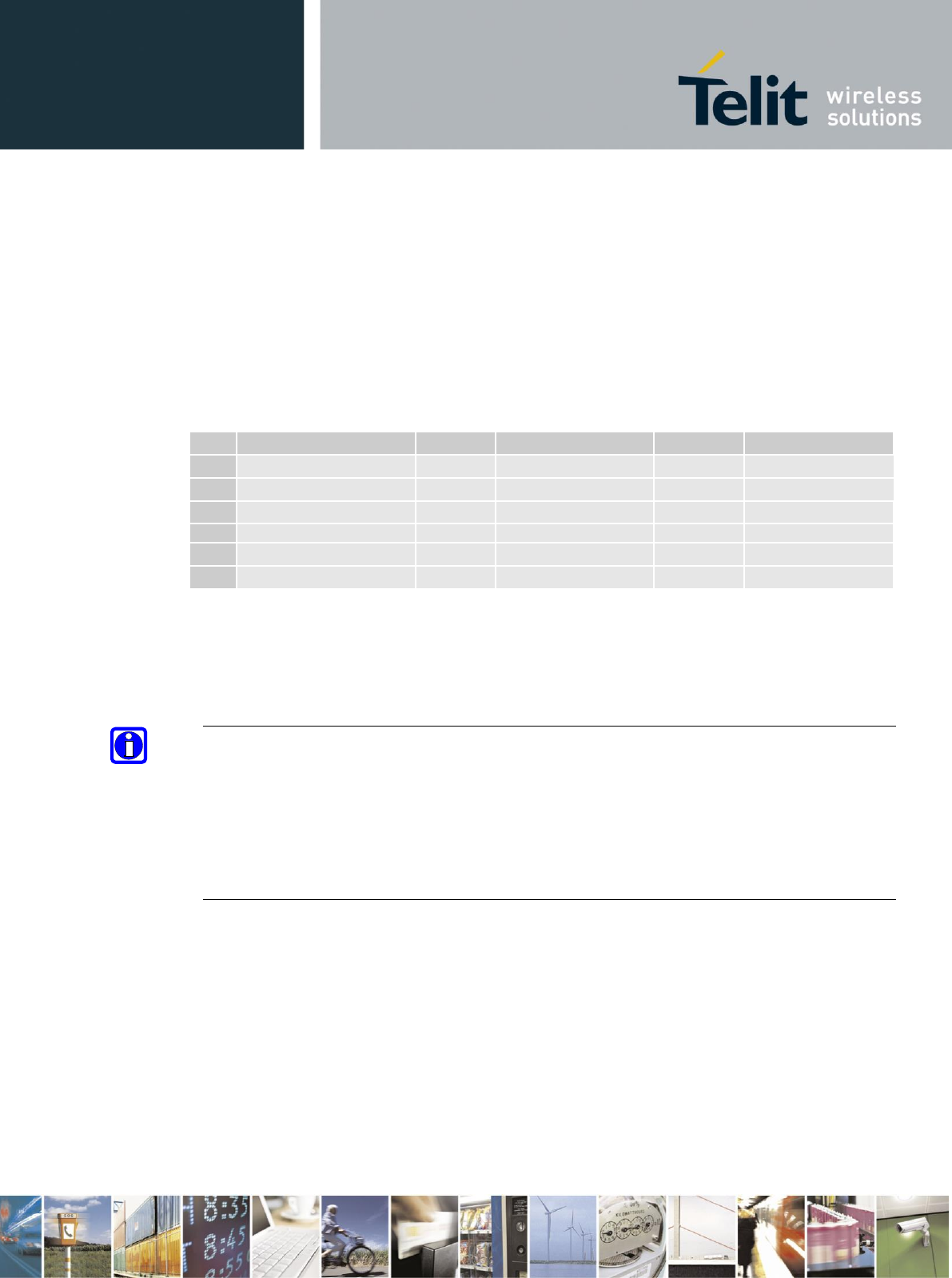
Reproduction forbidden without Telit Communications S.p.A. written authorization - All Rights Reserved page 55 of 93
10 USB HSIC
The UE910 Module is provided by one USB HSIC interface.
The USB HSIC (High Speed Inter Processor) Interface allows supporting the inter-processor
communication between an application processor (AP) – the host, and the modem processor
(CP) – the UE910.
The following table is listing the available signals:
Pad
Signal
Direction
Function
Type
COMMENT
A12
HSIC_USB_DATA
I/O
USB HSIC data signal
CMOS 1.2V
A11
HSIC_USB_STRB
I/O
USB HSIC strobe signal
CMOS 1.2V
H15
HSIC_SLAVE_WAKEUP
I
Slave Wake Up
CMOS 1.8V
Shared with SPI_MRDY
F15
HSIC_HOST_WAKEUP
O
Host Wake Up
CMOS 1.8V
Shared with SPI CLK
K15
HSIC_SUSPEND_REQUEST
O
Slave Suspend Request
CMOS 1.8V
Shared with GPIO08
J15
HSIC_HOST_ACTIVE
I
Active Host Indication
CMOS 1.8V
Shared with SPI_SRDY
For the detailed use of USB HSIC port please refer to the related Application Note.
NOTE:
Due to the shared functions, when the USB_HSIC port is used, it is not possible to use the SPI
and GPIO_08.
The USB_HSIC is not active by default but it has to be enabled using the AT#PORTCFG
command (refer to the AT user guide for the detailed syntax description).
DRAFT
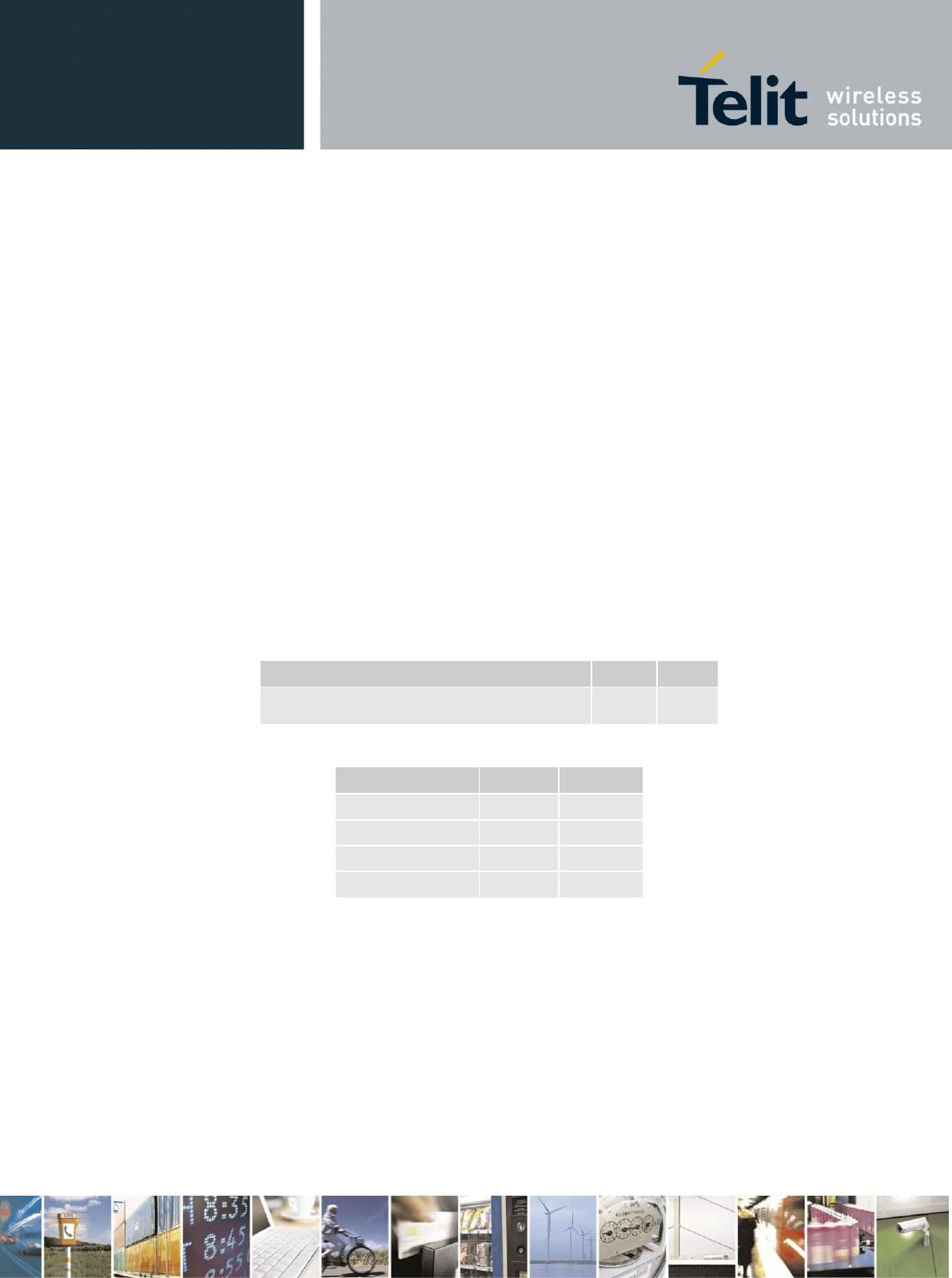
Reproduction forbidden without Telit Communications S.p.A. written authorization - All Rights Reserved page 56 of 93
11 Serial Ports
The UE910 module is provided with by 2 Asynchronous serial ports:
MODEM SERIAL PORT 1 (Main)
MODEM SERIAL PORT 2 (Auxiliary)
Several configurations can be designed for the serial port on the OEM hardware, but the most
common are:
RS232 PC com port
microcontroller UART @ 1.8V (Universal Asynchronous Receive Transmit)
microcontroller UART @ 5V or other voltages different from 1.8V
Depending from the type of serial port on the OEM hardware a level translator circuit may be
needed to make the system work.
On the UE910 the ports are CMOS 1.8.
The electrical characteristics of the Serial ports are explained in the following tables:
Absolute Maximum Ratings -Not Functional
Parameter
Min
Max
Input level on any digital pin (CMOS 1.8) with
respect to ground
-0.3V
2.1V
Operating Range - Interface levels (1.8V CMOS)
Level
Min
Max
Input high level
1.5V
1.9V
Input low level
0V
0.35V
Output high level
1.6V
1.9
Output low level
0V
0.2V
DRAFT
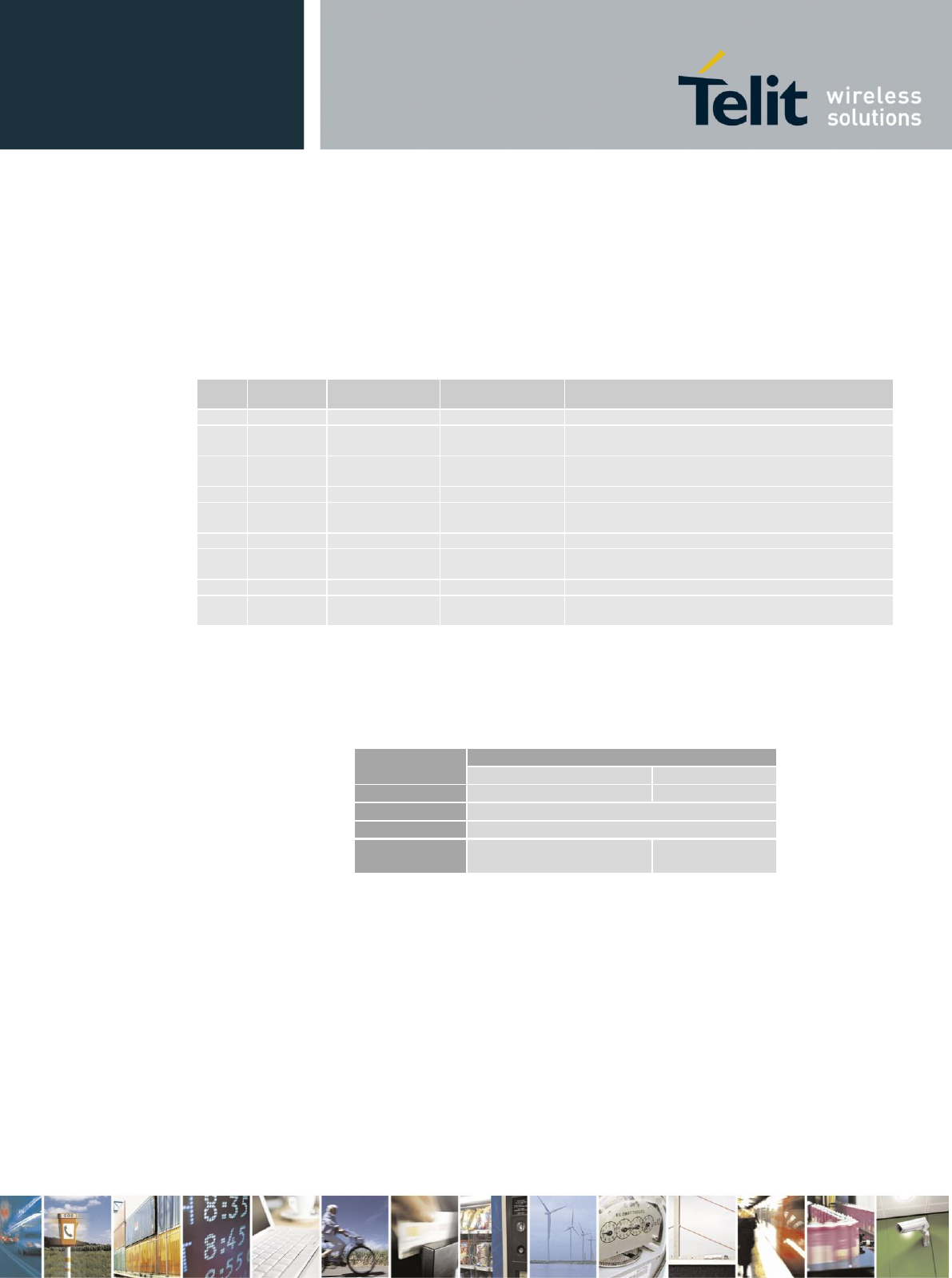
Reproduction forbidden without Telit Communications S.p.A. written authorization - All Rights Reserved page 57 of 93
11.1 MODEM SERIAL PORT 1 (USIF0)
The serial port 1 on the UE910 is a +1.8V UART with all the 7 RS232 signals.
It differs from the PC-RS232 in the signal polarity (RS232 is reversed) and levels.
RS232
Pin #
Signal
UE910
Pad Number
Name
Usage
1
C109/DCD
N14
Data Carrier Detect
Output from the UE910 that indicates the carrier presence
2
C104/RXD
M15
Transmit line *see
Note
Output transmit line of UE910 UART
3
C103/TXD
N15
Receive line *see
Note
Input receive of the UE910 UART
4
C108/DTR
M14
Data Terminal Ready
Input to the UE910 that controls the DTE READY condition
5
GND
M12, B13, P13,
E14 …
Ground
Ground
6
C107/DSR
P14
Data Set Ready
Output from the UE910 that indicates the module is ready
7
C106/CTS
P15
Clear to Send
Output from the UE910 that controls the Hardware flow
control
8
C105/RTS
L14
Request to Send
Input to the UE910 that controls the Hardware flow control
9
C125/RING
R14
Ring Indicator
Output from the UE910 that indicates the incoming call
condition
The following table shows the typical input value of internal pull-up resistors for RTS DTR
and TXD input lines and in all module states:
STATE
RTS DTR TXD
Pull up tied to
ON
5K to 12K
1V8
OFF
Schottky diode
RESET
Schottky diode
POWER
SAVING
5K to 12K
1V8
DRAFT
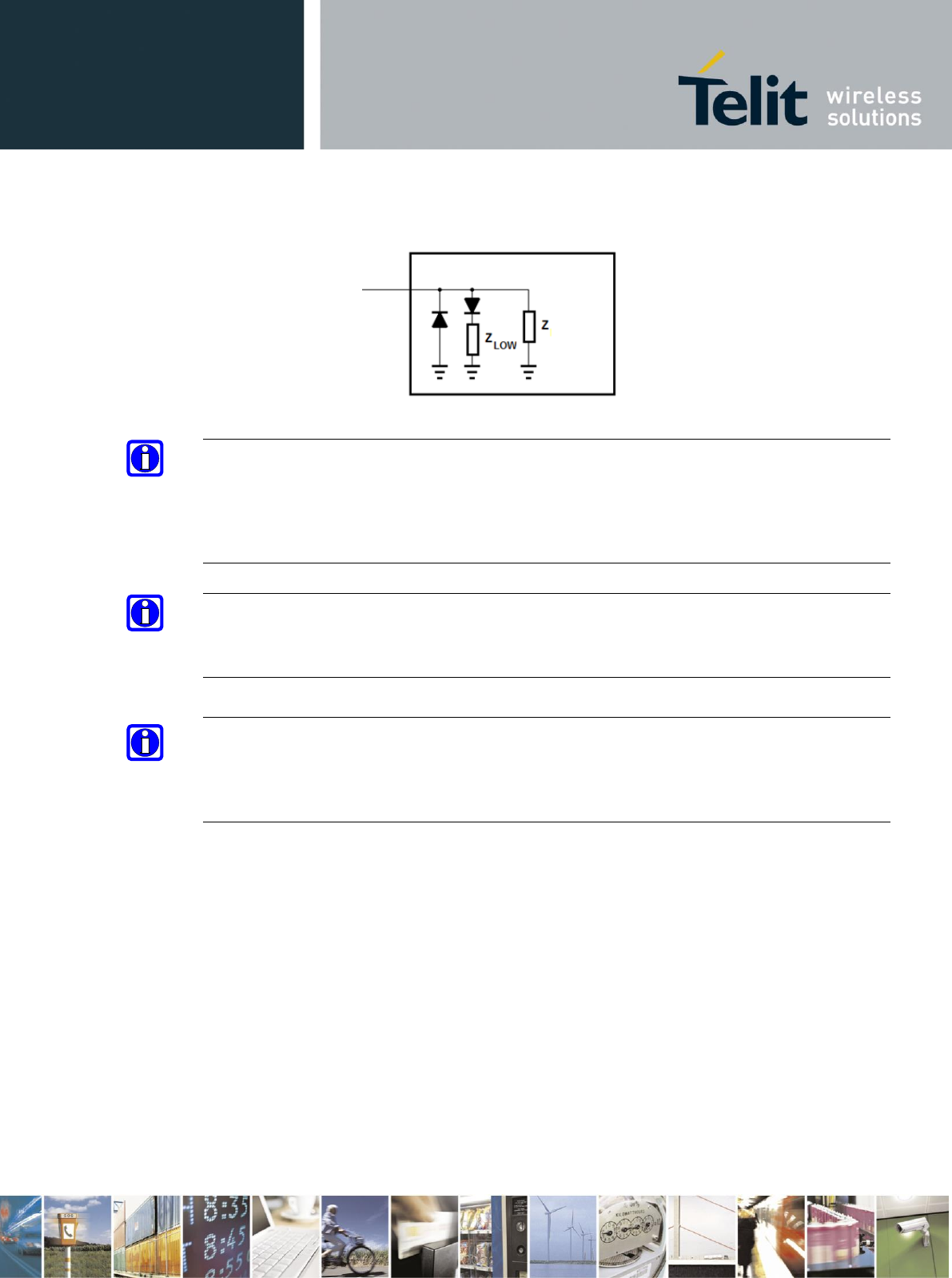
Reproduction forbidden without Telit Communications S.p.A. written authorization - All Rights Reserved page 58 of 93
The input line ON_OFF and RESET state can be treated as in picture below
NOTE:
According to V.24, some signal names are referred to the application side, therefore on the
UE910 side these signal are on the opposite direction:
TXD on the application side will be connected to the receive line (here named C103/TXD)
RXD on the application side will be connected to the transmit line (here named C104/RXD)
NOTE:
For a minimum implementation, only the TXD, RXD lines can be connected, the other lines can
be left open provided a software flow control is implemented.
NOTE:
In order to avoid a back powering effect it is recommended to avoid having any HIGH logic
level signal applied to the digital pins of the UE910 when the module is powered off or during
an ON/OFF transition.
DRAFT
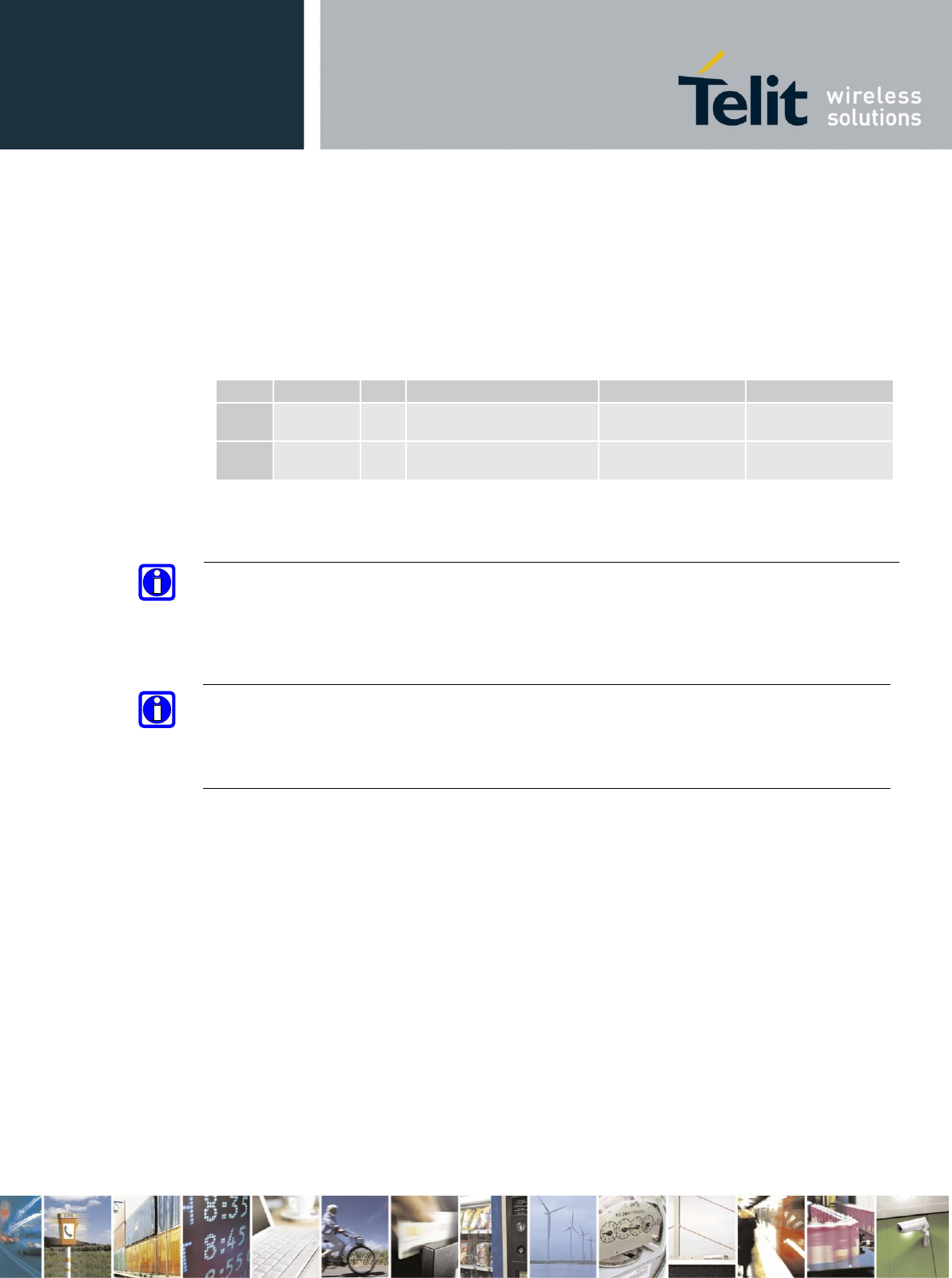
Reproduction forbidden without Telit Communications S.p.A. written authorization - All Rights Reserved page 59 of 93
11.2 MODEM SERIAL PORT 2 (USIF1)
The secondary serial port on the UE910 is a CMOS1.8V with only the RX and TX
signals.
The signals of the UE910 serial port are:
PAD
Signal
I/O
Function
Type
COMMENT
D15
TX_AUX
O
Auxiliary UART (TX Data to
DTE)
CMOS 1.8V
SHARED WITH
SPI_MTSR
E15
RX_AUX
I
Auxiliary UART (RX Data from
DTE)
CMOS 1.8V
SHARED WITH
SPI_MRST
NOTE:
In order to avoid a back powering effect it is recommended to avoid having any HIGH logic
level signal applied to the digital pins of the UE910 when the module is powered off or during
an ON/OFF transition.
NOTE:
Due to the shared pins, when the Modem Serial port is used, it is not possible to use the SPI
functions.
DRAFT
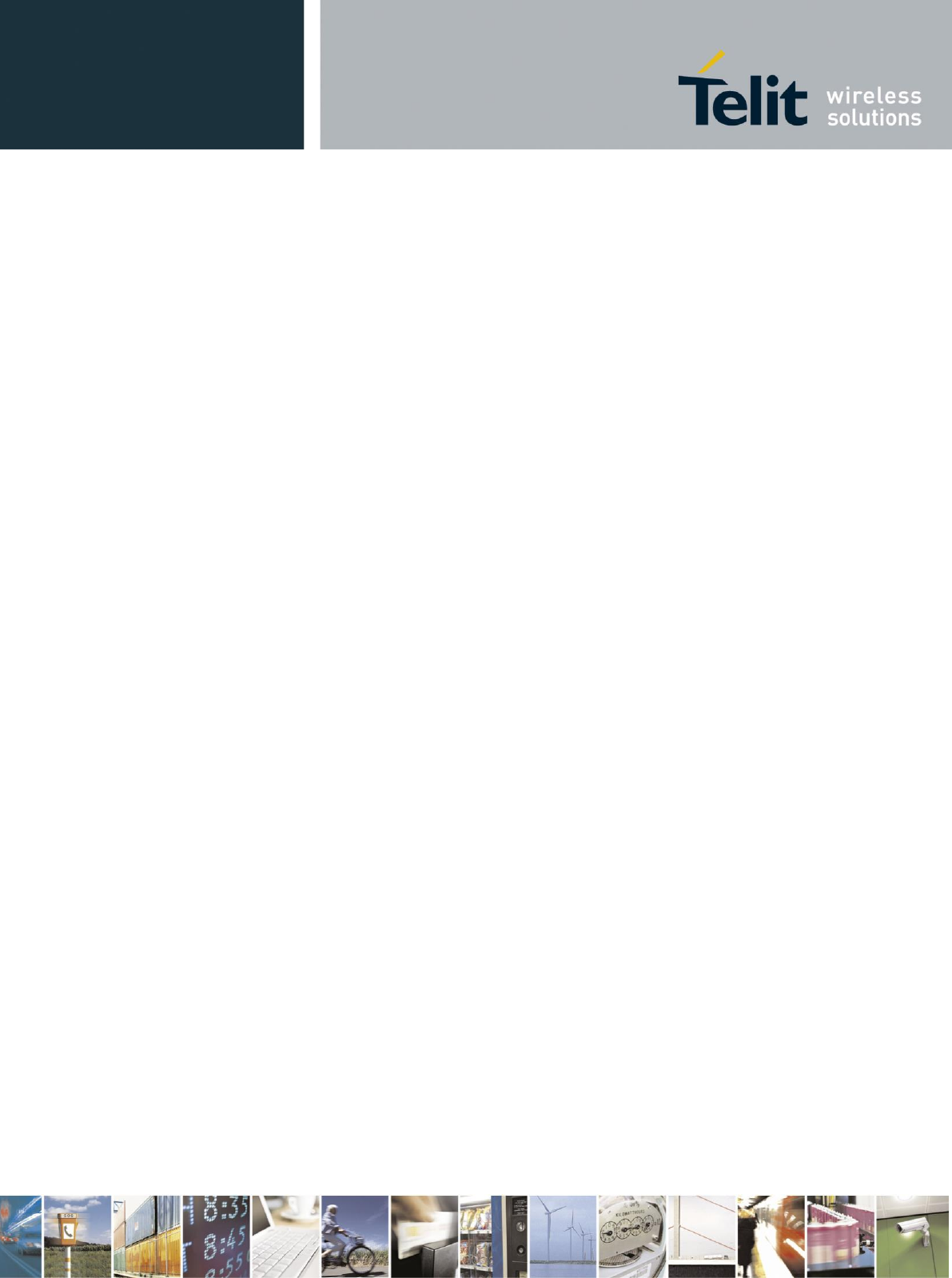
Reproduction forbidden without Telit Communications S.p.A. written authorization - All Rights Reserved page 60 of 93
11.3 RS232 level translation
In order to interface the UE910 with a PC com port or a RS232 (EIA/TIA-232) application a
level translator is required. This level translator must:
invert the electrical signal in both directions;
Change the level from 0/1.8V to +15/-15V.
Actually, the RS232 UART 16450, 16550, 16650 & 16750 chipsets accept signals with lower
levels on the RS232 side (EIA/TIA-562), allowing a lower voltage-multiplying ratio on the level
translator. Note that the negative signal voltage must be less than 0V and hence some sort of
level translation is always required.
The simplest way to translate the levels and invert the signal is by using a single chip level
translator. There are a multitude of them, differing in the number of drivers and receivers and in
the levels (be sure to get a true RS232 level translator not a RS485 or other standards).
By convention the driver is the level translator from the 0-1.8V UART to the RS232 level. The
receiver is the translator from the RS232 level to 0-1.8V UART.
In order to translate the whole set of control lines of the UART you will need:
5 drivers
3 receivers
DRAFT
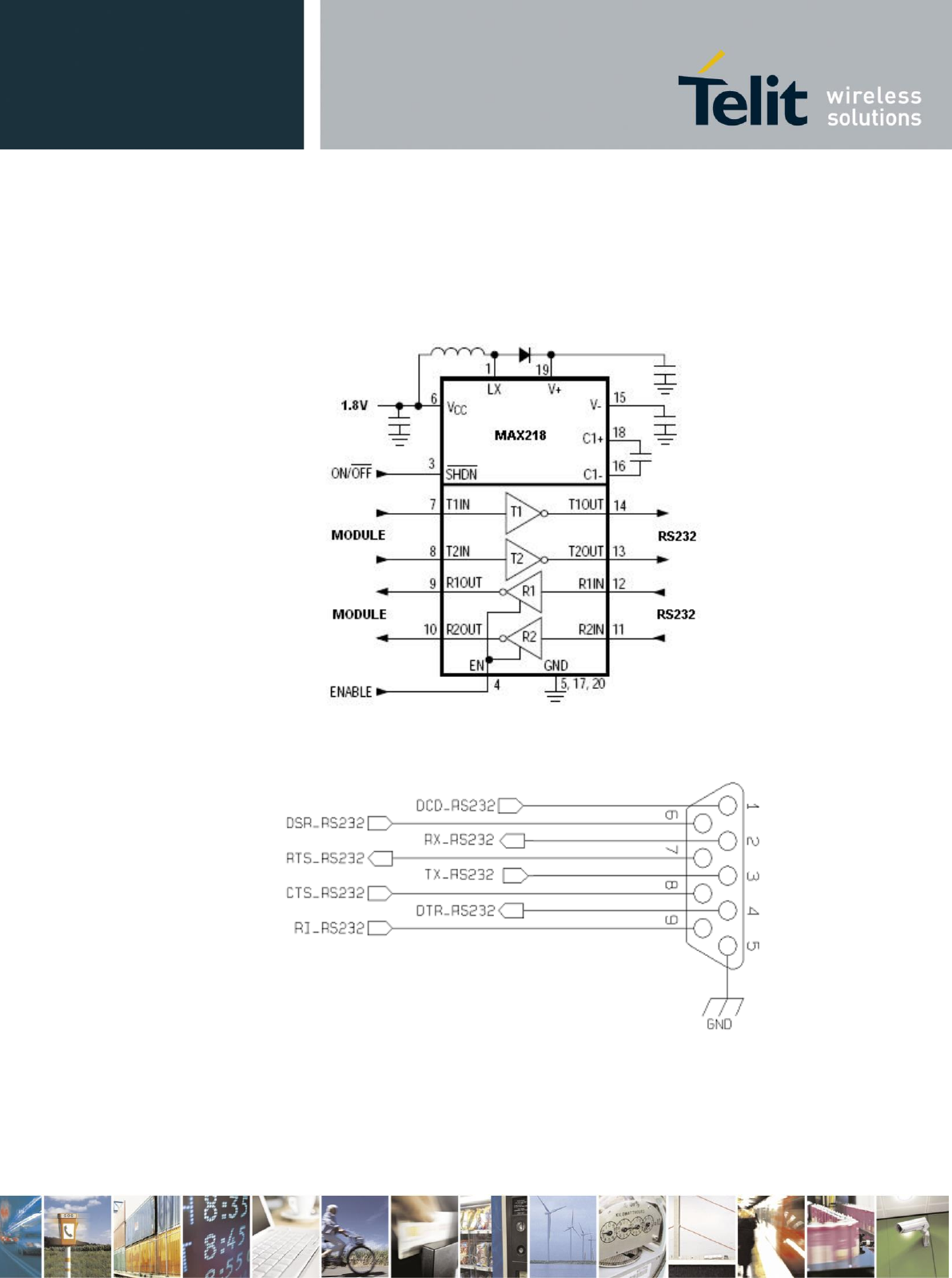
Reproduction forbidden without Telit Communications S.p.A. written authorization - All Rights Reserved page 61 of 93
An example of RS232 level adaptation circuitry could be done using a MAXIM transceiver
(MAX218)
In this case the chipset is capable to translate directly from 1.8V to the RS232 levels (Example
done on 4 signals only).
The RS232 serial port lines are usually connected to a DB9 connector with the following layout:
DRAFT
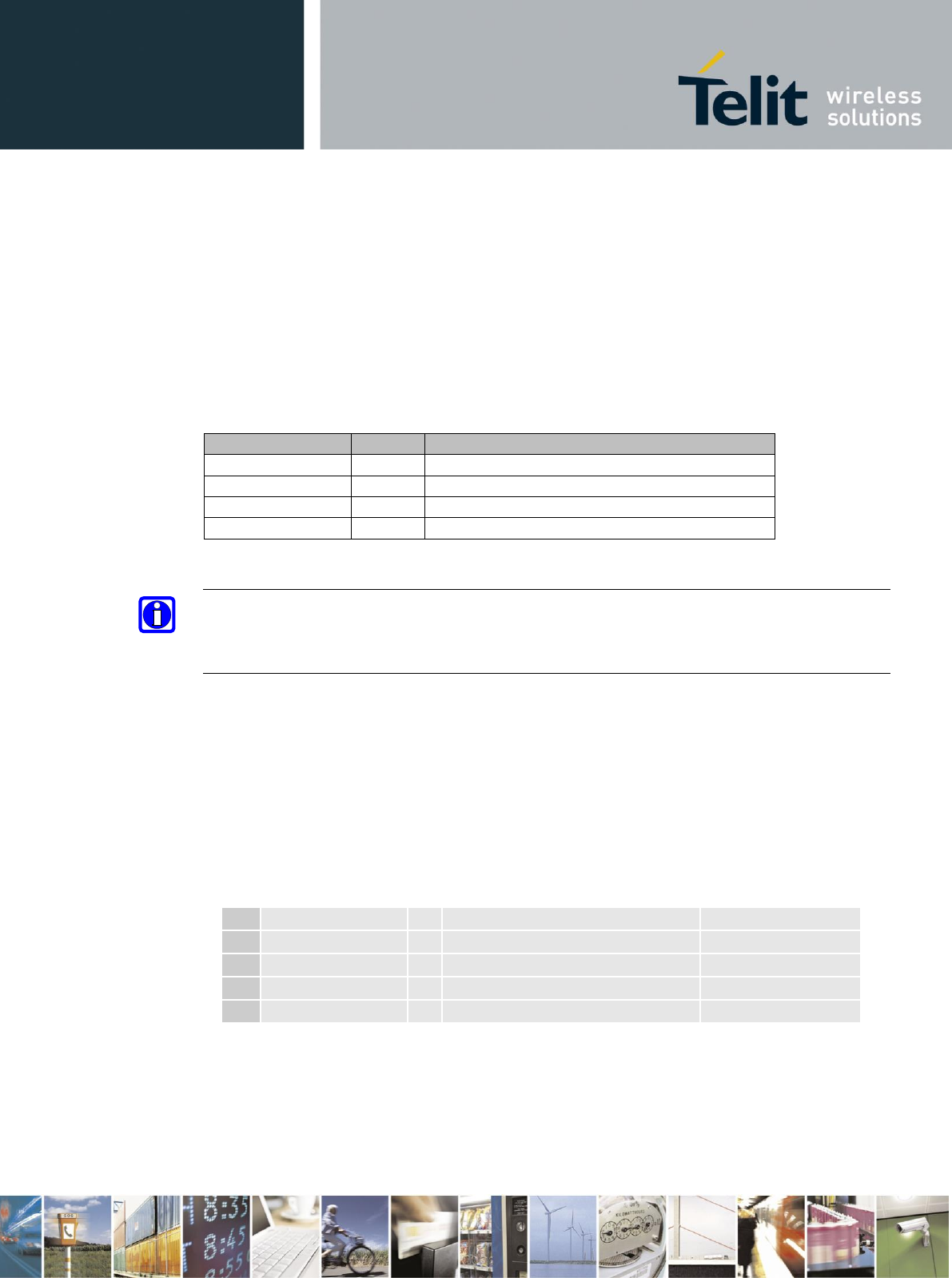
Reproduction forbidden without Telit Communications S.p.A. written authorization - All Rights Reserved page 62 of 93
12 Audio Section Overview
The UE910 is provided by two main interfaces:
Analog Audio Path
Digital Audio Path
The UE910 variants supporting the Audio are listed in the following table::
Product
Audio
Notes
UE910-EUR
YES
UE910-EUD
NO
Reserved Pads:,B2, B3, B4, B5
UE910-NAR
YES
UE910-NAD
NO
Reserved Pads:,B2, B3, B4, B5
NOTE:
The two Paths could not be used in parallel; If the Analog Voice lines are selected, the DVI
interface is disabled and Vice versa.
12.1 Analog Voice Interface
The Base Band Chip of the UE910 provides one differential input for audio to be transmitted
(Uplink) and a balanced BTL output for audio to be received (downlink).
The Signals are available on the following Pads:
PAD
Signal
I/O
Function
Note
B2
EAR+
O
Analog Voice Interface (EAR+)
B3
EAR-
O
Analog Voice Interface (EAR-)
B4
MIC+
I
Analog Voice Interface (MIC+)
B5
MIC-
I
Analog Voice Interface (MIC-)
DRAFT
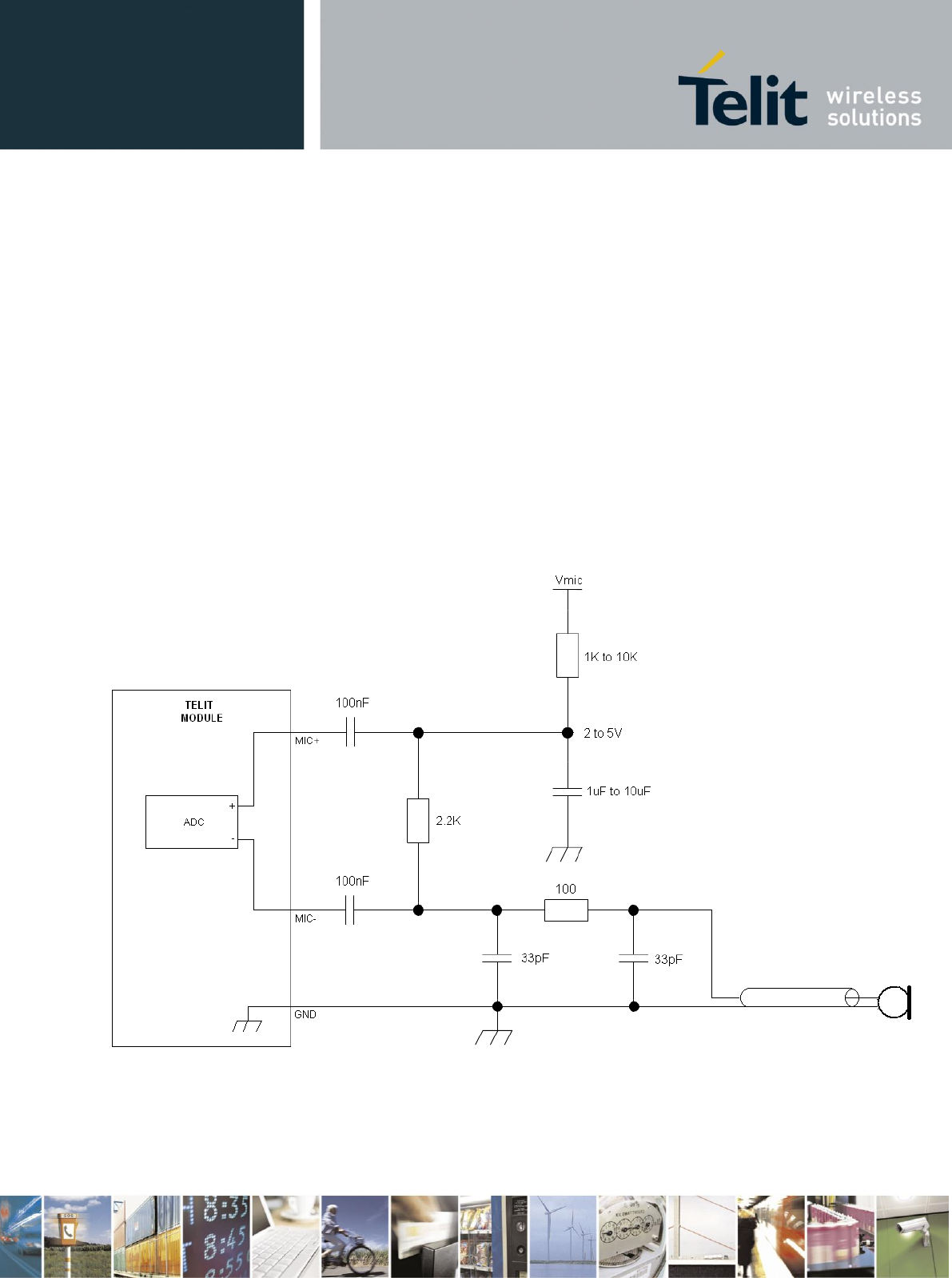
Reproduction forbidden without Telit Communications S.p.A. written authorization - All Rights Reserved page 63 of 93
12.1.1 MIC connection
The bias for the microphone has to be as clean as possible; the first connection (single ended) is
preferable since the Vmic noise and ground noise are fed into the input as common mode and
then rejected. This sounds strange; usually the connection to use in order to reject the common
mode is the balanced one. In this situation we have to recall that the microphone is a sound to
current transducer, so the resistor is the current to tension transducer, so finally the resistor feeds
the input in balanced way even if the configuration, from a microphone point of view, seems to
be un-balanced.
The following images show some connection examples:
DRAFT
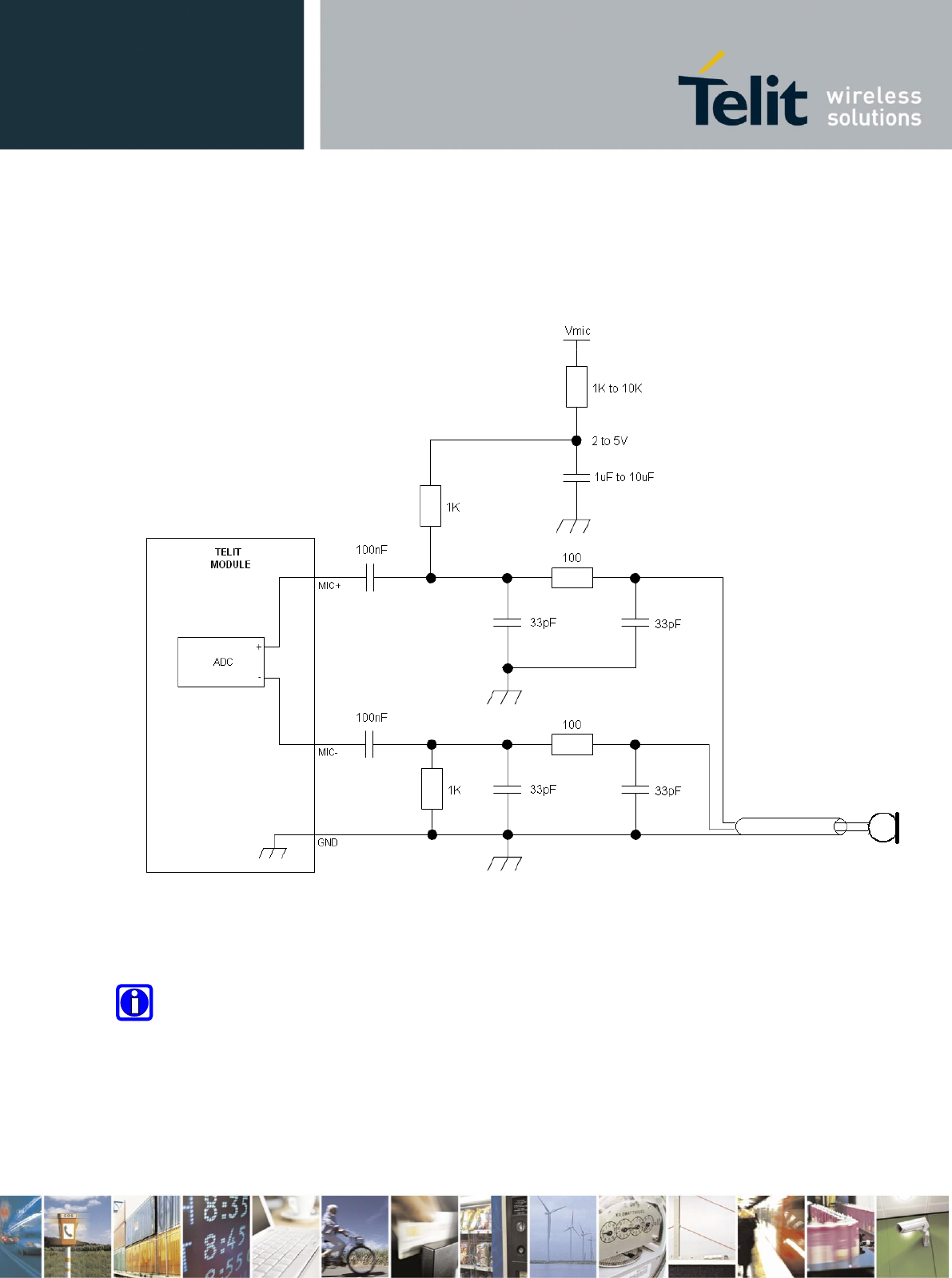
Reproduction forbidden without Telit Communications S.p.A. written authorization - All Rights Reserved page 64 of 93
If a "balanced way" is anyway desired, much more care has to be taken to Vmic noise and
ground noise; also the 33pF-100Ohm-33pF RF-filter has to be doubled (one each wire).
TIP: Since the J-FET transistor inside the microphone acts as RF-detector-amplifier, ask
vendor for a microphone with anti-EMI capacitor (usually a 33pF or a 10pF capacitor placed
across the output terminals inside the case).
DRAFT
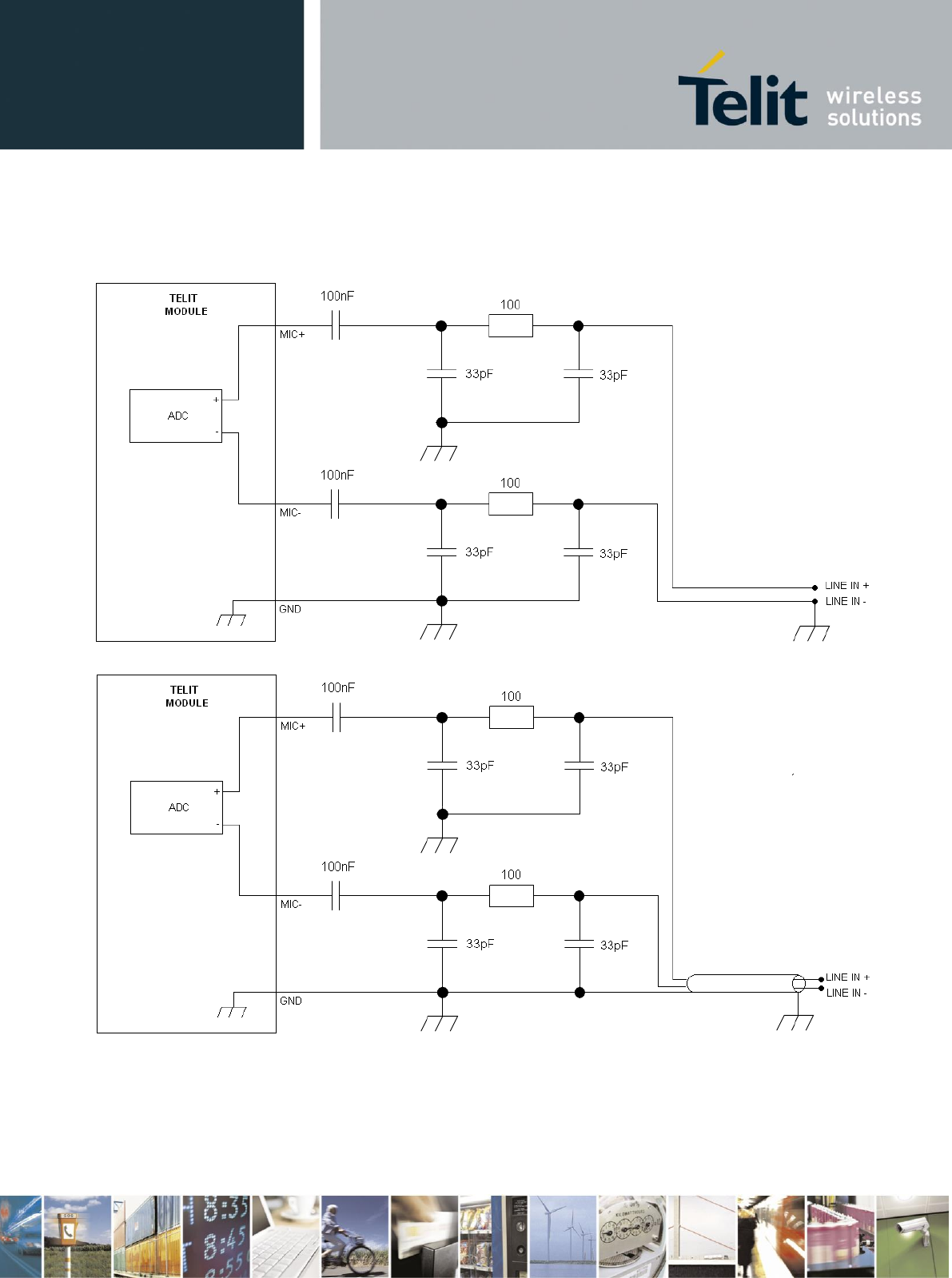
Reproduction forbidden without Telit Communications S.p.A. written authorization - All Rights Reserved page 65 of 93
12.1.2 LINE IN Connection
If the audio source is not a mike but a different device, the following connections can be done.
Place 100nF capacitor in series with both inputs, so the DC current is blocked.
Place the 33pF-100Ohm-33pF RF-filter, in order to prevent some EMI field to get into the high
impedance high gain MIC inputs.
Since the input is differential, the common mode voltage noise between the two (different)
ground is rejected, provided that both MIC+ & MIC- are connected directly onto the source.
DRAFT
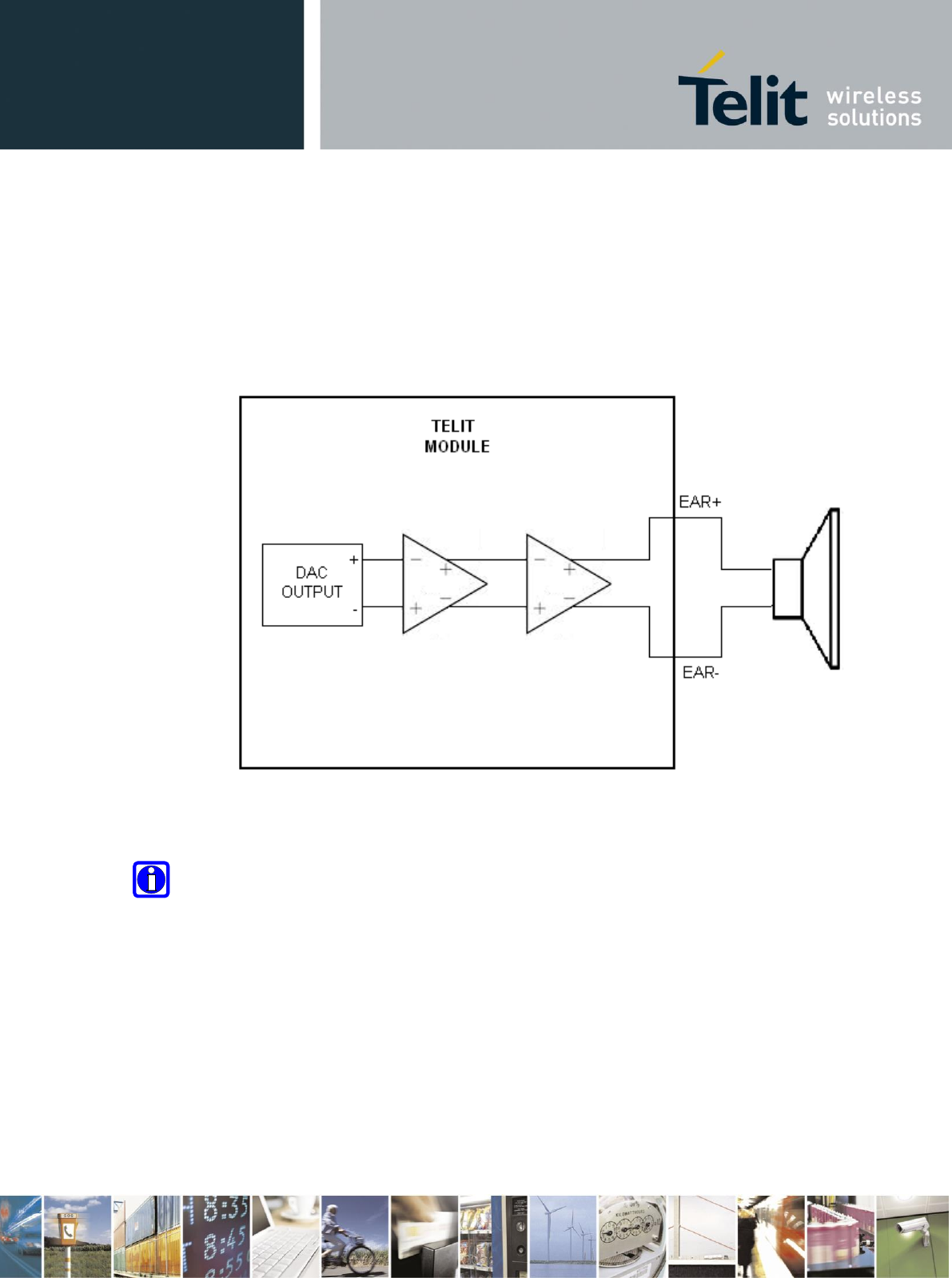
Reproduction forbidden without Telit Communications S.p.A. written authorization - All Rights Reserved page 66 of 93
12.1.3 EAR Connection
The audio output of the UE910 is balanced, this is helpful to double the level and to reject
common mode (click and pop are common mode and therefore rejected).
These outputs can drive directly a small loudspeaker with electrical impedance not lower than
16 Ohm.
TIP: in order to get the maximum audio level at a given output voltage level (dBspl/Vrms), the
following breaking through procedure can be used. Have the loudspeaker as close as you can to
the listener (this simplify also the echo cancelling); choose the loudspeaker with the higher
sensitivity (dBspl per W); choose loudspeakers with the impedance close to the limit, in order to
feed more power inside the transducer (it increases the W/Vrms ratio). If this were not enough,
an external amplifier should be used.
DRAFT
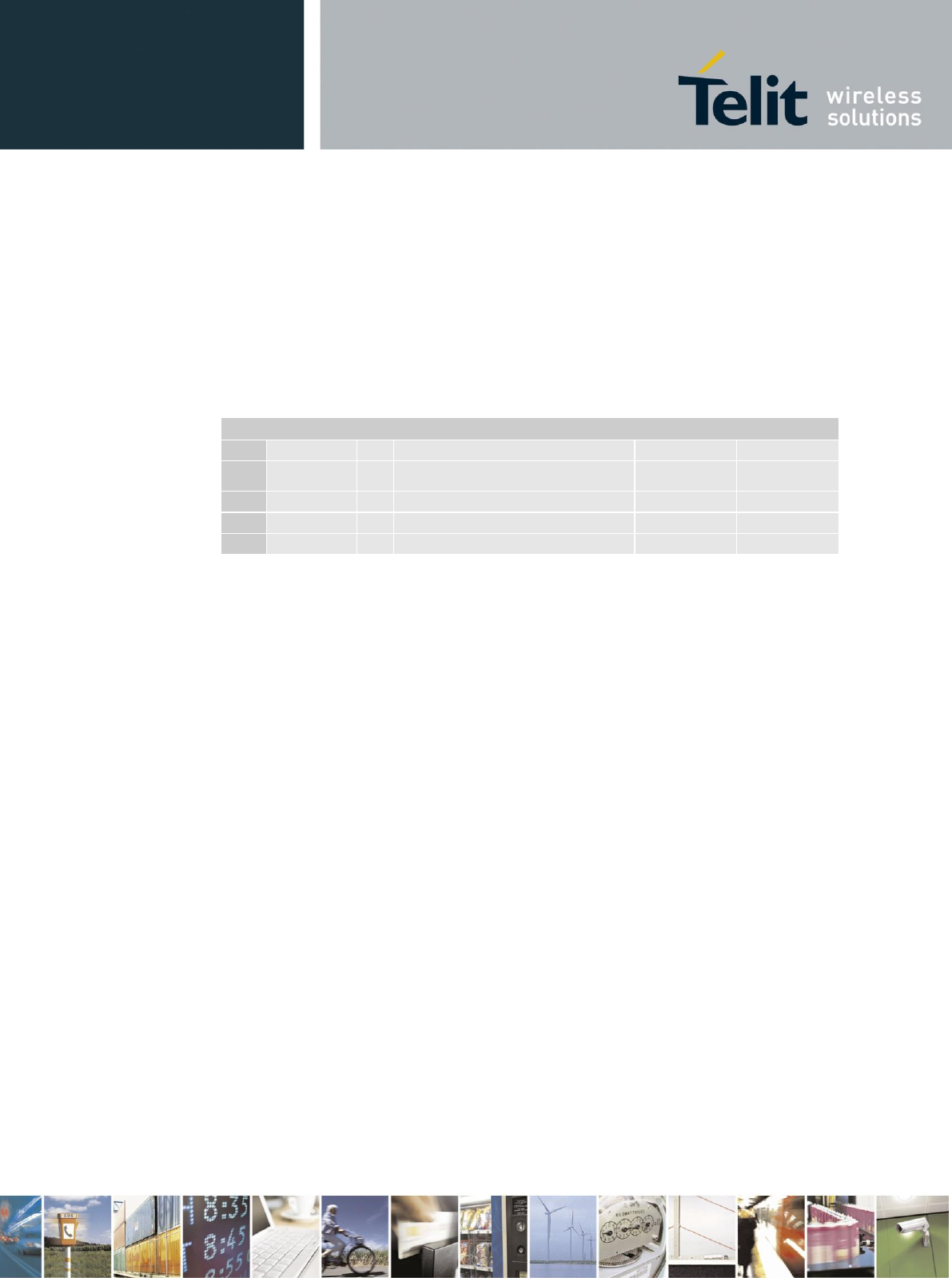
Reproduction forbidden without Telit Communications S.p.A. written authorization - All Rights Reserved page 67 of 93
12.2 Digital Voice Interface
The UE910 Module is provided by one DVI digital audio interface.
12.2.1 Electrical Characteristics
The product is providing the Digital Voice Interface (DVI) on the following Pins:
Digital Voice Interface (DVI)
PAD
Signal
I/O
Function
Note
Type
B9
DVI_WA0
I/O
Digital Voice Interface (Word Alignment /
LRCLK)
CMOS 1.8V
B6
DVI_RX
I
Digital Voice Interface (RX)
CMOS 1.8V
B7
DVI_TX
O
Digital Voice Interface (TX)
CMOS 1.8V
B8
DVI_CLK
I/O
Digital Voice Interface (BCLK)
CMOS 1.8V
12.2.2 CODEC Examples
Please refer to the Digital Audio Application note.
DRAFT
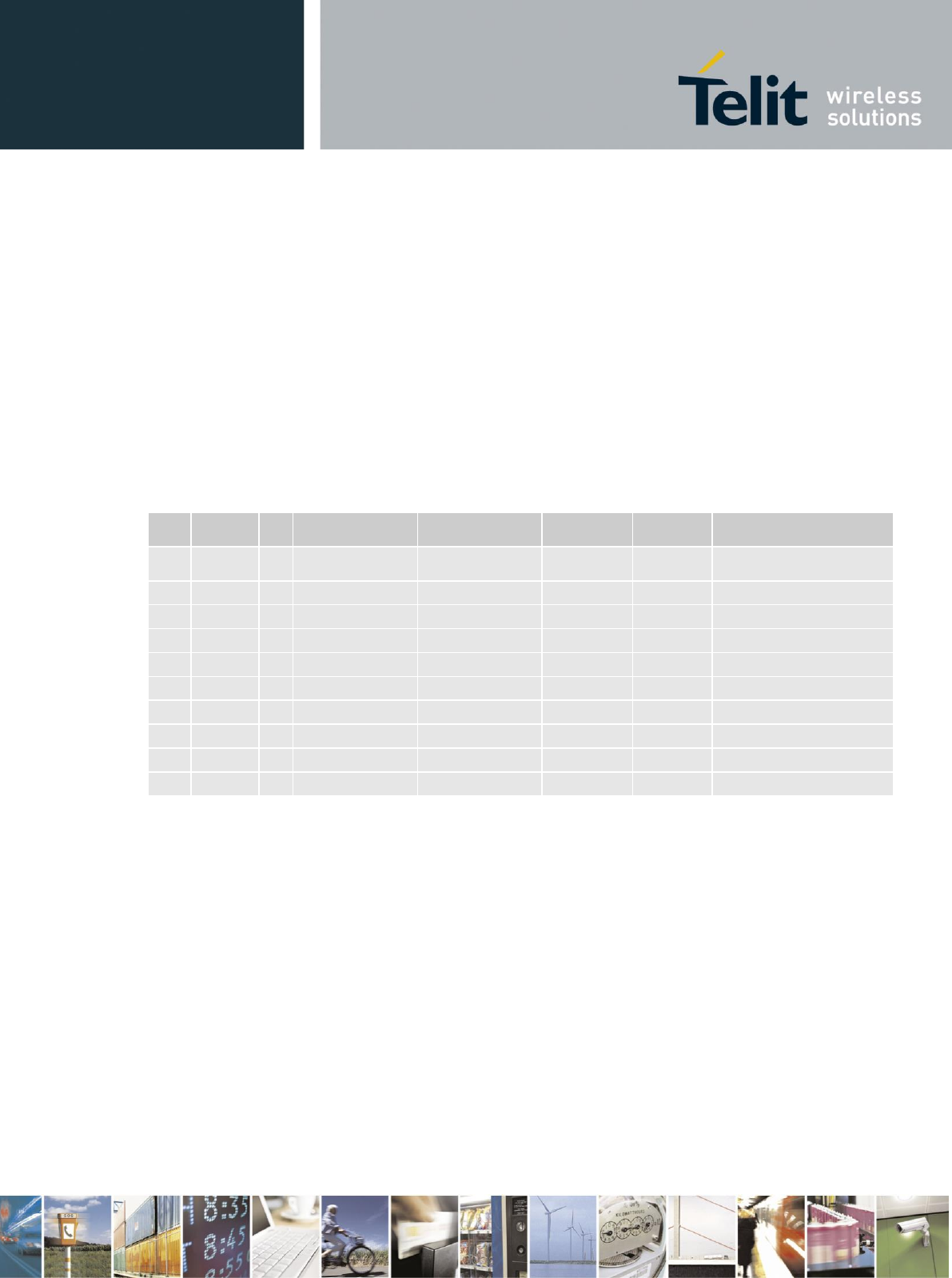
Reproduction forbidden without Telit Communications S.p.A. written authorization - All Rights Reserved page 68 of 93
13 General Purpose I/O
The UE910 module is provided by a set of Digital Input / Output pins
Input pads can only be read; they report the digital value (high or low) present on the pad at the
read time.
Output pads can only be written or queried and set the value of the pad output.
An alternate function pad is internally controlled by the UE910 firmware and acts depending on
the function implemented.
The following table shows the available GPIO on the UE910:
PAD
Signal
I/O
Function
Type
Drive
strength
Default
State
Note
C8
GPIO_01
I/O
Configurable GPIO
CMOS 1.8V
1 mA
INPUT
Alternate function STAT
LED
C9
GPIO_02
I/O
Configurable GPIO
CMOS 1.8V
1 mA
INPUT
C10
GPIO_03
I/O
Configurable GPIO
CMOS 1.8V
1 mA
INPUT
C11
GPIO_04
I/O
Configurable GPIO
CMOS 1.8V
1 mA
INPUT
B14
GPIO_05
I/O
Configurable GPIO
CMOS 1.8V
1 mA
INPUT
C12
GPIO_06
I/O
Configurable GPIO
CMOS 1.8V
1 mA
INPUT
C13
GPIO_07
I/O
Configurable GPIO
CMOS 1.8V
1 mA
INPUT
K15
GPIO_08
I/O
Configurable GPIO
CMOS 1.8V
1 mA
INPUT
L15
GPIO_09
I/O
Configurable GPIO
CMOS 1.8V
1 mA
INPUT
G15
GPIO_10
I/O
Configurable GPIO
CMOS 1.8V
1 mA
INPUT
DRAFT
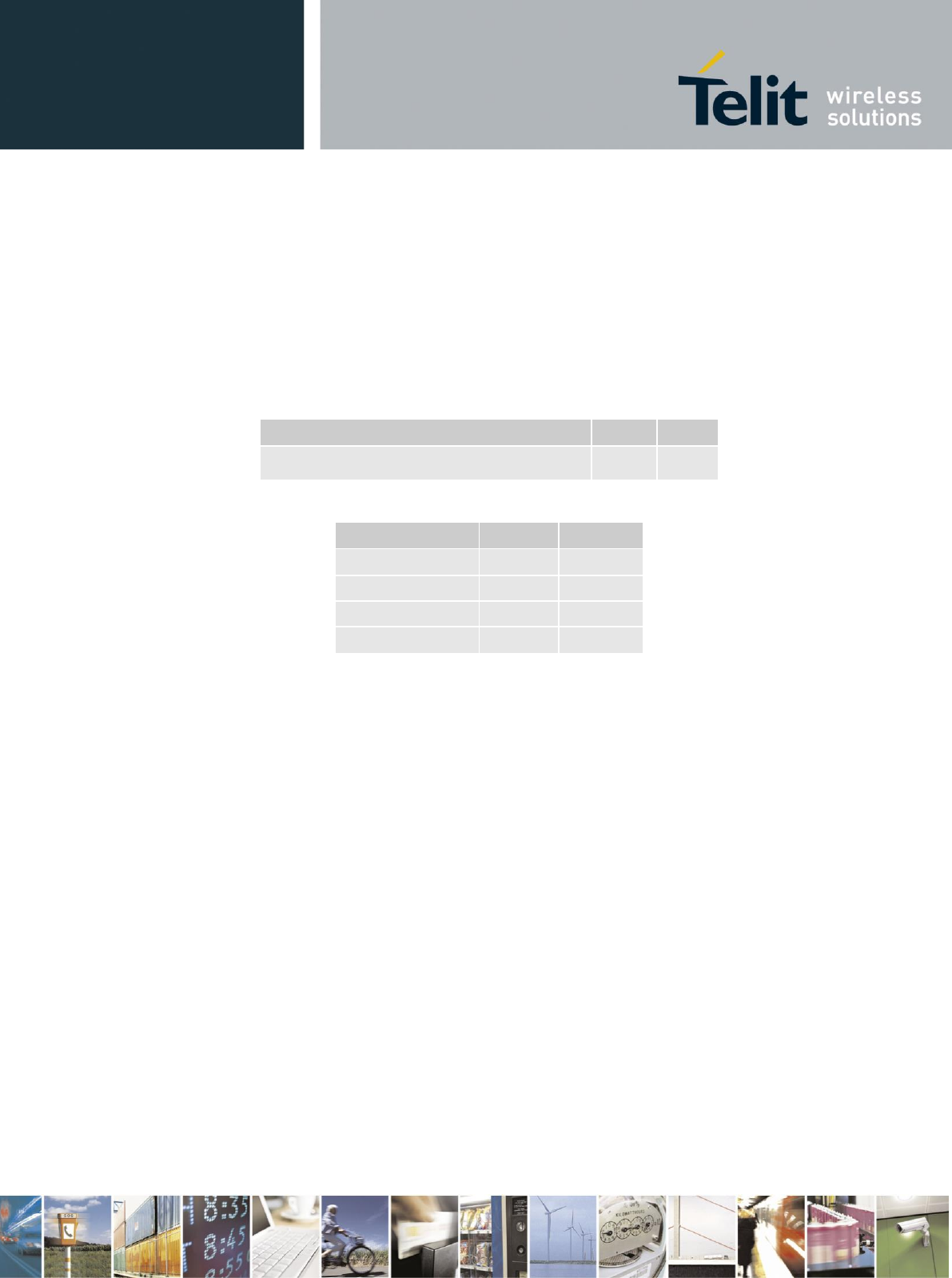
Reproduction forbidden without Telit Communications S.p.A. written authorization - All Rights Reserved page 69 of 93
13.1 GPIO Logic levels
Where not specifically stated, all the interface circuits work at 1.8V CMOS logic levels.
The following table shows the logic level specifications used in the UE910 interface circuits:
Absolute Maximum Ratings -Not Functional
Parameter
Min
Max
Input level on any digital pin (CMOS 1.8) with respect
to ground
-0.3V
2.1V
Operating Range - Interface levels (1.8V CMOS)
Level
Min
Max
Input high level
1.5V
1.9V
Input low level
0V
0.35V
Output high level
1.6V
1.9
Output low level
0V
0.2V
DRAFT

Reproduction forbidden without Telit Communications S.p.A. written authorization - All Rights Reserved page 70 of 93
13.2 Using a GPIO Pad as INPUT
The GPIO pads, when used as inputs, can be connected to a digital output of another device and
report its status, provided this device has interface levels compatible with the 1.8V CMOS levels
of the GPIO.
If the digital output of the device to be connected with the GPIO input pad has interface levels
different from the 1.8V CMOS, then it can be buffered with an open collector transistor with a
47K pull up to 1.8V.
NOTE:
In order to avoid a back powering effect it is recommended to avoid having any HIGH logic
level signal applied to the digital pins of the UE910 when the module is powered off or during
an ON/OFF transition.
13.3 Using a GPIO Pad as OUTPUT
The GPIO pads, when used as outputs, can drive 1.8V CMOS digital devices or compatible
hardware. When set as outputs, the pads have a push-pull output and therefore the pull-up
resistor may be omitted.
DRAFT
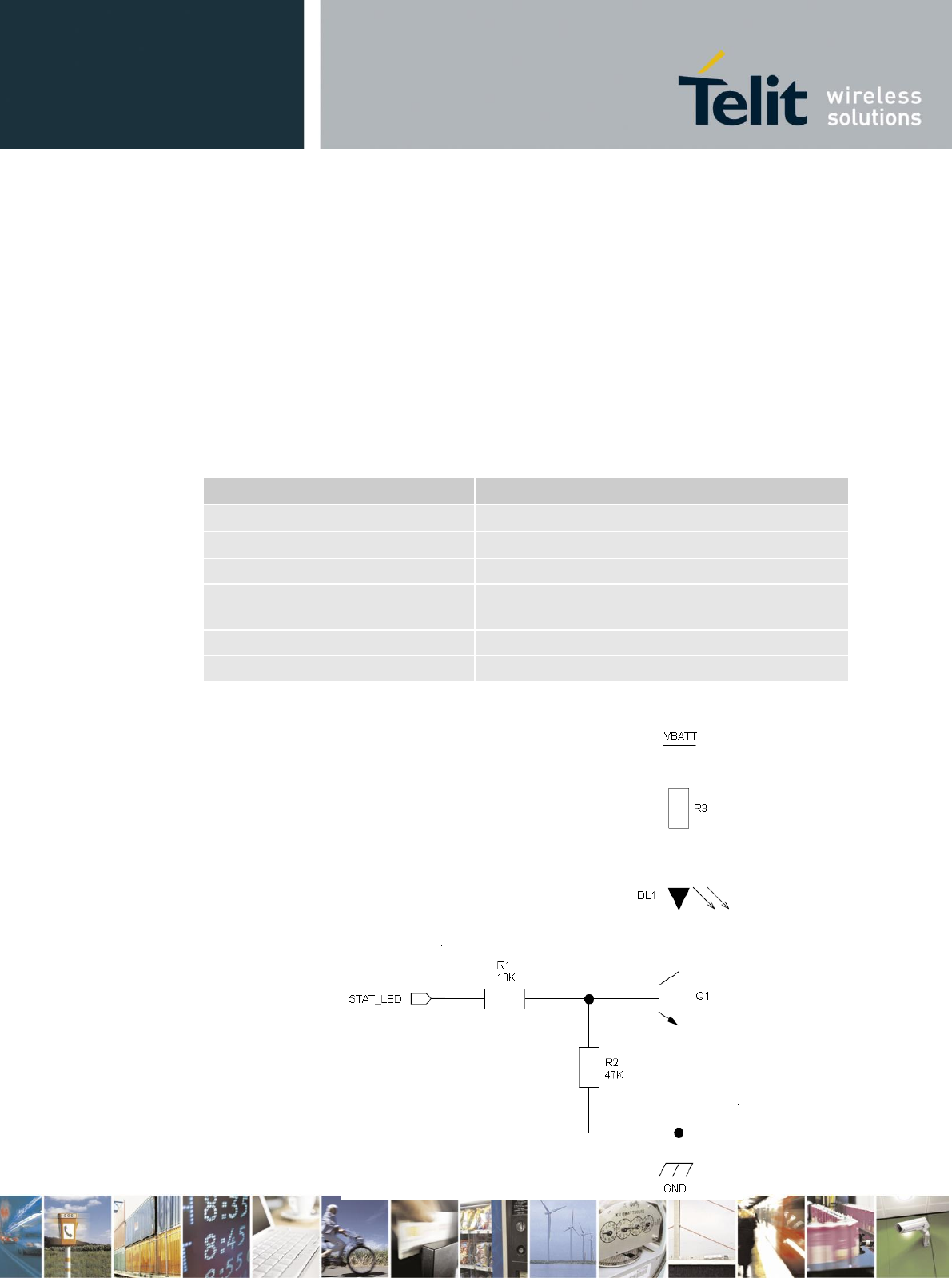
Reproduction forbidden without Telit Communications S.p.A. written authorization - All Rights Reserved page 71 of 93
13.4 Indication of network service
availability
The STAT_LED pin status shows information on the network service availability and Call
status. The function is available as alternate function of GPIO_01 (to be enabled using the
AT#GPIO=1,0,2 command).
In the UE910 modules, the STAT_LED needs an external transistor to drive an external LED.
Therefore, the status indicated in the following table is reversed with respect to the pin status.
Device Status
LED status
Device off
Permanently off
Not Registered
Permanently on
Registered in idle
Blinking 1sec on + 2 sec off
Registered in idle + power saving
It depends on the event that triggers the wakeup (In
sync with network paging)
Voice Call Active
Permanently on
Dial-Up
Blinking 1 sec on + 2 sec off
A schematic example could be:
DRAFT
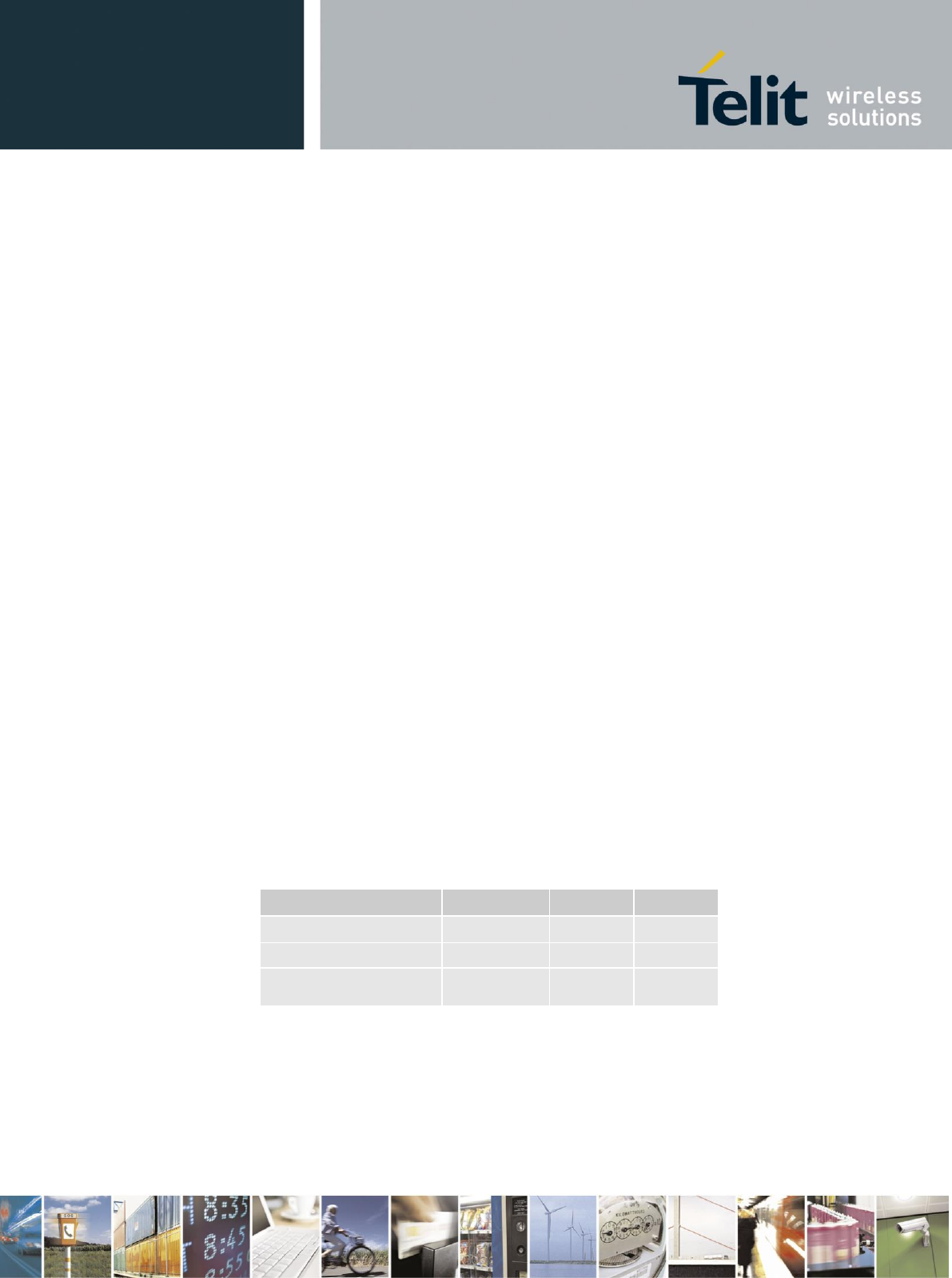
Reproduction forbidden without Telit Communications S.p.A. written authorization - All Rights Reserved page 72 of 93
13.5 RTC Bypass out
The VRTC pin brings out the Real Time Clock supply, which is separate from the rest of the
digital part, allowing having only RTC going on when all the other parts of the device are off.
To this power output a backup capacitor can be added in order to increase the RTC autonomy
during power off of the battery. NO Devices must be powered from this pin.
In order to keep the RTC active when VBATT is not supplied it is possible to back up the RTC
section connecting a backup circuit to the related VRTC signal (pad C14 on module’s Pinout).
For additional details on the Backup solutions please refer to the related application note (xE910
RTC Backup Application Note)
13.6 External SIM Holder Implementation
Please refer to the related User Guide (SIM Holder Design Guides, 80000NT10001a).
13.7 VAUX Power Output
A regulated power supply output is provided in order to supply small devices from the module.
The signal is present on Pad R11 and it is in common with the PWRMON (module powered ON
indication) function.
This output is always active when the module is powered ON.
The operating range characteristics of the supply are:
Level
Min
Typical
Max
Output voltage
1.78V
1.80V
1.82V
Output current
-
-
60mA
Output bypass capacitor
(inside the module)
1uF
DRAFT
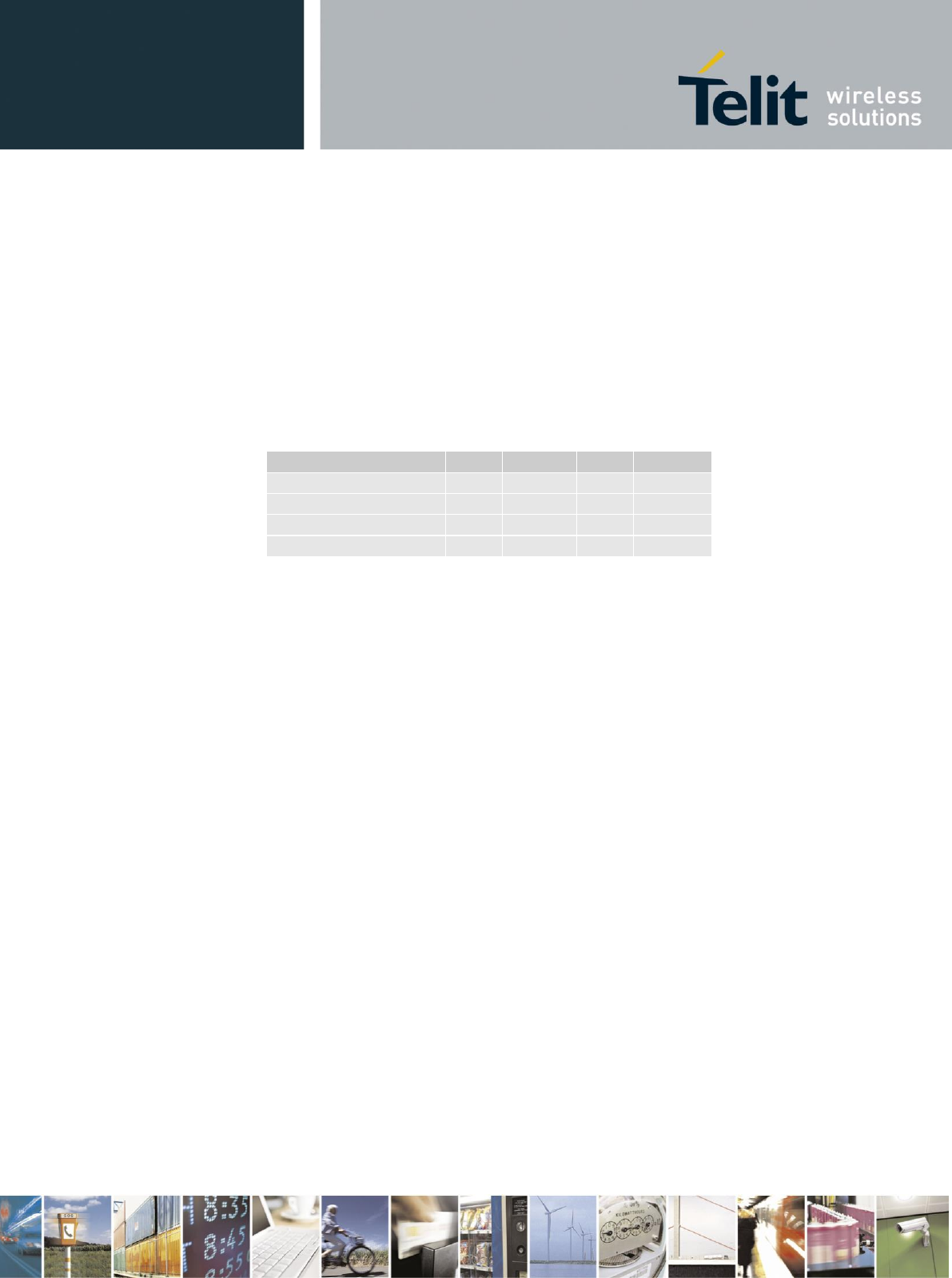
Reproduction forbidden without Telit Communications S.p.A. written authorization - All Rights Reserved page 73 of 93
13.8 ADC Converter
13.8.1 Description
The UE910 is provided by one AD converter. It is able to read a voltage level in the range of
0÷1.2 volts applied on the ADC pin input, store and convert it into 10 bit word.
The following table is showing the ADC characteristics:
Min
Typical
Max
Units
Input Voltage range
0
-
1.2
Volt
AD conversion
-
-
10
bits
Input Resistance
1
-
-
Mohm
Input Capacitance
-
1
-
pF
The input line is named as ADC_IN1 and it is available on Pad B1
13.8.2 Using ADC Converter
An AT command is available to use the ADC function.
The command is AT#ADC=1,2
The read value is expressed in mV
Refer to SW User Guide or AT Commands Reference Guide for the full description of this
function.
DRAFT
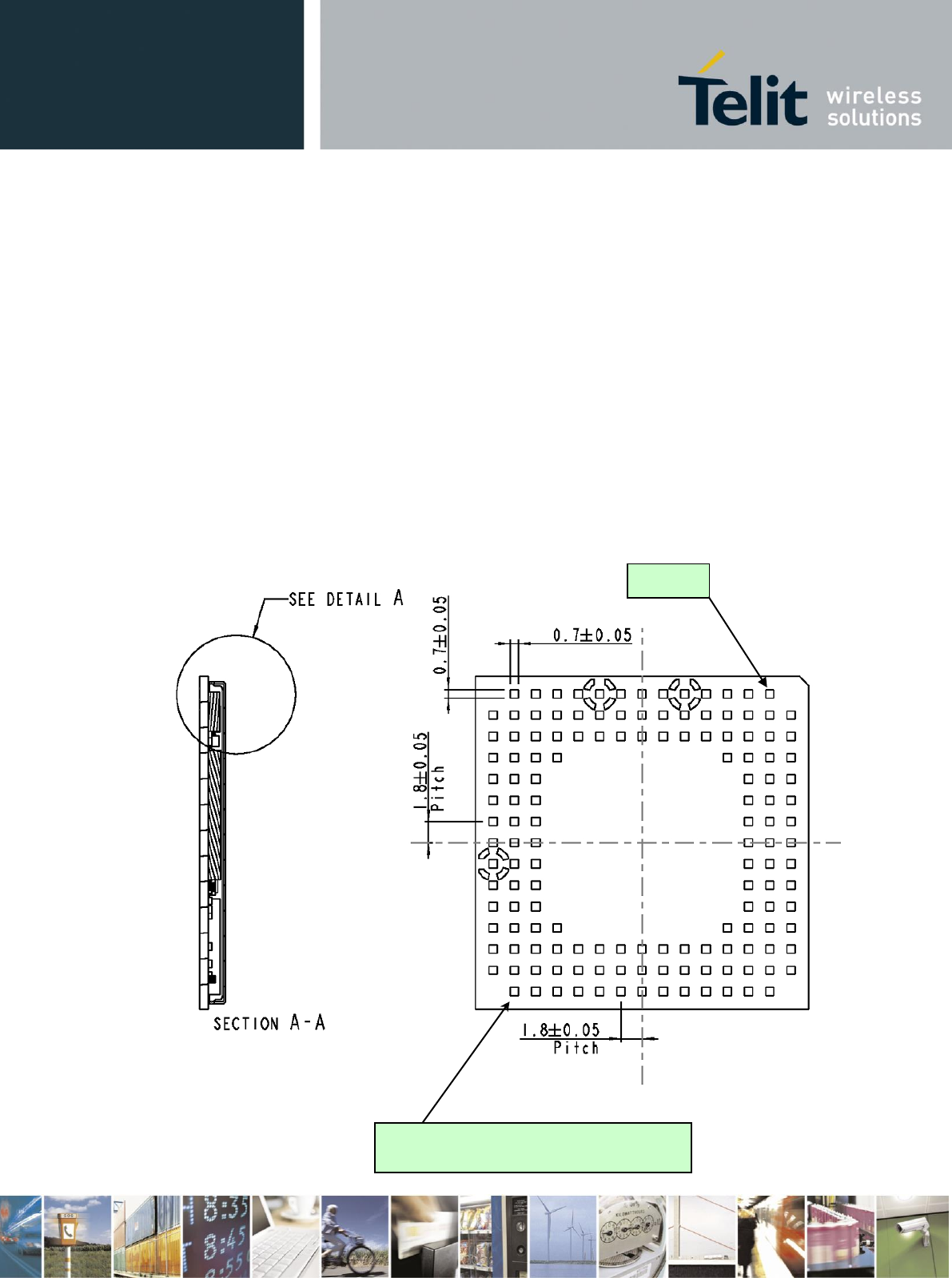
Reproduction forbidden without Telit Communications S.p.A. written authorization - All Rights Reserved page 74 of 93
14 Mounting the UE910 on the
application
14.1 General
The UE910 modules have been designed in order to be compliant with a standard lead-free
SMT process.
14.2 Module finishing & dimensions
Pin B1
Dimensions in mm
Bottom view
Lead-free Alloy:
Surface finishing Ni/Au for all solder pads
DRAFT
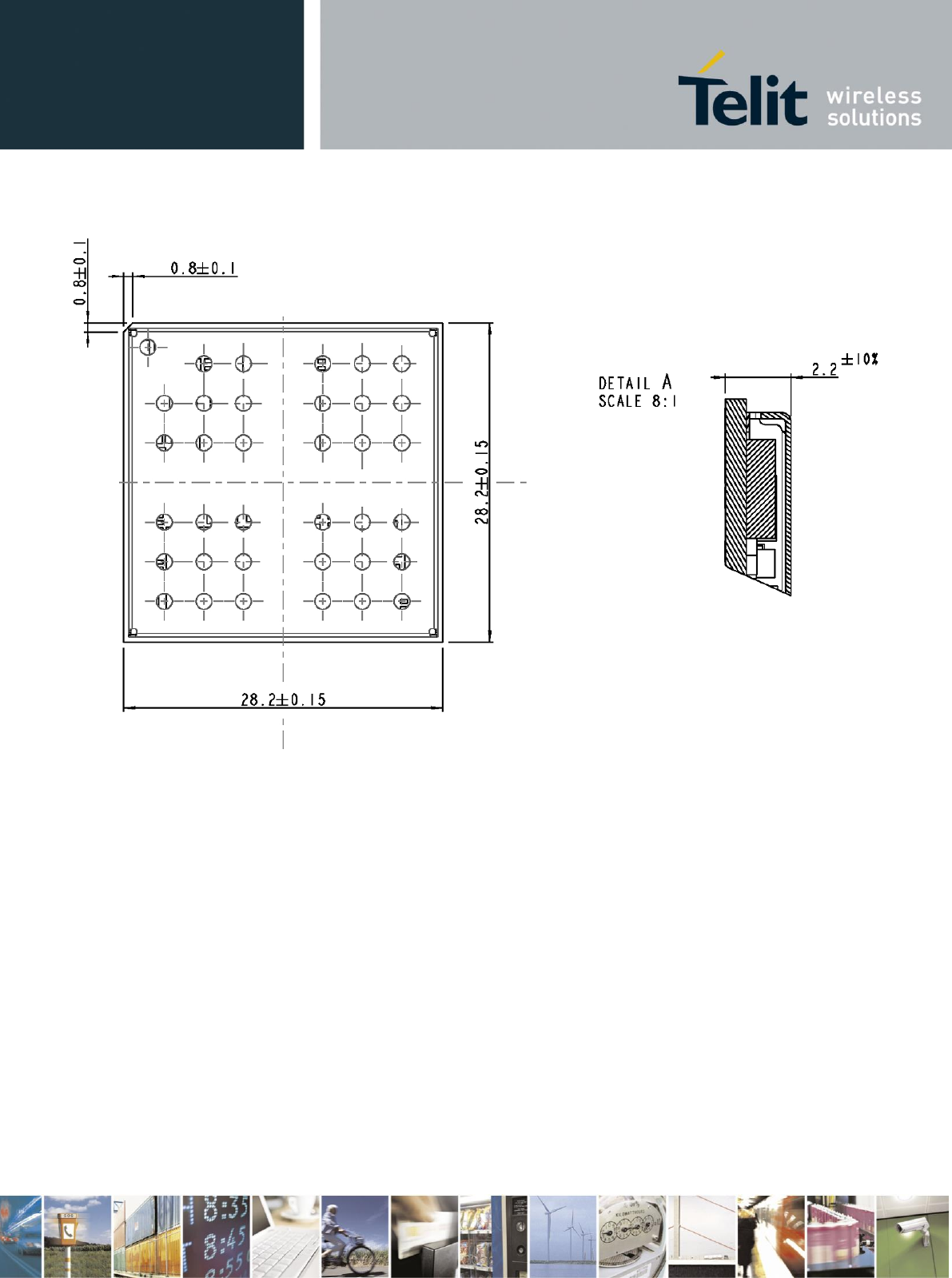
Reproduction forbidden without Telit Communications S.p.A. written authorization - All Rights Reserved page 75 of 93
DRAFT

Reproduction forbidden without Telit Communications S.p.A. written authorization - All Rights Reserved page 76 of 93
14.3 Recommended foot print for the
application
TOP VIEW
In order to
easily rework the UE910 is suggested to consider on the application a 1.5 mm placement
inhibit area around the module.
It is also suggested, as common rule for an SMT component, to avoid having a mechanical
part of the application in direct contact with the module.
NOTE:
In the customer application, the region under WIRING INHIBIT (see figure above) must
be clear from signal or ground paths.
DRAFT
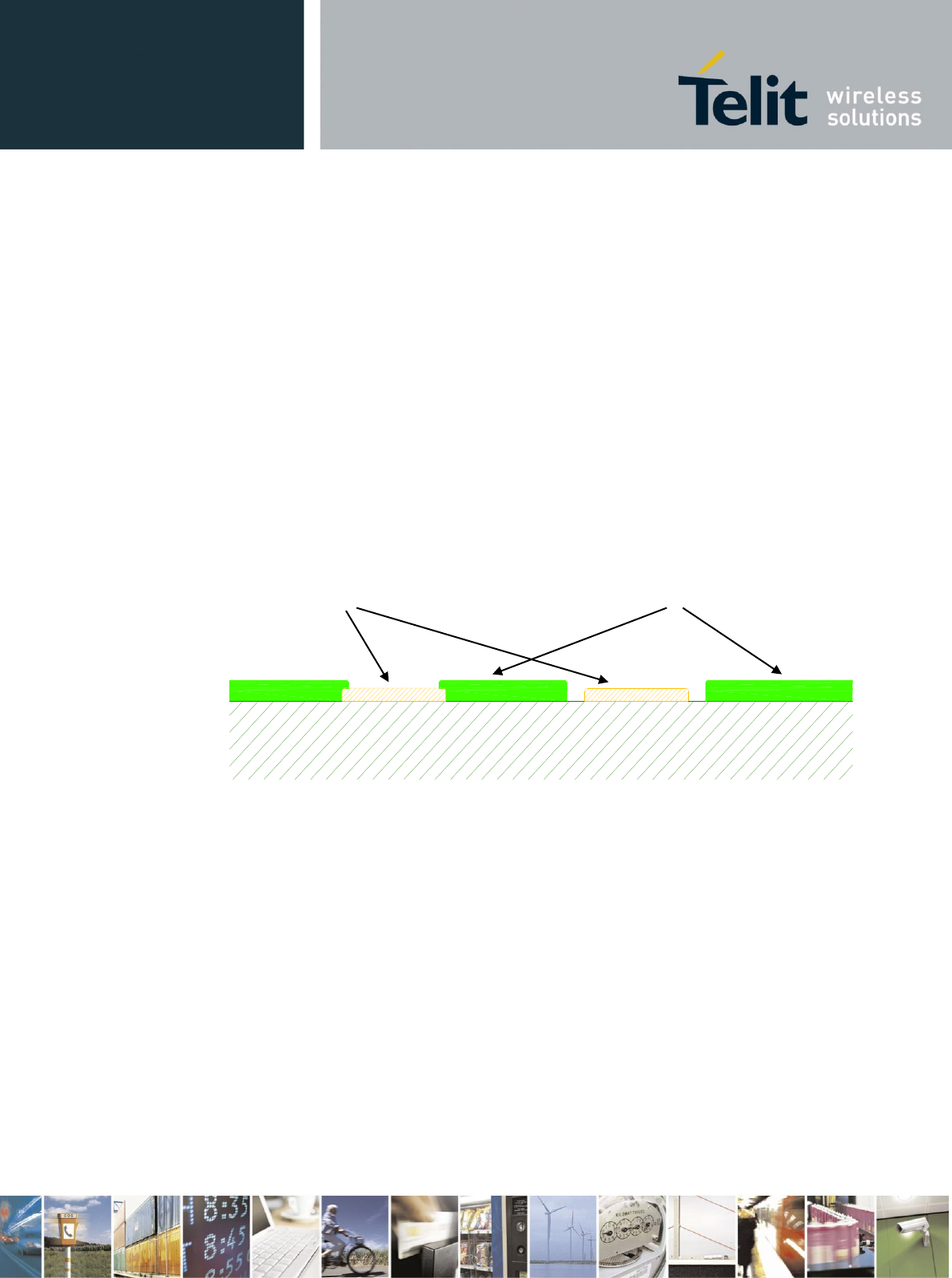
Reproduction forbidden without Telit Communications S.p.A. written authorization - All Rights Reserved page 77 of 93
14.4 Stencil
Stencil’s apertures layout can be the same of the recommended footprint (1:1), we
suggest a thickness of stencil foil ≥ 120 µm.
14.5 PCB pad design
Non solder mask defined (NSMD) type is recommended for the solder pads on the
PCB.
PCB
Copper Pad
Pad
Solder Mask
SMD
(Solder Mask Defined)
NSMD
(Non Solder Mask Defined)
DRAFT
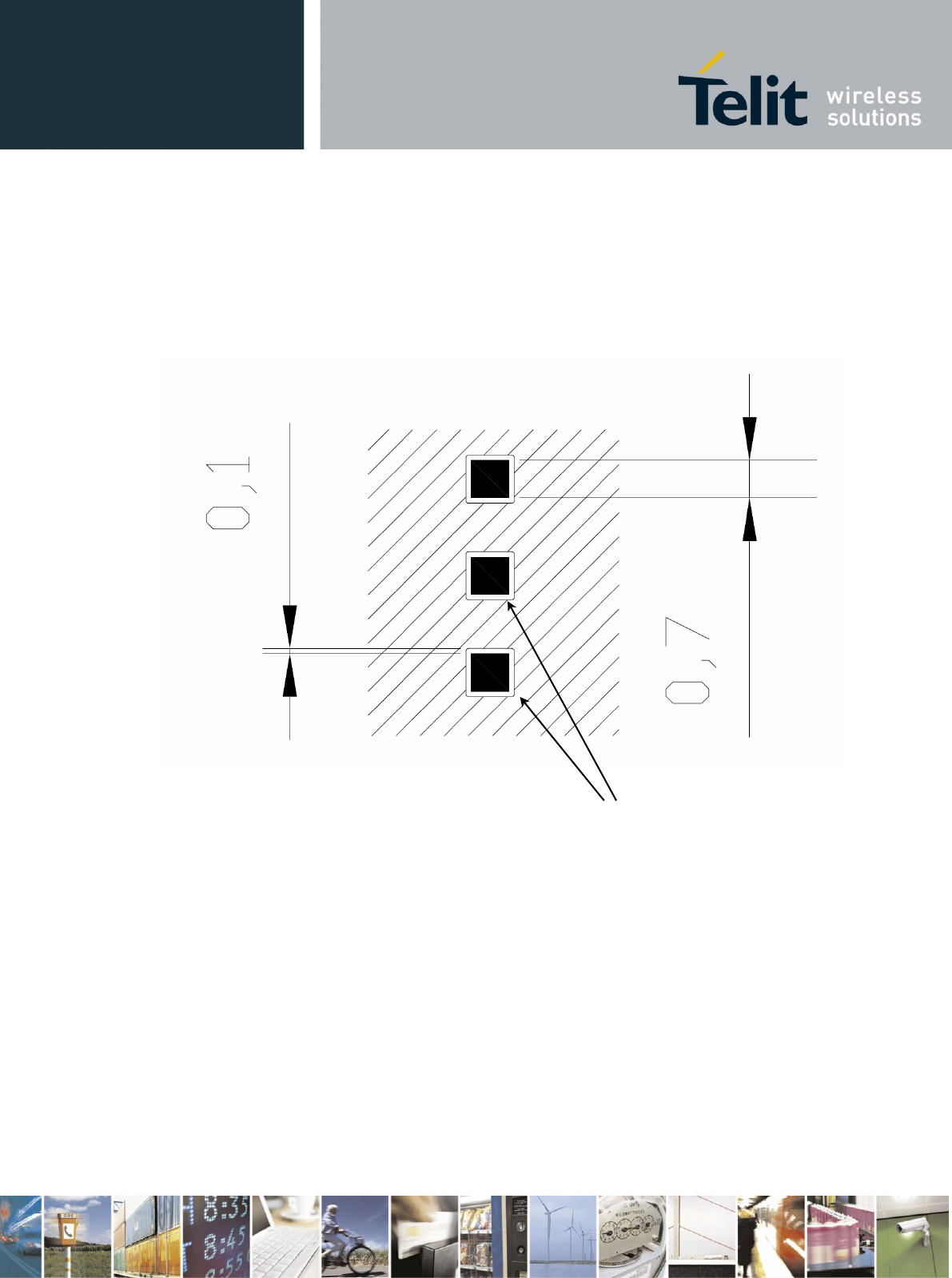
Reproduction forbidden without Telit Communications S.p.A. written authorization - All Rights Reserved page 78 of 93
14.6 PCB pad dimensions
The recommendation for the PCB pads dimensions are described in the following image
(dimensions in mm)
Solder resist openings
DRAFT
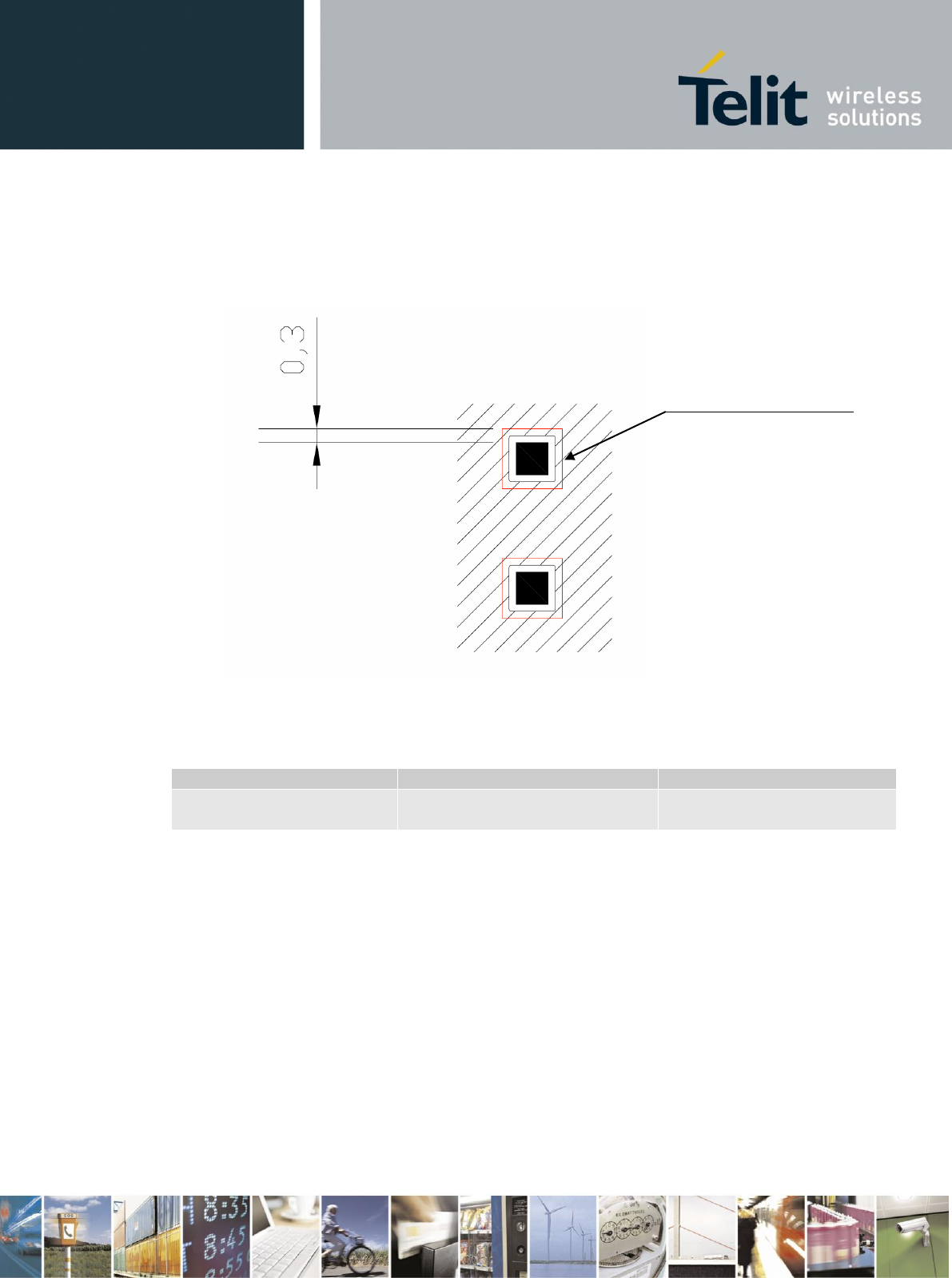
Reproduction forbidden without Telit Communications S.p.A. written authorization - All Rights Reserved page 79 of 93
It is not recommended to place via or micro-via not covered by solder resist in an
area of 0,3 mm around the pads unless it carries the same signal of the pad itself
(see following figure).
Holes in pad are allowed only for blind holes and not for through holes.
Recommendations for PCB pad surfaces:
Finish
Layer thickness [µm]
Properties
Electro-less Ni / Immersion
Au
3 –7 / 0.05 – 0.15
good solder ability protection,
high shear force values
The PCB must be able to resist the higher temperatures which are occurring at the
lead-free process. This issue should be discussed with the PCB-supplier. Generally,
the wettability of tin-lead solder paste on the described surface plating is better
compared to lead-free solder paste.
It is not necessary to panel the application’s PCB, however in that case it is
suggested to use milled contours and predrilled board breakouts; scoring or v-cut
solutions are not recommended.
Inhibit area for micro-via
DRAFT
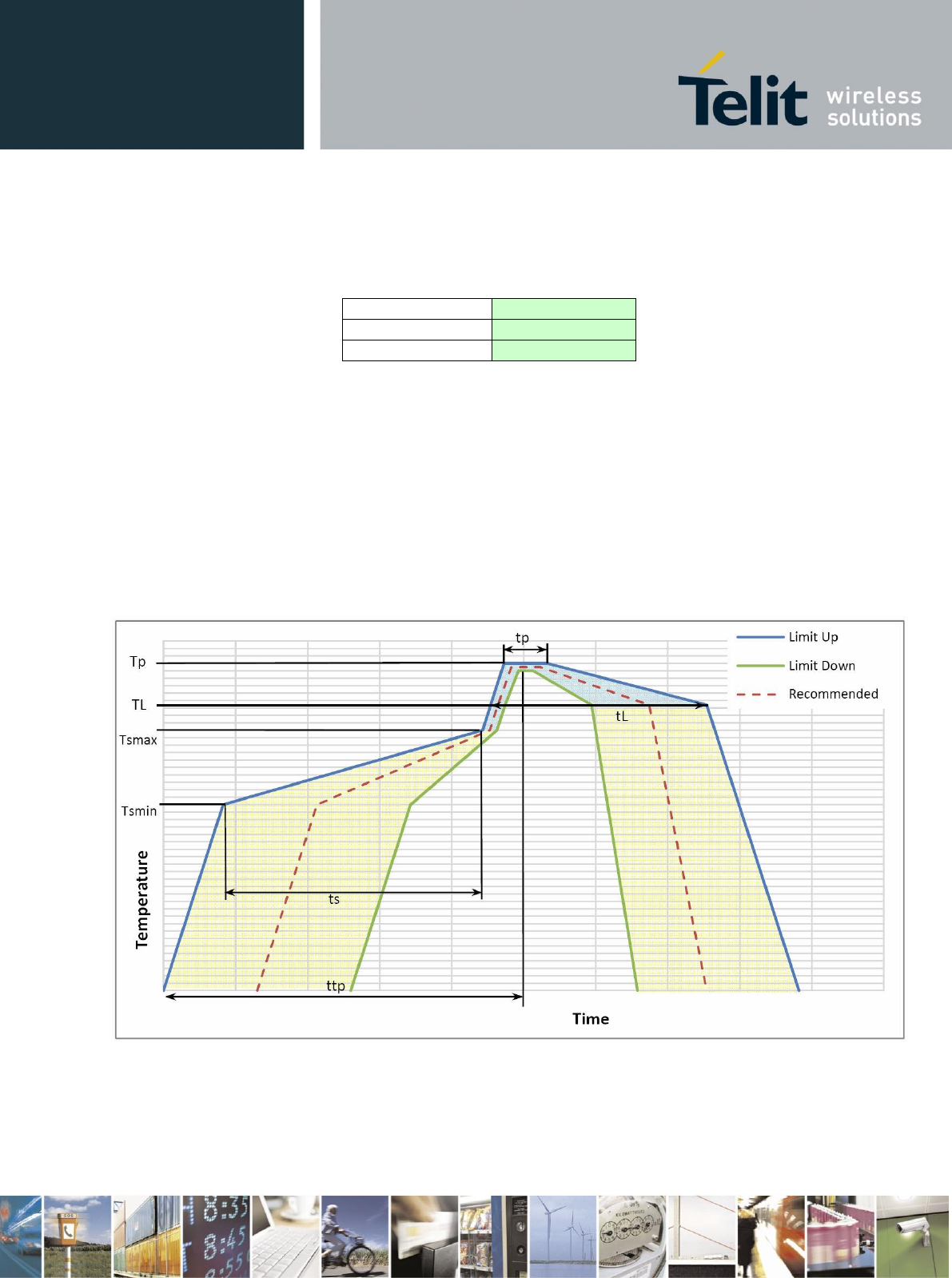
Reproduction forbidden without Telit Communications S.p.A. written authorization - All Rights Reserved page 80 of 93
14.7 Solder paste
Lead free
Solder paste
Sn/Ag/Cu
We recommend using only “no clean” solder paste in order to avoid the cleaning of the modules
after assembly.
14.7.1 UE910 Solder reflow
Recommended solder reflow profile:
DRAFT
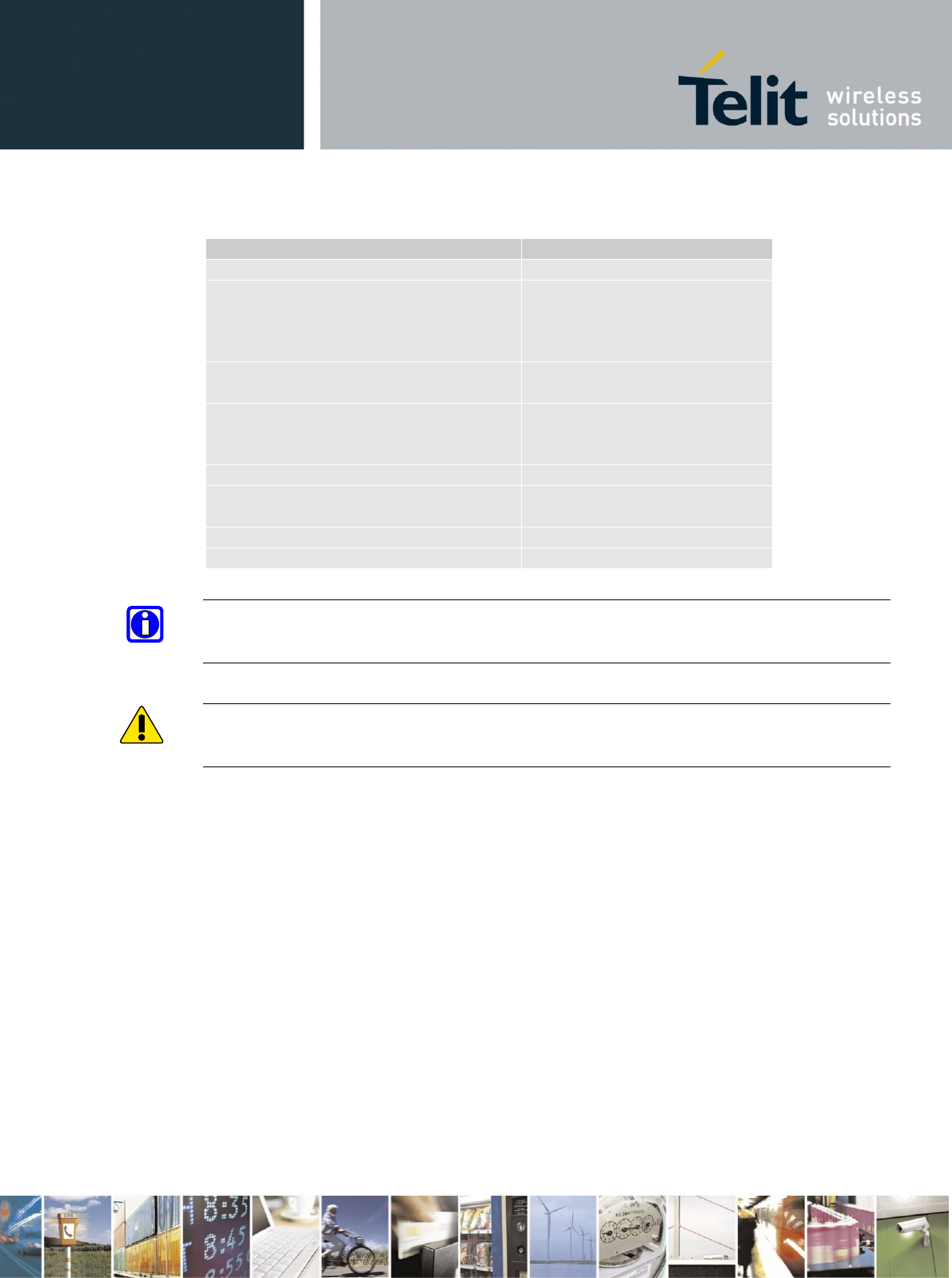
Reproduction forbidden without Telit Communications S.p.A. written authorization - All Rights Reserved page 81 of 93
Profile Feature
Pb-Free Assembly
Average ramp-up rate (TL to TP)
3°C/second max
Preheat
–Temperature Min (Tsmin)
–Temperature Max (Tsmax)
–Time (min to max) (ts)
150°C
200°C
60-180 seconds
Tsmax to TL
–Ramp-up Rate
3°C/second max
Time maintained above:
–Temperature (TL)
–Time (tL)
217°C
60-150 seconds
Peak Temperature (Tp)
245 +0/-5°C
Time within 5°C of actual Peak
Temperature (tp)
10-30 seconds
Ramp-down Rate
6°C/second max.
Time 25°C to Peak Temperature
8 minutes max.
NOTE:
All temperatures refer to topside of the package, measured on the package body surface
WARNING:
The UE910 module withstands one reflow process only.
DRAFT
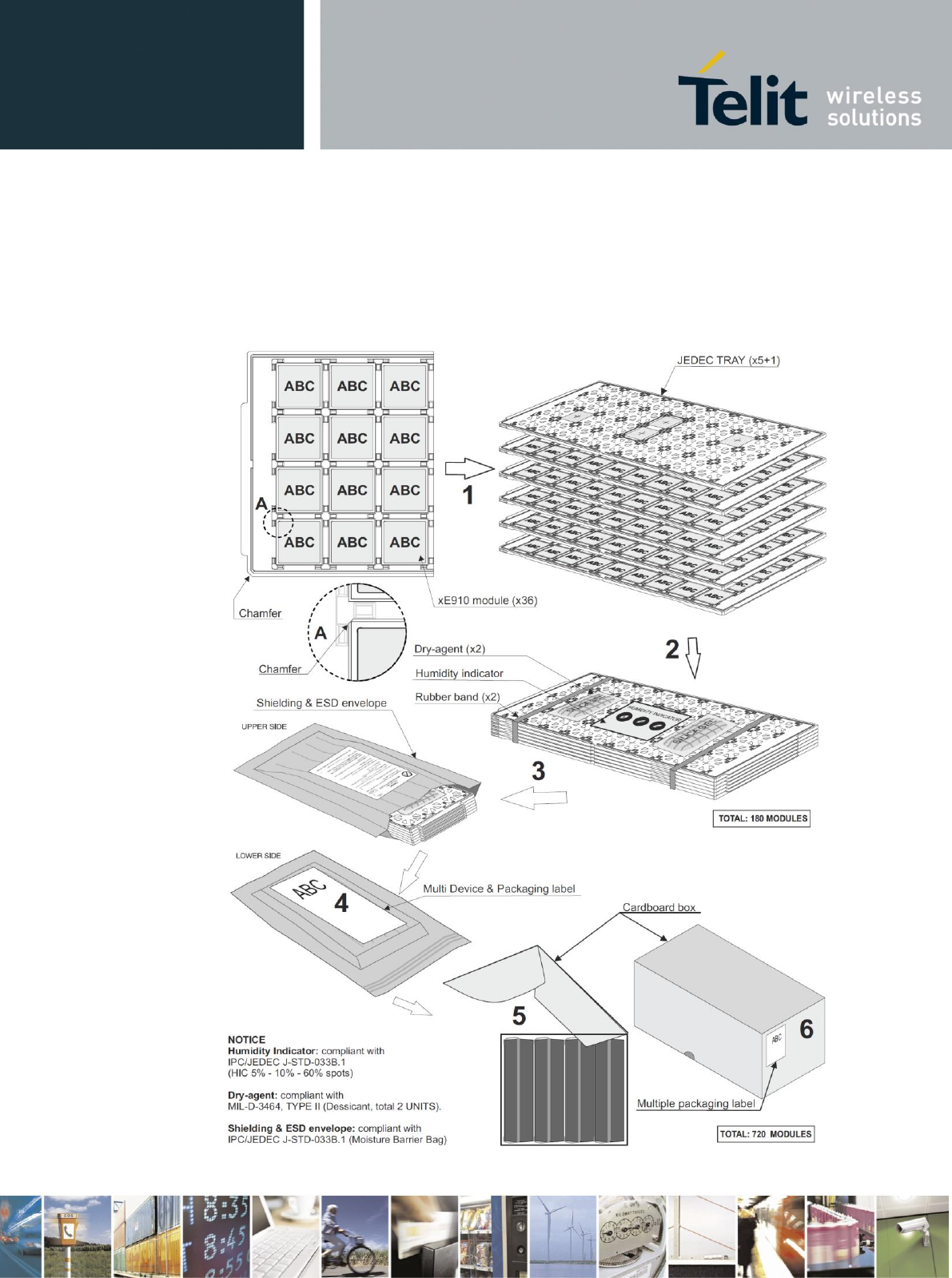
Reproduction forbidden without Telit Communications S.p.A. written authorization - All Rights Reserved page 82 of 93
14.8 Packing system (Tray)
The UE910 modules are packaged on trays of 36 pieces each. These trays can be used in
SMT processes for pick & place handling.
DRAFT
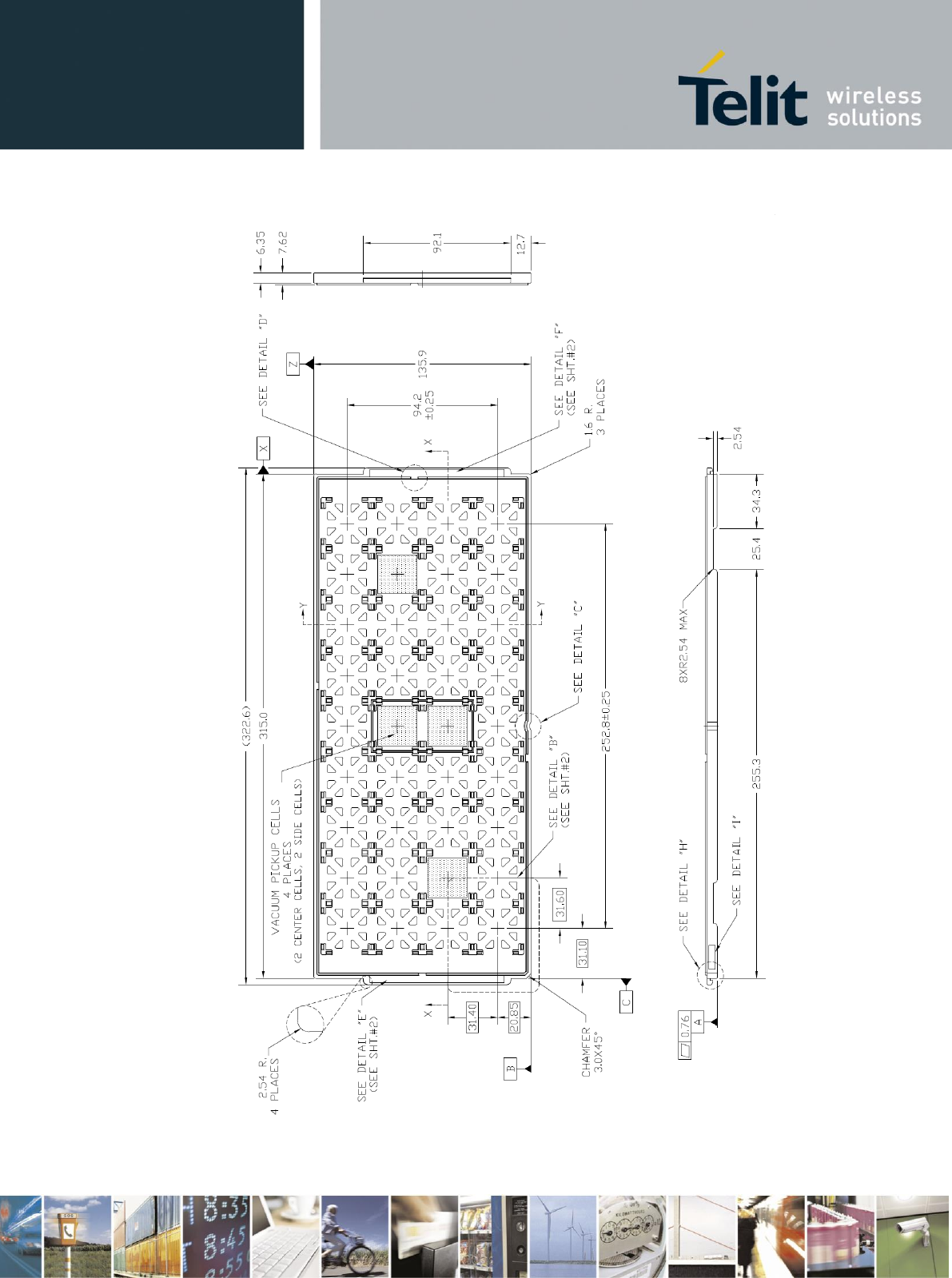
Reproduction forbidden without Telit Communications S.p.A. written authorization - All Rights Reserved page 83 of 93
DRAFT
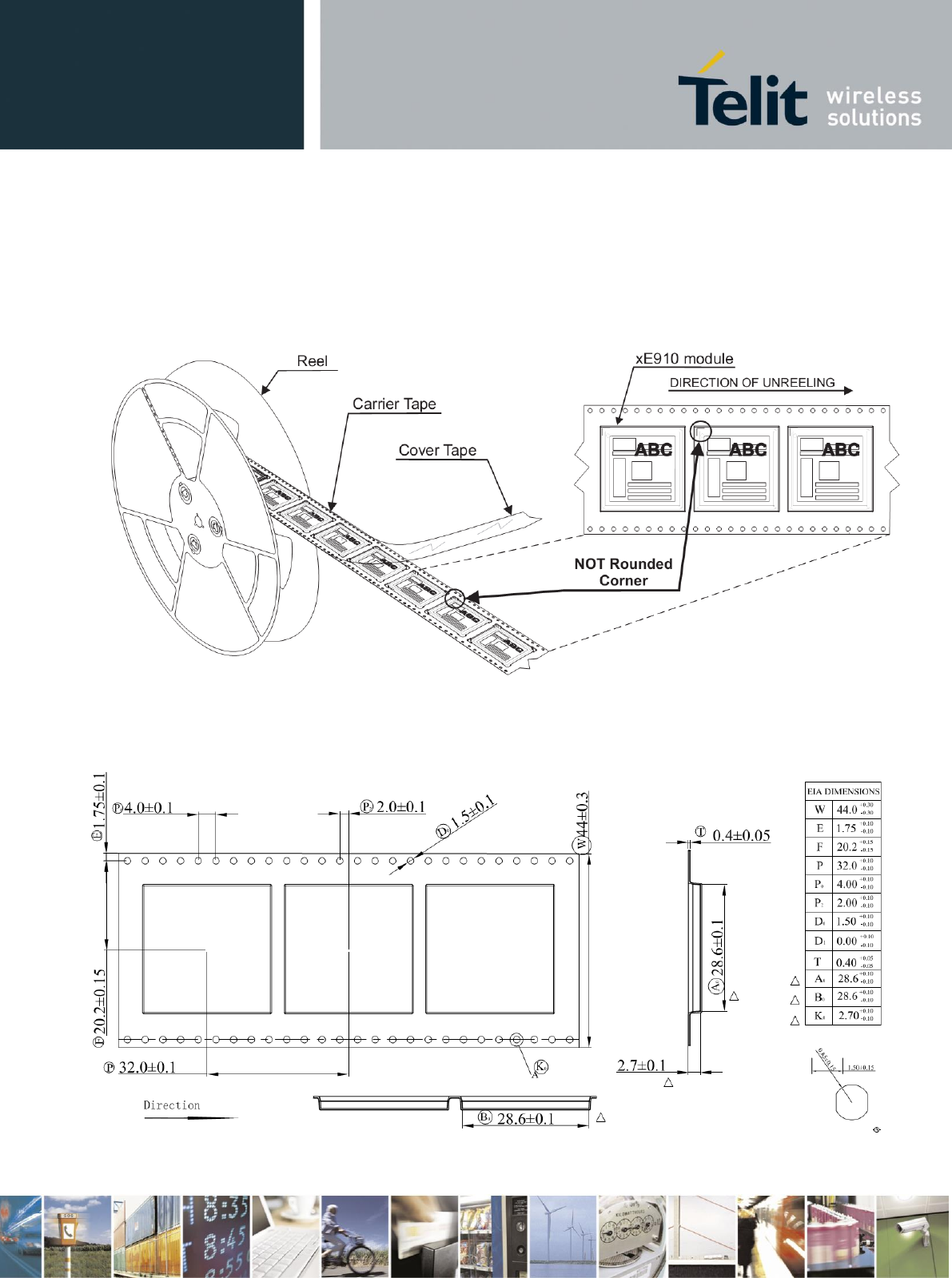
Reproduction forbidden without Telit Communications S.p.A. written authorization - All Rights Reserved page 84 of 93
14.9 Packing System (Reel)
The UE910 can be packaged on reels of 200 pieces each.
See figure for module positioning into the carrier.
14.9.1 Carrier Tape Detail
DRAFT
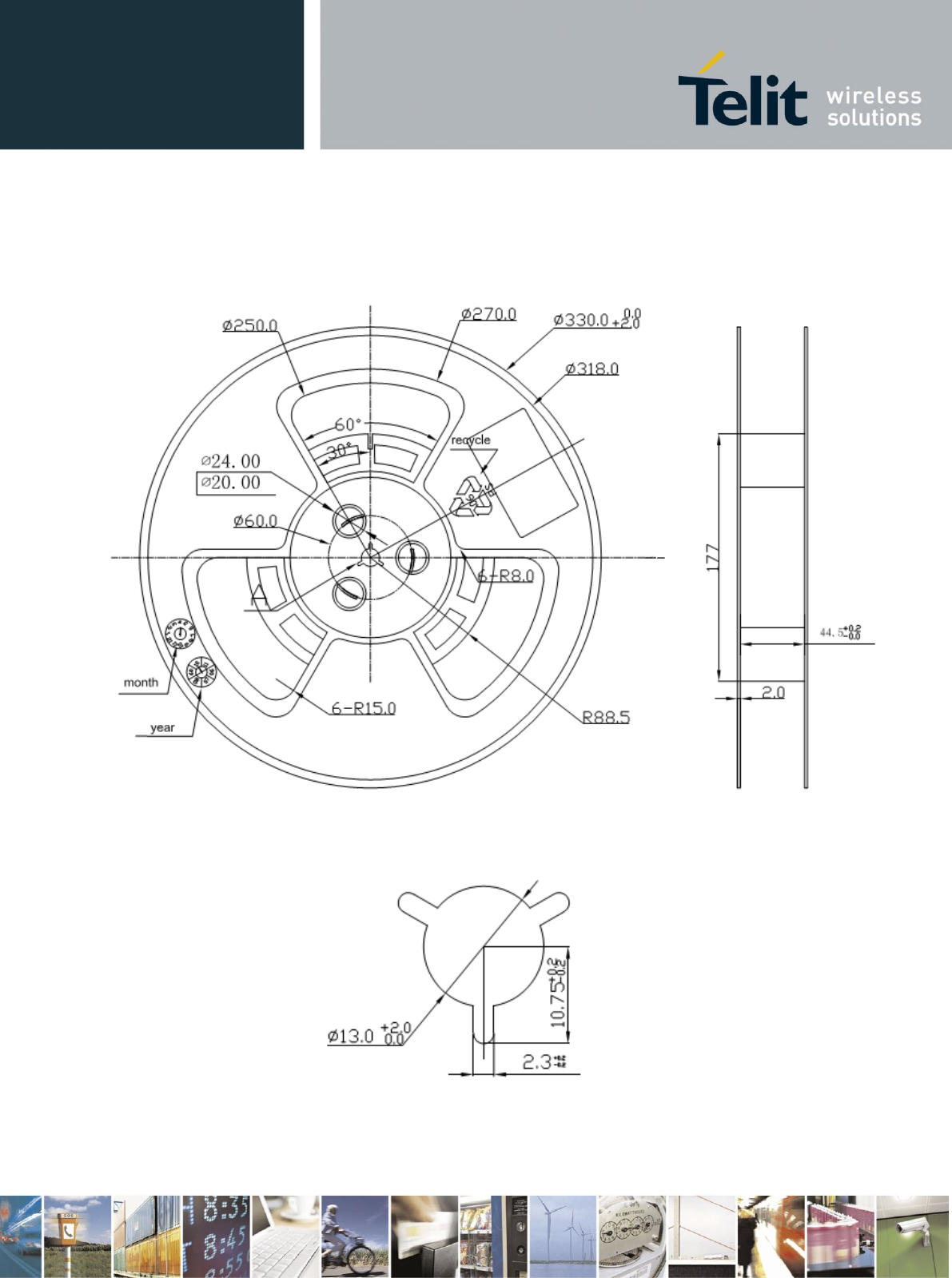
Reproduction forbidden without Telit Communications S.p.A. written authorization - All Rights Reserved page 85 of 93
14.9.2 Reel Detail
DRAFT
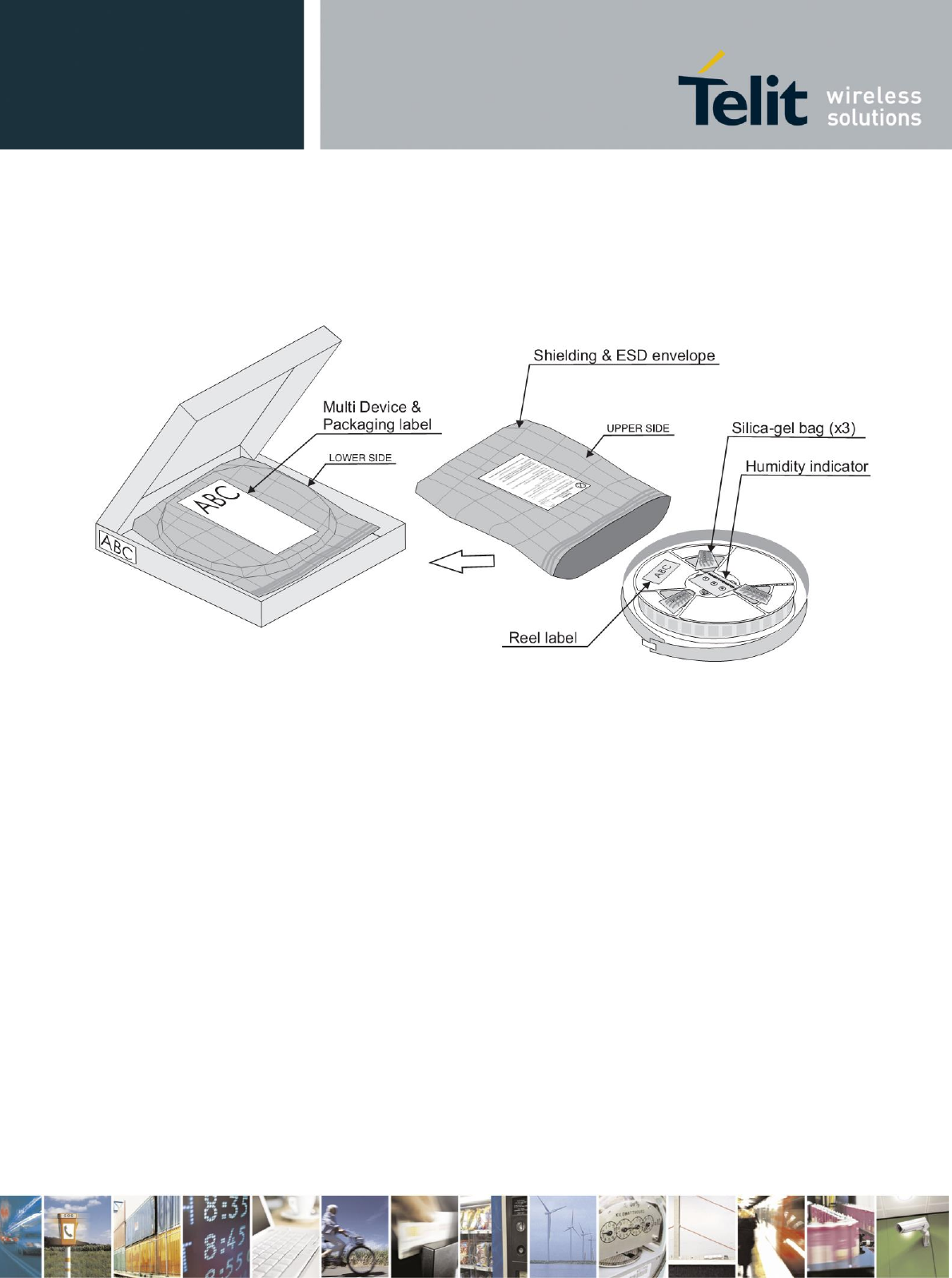
Reproduction forbidden without Telit Communications S.p.A. written authorization - All Rights Reserved page 86 of 93
14.9.3 Packaging Detail
14.10 Moisture sensitivity
The UE910 is a Moisture Sensitive Device level 3, in according with standard IPC/JEDEC J-
STD-020, take care all the relatives requirements for using this kind of components.
Moreover, the customer has to take care of the following conditions:
a) Calculated shelf life in sealed bag: 12 months at <40°C and <90% relative humidity (RH).
b) Environmental condition during the production: 30°C / 60% RH according to IPC/JEDEC
J-STD-033A paragraph 5.
c) The maximum time between the opening of the sealed bag and the reflow process must be
168 hours if condition b) “IPC/JEDEC J-STD-033A paragraph 5.2” is respected
d) Baking is required if conditions b) or c) are not respected
e) Baking is required if the humidity indicator inside the bag indicates 10% RH
or more
DRAFT
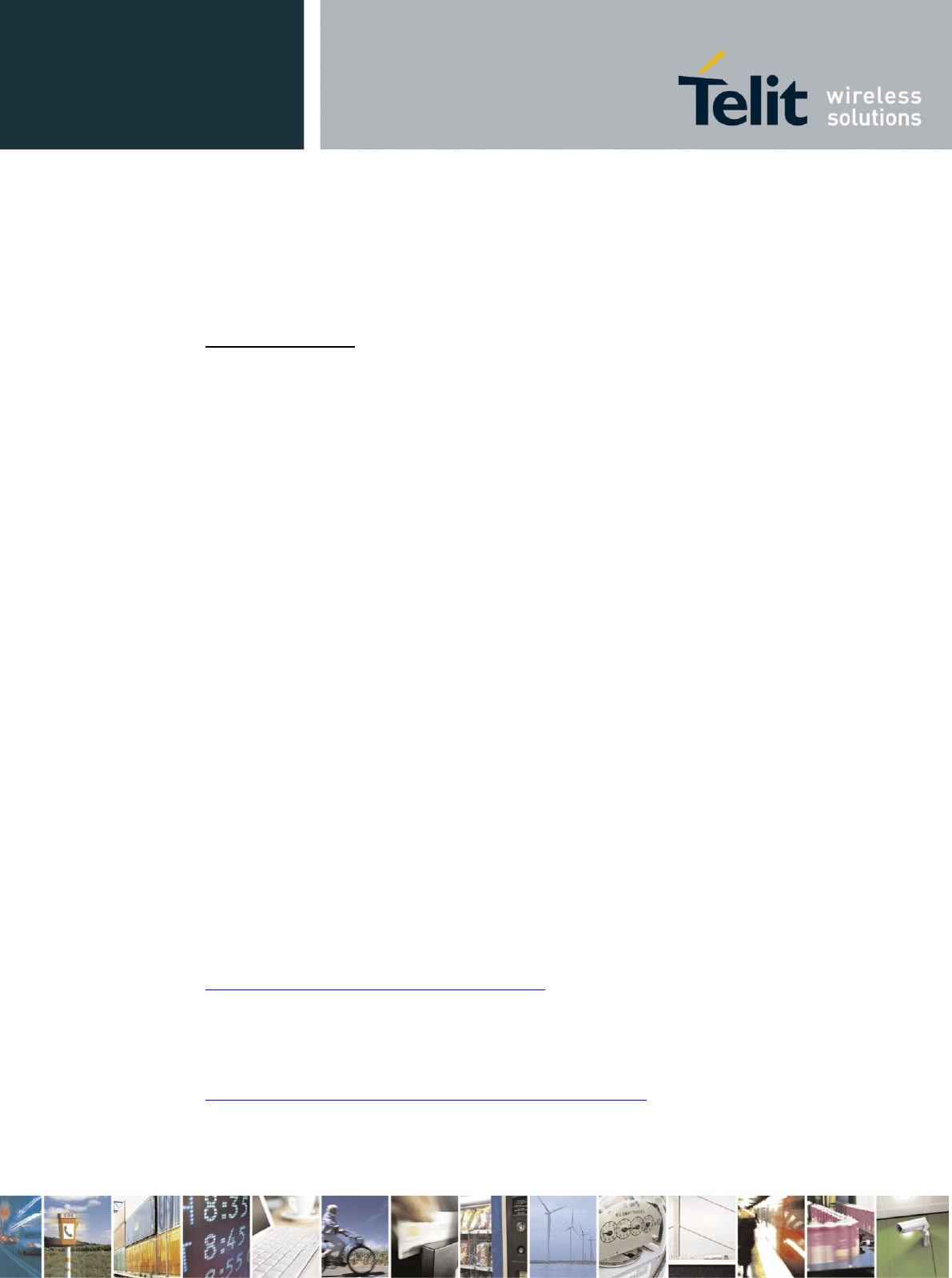
Reproduction forbidden without Telit Communications S.p.A. written authorization - All Rights Reserved page 87 of 93
15 SAFETY RECOMMANDATIONS
READ CAREFULLY
Be sure the use of this product is allowed in the country and in the environment required. The use of this
product may be dangerous and has to be avoided in the following areas:
Where it can interfere with other electronic devices in environments such as hospitals, airports,
aircrafts, etc
Where there is risk of explosion such as gasoline stations, oil refineries, etc
It is responsibility of the user to enforce the country regulation and the specific environment regulation.
Do not disassemble the product; any mark of tampering will compromise the warranty validity.
We recommend following the instructions of the hardware user guides for a correct wiring of the product.
The product has to be supplied with a stabilized voltage source and the wiring has to be conforming to the
security and fire prevention regulations.
The product has to be handled with care, avoiding any contact with the pins because electrostatic
discharges may damage the product itself. Same cautions have to be taken for the SIM, checking carefully
the instruction for its use. Do not insert or remove the SIM when the product is in power saving mode.
The system integrator is responsible of the functioning of the final product; therefore, care has to be taken
to the external components of the module, as well as of any project or installation issue, because the risk
of disturbing the GSM network or external devices or having impact on the security. Should there be any
doubt, please refer to the technical documentation and the regulations in force.
Every module has to be equipped with a proper antenna with specific characteristics. The antenna has to
be installed with care in order to avoid any interference with other electronic devices and has to guarantee
a minimum distance from the body (20 cm). In case of this requirement cannot be satisfied, the system
integrator has to assess the final product against the SAR regulation.
The European Community provides some Directives for the electronic equipments introduced on the
market. All the relevant information’s are available on the European Community website:
http://europa.eu.int/comm/enterprise/rtte/dir99-5.htm
The text of the Directive 99/05 regarding telecommunication equipments is available, while the applicable
Directives (Low Voltage and EMC) are available at:
http://europa.eu.int/comm/enterprise/electr_equipment/index_en.htm
DRAFT
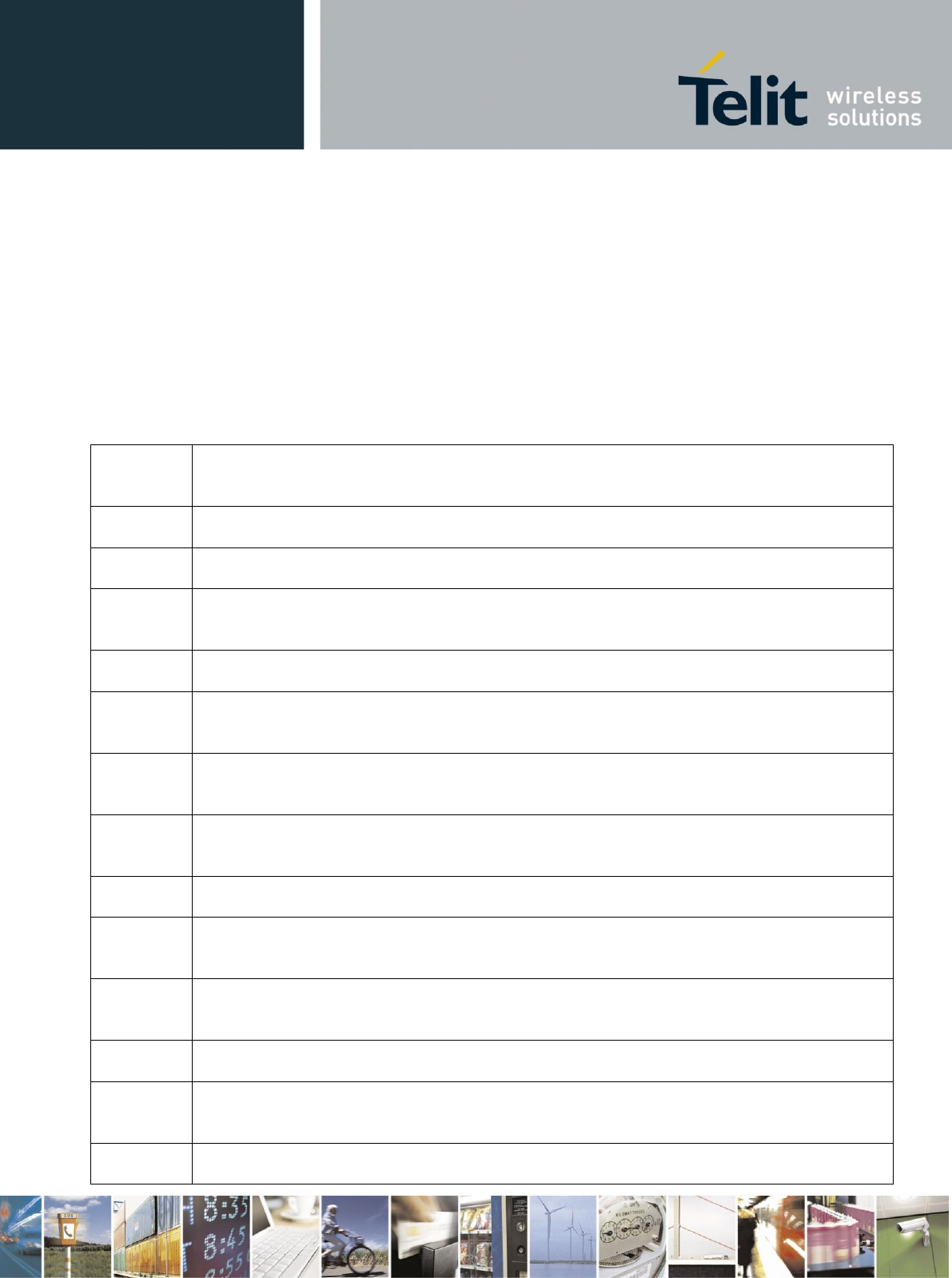
Reproduction forbidden without Telit Communications S.p.A. written authorization - All Rights Reserved page 88 of 93
16 Conformity assessment issues
16.1 1999/5/EC Directive
The UE910-EUR, UE910-EUD modules have been evaluated against the essential requirements of the
1999/5/EC Directive.
Bulgarian
С настоящето Telit Communications S.p.A. декларира, че 2G/3G module отговаря на
съществените изисквания и другите приложими изисквания на Директива
1999/5/ЕС.
Czech
Telit Communications S.p.A. tímto prohlašuje, že tento 2G/3G module je ve shodě se
základními požadavky a dalšími příslušnými ustanoveními směrnice 1999/5/ES.
Danish
Undertegnede Telit Communications S.p.A. erklærer herved, at følgende udstyr 2G/3G
module overholder de væsentlige krav og øvrige relevante krav i direktiv 1999/5/EF.
Dutch
Hierbij verklaart Telit Communications S.p.A. dat het toestel 2G/3G module in
overeenstemming is met de essentiële eisen en de andere relevante bepalingen van
richtlijn 1999/5/EG.
English
Hereby, Telit Communications S.p.A., declares that this 2G/3G module is in compliance
with the essential requirements and other relevant provisions of Directive 1999/5/EC.
Estonian
Käesolevaga kinnitab Telit Communications S.p.A. seadme 2G/3G module vastavust
direktiivi 1999/5/EÜ põhinõuetele ja nimetatud direktiivist tulenevatele teistele
asjakohastele sätetele.
German
Hiermit erklärt Telit Communications S.p.A., dass sich das Gerät 2G/3G module in
Übereinstimmung mit den grundlegenden Anforderungen und den übrigen einschlägigen
Bestimmungen der Richtlinie 1999/5/EG befindet.
Greek
ΜΕ ΤΗΝ ΠΑΡΟΥΣΑ Telit Communications S.p.A. ΔΗΛΩΝΕΙ ΟΤΙ 2G/3G module
ΣΥΜΜΟΡΦΩΝΕΤΑΙ ΠΡΟΣ ΤΙΣ ΟΥΣΙΩΔΕΙΣ ΑΠΑΙΤΗΣΕΙΣ ΚΑΙ ΤΙΣ ΛΟΙΠΕΣ ΣΧΕΤΙΚΕΣ
ΔΙΑΤΑΞΕΙΣ ΤΗΣ ΟΔΗΓΙΑΣ 1999/5/ΕΚ.
Hungarian
Alulírott, Telit Communications S.p.A. nyilatkozom, hogy a 2G/3G module megfelel a
vonatkozó alapvetõ követelményeknek és az 1999/5/EC irányelv egyéb elõírásainak.
Finnish
Telit Communications S.p.A. vakuuttaa täten että 2G/3G module tyyppinen laite on
direktiivin 1999/5/EY oleellisten vaatimusten ja sitä koskevien direktiivin muiden ehtojen
mukainen.
French
Par la présente Telit Communications S.p.A. déclare que l'appareil 2G/3G module est
conforme aux exigences essentielles et aux autres dispositions pertinentes de la
directive 1999/5/CE.
Icelandic
Hér með lýsir Telit Communications S.p.A. yfir því að 2G/3G module er í samræmi við
grunnkröfur og aðrar kröfur, sem gerðar eru í tilskipun 1999/5/EC
Italian
Con la presente Telit Communications S.p.A. dichiara che questo 2G/3G module è
conforme ai requisiti essenziali ed alle altre disposizioni pertinenti stabilite dalla direttiva
1999/5/CE.
Latvian
Ar šo Telit Communications S.p.A. deklarē, ka 2G/3G module atbilst Direktīvas
1999/5/EK būtiskajām prasībām un citiem ar to saistītajiem noteikumiem.
DRAFT
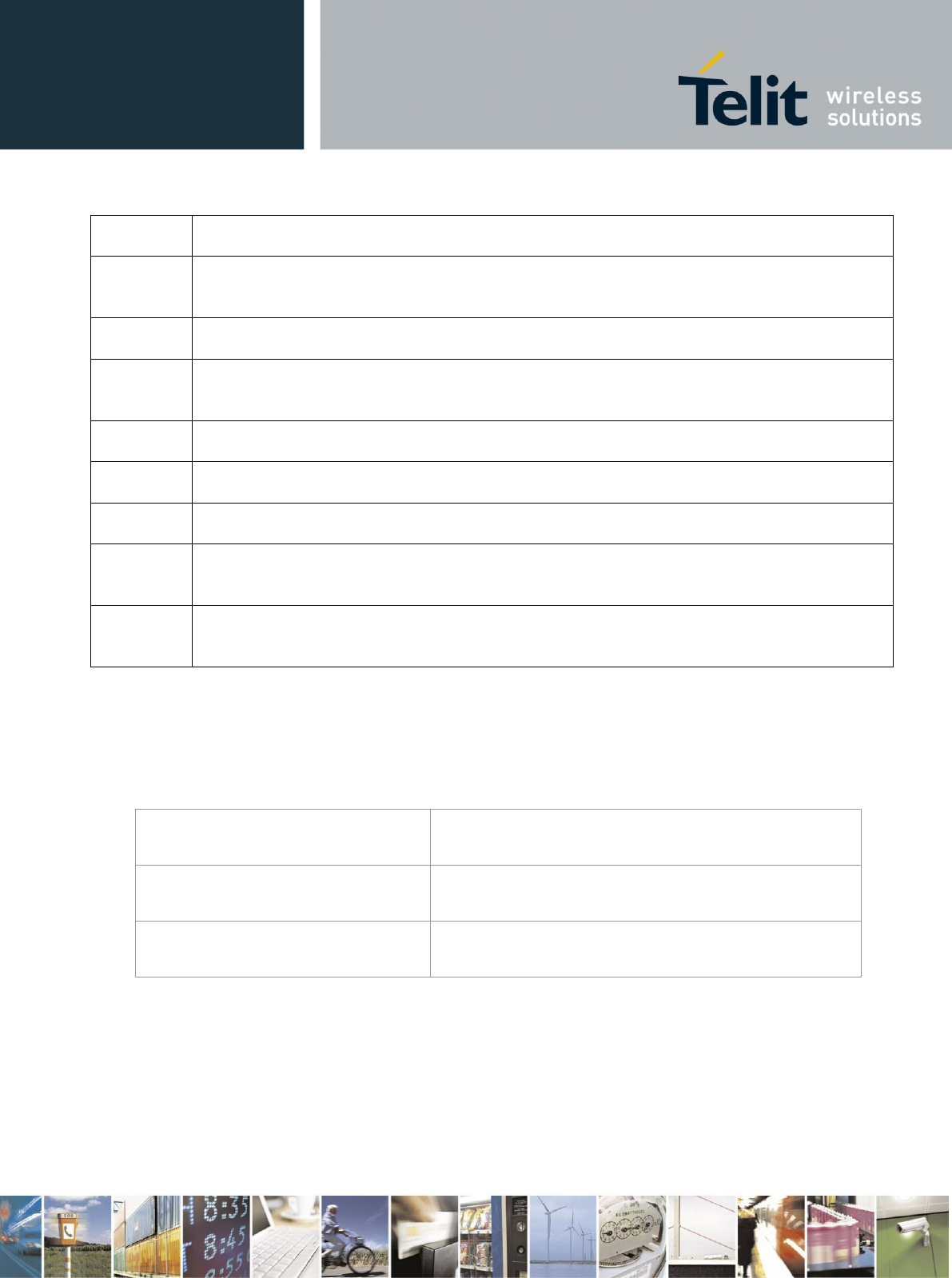
Reproduction forbidden without Telit Communications S.p.A. written authorization - All Rights Reserved page 89 of 93
Lithuanian
Šiuo Telit Communications S.p.A. deklaruoja, kad šis 2G/3G module atitinka esminius
reikalavimus ir kitas 1999/5/EB Direktyvos nuostatas.
Maltese
Hawnhekk, Telit Communications S.p.A., jiddikjara li dan 2G/3G module jikkonforma
mal-ħtiġijiet essenzjali u ma provvedimenti oħrajn relevanti li hemm fid-Dirrettiva
1999/5/EC.
Norwegian
Telit Communications S.p.A. erklærer herved at utstyret 2G/3G module er i samsvar
med de grunnleggende krav og øvrige relevante krav i direktiv 1999/5/EF.
Polish
Niniejszym Telit Communications S.p.A. oświadcza, że 2G/3G module jest zgodny z
zasadniczymi wymogami oraz pozostałymi stosownymi postanowieniami Dyrektywy
1999/5/EC
Portuguese
Telit Communications S.p.A. declara que este 2G/3G module está conforme com os
requisitos essenciais e outras disposições da Directiva 1999/5/CE.
Slovak
Telit Communications S.p.A. týmto vyhlasuje, že 2G/3G module spĺňa základné
požiadavky a všetky príslušné ustanovenia Smernice 1999/5/ES.
Slovenian
Telit Communications S.p.A. izjavlja, da je ta 2G/3G module v skladu z bistvenimi
zahtevami in ostalimi relevantnimi določili direktive 1999/5/ES.
Spanish
Por medio de la presente Telit Communications S.p.A. declara que el 2G/3G module
cumple con los requisitos esenciales y cualesquiera otras disposiciones aplicables o
exigibles de la Directiva 1999/5/CE.
Swedish
Härmed intygar Telit Communications S.p.A. att denna 2G/3G module står I
överensstämmelse med de väsentliga egenskapskrav och övriga relevanta
bestämmelser som framgår av direktiv 1999/5/EG.
In order to satisfy the essential requirements of 1999/5/EC Directive, the UE910-EUR, UE910-EUD
modules are compliant with the following standards:
RF spectrum use (R&TTE art. 3.2)
EN 301 511 V9.02
EN 301 908-1 V5.2.1
EN 301 908-2 V5.2.1
EMC (R&TTE art. 3.1b)
EN 301 489-1 V1.9.2
EN 301 489-7 V1.3.1
EN 301 489-24 V1.5.1
Health & Safety (R&TTE art. 3.1a)
EN 60950-1:2006 + A11:2009 + A1:2010 + A12:2011 +
AC2011
EC 62311:2008
DRAFT
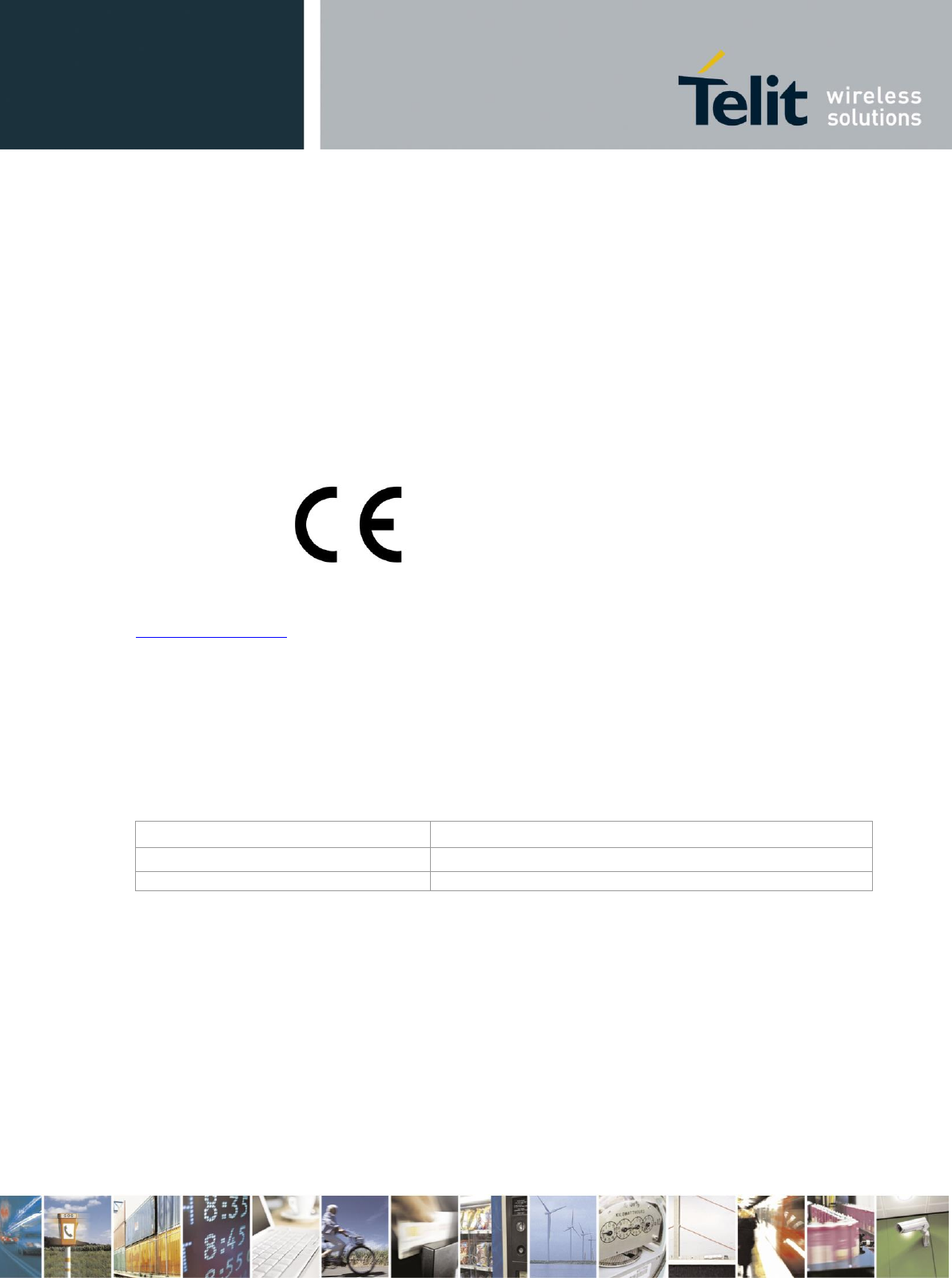
Reproduction forbidden without Telit Communications S.p.A. written authorization - All Rights Reserved page 90 of 93
The conformity assessment procedure referred to in Article 10 and detailed in Annex IV of Directive
1999/5/EC has been followed with the involvement of the following Notified Body:
AT4 wireless, S.A.
Parque Tecnologico de Andalucía
C/ Severo Ochoa 2
29590 Campanillas – Málaga
SPAIN
Notified Body No: 1909
Thus, the following marking is included in the product:
The full declaration of conformity can be found on the following address:
http://www.telit.com/
There is no restriction for the commercialisation of the UE910-EUR, UE910-EUD modules in all the
countries of the European Union.
Final product integrating this module must be assessed against essential requirements of the 1999/5/EC
(R&TTE) Directive. It should be noted that assessment does not necessarily lead to testing. Telit
Communications S.p.A. recommends carrying out the following assessments:
RF spectrum use (R&TTE art. 3.2)
It will depend on the antenna used on the final product.
EMC (R&TTE art. 3.1b)
Testing
Health & Safety (R&TTE art. 3.1a)
Testing
Alternately, assessment of the final product against EMC (Art. 3.1b) and Electrical safety (Art. 3.1a)
essential requirements can be done against the essential requirements of the EMC and the LVD Directives:
Low Voltage Directive 2006/95/EC and product safety
Directive EMC 2004/108/EC for conformity for EMC
1909
DRAFT
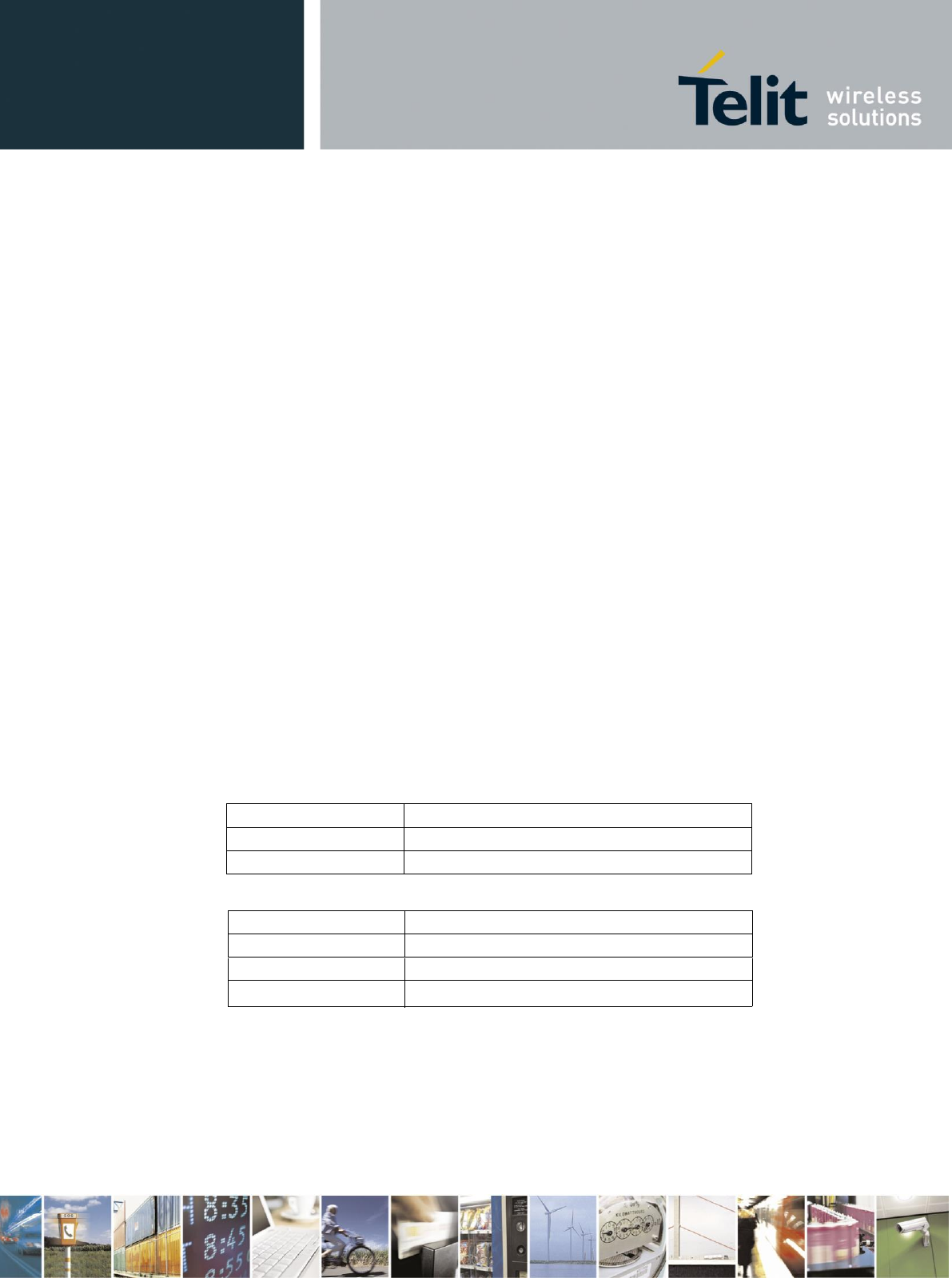
Reproduction forbidden without Telit Communications S.p.A. written authorization - All Rights Reserved page 91 of 93
16.2 FCC/IC Regulatory notices
Modification statement
Telit has not approved any changes or modifications to this device by the user. Any changes or modifications
could void the user’s authority to operate the equipment.
Telit n’approuve aucune modification apportée à l’appareil par l’utilisateur, quelle qu’en soit la nature. Tout
changement ou modification peuvent annuler le droit d’utilisation de l’appareil par l’utilisateur.
Interference statement
This device complies with Part 15 of the FCC Rules and Industry Canada licence-exempt RSS standard(s).
Operation is subject to the following two conditions: (1) this device may not cause interference, and (2) this
device must accept any interference, including interference that may cause undesired operation of the device.
Le présent appareil est conforme aux CNR d'Industrie Canada applicables aux appareils radio exempts de
licence. L'exploitation est autorisée aux deux conditions suivantes : (1) l'appareil ne doit pas produire de
brouillage, et (2) l'utilisateur de l'appareil doit accepter tout brouillage radioélectrique subi, même si le
brouillage est susceptible d'en compromettre le fonctionnement.
Wireless notice
This equipment complies with FCC and IC radiation exposure limits set forth for an uncontrolled environment.
The antenna should be installed and operated with minimum distance of 20 cm between the radiator and your
body. Antenna gain must be below:
Frequency band
UE910-NAR, UE910-NAD
GSM 850/FDD V
10.00 dBi
PCS 1900/FDD II
9.31 dBi
This transmitter must not be co-located or operating in conjunction with any other antenna or transmitter.
Frequency band UE910-GL
GSM 850/FDD V 4.14 dBi
PCS 1900/FDD II 3.04 dBi
FDD IV6.30 dBi
DRAFT
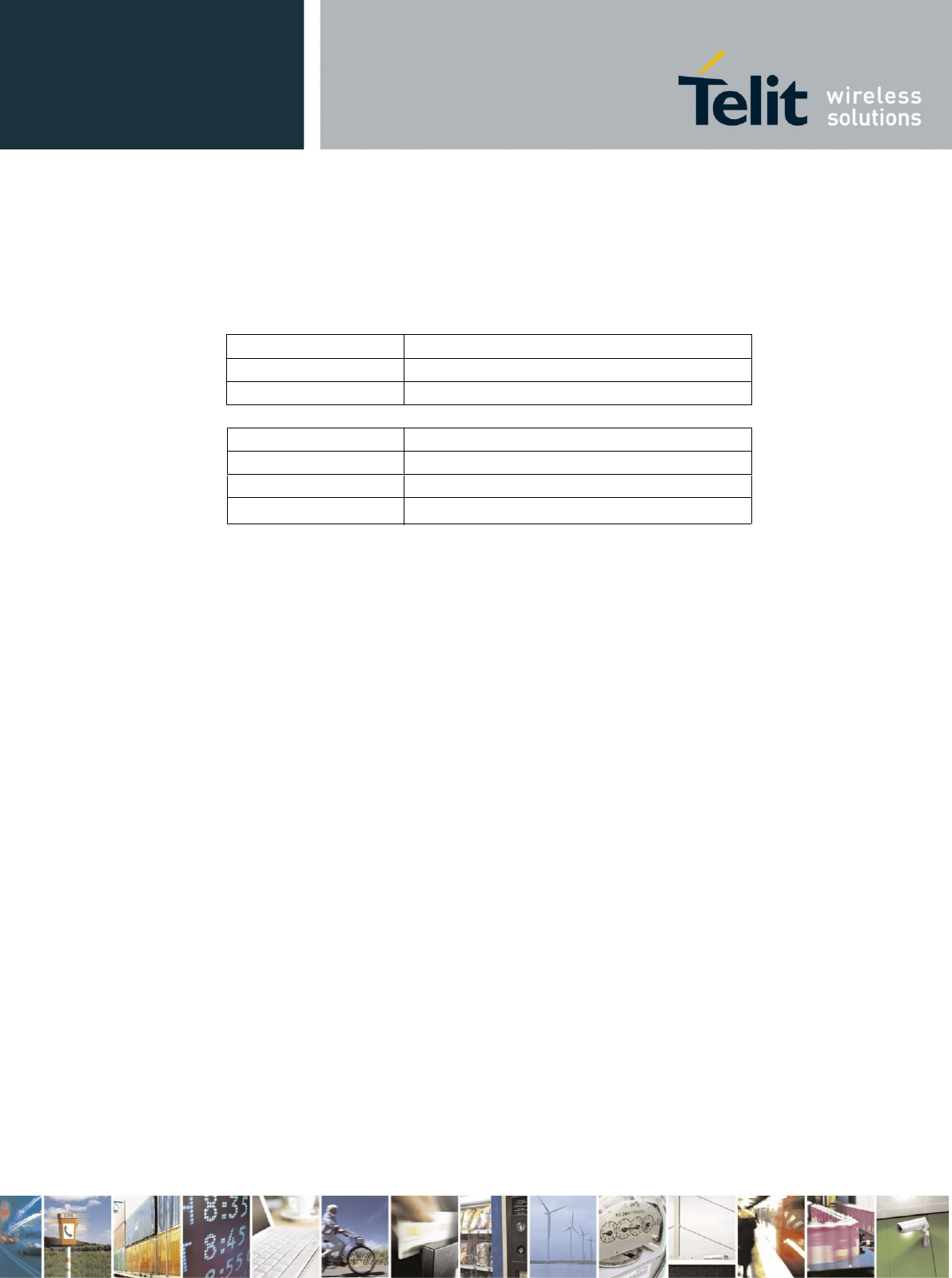
Reproduction forbidden without Telit Communications S.p.A. written authorization - All Rights Reserved page 92 of 93
Cet appareil est conforme aux limites d'exposition aux rayonnements de la IC pour un environnement non
contrôlé. L'antenne doit être installé de façon à garder une distance minimale de 20 centimètres entre la source
de rayonnements et votre corps. Gain de l'antenne doit être ci-dessous:
Bande de fréquence
UE910-NAR, UE910-NAD
GSM 850/FDD V
10.00 dBi
PCS 1900/FDD II
9.31 dBi
L'émetteur ne doit pas être colocalisé ni fonctionner conjointement avec à autre antenne ou autre émetteur.
FCC Class B digital device notice
This equipment has been tested and found to comply with the limits for a Class B digital device, pursuant to part
15 of the FCC Rules. These limits are designed to provide reasonable protection against harmful interference in
a residential installation. This equipment generates uses and can radiate radio frequency energy and, if
not installed and used in accordance with the instructions, may cause harmful interference to radio
communications. However, there is no guarantee that interference will not occur in a particular installation. If
this equipment does cause harmful interference to radio or television reception, which can be determined by
turning the equipment off and on, the user is encouraged to try to correct the interference by one or more of the
following measures:
- Reorient or relocate the receiving antenna.
- Increase the separation between the equipment and receiver.
- Connect the equipment into an outlet on a circuit different from that to which the receiver is connected.
- Consult the dealer or an experienced radio/TV technician for help.
Frequency band UE910-GL
GSM 850/FDD V 4.14 dBi
PCS 1900/FDD II 3.04 dBi
FDD IV6.30 dBi
DRAFT
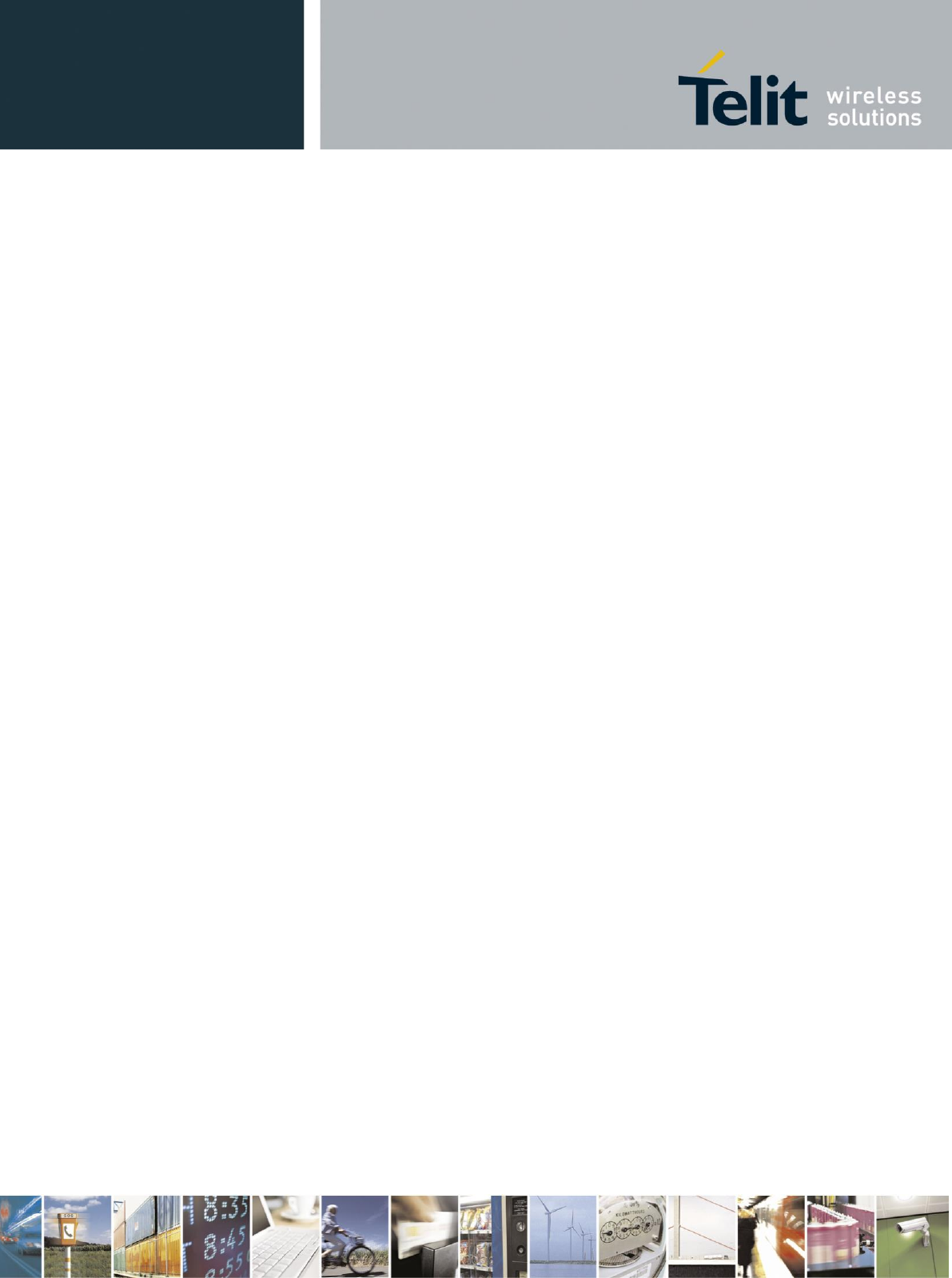
Reproduction forbidden without Telit Communications S.p.A. written authorization - All Rights Reserved page 93 of 93
Labelling Requirements for the Host device
The host device shall be properly labelled to identify the modules within the host device. The certification label
of the module shall be clearly visible at all times when installed in the host device, otherwise the host device
must be labelled to display the FCC ID and IC of the module, preceded by the words "Contains transmitter
module", or the word "Contains", or similar wording expressing the same meaning, as follows:
Contains FCC ID: RI7UE910NA
Contains IC: 5131A-UE910NA
L'appareil hôte doit être étiqueté comme il faut pour permettre l'identification des modules qui s'y trouvent.
L'étiquette de certification du module donné doit être posée sur l'appareil hôte à un endroit bien en vue en tout
temps. En l'absence d'étiquette, l'appareil hôte doit porter une étiquette donnant le FCC ID et le IC du module,
précédé des mots « Contient un module d'émission », du mot « Contient » ou d'une formulation similaire
exprimant le même sens, comme suit :
Contains FCC ID: RI7UE910NA
Contient IC: 5131A-UE910NA
CAN ICES-3 (B) / NMB-3 (B)
This Class B digital apparatus complies with Canadian ICES-003.
Cet appareil numérique de classe B est conforme à la norme canadienne ICES-003.
DRAFT